How To Diagram The Sentence,"The Gardener Mows The Lawn And Trims The Hedges
Date: 2006-03-01
Link to this record (permalink)
Garden Tip
Keywords: Landscape design
Graph paper and colored pencils are still the best tools for do-it-yourself garden design. While good software is available to help you draw professional looking plans, expect to pay at least $200.00 to $600.00. You may decide that the money is better spent paying someone to install the new patio. These books will help translate ideas into coherent designs on paper:Gemma Nesbitt wrote Garden Graphics: How to Plan and Map Your Garden (Capability's Books, $25.00) for gardeners who want a simple garden plan with meaningful graphics, instead of the abstract circles usually found in landscape designs. The bulk of the book has graphics representing common trees, shrubs and perennials, as well as paving, fencing and furniture.
For help with abstract circles for the professional look, Landscape Graphics by Grant Reid (Watson-Guptill Publications, $24.95) is the appropriate book.
A Handbook for Garden Designers by Rosemary Alexander (Ward Lock, Ltd. $29.95) is aimed at the beginning professional designer, but is very accessible to amateur gardeners who want to learn the design process and produce professional-looking plans. Topics include taking a site survey and inventory, developing a design and how to draw elevations.
Date: 2007-04-03
Link to this record (permalink)
Garden Tip
Keywords: Seed dormancy, Propagation, Shrubs, Seeds, Perennials, Ornamental grasses, Herbs, Ferns, Reviews
A book by Jekka McVicar called Seeds: the ultimate guide to growing successfully from seed (Lyons Press, 2003, $22.95) will help you turn your seedy hopes into plant reality. Thirteen chapters are divided by types of plant including ferns, grasses, shrubs, perennials and herbs. The practical information that applies to all kinds of seeds, such as what type of soil to use, and how to break seed dormancy, is included in the last chapter. Color photos illustrate throughout. For online tips for seed starting go to:http://cru.cahe.wsu.edu/CEPublications/pnw0170/pnw0170.pdf from Oregon State University.
Date: 2006-03-01
Link to this record (permalink)
Garden Tip
Keywords: Nurseries
In wintertime a gardener's mailbox is overflowing with nursery catalogs. Ordering plants through the mail greatly increases the variety of plants to choose from, but also carries some risk. Is the company reputable? What if the plants are low quality? Lower that risk by reading customer opinions of the mail-order nursery in question. The free database at Garden Watchdog lists over 3,000 garden related vendors where customers can submit compliments, complaints or warnings. Businesses can respond to complaints to give their side of the story. This site can also be used to find all the nurseries that sell products in a certain category, like bulbs or hand tools. Date: 2007-04-03
Link to this record (permalink)
Garden Tip
Keywords: Pruning trees, Pruning
Winter is a good time to prune because the branch structure of trees and shrubs is clearly visible. Winter is certainly not the only time for pruning, but the list of competing garden chores is typically shorter in winter. Here are a few websites to check out before pulling out the pruning saw:
- Washington State University, Mt. Vernon - a primer on pruning fruit trees
- http://www.homeorchardsociety.org/growfruit/trees/how-to-prune-fruit-trees/ - five principles for pruning fruit trees
- Plant Amnesty on pruning hybrid tea roses
- Plant Amnesty on general pruning
- Pacific Northwest chapter, International Society of Arboriculture - why and how to hire an arborist
- Virginia Cooperative Extension - basic pruning shrub guide with illustrations.
Date: 2006-03-20
Link to this record (permalink)
Garden Tip
Keywords: Primula
If you're only familiar with the common primrose sold at grocery stores in January, take another look at these charming little perennials. With over 400 species found throughout the Northern Hemisphere, there are many worthwhile choices for the Pacific Northwest garden. Try nutmeg-scented Primula florindae (Himalayan cowslip) in a wet spot or late summer flowering Primula capitata in a shaded pocket in a rockery (add compost to the planting hole). To find the one best suited for your garden conditions check out the exhaustive reference book called Primula by John Richards (Timber Press, $39.95).The American Primrose Society website has photos of some of the less common primroses, as well as articles on growing and propagating Primulas and other Primrose family members. Members receive a quarterly journal with color photos, participate in seed exchanges and show off their prize plants at the annual meeting. To join send $25.00 to Julia Haldorson, Treasurer, P.O. Box 210913, Auke Bay, Alaska 99821.
Date: 2007-04-03
Link to this record (permalink)
Garden Tip
Keywords: Vegetable gardening, Permaculture, Sustainable agriculture
Advanced vegetable gardeners who want go to the next level of self reliance will enjoy the attractive book by John Seymour, The Self-Sufficient Life and How to Live It (Dorling Kindersley, 2003, $30.00). This very practical book gives "how-to" instructions for a wide range of traditional living skills. How to raise (and butcher) poultry and rabbits, how to grow grain crops, how to make a methane digester to create energy and how to spin flax are just a few examples. The author's intention is to encourage readers to question how truly satisfying the modern life is compared to an honest day's work on the homestead. But even urban dwellers will find ideas for making their own food and craft products. The simple life has gone digital, too. For articles and ideas on living a self-sufficient life, check out Mother Earth News and www.homestead.org. Date: 2007-04-10
Link to this record (permalink)
Garden Tip
Keywords: Calluna, Erica
This time of year gardeners appreciate the color and good looks of heaths and heathers. Most heather species prefer sun, acid soil and some supplemental summer water. To learn more about heathers join the Cascade Heather Society. For a $5.00 yearly membership, you will receive three color newsletters per year. To join, mail a check to Alice Knight, Secretary-Treasurer, 1199 Monte Elma Rd. Elma, WA 98541-9038.To learn more about the many different heath and heather varieties and how to grow them go online to: The Heather Society (British).
Date: 2006-03-01
Link to this record (permalink)
Garden Tip
Keywords: Greenhouses
Owning a greenhouse can keep a gardener busy straight through winter. If you're thinking of adding a greenhouse or already have one you may want to join the Hobby Greenhouse Association. For $28.00 a year members receive a quarterly magazine, a quarterly newsletter, and the opportunity to ask questions of the experts. To join send a check to HGA MEMBERSHIP, P. O. Box 404, Andover, MA, 01810, or join online at www.hobbygreenhouse.org/ Date: 2007-04-03
Link to this record (permalink)
Garden Tip
Keywords: Cold protection of plants, Frost, Attracting wildlife, Christmas trees, Recycling (Waste, etc.)
Before you send your Christmas tree away to be chipped for mulch, consider how the tree can be used in your own garden. Cut the branches off the main trunk to place around plants or emerging bulbs that could use extra frost protection. The main trunk could then be used as a stout stake for annual vines planted in the spring. Another idea is to use it as a temporary bird feeding station. Tie on orange slices, suet balls, peanut butter and birdseed smeared pine cones and then stand back and watch the feeding frenzy. Date: 2005-10-21
Link to this record (permalink)
Garden Tip
Keywords: Tomatoes--Care and maintenance, Tomatoes
Whether you planted your tomatoes in April or mid-June, by mid-summer it's time to think about training and staking strategies. An eight-inch tomato may be dwarfed by a "tomato cage" in June, but by September the cage is usually swallowed up and listing dangerously to one side. The alternative, tying up one central branch to a stake, improves disease resistance, but requires constant vigilance to pinch out all suckers. University of the Virgin Islands provides an excellent illustrated explanation on training tomatoes. Date: 2007-06-07
Link to this record (permalink)
Garden Tip
Keywords: Species Rhododendrons, Rhododendron
You need only take a walk through Washington Park Arboretum or peer into your own backyard to notice that May is the season of the rhododendron. It would seem that rhododendrons are native to the Northwest, the superb way they thrive both in the cultivated garden and wild forest floor. But those rhododendrons, which have become such a mainstay in Pacific Northwest flora, are relative newcomers to these parts and have been plucked by enchanted plant hunters from China and the Himalayas.
Jane Brown tells the dramatic and long history of the rhodies global travels in her recent book, Tales of the Rose Tree: Ravishing Rhododendrons and Their Travels Around the World, (Harper Collins, $36.75). In this accessible historical account, Ms. Brown tells of the legend & lore, as well as the botanical significance, of the rhododendron. She includes many fine illustrations and color plates of many notable representations of the rhododendron. In addition, she lists many of the best places to find rhododendrons, mainly in the UK, where she resides. Travel to the Royal Horticultural Society's Wisley Garden or the Edinburgh Royal Botanic Garden for grand displays of this woody and lovely plant.
Or remain closer to home and visit The Rhododendron Species Foundation and Botanical Garden in Federal Way. Twenty-two acres encompass nearly 10,000 rhododendrons in all shapes, sizes, colors, and scents. From March through May, the Garden is open from 10:00 - 4:00 six days a week (closed on Thursdays). June through February, the Garden is open 11:00 - 4:00 five days a week (closed Thursdays and Fridays). Admission is $3.50 for adults and $2.50 for seniors and students. For additional information and directions, call: 253-927-6960.
Date: 2007-04-03
Link to this record (permalink)
Garden Tip
Keywords: Schizostylis, Nerine, Eucomis, Crinum, South African plants, Bulbs
For some people the bulb season starts with planting in the fall and ends with the late tulips of May. In fact, gardeners can have flower bulbs throughout summer and into fall. The most common and well loved summer bulbs are ornamental onions, lilies and dahlias, but there are so many more to try. A few of the lesser known summer bulbs include harlequin flower (Sparaxis tricolor), African corn lily (Ixia), and Mexican shell flower (Tigridia pavonia).
Summer bulbs are available to plant in spring. While many are hardy in our mild climate, new bulbs shouldn't be planted until the danger of hard frost has passed. In other words, May is the time to plant summer flowering bulbs.
A good little primer on these plants is called Summer-Blooming Bulbs, edited by Beth Hansen (Brooklyn Botanic Gardens, 9.95). Chapter topics include botany, care, design and a mini-encyclopedia. Contributing authors Brent and Becky Heath, owners of the top American bulb nursery (Brent and Becky's Bulbs), suggest a few summer bulbs that will come back every year without lifting in Pacific Northwest gardens:
- Crinum lily (Crinum 'Bradley')
- Pineapple lily (Eucomis autumnalis)
- Guernsey lily (Nerine bowdenii)
- Crimson flag (Schizostylis coccinea)
Date: 2007-04-03
Link to this record (permalink)
Garden Tip
Keywords: Athyrium, Foliage plants, Coleus
From knock-your-socks-off colors of Coleus to the dreamy silver elegance of Japanese painted fern (Athyrium niponicum var. pictum), the theme is foliage. Flowers, mostly, are ephemeral. For longer lasting color with less fuss, combine foliage plants in your garden design.Ornamental Foliage Plants, by Denise Greig (Firefly Books, $45) inspires with a section on foliage plants for specific themes and situations. Judy Glattstein's prose in Consider the Leaf: Foliage in Garden Design, (Timber Press, $24.95) is rich with experience and example, including information about growth habits and care. David Joyce organizes plants by leaf shape and size, texture, color, and overall plant form in Foliage: Dramatic and Subtle Leaves for the Garden (Trafalgar Square Publishing, $35). The highlight of Leaf, Bark and Berry: Gardening with Foliage Plants, by Ethne Clarke, is a plant directory organized by color groups with luscious photos (out of print, but available through online booksellers and at the Miller Library).
On the web, the University of Illinois Extension has an attractive and easy to use Fabulous Foliage website for using plants with colored foliage. Give it a try.
Date: 2007-04-03
Link to this record (permalink)
Garden Tip
Keywords: Tulipa, Narcissus, Bulbs
What to do with a flower bulb once the flower is gone? It depends! For daffodils, remove the seed head, but let all the foliage turn yellow before you remove it. Braiding the foliage is not recommended because the toxins in the leaves can cause contact dermatitis. If a clump is getting crowded dig and separate the bulbs once the leaves have started to wither. Thin out the small and damaged bulbs and replant the rest. Or store the bulbs, unwashed, in a dry shaded place until September.For tulips, it's a bit more complex. Most showy, large-flowered tulips don't rebloom well, so should be treated like an annual- dug up and tossed. However, Darwin Hybrids, 'Apeldoorn' is one example, do rebloom the following year. These should be allowed to yellow and wither naturally and their seed heads removed. They can be divided when the foliage withers. If you don't know what you have, play it safe and leave your tulips for another year. If the show is disappointing then dig them up and toss.
For a fun tour of the world of bulbs try Lois Hole's Favorite Bulbs (Hole's, $1995), a book packed with photos, trivia, growing advice and design tips.
Asters, chrysanthemum, salvias and ornamental grasses are a few perennials that emerge and distract the eye when bulb foliage is yellowing.
Date: 2007-04-03
Link to this record (permalink)
Garden Tip
Keywords: Strawberries, Fragaria, Fruit--Care and maintenance, Berries
If you feel cheated by the big, red, sour strawberries available in grocery stores late winter is the time to start your own little strawberry field. Starter plants are available in nurseries, but which variety to choose? If you want to harvest many berries at once for jam or pies buy "June-bearing" such as 'Shuksan' or 'Rainier'; if you want lower maintenance plants that will provides a few berries throughout the summer buy "Day-neutral" such as 'Tribute' or 'Tillicum.' The experts all agree, you should cut off the first flush of flowers so that your plants will develop larger crowns and eventually more fruit. This means no fruit for the first year for June-bearing strawberries. Don't scrimp on water, but good drainage is also essential. Applying a mulch will help keep the soil cool and moist and protect the ripening berries from soil fungus. But mulch will also give shelter to slugs, so take care to use an organic-acceptable iron phosphate bait (such as Sluggo) regularly.
While technically perennial, strawberry plants should be replaced every 2 to 3 years with newly purchased stock. Recommended reading on growing strawberries, from Oregon State University, will get you off to a good start.
Stephen Wilhelm and James E. Sagen in their book, A History of the Strawberry: from ancient gardens to modern markets, investigate how the strawberry was named. The theory they give most credence to is that the runners are "strewed" from the mother plant. In ancient times one word used for "strew" was "straw," and thus a strewing berry became strabery (sic) which eventually became strawberry in England.
If you want to use straw as the mulch for strawberries look in the yellow pages under "feed stores."
Date: 2007-04-03
Link to this record (permalink)
Garden Tip
Keywords: Garden tours
Become a garden voyeur this season by participating in one of the many organized private garden tours.The Garden Conservancy is a national organization dedicated to preserving America's most significant private gardens. Each year hundreds of private gardens hold Open Days to raise money to support Garden Conservancy's work of preserving private gardens for future generations to enjoy. The current year's Open Days Directory is for sale in winter and is useful for planning garden touring trips across the country. Available online at www.gardenconservancy.org/ or call (845) 265 2029. Washington had nearly 40 private gardens open in 2004. There is a nominal admission charge to visit each garden.
Local communities also organize charitable garden tours which usually feature 5 to 10 private gardens within driving distance. Some tours also include speakers or music. The Elisabeth C. Miller Library compiles a list of regional tours.
Date: 2007-04-03
Link to this record (permalink)
Garden Tip
Keywords: Seedlings, Indoor gardening, Seeds
Seed racks are sprouting up at nurseries and grocery stores across the city - it's time to start seeds. One reason to start your own transplants is to save money. One packet of 50 marigold seeds typically costs the same as one 4" little start. The budget growing may extend into seed growing supplies by using recycled plastic pots from last season or even reusing individual yogurt containers or other comparable containers. "Growing chambers" can be made on the cheap from clear plastic bags and chop sticks to keep the moist plastic off emerging sprouts. The frugal gardener will be tempted to put those seedlings in a south facing window, but beware: Pacific Northwest windows are NOT bright enough to produce healthy, sturdy seedlings.
Invest in a 4 foot fluorescent shop light from the hardware store. It is worth the small amount of money. Buy one 40 watt cool tube and one warm tube, or if you're feeling extravagant buy the full spectrum grow lights, which will cost more. These lights should be replaced every year or at least every two years. Once your seedlings are up, the lights should be about 2 - 4 inches above the leaves. This can be tricky if you have plants growing at different rates. Try placing a platform under the short seedlings.
For a full explanation of fluorescent lights for seedlings go online to: http://www.garden.org/articles/articles.php?q=show&id=817
Date: 2007-04-03
Link to this record (permalink)
Garden Tip
Keywords: Biological control, Insect pests--Control, Pesticides and wildlife, Trees--Diseases and pests
Gypsy moth is often in the news and with it comes the promise of aerial spraying of Btk by the department of agriculture. While the idea of the government spraying pesticides over an entire neighborhood may be frightening, a gypsy moth out-break would be devastating to the trees of the Emerald City or any city. Gypsy moths defoliate over 500 species of trees, both deciduous and evergreens.
Bacillus thuringiensis var. kurstakiis a bacterium that affects only caterpillars. It is considered an acceptable pesticide by organic gardeners, provided it used only when really needed. The major caterpillar pests in our area include:
- the larvae stage of the gypsy moth;
- cutworms that feed in winter and spring on primroses, chives and other perennials;
- tent caterpillar often seen later in the spring on apple trees;
- keep in mind that sawfly larvae which can strip a flowering red currant bare in a few weeks are not caterpillars, and Btk will not control them.
Btk will kill caterpillars of butterflies, which is why it must be used with caution only when pest populations are high or the potential damage is intolerable. Btk is typically sold as "caterpillar killer" where other pesticides are sold.
Date: 2007-04-20
Link to this record (permalink)
Garden Tip
Keywords: Cutworms, Integrated pest management
Warm winter days above 50 degrees make gardeners eager to get back out working in the garden. The warm temperatures also trigger many over-wintering insects and caterpillars to hatch and begin their development. Practitioners of Integrated Pest Management use "degree days," or days above 50° to forecast when a garden pest might start doing damage and when management should begin. Some pests require more accumulated heat then others to complete their lifecycles. The variegate cutworm, for example, may start feeding as early as February during mild Northwest winters. Dedicated fruit and vegetable growers will want to download degree day calculators and spread sheets from Washington State University's Entomology department.Colorado State Cooperative Extension published an interesting article on the strategies pests use to survive cold winter days.
Date: 2007-04-03
Link to this record (permalink)
Garden Tip
Keywords: Lamium, Perennials, Geranium
Once a gardener decides she wants a certain plant for her garden still another decision has to be made: what cultivar? A combination between "cultivated" and "variety", cultivar is a named selection of a species that exhibits an ornamental trait that differs from the straight species (but not too much). An example is Helleborus foetidus 'Red Silver' a particularly nice Stinking Hellebore with flowers edged with red.
The Chicago Botanic Garden publishes a research report called Plant Evaluation Notes that reports the results of years of research comparing all of the available cultivars of popular perennial species like Hardy Geraniums and shade-loving Lamium. Most reports look at general garden worthiness, but occasionally they will look at disease susceptibility, like powdery mildew in Phlox or Bee Balm. Typically three issues are published per year. To find current and past issues and ordering information, go to the website of Chicago Botanic Garden.
You can also write Chicago Botanic Garden, Plant Evaluation Program, 1000 Lake Cook Road, Glencoe, IL 60022. Individual issues cost $3.00.
- Top scoring Hardy Geraniums include: Geranium 'Blue Cloud', G. 'Brookside' and G. macrorrhizum 'Lohfelden'.
- Top ranking Lamium (Dead Nettle) include: Lamium album 'Friday', L. maculatum 'Red Nancy' and L. maculatum 'Shell Pink'.
Date: 2006-09-29
Link to this record (permalink)
Garden Tip
Keywords: Lavatera, Snails, Slugs, Geranium, Euphorbia
What unites gardeners from all walks of life? A passionate loathing of slugs and snails. Perhaps if we understood these little slimy mollusks better - their lifecycle, their tastes - we'd learn to appreciate them for the successful creatures they are. Or at least we could learn how to drive them out of our gardens with the latest science has to offer.The BBC's Science and Nature web site has an in-depth article on snails and slugs that makes fascinating reading. http://www.bbc.co.uk/nature/animals/features/291feature1.shtml
- Slugs have memory and will return another night to finish off tasty seedlings until they are all gone.
- A few plants slugs find distasteful: foxgloves, many species in the daisy family, Lavateras, hollyhocks, azaleas, Euphorbia, hardy Geraniums.
A long list of "Slug Resistant Plants" is given in a Seattle Times article by local writer Valerie Easton
Date: 2006-08-24
Link to this record (permalink)
Garden Tip
Keywords: Software, Planting design, Garden design
Most gardeners, at one time or another, attempt to get a garden design down on paper. Those of us lacking drawing skills often find the exercise yields disappointing results. We may be tempted to buy design software, but the good programs cost hundreds of dollars and have a high learning curve. Before investing in an expensive program try a simplistic, but free version from the King County Native Plant Guide. Whether you are a seasoned gardener wanting to go native or just getting started you can use these landscaping plans to get ideas or for a complete yard makeover. The sample plans will not work for every yard and situation but you can use them to help you get started. The main benefit from this program is having a chance to try out different designs without spending a dime. Remember, you get what you pay for! Date: 2006-08-29
Link to this record (permalink)
Garden Tip
Keywords: Hummingbirds, Phygelius, Salvia, Gardening to attract birds
Encourage hummingbirds to visit your garden by providing food and shelter. While hummingbird feeders bring the tiny birds close to the house for easy viewing, providing nectar from flowers is probably better for the birds. Phygelius, Salvia, and hardy Fuchsias in pink and red shades will make them happy. For winter food try the glorious Mahonia x media 'Charity' which tends to start blooming sweet yellow flowers in December. Everything you ever wanted to know about hummers: www.hummingbirds.net. This site has migration maps, ratings of feeders, and species descriptions with photos. Date: 2007-04-03
Link to this record (permalink)
Garden Tip
Keywords: Web forums
The mild Pacific Northwest climate allows us to garden straight through the winter months, if we are tenacious enough to brave the wind and rain. What to do if you're a fair weather gardener? You could go online and commune with fellow gardeners around the world. Here are some of the more active gardening forums:
- http://groups.google.com/group/rec.gardens - The original forums were known as "Usenet" in the early days of the Internet; registration required; very active but not moderated; users can create private groups (for your garden club, for example); other topics include edible gardens and rose gardening.
- www.thegardenhelper.com Gardener's Forum - registration required, 25 topics.
- forums.gardenweb.com/forums - registration required, at least 100 topics.
- davesgarden.com/forums many topics.
Date: 2007-04-03
Link to this record (permalink)
Garden Tip
Keywords: Budget gardening, Propagation
Having a hard time supporting your plant habit? Or maybe you rent your house and don't want to invest money in a garden you may leave in a few years? You could get a part time job at a nursery where you'll receive a discount on plants and get first dibs on the many scrappy-looking plants that end up in the dumpster. Or, you could read one of these fine books:Plants for Free: how to create a great garden for next-to-nothing by Sharon Amos (Time-Life, $16.95) focuses on simple propagation methods and includes a mini encyclopedia of plants that are easy to divide or start from seed or that root from cuttings. Self-sowing annuals are featured, including Pot Marigold, Lady's Mantle, Honesty and Rose Campion.
The Frugal Gardener: how to have more garden for less money by Catriona Tudor Erler (Rodale, out of print, but available used online) also teaches about propagation in addition to chapters on soil, cutting maintenance costs, and budget design. The chapter on cost-conscious garden projects gives detailed instructions on building pathways, rustic trellis and PVC pergola.
Frugal Tip: Create mini-greenhouses for frost tender plants in the spring by wrapping a wire tomato cage with clear plastic punched with a few holes for ventilation.
Online articles on budget gardening:
frugalliving.about.com/od/gardeningfrugally
www.gardenguides.com/articles/budget.htm
Date: 2007-06-08
Link to this record (permalink)
Garden Tip
Keywords: Garden tours
Plan your next garden vacation now. Here are a few resources that will help you plan a vacation devoted to visiting beautiful gardens.- Gardens of British Columbia by Pat Kramer - Thinking fondly of Canada these days? Go visit British Columbia where they take gardening quite seriously. This book lists details of public gardens with maps and articles on garden history.
- www.ngs.org.uk - The British National Garden Scheme will assist garden tourists find both public gardens and gardens open by appointment only.
- www.gardenvisit.com - Slightly confusing, but this site is full of garden touring links and information for the US, Britain, and many other countries like South Africa and Thailand. www.ahs.org/events/travel_study.htm - Travel first class with serious plant lovers with the American Horticultural Society's travel-study program.
- www.pacifichorticulture.org - West coast garden magazine Pacific Horticulture also offers first class tours.
Date: 2007-04-03
Link to this record (permalink)
Garden Tip
Keywords: Pruning trees, Pruning
By Thanksgiving most leaves have fallen off deciduous trees. Some people feel a strong desire or obligation to prune when they see these naked trees. If you're one of these people remember that most trees and shrubs don't require regular pruning, other than to remove dead, dying or diseased branches. However, if some correction or thinning is necessary arm yourself with one of the excellent pruning books:
- Cass Turnbull's Guide to Pruning: What, When, Where & How to Prune for a More Beautiful Garden (Sasquatch, $17.95) - Turnbull demystifies pruning with humor and helpful diagrams.
- The Pruning of Trees, Shrubs and Conifers by George Brown (Timber, $29.95) - This classic reference work has been revised and enlarged by Tony Kirkham to reflect recent advancements in pruning; it includes a plant by plant guide to special considerations.
- An Illustrated Guide to Pruning by Edward Gilman (Delmar, $26.25) - A text book for professionals or serious gardeners, this book includes information on training young trees and has many illustrations.
Date: 2007-04-03
Link to this record (permalink)
Garden Tip
Keywords: Tools and equipment, Pruning
Use the right tool for the job. Bypass pruners (with blades arranged like scissors) make the cleanest cut. Anvil pruners may feel more powerful, but the blade tends to crush small branches, leaving a jagged wound more vulnerable to rot. But anvil pruners are essential if wrists are weak. If bypass pruners aren't working it's time to move up to a lopper or a pruning saw. For a concise discussion of all the various pruning tools go to: http://www.hort.purdue.edu/ext/pruningtools.html Date: 2007-04-03
Link to this record (permalink)
Garden Tip
Keywords: Plant and garden societies, Palms
While native plants are all the rage these days some gardeners desire the look of a desert oasis. The members of the Pacific Northwest Palm & Exotic Plant Society plant hardy palms, New Zealand Flax and cold-tolerant bananas. The society holds regular meetings, plus garden tours, plant sales and social events. They also publish the quarterly newsletter The Hardy Palm with articles on culture, design and member profiles. While most members live in British Columbia they are looking to gain new members in Oregon and Washington. Membership costs $40.00 per year. To join contact Frank Hunaus at 604-271-9524 or go to www.hardypalm.com. Date: 2006-09-25
Link to this record (permalink)
Garden Tip
Keywords: Leaves, Mulching
Treat fallen leaves like the resource they are. Under the dripline of a tree, let leaves lay where they fall so nature can recycle the nutrients back to the tree. Yes, the leaves may kill the grass, but tree roots don't like the competition from grass anyway. Outside of the dripline shred leaves with your lawnmower. Mixed in with grass clippings the shredded leaves will break down fairly fast and feed the lawn.
Still feel compelled to rake those leaves? Fill a few black plastic garbage bags, add a shovel-full of soil and then stash the bags for about 9 months. You'll be rewarded with what the British refer to as "leaf mould." Use leaf mould as mulch or as an earth-friendly substitute for peat moss. Stash the bags under the deck or porch or even under the shrubbery. Just mark your calendar for next July so you don't forget. If individual leaves can still be recognized wait a few more months or use it as a mulch around perennials. For a good article on leaf mould go to the Irish Peatland Conservation Council Date: 2007-04-03
Link to this record (permalink)
Garden Tip
Keywords: Insect pests--Control, Moths
Act in October to defeat the Winter moth (Operophtera brumata). These moths mate in autumn and then the wingless females climb up tree trunks to lay their eggs. In early spring the little green inch-worm like larvae eat flower and leaf buds from the inside out. The many host plants include maples, oaks, crabapples, apple, blueberry, and some spruces such as Sitka spruce. To detect female moths place a band of heavy paper covered with Tanglefoot (a sticky goo available at nurseries) around susceptible tree trunks. If females are found it may be a good idea to spray the tree (trunk and branches) with dormant oil to smoother the eggs for reliable control. If the little caterpillars start "ballooning" out of trees in high numbers spraying with Bt (caterpillar killer) will provide control. For more information go to this University of Massachusetts Extension publication Date: 2007-03-20
Link to this record (permalink)
Garden Tip
Keywords: Anemone, Plants and history, Ethnobotany, Cyclamen
Cyclamen start blooming in the fall. Diana Wells, in her book 100 Flowers and How They Got Their Names (Algonquin Books, 1997) reports that Cyclamen's common name is "sowbread" because they were supposedly used to feed pigs. The name cyclamen comes from the Greek "kyklo" meaning circle and probably referring to the seed stalks that curl up to a tight coil as they ripen.
Wells writes about another autumn flower, Japanese anemones. Plant hunter Robert Fortune sent seeds of the plant to England in 1844. He noted these white flowering perennials were often growing on graves in China and remarked Anemone "[a] most appropriate ornament for the last resting places of the dead."
A few other fun books on the lore and history of plants are Cornucopia the Lore of Fruits and Vegetables by Annie Lise Roberts (Knickerbocker, 1998) with colorful photos and recipes and the classic Who named the Daisy, Who named the Rose by Mary Durant (Dodd, Mead & Co., 1976) that gives a folk history of American wildflowers.
Date: 2007-04-03
Link to this record (permalink)
Garden Tip
Keywords: Lindera, Shade-tolerant plants, Epimedium, Carex, Shade gardening, Cyclamen
If you think a shady garden is a liability there is a good book that will change your mind. Gardening in the Shade (Horticulture Books, 2004) was compiled from articles that originally appeared in Horticulture Magazine. The book is divided into four sections: techniques, general design, plant for shade and step by step projects. Some of the plants suggested are Epimedium, sedge, Cyclamen and Japanese Spicebush (Lindera obtusiloba). Any one with cedar trees in their garden will want to read the essay by a local Northwest writer on coping with dry shade. Other resources for shade gardening include the classic book, The Complete Shade Gardener by George Schenk (Timber Press, 1984) and the web page created by University of Missouri Extension. Date: 2006-10-23
Link to this record (permalink)
Garden Tip
Keywords: Chrysanthemum
Chrysanthemums are at their peak in autumn and will brighten an otherwise gloomy fall day. For a change, try growing one of the single flower varieties like 'Mary Stoker' golden yellow fading to peachy pink or 'Apricot' a warm pink color. The National Chrysanthemum Society publishes free article on Chrysanthemum care on its web site and a quarterly journal as a benefit of membership. Annual dues are $20.00 per year. Contact Galen Goss, Secretary, 10107 Homar Pond Dr. Fairfax Station, VA 22039-1650 or go to www.mums.org.
Chrysanthemum coronarium is an edible annual known as Shungiku in Japanese cuisine. Sow seeds in spring as you would lettuce and harvest leaves about 4-5 weeks later. The flowers are also edible, but only the petals taste good.
Date: 2006-10-23
Link to this record (permalink)
Garden Tip
Keywords: Tree planting, Tree identification
Trees are the answer! Or at least trees make our lives better by casting shade, cleaning the air and giving refuge to birds. It's important to find the right tree for the right place.
- Great Plant Picks has selected plants that are proven performers in the Pacific Northwest. Complete profiles of all selected trees are available at their website www.greatplantpicks.org or give them a call to get their free booklet (206) 362-8612
- Use SelectTree, a database from the Urban Forest Ecosystems Institute to select attributes that you want your tree to possess, such as clay soil, dry, resistant to verticillium wilt and fragrant flowers (that search suggested ornamental pear). Over 1,000 trees are profiled.
- More tree information can be found at Virginia Tech Dendrology department fact sheet database, including a recording of the proper pronunciation of the Latin name. Over 800 trees are listed.
- Friends of the Trees promotes planting trees in our cities to improve our quality of life. Their website also offers tree profiles and has a list of suggested trees for planting under power lines.
Date: 2007-04-03
Link to this record (permalink)
Garden Tip
Keywords: Sarcococca, Plant cuttings, Salvia, Lavandula, Propagation, Rhododendron, Gaultheria shallon, Penstemon, Holly, Cistus, Ceanothus
Make new plants by taking softwood cuttings. Cuttings Through the Year, a booklet published by the Arboretum Foundation(available for sale at the Washington Park Arboretum gift shop) suggests which plants to propagate month by month and how to do it. A few September plants include: Rock Rose, Salal, Lavender, Holly, Penstemon, evergreen azaleas, Sweet box, Salvia, California Lilac and many others.
For a tutorial on taking softwood cuttings go online to a Fine Gardening article complete with clear color photos: www.finegardening.com/propagate-your-shrubs-softwood-cuttings
Date: 2006-10-23
Link to this record (permalink)
Garden Tip
Keywords: Vegetative propagation, Verbascum, Rudbeckia, Phlox, Papaver
Take root cuttings in autumn, once rain has arrived, to make new plants of many popular perennials like oriental poppies, verbascum, garden phlox and black-eyed susans. The September/October 2004 issue of Horticulture Magazine gives clear instruction on this easy propagation technique, and suggests many other suitable plants. In a nutshell:
- lift the plant to be propagated with a garden fork
- shake off soil to expose the roots cut out a few roots that are about the thickness of a pencil, noting the "top" of the root (closest to the plant)
- cut the root into 2 inch pieces
- insert the pieces into a small container of potting soil, with the top end just under the surface
- keep the container moist, not wet, and inside in bright light until new growth appears
- transplant into individual pots when growth is a couple of inches tall
Date: 2007-04-03
Link to this record (permalink)
Garden Tip
Keywords: Garden calendar, Reference books
New gardeners will appreciate a month by month to-do list with advice on when to divide perennials and when to plant shrubs. The New Twelve Month Gardener - a West Coast Guide (Whitecap Books, $20.00) is a few years old now, and refers to the west coast of Canada, but is still quite useful for gardeners in Western Washington. Use the monthly "Garden Highlights" to plan a garden that has interest in all seasons. Each month features a few in-depth articles on topics like flowering trees and species tulips. Date: 2007-04-03
Link to this record (permalink)
Garden Tip
Keywords: Reference books, Woody plants--Diseases and pests, Integrated pest management, Trees--Diseases and pests
A reference book is available to help gardeners solve pest problems. Pests of Landscape Trees and Shrubs: An Integrated Pest Management Guide (University of California, $42.00) diagnoses common diseases, insects and environmental stresses with color photos and suggests appropriate solutions. This book also has a chapter on how to get your plants off to a healthy start with proper planting techniques.
The Integrated Pest Management approach tell us the most important fact to remember about plant problems is that poor growing conditions like soggy roots or bone-dry roots inevitably leads to pests and diseases. Select the right plant for the garden conditions to avoid problems later.
Date: 2007-04-03
Link to this record (permalink)
Garden Tip
Keywords: Plant and garden societies, Chamaecyparis, Picea, Tsuga, Abies, Dwarf conifers and shrubs, Conifers
The Pacific Northwest is an excellent climate for growing evergreens because our winters are generally mild. We can grow far more species than just Douglas Firs and Red Cedars, and in city gardens dwarf conifers are much more suitable. Explore the wide world of conifers, plants that produce cones, by joining the American Conifer Society. Membership costs $25 per year which includes a nice quarterly journal with color photos. Their website has a database with descriptions and photos, as well as information on becoming a member. Call (410) 721-6611 to join.
Favorite four conifers as voted on by members of the American Conifer Society:
- Picea orientalis 'Skylands'
- Abies koreana 'Silberlocke'
- Tsuga canadensis
- Chamaecyparis obtusa 'Nana Lutea'
Date: 2007-04-03
Link to this record (permalink)
Garden Tip
Keywords: Tools and equipment
Wondering which brand of pruners to buy? Go to GardenToolReview.com to read recommendations from Genevieve Schmidt, an opinionated and active gardener who blogs at the North Coast Gardening website
Date: 2004-09-02
Link to this record (permalink)
Garden Tip
Keywords: Agavaceae (Agave family), Yucca, Reference books, Lewisia, Cactaceae (Cactus family), Xeriscaping, Cactus and Succulents, Sempervivum, Sedum
Ready for a truly drought tolerant garden? Plant hardy cactus and succulents. The only requirement for these plants is perfect drainage. Hardy succulents can die of rot in our winter wet. Overcome that challenge by building raised beds and mixing plenty of gravel and sand into the planting hole. The book Cacti and Other Succulents by Keith Grantham and Paul Klaassen (Timber press, $34.95) reports the following plants are good candidates for growing outside in the Pacific Northwest:
- Cacti
- Echinocereus triglochidiatus (hedgehog cactus)
- Opuntia humifusa (prickly pear cactus)
- Coryphantha vivipara (pincushion cactus)
- Succulents
- Delosperma cooperi (ice plant)
- Calyptridium umbellatum (pussypaws)
- Yucca
- Agave paryi
- Lewisia cotyledon
- Sedum
- Sempervivum.
Date: 2007-04-03
Link to this record (permalink)
Garden Tip
Keywords: Farmers' markets, Fruit
When summer arrives we know the fruit harvest is upon us. To find out where to go for "U-Pick" fruit and vegetables go online to the Puget Sound Area Farm and Crop Finder
Date: 2007-02-20
Link to this record (permalink)
Garden Tip
Keywords: Plant nutrients, Soil testing, Potting soils
Test your soil for Ph and nutrients before your next planting project. Our county extension service no longer tests soil. Soils and Soil Testing Information from the Miller Library has a list of places to send samples and how to collect them.
After you have your soil test analysis with its recommendations for 200 pounds of nitrogen per acre, use these handy conversion tables to convert that to your 100 square foot P-patch. Fifty other tables and formulas will help you convert just about anything you might need for the garden, including how much potting soil you will need to fill those 10" flower pots. Conversion Tables, Formulas and Suggested Guidelines for Horticultural Use from the Cooperative Extension Service, University of Georgia College of Agricultural and Environmental Sciences.
Date: 2007-02-20
Link to this record (permalink)
Garden Tip
Keywords: Ornamental grasses
As the sun sinks a little lower in the sky in autumn ornamental grasses shift from filler to glowing star of the border. For ideas on using these textural plants read Grasses: Versatile Partners for Uncommon Garden Design by Nancy Ondra (Storey Books, 2002). The large color pictures inspire, while the detailed lists of "great grasses for every need" help gardeners choose the best grass for any situation. Two grasses Ondra recommends for fall color are Japanese Silver Grass (Miscanthus sinensis 'November Sunset') and Frost Grass (Spodiopogon sibiricus).
For a primer on growing ornamental grasses online go to the University of Illinois
Date: 2007-02-20
Link to this record (permalink)
Garden Tip
Keywords: Tools and equipment
Seize the opportunity offered by stormy weather to clean and sharpen your garden tools. William Bryant Logan, author of Smith and Hawken's The Tool Book (Workman, 1997), suggests a simple maintenance regime. First scrub the dirt off your shovels, trowels, forks and pruners, then plunge the long handled tools into a sand filled bucket to which a bit of vegetable oil has been added, finish off by wiping everything off with an oiled rag. For pruners dulled by use and abuse a little sharpening work now translates into clean cuts that heal quickly. Fine Gardening offers detailed pruner sharpening instructions with video
Date: 2007-02-20
Link to this record (permalink)
Garden Tip
Keywords: Polystichum, Cyrtomium, Blechnum spicant, Plant and garden societies, Polystichum munitum, Ferns
To create a desert oasis look plant a few hardy palms and then add evergreen hardy ferns such as Deer fern (Blechnum spicant),Big leaf holly fern (Cyrtomium macrophyllum), Western Sword fern (Polystichum munitum), and Soft shield fern (Polystichum setiferum). Growing a few ferns usually leads to growing many ferns - there are so many cool species out there. Learn more about the world of pteridology (study of ferns) by joining the locally based Hardy Fern Society. Members receive a packet of fern growing information and a quarterly newsletter; they also participate in a spore exchange and produce the wonderful Fern Festival and plant sale each June. To join the society send $25.00 to The Hardy Fern Foundation, P. O. Box 3797 Federal Way, WA 98063-3797. Date: 2007-04-03
Link to this record (permalink)
Garden Tip
Keywords: Hemerocallis, Dahlia
For long lasting summer color look to dahlias and daylilies. Both of these perennials come in all colors except blue. Daylilies (Hemerocallis) are especially hardy and carefree. Both need sun and regular water to bloom their best. Dahlias must have excellent drainage or else must be dug and stored for the winter. Date: 2007-03-05
Link to this record (permalink)
Garden Tip
Keywords: Plant and garden societies, Hemerocallis
Daylily resources:
- Daylilies for the Garden by Graeme Grosvenor (Timber, 1999) reveals all about care and culture, botany and describes hundreds of daylily cultivars with color photos.
- The Puget Sound Daylily Club meets four times a year and maintains display gardens at the Ballard Locks and the Highline SeaTac Botanical Garden. Members receive a newsletter. To join contact Gary Fanthorpe, 17933 Brittany Drive SW, Normandy Park, WA 98166 thefuzzies@comcast.net
- The American Hemerocallis Society reports the following daylilies are the most popular among members of the Northwest region: STRAWBERRY CANDY, CANADIAN BORDER PATROL and BETTY WARREN WOODS
Date: 2007-03-05
Link to this record (permalink)
Garden Tip
Keywords: Plant and garden societies, Dahlia
Dahlia resources:
- The Gardener's Guide to Growing Dahlias by Gareth Rowlands (Timber, 1999) tells all about growing dahlias with lots of color photos.
- The American Dahlia Society
- The Puget Sound Dahlia Association holds monthly meetings, maintains a display garden at Volunteer Park in Seattle, and participates in the American Dahlia Society's annual shows. Members receive a newsletter. To join mail $15.00 to Dale Hylton, Treasurer, Puget Sound Dahlia Association, 10820 Oakwood Avenue South, Seattle, WA 98178.
Date: 2007-04-03
Link to this record (permalink)
Garden Tip
Keywords: Insect pests--Control, Integrated pest management, Insects
To find pictures of insects go online to www.insectimages.org, Developed by Bugwood Network and the USDA Forest Service, this free database can be browsed by category of insect or keyword searched.
Once a mystery insect has been identified go to Plant Disease and Insect Identification Pests Leaflet Series from WSU for information on insects commonly found in western Washington or Insect and Pest Series Index from Ohio State University for general garden pest fact-sheets.
Date: 2007-04-03
Link to this record (permalink)
Garden Tip
Keywords: Seedlings, Lactuca, Brassica oleracea (Acephala group), Brassica oleracea (Capitata group), Reference books, Spinacia oleracea, Winter gardening, Vegetable gardening
While vegetable gardeners are inundated with zucchinis and other summer produce it can be hard to imagine the winter garden. But July is the time to plant seeds for fall and winter crops of cabbage, Asian greens, collard greens, spinach and lettuce. Transplants should go in the ground in mid August. Perennial and biennial flowers can also be started from seed right now. For an excellent list of what plants to sow throughout the year check out The Maritime Northwest Garden Guide produced by Seattle Tilth. It is available for $22.00, including tax and shipping. Call 633-0451 or order a copy online.
Date: 2007-03-05
Link to this record (permalink)
Garden Tip
Keywords: Cucumis sativus, Harvesting time, Beans, Cooking, Vegetable harvesting
Keep harvesting all those beans, zucchini, cucumbers and other summer vegetables to keep the production going. Any fruit left to mature on the plant will cause flowering to slow and reduce the harvest. If you can't keep up with your bean plants why not try pickling? Here are some Web resources that give explicit safety instructions and recipes:
- Making Pickles
- Chutney recipes
- Pickling recipes(pdf)
Date: 2007-04-03
Link to this record (permalink)
Garden Tip
Keywords: Alcea, Seed companies and seed sources, Annuals and biennials
Add old fashioned charm to your garden with hollyhocks (Alcea rosea). These stately and edible flowers grow up to seven feet tall in shades of red, pink, yellow and white. Technically biennial (growing leaves the first season, flowering the next summer, setting seed then dying), hollyhocks can be coaxed to flower a few more seasons if stopped from going to seed. The down side to growing hollyhocks is the potential for their leaves to look tattered from rust disease and weevil holes. Never mind - just plant them at the back of the boarder where only their flowers will show.
Here is a source for hollyhock seeds in single colors, plus growing information, pictures, history and lore. Date: 2007-04-03
Link to this record (permalink)
Garden Tip
Keywords: Ocimum
By July it's basil season again. If basil transplants are sulking it could be because they were planted too early in the season. This annual herb resents chilly night temperatures. If they don't perk up with warm sunny weather just try again with new transplants. Plant basil in full sun in fertile, well drained soil. Pinch out the growing tips to encourage branching.
Date: 2007-04-03
Link to this record (permalink)
Garden Tip
Keywords: Rumex crispus, Taraxacum officinale, Weed control
The best time to pull up weeds with long tap-roots, like dandelion and yellow dock, is just after a good soaking rain. Even without a special tool, the tap-root can be wiggled a bit and then tugged right out of the ground. If even a bit of root is left behind it will regrow, but the plant will be weaker and will eventually die if the tops are cut off repeatedly. A good article on controlling dandelions organically is available from Northwest Center for Alternatives to Pesticides.
Date: 2007-03-05
Link to this record (permalink)
Garden Tip
Keywords: Weed control
As the garden grows, so do the weeds. Act early before the problem gets totally out of hand. At the very least don't let the weeds go to seed. The book Maria Rodale's Organic Gardening (Rodale, 1998) has a chapter on fighting weeds that includes suggestions for getting motivated. The author suggests focusing weeding efforts on just one defined patch per session for a set amount of time. She also reports the best motivator of all is a deadline: invite your friends and family over for a Sunday afternoon barbeque and be amazed at how much weeding gets done in the morning.
Date: 2007-04-03
Link to this record (permalink)
Garden Tip
Keywords: Rosa, Plant and garden societies
What is your favorite rose? Here are a few of the World Federation of Rose Societies "World's Favorite Roses" chosen by a popular vote of the members:
| rose name | flower color | ARS rating on a scale of 10 |
|---|---|---|
| Double Delight | Red/White Blend | 8.6 |
| Fragrant Cloud | Coral | 8.1 |
| Pascali | White | 8.1 |
| Peace | Pink/Yellow Blend | 8.3 |
Date: 2007-03-05
Link to this record (permalink)
Garden Tip
Keywords: Rosa, Plant and garden societies, Reference books
Rose resources:
Online:
- www.everyrose.com - the best online database with photos, sources and gardeners' comments
- www.justourpictures.com - great photos of roses
- American Rose Society
- The Graham Stuart Thomas Rose Book (Sagapress, 1994) -A revised edition from this late great British plantsman
- Reliable Roses by Philip Harkness (Firefly Books, 2004) - Excellent photos and organized text describe 75 good roses
- Roses for Washington and Oregon by Brad Jalbert & Laura Peters (Lone Pine, 2003) The best 144 roses for the Northwest
- Lois Hole's Rose Favorites (Lone Pine, 1997)- Has all the usual rose profiles and care information, plus lots of fun facts and lore.
- The Seattle Rose Society meets at the Center for Urban Horticulture (3501 NE 41 Street) on the third Tuesday of the month at 7:30pm (except July and Dec.)
- The Woodland Park Rose Garden, adjacent to the Zoo, is open to the public from 7 am to dusk, everyday. Admission is free.
Books:
In Seattle:
Date: 2007-04-03
Link to this record (permalink)
Garden Tip
Keywords: Caryopteris, Buddleja, Invasive plants, Butterflies
The popular Butterfly Bush, Buddleja davidii, has proven to be a weed. Found growing in natural areas far from any garden, Buddleja's seeds are dispersed by the wind. Oregon and Washington both list it as a noxious weed.
What is a butterfly loving gardener to do? Try Blue Mist shrub (Caryopteris x clandonensis 'Black Knight' ) as a blue/purple, summer flowing shrub substitute or at least only grow the named Buddleja cultivars or the species Buddleja globosa which may be less of a threat.
Date: 2007-04-03
Link to this record (permalink)
Garden Tip
Keywords: Gardening to attract birds, Birds
As spring returns, so do migrating birds. If you would like to see and hear more birds read Attracting Birds to your Backyard: 536 Ways to Turn Your Yard and Garden into a Haven for Your Favorite Birds by Sally Roth (Rodale, 1998). Roth suggests providing nesting birds with extra supplies, such as yarn, pet hair, dried grass and straw. Watch robins and other birds choose their favorite nest building items.
Identify the birds around your neighborhood with help from Chris Fisher, author of Birds of Seattle and Puget Sound (Lone Pine, 1996).
Date: 2007-03-26
Link to this record (permalink)
Garden Tip
Keywords: Gardening to attract birds, Birds
The Audubon Society has long advocated for the protection and appreciation of birds. Their website has lots of good, informative articles that advise on how to encourage wildlife in the winter garden and the impact backyard feeders make on birds. Research has disproved the fear that feeding birds creates dependency. So don't feel guilty if your feeder goes empty; birds remember how to find food on their own.
Date: 2007-04-03
Link to this record (permalink)
Garden Tip
Keywords: Organic fertilizers, Fertilizers
Gardeners with a wood burning stove or fire place often wonder whether they can use the ash as a source of potassium. The answer is yes if only wood (and no glossy paper) was burned. Where and how much? That depends. Wood ash raises soil pH, so if you have acid soil use it on the vegetable garden where a neutral pH is preferred, but avoid shrubs that like acid soil, such as Rhododendrons and Camellias. Recommended amounts vary, from a cupful around rose bushes to 20 pounds per 100 square feet for slightly acidic soil. Always work it into the soil. Read more about wood ashes from Oregon State Extension
Date: 2007-03-26
Link to this record (permalink)
Garden Tip
Keywords: Galanthus
Leaves of snowdrops (Galanthus) are just now starting to emerge by late December, promising soul-cheering flowers in January. This is one bulb that prefers to be planted "in the green," just after flowering. Look for them at local nurseries in early winter and then plant them under a deciduous shrub, or next to a late appearing perennial like a hosta or peony.
Date: 2007-03-26
Link to this record (permalink)
Garden Tip
Keywords: Tree planting, Christmas trees
Caring for a living Christmas tree takes more work, but the reward is the satisfaction of planting a beautiful, long-lived conifer. Here are some guidelines for easing the transition from nursery to your home, and finally into the garden:
- Don't keep the tree inside longer than seven days.
- Keep it well watered, but not soaking wet. If the root ball is wrapped in burlap place it on top of gravel in a bucket so that it doesn't sit in water.
- Keep the room inside as cool as can be tolerated.
- Gradually reintroduce the tree to cold temperatures by placing it in an unheated garage for a week or two.
- When you're ready to plant it (and the ground isn't frozen) dig the hole the same depth as the root ball, and twice as wide. Don't add anything to the soil. Remember to water it for at least the next two summers.
Date: 2007-04-03
Link to this record (permalink)
Garden Tip
Keywords: Plant care, Plant diseases--Control, Insect pests--Control, Attracting wildlife
By November Seattle has usually had a good hard frost and most of our herbaceous (non-woody) perennials have either turned to mush or look a bit tattered. Before you give in to the temptation to cut back everything in sight, consider the advice of natural gardening advocates James Van Sweden, author of Gardening with Nature (Random House, 1997) and Jackie Bennett, author of The Wildlife Garden (David & Charles, 1993):
- Leaving seed heads and dead stems over the winter gives the garden winter interest, especially if we get some snow
- Seed heads from Black Eyed Susans, Echinacea, Larkspur and Evening primrose provide bird food
- Beneficial insects hibernate or over-winter as eggs on plant waste
- Marginally hardy plants like some salvias and lavenders benefit from the little bit of frost protection from the desiccated stems
On the other hand, sanitation is critical if your apples suffered from codling moth or scab or your roses suffered from black spot. Rake up and dispose of every single diseased leaf or infected fruit. Insect and disease organisms also over-winter on plant debris, so if you had a problem this year, start the treatment now with a thorough clean-up.
Date: 2007-03-26
Link to this record (permalink)
Garden Tip
Keywords: Leaves, Mulching, Lawns--Care and maintenance
Research from Purdue and Cornell University shows that autumn leaves can simply be left where they fall, shredded by a mower and allowed to mulch the lawn. Fertilize as you normally would. The shredding is essential, so don't skip that step. If the leaf mulch is too thick, move some into your flowerbeds or compost bin. Read the research report.
Date: 2007-04-03
Link to this record (permalink)
Garden Tip
Keywords: Plant and garden societies, Cyclamen
If you're only familiar with the florist's cyclamen with large pink or white flowers you might want to give one of the diminutive yet hardy species a try. Some species are in flower now, while others flower in winter or early spring. Even after the flowers fade the marbled foliage provide months of interest. These summer dormant tubers do best in well-drained soil under deciduous trees that allow good light in winter. Check out the Cyclamen Society web site for more details, including how to keep your florist cyclamen alive.
Date: 2007-04-03
Link to this record (permalink)
Garden Tip
Keywords: Plant and garden societies, Dahlia
Should you dig your dahlias or not? Enthusiasts dig them up every autumn when the clocks get turned back. They dust the tubers with fungicide, divide them up and finally store them in a cool place in slightly damp vermiculite. For those of us not so dedicated to our dahlias we can leave them in the ground provided that the soil is well drained and doesn't freeze. A little patch of plastic can help keep the spot dry over winter. For more dahlia growing tips go to the Puget Sound Dahlia Association website
Date: 2007-04-03
Link to this record (permalink)
Garden Tip
Keywords: Plant and garden societies, Herbs
Make room for herbs in your garden. Many herbs like rosemary and sage look good during winter, most are edible or medicinal, drought tolerant, and aromatic - what more could you ask for in a plant? Herbs do not have to be planted in a separate garden bed, so go ahead and mix some chives or chervil in with your flowers. Herb enthusiasts may want to join the Herb Society of America. For $50.00 per year members receive two publications and discounts from specialty herb nurseries. Call (440) 256-0514 or visit www.herbsociety.org.
Date: 2007-04-03
Link to this record (permalink)
Garden Tip
Keywords: Horticulture
The myth: stop watering in fall to encourage plants to go dormant. The reality: plants that go dormant in the winter do not need encouragement, so if it's not raining irrigate those drought stressed plants! Professor Linda Chalker-Scott exposes this and other gardening myths on her website.
Date: 2007-03-26
Link to this record (permalink)
Garden Tip
Keywords: Vegetative propagation, Transplanting
Early fall is that magic season in the garden when a good soaking rain and warm soil trigger a flush of new growth in perennials and some shrubs before cold temperatures slows everything down. This explains why now is an ideal time to transplant, divide and otherwise shuffle around your plants. For an illustrated essay on techniques and timing of dividing perennials go to: Clemson University Extension.
Date: 2007-03-26
Link to this record (permalink)
Garden Tip
Keywords: Bulbs
Gardeners must forgo instant gratification when buying spring flowering bulbs in the fall, but a few dollars spent in September promise flowers for years to come. Here are the rules for buying good bulbs, with exceptions noted:
- Bulbs should be heavy for their size and larger bulbs give bigger or more numerous flowers, although some tulip and daffodil varieties are naturally small in stature.
- Bulbs should be firm and clean looking, but a little bit of the blue-green mold may be ok if it wipes off easily and the bulb is otherwise firm and heavy.
- The papery skins should be whole, except on tulips and crocus where some sloughing and cracking is ok.
- The bulb should not be "growing" yet (i.e. roots or stem should not be elongated.
- The sooner you purchase and plant, the better. Bulbs languishing in a heated store will start to grow, which can lead to rot and decay.
- What about those bulbs on sale in mid December or the bulbs you forgot about until early January? Go ahead and plant them, but the flowers may be on short, distorted stems this spring. The exception is lilies that never truly go dormant. Buy and plant these as soon as they are available. Don't waste your time or money on bargain lilies.
Date: 2007-04-03
Link to this record (permalink)
Garden Tip
Keywords: Bulbs
There are pros and cons of buying pre-bagged "bargain" bulbs. On the plus side discounts are generally offered on bulk purchases leading to a better impact of massed flowers in the garden. On the other hand, buying pre-bagged bulbs doesn't allow for inspection for disease or choosing the largest sized bulbs. Also, only the most popular cultivars are sold this way so you wont find the choice or the rare pre-bagged!
Date: 2007-04-03
Link to this record (permalink)
Garden Tip
Keywords: Integrated pest management, Beneficial insects
Yellowjackets are at their most aggressive in late summer so it is understandable that people want to destroy their nests. Before you pull out the can of pesticide, remember that wasps are considered beneficial insects that eat plant-eating bugs, and will only inhabit their nest for one season. This article from University of Minnesota Extension gives good advice on how to deal with these insects.
Date: 2007-03-26
Link to this record (permalink)
Garden Tip
Keywords: Attracting wildlife
Turn your garden into a little oasis for wildlife by growing plants that provide food for flying and buzzing creatures. The National Wildlife Foundation has articles on attracting bats, birds, bees, and other wild critters, as well as how to deal with the not-so-welcome.
After you've done your homework and planted wildlife feeding plants you might be ready to declare your yard a Wildlife Sanctuary. For an information package on becoming a backyard wildlife habitat manager send $10.00 to: Washington Department of Fish and Wildlife, Backyard Wildlife Sanctuary Program, 16018 Mill Creek Blvd, Mill Creek, WA 98012. More information online.
Date: 2007-04-03
Link to this record (permalink)
Garden Tip
Keywords: Plant and garden societies, Vegetative propagation, Iris
August is a good time to lift and divide your Bearded Iris, but don't touch your Pacific Coast Native Iris until the rains return in fall. To learn more about the joys of growing this "Flower of the Rainbow" go to the American Iris Society's website.
The King County Iris Society holds lectures and events throughout the year and publishes a monthly newsletter. Their annual rhizome sale is September 13 and 14 at Crossroads Mall 15600 NE 8th St, Bellevue. To join the society send $10.00 to KCIS Membership Chair, PO Box 95538, Seattle, WA 98145-2538. Online at www.kcis.org.
Date: 2007-04-03
Link to this record (permalink)
Garden Tip
Keywords: Flower arrangement, Syringa
Has the sweet aroma of lilacs tempted you to cut a few twigs for the house? Lilacs and other woody flowering shrubs can be disappointing in an arrangement unless they receive special treatment before they go in the vase.
As you cut the branches, place them in water. When you get them in the house, submerge the branches up to the flower in coolish water let them sit for 30 minutes or so, this is a sort of curing step and is very important. Before putting the lilacs into the new water, strip all but the most necessary leaves, and then break the stems at the bottom. They should be split at the ends to open the capillaries so water can reach the flowers. Ideally you should cut the flowers early in the morning, as that is the best time to cut and then don't arrange them till later in the day. When you are ready to put the branches in a vase add a tiny bit of bleach and a little sugar to the water, its best if this water is also cool.
Then just enjoy them. Add more water daily keeping the level high and change it if the water gets cloudy or smelly, but the bleach should keep this from happening. Also moving them to a cool location at night, like a back porch helps even more. Processing woody branches takes more time but it is worth it in the long run.
Date: 2007-04-03
Link to this record (permalink)
Garden Tip
Keywords: Beans--Varieties
Usually by late May the Pacific Northwest has received a few days of 80-degree weather. By then soil has finally warmed up enough to plant beans. Grow gourmet French beans, an heirloom variety your grandmother grew, or the edible ornamental 'Painted Lady' named after Queen Elizabeth I. Read more about growing beans in the Pacific Northwest at www.rainyside.com
Date: 2007-05-16
Link to this record (permalink)
Garden Tip
Keywords: Rubus discolor, Weed control, Organic gardening
Eradicating blackberry vines may seem hopeless, especially if you don't want to use chemicals, but don't give up just yet. The Northwest Center for Alternatives to Pesticides advises gardeners to cut off the top growth, dig out the main root-ball, and then follow-up by mowing all new growth. Planting desirable plants to shade out the sun loving blackberries is also critical. Read the NCAP's blackberry management plan (pdf).
Date: 2007-05-16
Link to this record (permalink)
Garden Tip
Keywords: Weed control
Think you'll solve your weed problem by laying down some weed-barrier fabric, bark mulch and a few shrubs planted through a slit? This "permanent" solution may in fact cause more weed problems than it solves. Linda Chalker-Scott, Extension Urban Horticulturist, Puyallup Research and Extension Center, Washington State University did research to debunk this myth. Read about why landscape fabric fails.
Date: 2007-05-16
Link to this record (permalink)
Garden Tip
Keywords: Plant and garden societies
Interested in joining a garden club, but not sure where to find one? The Washington State Federation of Garden Clubs connects gardeners to garden clubs in their region. Email them your name and location and they will give you the name of the district leader for your area: stmembershipchair@WAGardenClubs.org.
Date: 2007-05-16
Link to this record (permalink)
Garden Tip
Keywords: Plant and garden societies, Butterflies
By joining the North American Butterfly Association for $30 per year you will support habitat conservation and research, plus receive two magazine subscriptions to learn more about gardening to encourage butterflies. For more information go to www.naba.org or write to NABA, 4 Delaware Road, Morristown, NJ 07960. To identify butterflies and caterpillars visit the Butterflies and Moths of North America website.
Date: 2007-05-16
Link to this record (permalink)
Garden Tip
Keywords: Zinnia, Cornus stolonifera, Philadelphus lewisii, Salix, Butterflies
Want to encourage butterflies to take up residence in your garden this year? Red Osier Dogwood and willows are just a few of the plants that caterpillars eat, while adult butterflies drink the nectar from Western Mock Orange and zinnias. Read a brochure produced by the Washington chapter of the North American Butterfly Association to learn more about what plants support butterflies (pdf).For a print copy send $5 to Butterfly Gardens & Habitats, 909 Birch St., Baraboo, WI 53913 USA. Specify "Western Washington")
Date: 2007-05-16
Link to this record (permalink)
Garden Tip
Keywords: Tent caterpillars--Control, Pesticides and wildlife
In our zeal to eradicate the destructive tent caterpillars we may be inadvertently hurting the beautiful butterflies we love to see flitting around during the summer. If at all possible, cut out the conspicuous nests instead of spraying so that butterfly larva like Western Tiger Swallowtails and Mourning Cloaks can survive to grace our gardens every summer.
Date: 2007-05-16
Link to this record (permalink)
Garden Tip
Keywords: Rain garden, Effect of pollution
Help reduce non-point source pollution, contaminants carried by storm water into streams and lakes, which harm salmon and other aquatic life by planting a rain garden. The idea is to plant a garden that will capture and filter rain runoff before it flows into our local waterways. Read about how to design a rain garden and what plants work best in the March/April 2003 issue of the American Gardener Magazine (available at the Miller Library).
An example of how Seattle Public Utilities has implemented the idea on neighborhood scale.
More information on rain gardens from Wisconsin Department of Natural Resources.
Date: 2007-05-16
Link to this record (permalink)
Garden Tip
Keywords: Irrigation, Container gardening
Research shows that watering container plants in the afternoon leads to healthier, stronger growing plants compared to containerized plants watered early in the morning. Warren and Bilderback, Journal of Environmental Horticulture, September 2002, Vol. 20(3), Pages 184-188. However, watering the rest of the garden in the morning reduces the amount of water lost to evaporation, which is better for the utility bill!
Date: 2007-05-16
Link to this record (permalink)
Garden Tip
Keywords: Convolvulus arvensis, Hedera helix, Weeds, Invasive plants, Holly
In late spring watch out for seedlings of invasive plants bindweed (perennial morning glory), English holly and English ivy. Birds love to eat ivy berries, which are only produced by mature plants that have stopped climbing. The berries ripen in late winter, just in time for birds to "sow" the seeds in your garden. These three weeds are easy to pull up when their root systems are still undeveloped. Date: 2007-05-17
Link to this record (permalink)
Garden Tip
Keywords: Tomatoes--Care and maintenance, Lycopersicon
When, exactly, is the best time to harvest a tomato for perfect flavor? According to expert Lois Hole, "tomatoes have the best flavor when picked just before they've reached their color peak." If left on the vine until soft sugar and acid will decrease, degrading the flavor. The wonderful little book called Lois Hole's Tomato Favorites (Lone Pine, $12.95) is filled with growing information, recipes, facts and folklore with color pictures and quick reference charts.
Date: 2007-05-17
Link to this record (permalink)
Garden Tip
Keywords: Vegetable gardening, Vegetable harvesting
If your cucumbers or broccoli have started turning yellow they are probably over ripe, and should be sent straight to the compost pile. To find out exactly when your home grown fruits and vegetables are at their peak check out these two detailed harvesting guides:
Picking Fruits and Vegetables by WSU
When to Harvest Vegetables by Georgia Extension
Date: 2007-05-17
Link to this record (permalink)
Garden Tip
Keywords: Transplanting
Summer is the worst time of year to transplant a tree, shrub or perennial, but sometimes circumstances force us to take action during the hottest, driest time of year. An out of print booklet titled Tree and Shrub Transplanting Manual by E. B. Himelick (available at the Miller Library) gives these tips for increasing the chance for success:
- water deeply and regularly
- apply a thick organic mulch
- mist the foliage in the morning and evening
- erect a temporary shade cloth
- do not apply any fertilizer
Date: 2007-06-11
Link to this record (permalink)
Garden Tip
Keywords: Plant diseases--Control, Vaccinium ovatum
If you grow blueberries and found shriveled gray fruit mixed in with normal plump berries your bush is infected with "Mummy Berry" disease. To lessen the severity of the disease in next year's crop, gather all the mummy berries you can find and throw them away. Add mulch in autumn to cover up the infected mummies that fell to the ground, and then cultivate around the bush in early spring to disrupt the fungal life-cycle that starts in the soil. Details and color pictures.
Date: 2007-05-17
Link to this record (permalink)
Garden Tip
Keywords: Reviews, Moles
Mole activity increases in the summer. If you have found you simply cannot tolerate "nature's rototiller" than take a look at the book Of Moles and Men: the Battle for the Turf by Patrick H Thompson (Aardvark Avanti, $29.95). With humorous chapters like Know the Enemy and Primitive Tools for Civilized Men Thompson details the pros and cons of mole control. Additional information from Washington Cooperative Extension.
Date: 2007-06-11
Link to this record (permalink)
Garden Tip
Keywords: Garden design, Passiflora, Phygelius, Salix, Ceanothus
Do you want that "mature garden" look, but don't want to wait a decade to achieve it? Check out Fast Plants by Sue Fisher (Fireside, $16.00) to learn about trees, shrubs, vines and perennials that will grow up in a hurry. A few suggested plants for a near instant effect include:
- California Lilac (Ceanothus)
- Cape Fuchsia (Phygelius)
- Bluecrown Passionflower vine (Passiflora)
- Willow (Salix).
Date: 2007-09-18
Link to this record (permalink)
Garden Tip
Keywords: Lavandula
The secrets to growing your own fragrant lavender field are sun and good drainage. Read Lavender: The Grower's Guide by Virginia McNaughton (Timber Press, $29.95) to learn how to care for this tough, but particular Mediterranean herb. Pruning most types of lavender is essential for maintaining an attractive, long-lived plant, but don't cut into old wood or your plant may not re-sprout.
For a complete lavender sensory experience visit the annual Lavender Festival in Sequim, WA. Date: 2007-05-17
Link to this record (permalink)
Garden Tip
Keywords: Vegetable gardening
Just as the spring planted vegetables are starting to really take off we're told we must start planning for the fall garden. The problem is where to fit all these new starts. The answer is inter-cropping! For example, sow deep-rooted carrots with shallow rooted beans. Read more suggestions from Texas A & M.
Date: 2007-05-17
Link to this record (permalink)
Garden Tip
Keywords: Vegetable gardening
After your first summer water bill arrives, you might want to reconsider what plants you reward with this precious commodity. Give newly planted trees and shrubs first priority because your investment in water now will pay off for years to come. Next in line should be the vegetables, but some are thirstier than others. Don't withhold water from cucumbers, celery or squash, or you may be disappointed with yield and flavor. Here is watering guidance for growing vegetables and a vegetable by vegetable guide.
Date: 2007-05-17
Link to this record (permalink)
Garden Tip
Keywords: Ocimum
If you jumped the gun and planted your basil too early in the season, it may have been stunted by cold evening temperatures. Don't despair, you can still have enough basil to make all the pesto you want by buying and planting 4 inch sized starts in late June or July. Basil wants more water than drought loving Mediterranean herbs, so plant it with your vegetables or annuals instead. Read more about Herb of the Year for 2003.
Date: 2007-05-17
Link to this record (permalink)
Garden Tip
Keywords: Plant and garden societies, Cactus and Succulents
With foliage plants all the rage these days and drought tolerance a must, consider adding a few succulents to your garden. A new book by Yvonne Cave called Succulents for the Contemporary Garden (Timber Press, 2003) highlights many beautiful succulents that can grow outside in well draining soil. If you want to learn more about the wonderful world of cacti and succulents join a society: The Cascade Cactus and Succulent Society of Washington state meets once a month, usually at the Center for Urban Horticulture. Contact president Karen Summers, (206)365-0315 for details on joining, or go to their website. Also consider joining the Cactus and Succulent Society of America, which publishes an excellent bimonthly glossy magazine. Contact Mindy Fusaro, CSSA Treasurer, PO Box 2615, Pahrump, NV 89041-2615, (775)751-1320. Date: 2003-04-01
Link to this record (permalink)
Garden Tip
Keywords: Stone in landscape gardening
Stone structures in the garden add a sense of history and permanence. A Guide to Dry Stone Walling by Andy Radford (Crowood Press, 2001) gives practical advice on basic and advanced wall building techniques. The fabulous photographs for the book In the Company of Stone; the Art of the Stone Wall by Dan Snow (Artisan, 2001) show the many artistic ways stone can be used in the garden beyond a simple wall Date: 2003-03-26
Link to this record (permalink)
Garden Tip
Keywords: Garden structures and building materials
Two stylish books from Laurel Glen Publishing will help gardeners find sophisticated ideas for typically mundane garden features like pathways and fences. Garden Surfaces: 20 projects for steps, patios, paths, decks, edging by Richard Keys and Garden Boundaries: 20 projects for trellises, walls, fences, gates, screens, hedges by Toby Buckland (Laurel Glen, 2002) both inspire the artist within, while giving detailed instructions on how to build new garden features. Also included in both books are chapters on style, materials, tools and techniques.
Date: 2003-03-26
Link to this record (permalink)
Garden Tip
Keywords: Solanaceae (Potato family)
Saint Patrick's Day is the traditional time to plant potatoes in the Pacific Northwest. While it may seem easy to simply plant the shriveled potatoes sprouting in your pantry, purchasing disease-free seed potatoes will lessen the chance of disease problems later. One mail-order nursery specializing in potatoes is Irish Eyes - Garden City Seeds. Call 509-964-7000 to order a catalog, or view it online at their website. Date: 2003-03-19
Link to this record (permalink)
Garden Tip
Keywords: Fungal diseases of plants, Solanaceae (Potato family)
Information on trendy colorful potatoes is available from Oregon State University. If we have a cool wet growing season watch out for the dreadful Late Blight! Read about how to control this fungal disease from Pacific Northwest Plant Disease Management Handbook. Date: 2003-03-19
Link to this record (permalink)
Garden Tip
Keywords: Clematis
To find the perfect cultivar of clematis with exactly the right color, season, and light exposure, visit the web site Clematis On the Web. Over half of the 2,800 varieties described have color photos. If you really love clematis, consider joining one of the societies dedicated to promoting this favorite flowering vine: American Clematis Society, British Clematis Society, and International Clematis Society.
Date: 2003-03-12
Link to this record (permalink)
Garden Tip
Keywords:
Spring is the time to prune Group 3 clematis back to 1 foot tall. These clematis bloom in late summer/fall. Read the why and how of pruning other groups of clematis on the web at the Royal Horticultural Society website. Date: 2003-03-12
Link to this record (permalink)
Garden Tip
Keywords: Alpine and rock gardening
Alpine and rock garden plants are so cute with their pin-cushion growth habit and tiny, jewel-like flowers. The best way to try growing these specialty plants is in a container. Stone or hypertufa troughs are traditional, but any sturdy pot about 12" deep with a hole in the bottom will do. The critical element for success is very well draining potting medium. Mix in plenty of pumice, perlite or gravel into bagged potting soil. Most alpine plants prefer full sun, but there are species for every light condition. Creating and Planting Garden Troughs by Rex Murfitt and Joyce Fingerut is a great book to get started with trough gardening.
Date: 2017-06-16
Link to this record (permalink)
Garden Tip
Keywords: Vegetable gardening, Fruit--Care and maintenance, Chickens
Kitchen Garden from Great Britain is the only magazine devoted to growing fruits and vegetables. The glossy monthly magazine includes growing tips from readers, articles on growing techniques and new cultivars, plus a monthly feature on small-scale chicken rearing. Subscribe for a mere $55.00 dollars a year at their website, or read it for free at the Miller Library. Date: 2003-03-05
Link to this record (permalink)
Garden Tip
Keywords: Fabaceae (Pea family)
Plant your peas on George Washington's birthday! Snow, snap, shelling and sweet peas for flowers can all be sowed outside now. Don't forget to get a packet of Rhizobia bacteria inoculant to help your pea plants make their own nitrogen fertilizer from the soil. Inoculant can be purchased at nurseries where seeds are sold. You can also use the inoculant when you sow bean seeds in June. Read all about growing perfect peas online: Growing Green Peas in Home Gardens, and Ensure Your Bounty of Peas. Date: 2003-02-26
Link to this record (permalink)
Garden Tip
Keywords: Seeds
For a free introduction to starting seeds look to Thompson and Morgan's Guide to Germination. You will find the secrets to growing plants from seed including details on pre-treatments, coping with tiny seeds and hardening off your seedlings for life outdoors. Date: 2003-01-30
Link to this record (permalink)
Garden Tip
Keywords: Seedlings--Transplanting, Seeds
Starting plants from seed is a fine way to save money, but it requires a bit of patience and commitment to see the seeds through germination to planting out weeks or months later. The book Gardener's A-Z Guide To Growing Flowers From Seed To Bloom by Eileen Powell (Storey, 2004) will arm you with the knowledge you need to successfully transform tiny seeds into healthy flowering plants. Entries for individual plants detail planting depth, recommended temperature and the best time to transplant outside. Date: 2003-01-29
Link to this record (permalink)
Garden Tip
Keywords:
If you prefer quality over novelty look to these resources to discover award-winning plants:- All America Selection Winners
- Great Plant Picks for Northwest gardens
- Royal Horticultural Society's Award of Garden Merit
Date: 2003-01-22
Link to this record (permalink)
Garden Tip
Keywords: House plants, Forcing, Bulbs, Winter gardening
If you feel emboldened after successfully growing a pot of paperwhites, why not keep the indoor flower display going through winter. For inspiration and good instructions read Forcing, etc: the indoor gardener's guide to bringing bulbs, branches and houseplants into bloom by Katherine Whiteside (Workman, 1999) Included are details on forcing bulbs and flowering shrubs, in addition to techniques for propagating house plants and tender perennials like coleus. The color photos will stimulate your enthusiasm. Date: 2003-01-15
Link to this record (permalink)
Garden Tip
Keywords: Container gardening
The secret to creating a professional looking seasonal container is to leave no open space between young annual transplants. When planting annual flowers in the ground generous spacing allows plants to grow bigger. However, planting in pots is different because the limited soil means plants need supplemental water and regular feeding and therefore more plants can be supported in a smaller area. A couple plants may be smothered by larger plants after a few weeks, but by then the lush growth will be a sight to behold.
Container Gardening Complete by Jessica Walliser (Cool Springs 2017) covers the basics of growing plants in pots and also has many fun "recipes" for thematic containers such as "butterfly garden tubs" and building a "beet box" from repurposed CD storage boxes.
Date: 2018-07-19
Link to this record (permalink)
Garden Tip
Keywords: Reviews, Mulching
MULCH IT! By Stu Campbell. Pownal, VT: Storey Books. 2001Mulch: what is it, why use it, what kind should be used? If you have ever wondered about these questions then read MULCH IT! The author describes the pros and cons of all the various types of mulch imaginable from bark to oyster shells and poultry litter, and how to use mulch around flowers, fruits and vegetables.
Date: 2002-06-19
Link to this record (permalink)
Garden Tip
Keywords: Plant and garden societies
NHS website - www.northwesthort.orgWant to meet like-minded gardening folk? Wondering where to hear a good lecture on garden design? The Northwest Horticultural Society holds monthly meetings, plus numerous lectures by leading speakers, classes and other events, like the Fall Plant Sale. Visit their website to see the Calendar of Events or read gardening articles from their archives.
Date: 2003-01-22
Link to this record (permalink)
Garden Tip
Keywords: Garden design, Landscape design
Wondering what plants will thrive in your challenging garden situation? What Plant Where by Roy Lancaster (New York: DK publishing. 1997) will help by showing you color photos and descriptions of plants organized by chapters on soil and light needs; by design features like winter interest and the color of the leaves; and by special features like fragrance and bird attracting.
Date: 2007-07-12
Link to this record (permalink)
Garden Tip
Keywords: Pruning shrubs, Plant training, Pruning trees, Pruning
American Horticultural Society Pruning and Training. Christopher Brickell, editor. New York: DK publishing. 1996
This book gives detailed instructions on how and when to prune trees, shrubs, fruit trees, vines and roses. With good basic background information on general pruning techniques, pruning guesswork is eliminated. The book also explains how to do specialized methods of training like turning your hedge into a living sculpture.
Date: 2007-07-12
Link to this record (permalink)
Garden Tip
Keywords: Berries
Wild Berries of the West by Betty B. Derig and Margaret C. Fuller, Missoula: Mountain Press, 2001. Plants that produce berries provide food for people and wildlife, plus something to look at in the dead of winter. Use Wild Berries of the West to expand the number of fruiting plants growing in your garden. The authors include botanical descriptions, habitat, how native people used the plants and whether the fruit is edible. They even include recipes like Mom's Serviceberry Squares.
Date: 2007-07-12
Link to this record (permalink)
Garden Tip
Keywords: Salad greens
The Organic Salad Garden by Joy Larkcom. London: Frances Lincoln, 2001. Salads with international personality are a must in any fine restaurant. With this book you can sort out the ingredients to recreate your favorite, encounter new options to seek at your local farmers market, and learn how to grow the best for yourself. Comprehensive yet user-friendly, the photographs by Roger Phillips are simply the best for telling the many look-alikes apart, and there are lots of ideas for both the home chef and gardener. A real feast!
Date: 2007-07-12
Link to this record (permalink)
Garden Tip
Keywords: Hedera helix, Noxious weeds, Invasive plants
Did you know that one English ivy plant removed from a tree in the Olympic National Park weighed an estimated 2,100 pounds? The King County Noxious Weed Control Program has a great deal of information on how to control ivy. If you would like to receive the information in other formats, call them at 206-296-0290.
Date: 2002-09-18
Link to this record (permalink)
Garden Tip
Keywords: Lathyrus odoratus, Plant and garden societies
If you love Sweet Peas you may want to join the National Sweet Pea Society from England, or at least visit their website for tips on getting the most from this cottage garden favorite.
Date: 2007-07-12
Link to this record (permalink)
Garden Tip
Keywords: Soils, Soil testing, Plant-soil relationships, Soil amendments, Fertilizers
Successful gardeners know that healthy soil translates to healthy plants. See the guide to soils and fertilizers for the home gardener from WSU Cooperative Extension.
Date: 2007-07-12
Link to this record (permalink)
Garden Tip
Keywords: Reference books, Organic gardening
The Rodale family of Emmaus, Pennsylvania has a 60 year history of publishing books and magazines that promote organic gardening and their encyclopedias have come to be regarded as the standards on the subject. A good example is the Rodale's Illustrated Encyclopedia of Organic Gardening (DK Publishing, 2002 $40.00). A must-have for serious organic gardeners certainly, but the user-friendly qualities that are a trademark of DK will make it one of the first books in a beginning gardener's library as well.
Date: 2007-07-12
Link to this record (permalink)
Garden Tip
Keywords: Reference books, Horticulture--Washington, Washington State University Cooperative Extension
Wondering what to plant at your cabin in Cle Elum? Or perhaps something to give your cousin who's just moved to Spokane? A new series of booklets on gardening in the Inland Northwest gives a perspective not found in the many titles written by westsiders. Published by the Washington State University Cooperative Extension, separate volumes cover roses, berries, vegetables, landscape plants, perennials, fruit trees and native plants, each for $12 or less. To order, call the WSU Bulletin office at 1-800-723-1763 or order online
Date: 2007-07-12
Link to this record (permalink)
Garden Tip
Keywords: Horticultural therapy, Arboretums and botanical gardens
Feeling stressed? Recent research shows that visiting a botanical garden or arboretum can help you cope and make you feel less stressed, at least temporarily. Go see the foliar beauty at the Washington Park Arboretum,the Bellevue Botanical Garden or your local public garden and start coping with your stress!
Tammy Kohlleppel, Jennifer Campbell Bradley, Steve Jacob. "A walk through the garden: Can a visit to a botanic garden reduce stress?" HortTechnology 12(3), July-September 2002, 489-491.
Date: 2007-07-12
Link to this record (permalink)
Garden Tip
Keywords: Slope stabilization and soil erosion
The Washington State Department of Ecology has many publications to assist homeowners and others interested in learning about Washington state environmental regulations and resources. Of particular interest are the free publications on protecting slopes, bluffs and hillsides from erosion. All are available for downloading from the Department of Ecology's publications web page.
- Controlling Erosion using vegetation
- Managing vegetation on coastal slopes
- Managing drainage on coastal bluffs
Date: 2007-07-12
Link to this record (permalink)
Garden Tip
Keywords: Climbing plants
Growing Up: A Gardener's Guide to Climbing Plants for the Pacific Northwest by Christine Allen. (Steller Press, 2001)
Urban gardeners need to maximize every inch of their gardens and growing vertically adds another potential place for more plants. Growing up details vines to plant season by season for a year of vertical interest, plus lists the best plants to use for a particular situation, like covering a chain link fence, or for training up a tree.
Date: 2007-07-12
Link to this record (permalink)
Garden Tip
Keywords: Tree identification, Trees--Diseases and pests, Trees--Care and maintenance, Trees
Silvics of North America Online by United States Department of Agriculture Forest Service, 1990.
Property owners with woodlots and tree lovers alike will find the Silvics of North America an informative and authoritative reference source on trees. Two hundred, mostly North American native trees are described including native habitat, associated trees and shrubs, propagation details, growth rate, and information on the major pests that may damage the tree. Many entries have information on the root development, which can be helpful in learning if a chosen tree will tolerate construction, or be appropriate for planting over water utilities.
Date: 2007-07-12
Link to this record (permalink)
Garden Tip
Keywords: Trees--Care and maintenance, Arboriculture
Trees are Good, a page maintained by the International Society of Arboriculture, has tree care brochures for the public. Learn why you should pay for the services of a certified arborist, how to plant a tree the right way, and how to identify tree hazards. Included on the page is a link to search for certified arborist by zip code so you can find out who the professionals are in your region.
Date: 2007-07-12
Link to this record (permalink)
Garden Tip
Keywords: Insect pests--Identification, Plant diseases--Diagnosis, Plant diseases
National Gardening Association's Pest Control Library is a pictorial guide to diagnosing pests and diseases. Every article has a color picture to help confirm if the pest in question looks like the bug eating your plant. Major plant diseases are also included and organized by the part of the plant it infects: leaf, fruit, roots or all parts.
Date: 2007-07-13
Link to this record (permalink)
Garden Tip
Keywords: Callicarpa, Berries
In autumn, when deciduous shrubs lose their leaves, luscious berries extend the season of color into winter. One of the most unassuming shrubs, Callicarpa, is ignored most of the year, but in the fall most everyone who comes upon the berries of this shrub takes notice. Little shining lavender balls adorn the branches of this plant, and most who see it agree the common name of Beautyberry is appropriately applied. Read more about it in the November/December 2002 issue of Garden Design Magazine.
Date: 2008-02-06
Link to this record (permalink)
Garden Tip
Keywords: Rosa, Garden design, Amelanchier, Sedum, Hydrangea
It's easy to plant a garden that is colorful and interesting in June, more difficult is designing a garden that shines in October. Read Autumn Gardens by Ethne Clark (Soma, 1999) to learn both design principles and the best trees, shrubs, perennials, bulbs and grasses to plant in fall. Oakleaf hydrangea, Canadian serviceberry, species roses, and sedums are just a few of the plants featured that will extend the garden interest beyond Labor Day.
Date: 2007-07-13
Link to this record (permalink)
Garden Tip
Keywords: Plant and garden societies, Hosta
Hostas are shade loving foliage plants that thrive in our moist temperate climate. The American Hosta Society is devoted to promoting the genus and introducing new cultivars. Visit their website to read about the most popular hostas and how to grow them to perfection. Membership costs $25.00 per year and includes a fabulous color journal three times a year.
Date: 2007-07-13
Link to this record (permalink)
Garden Tip
Keywords: Invasive plants--Control, Weed control
Weed fact sheets are available from UC Davis, in cooperation with the Nature Conservancy. This is an excellent resource for learning how to control some of the most tenacious invasive plants in the US. Many weed profiles have color pictures, "success stories," and references to research.
Date: 2007-07-13
Link to this record (permalink)
Garden Tip
Keywords: Wildlife pests, Deer
Leave it to gardeners to transform innocent seeming Bambi into a plant eating, garden destroying monster! Outwitting Deer by Bill Adler Jr. (Lyons Press, 1999)uses humor to reveal the truth about the largest pest in the garden. The long lists of plants that deer prefer and dislike (no plant is 100% deer-proof) are most helpful, along with an honest examination of the myriad of strategies and home remedies used to repel marauding deer.
Date: 2007-07-13
Link to this record (permalink)
Garden Tip
Keywords: Perennials--Care and maintenance
Staking plants has got to be one of the most tedious garden tasks in the warm summer months. While there are plants you can choose that don't ever require it, some plants simply cannot be appreciated without it. Here are two good articles on the subject:
- Staking Perennials from University of Iowa
- Staking Perennials from Royal Horticultural Society
Date: 2007-07-13
Link to this record (permalink)
Garden Tip
Keywords: Symphyotrichum, Perennials--Care and maintenance, Rudbeckia, Lilium (Lily family), Helenium, Delphinium, Crocosmia, Chrysanthemum
Many of the daisy-like flowers such as Rudbeckia, Helenium, Symphyotrichum, and Chrysanthemum will form a mass of flowers that will eventually topple over the edge of the beds. While a cascade of color can be attractive spilling over the edge, it looks very unsightly when you expose the brown bare centers of the plants. It is best to stake these plants as a group or clump. Tall perennials with large flowers like Lilium, Delphinium, Crocosmia, and Dahlia will benefit from individual stakes.
Date: 2007-07-13
Link to this record (permalink)
Garden Tip
Keywords: Fall foliage
Ever wonder when you might expect to find a great display of fall foliage, either in your own area or another part of the country? The United States Forest Service has a toll-free Fall Color Hotline you may call: 1-800-354-4595. The site also lists spots of particular beauty for fall viewing.
Date: 2009-08-19
Link to this record (permalink)
Garden Tip
Keywords: Organic gardening
Ever wonder what you can do to combat global warming? The Union of Concerned Scientists has produced a guide called "The Climate-Friendly Gardener: A Guide to Combating Global Warming from the Ground Up." The gardening choices we make can maximize carbon storage and minimize pollution. This publication discusses fertilizers, cover crops, food gardens, composting, lawn maintenance, and more. You can also sign a pledge to be a climate-friendly gardener!
Date: 2010-05-05
Link to this record (permalink)
Garden Tip
Keywords: Native plants
While garden centers sell some native plants for general use, thoughtful gardeners and restoration practitioners will want to purchase locally appropriate and ethically sourced plants.
- Native plant societies, such as the Washington NPS, usually publish resources on where and how to source native plants.
- Conservation districts, such as King Conservation District, often have annual spring native plant sales.
- In Washington, the Native Plant Salvage Foundation organizes events to collect plants threatened by development.
Date: 2019-01-25
Link to this record (permalink)
Garden Tip
Keywords:
If you're a foodie as well as a gardener, you'll love "The Northwest Herb Lover's Handbook" by Mary Preus. The former owner of the Silver Bay Herb Farm in Bremerton, Washington has compiled her culture techniques based on 20 years of commercial experience. She includes garden designs, an unusual listing of northwest native herbs, recipes, and much more.Reviewed by Curator of Horticultural Literature, Brian Thompson. Excerpted from the Spring 2007 Arboretum Bulletin.
Date: 2013-07-24
Link to this record (permalink)
Garden Tip
Keywords: Reviews
Straddling the US/Canadian border are the publications of Lone Pine, with authors from both sides. Three recent titles -- "Water Garden Plants" , "Container Gardening," and "Herb Gardening" -- are each addressed to Washington and Oregon but certainly are applicable further north, too. These are very useful titles for beginners, with the Lone Pine trademark water-resistant covers and easy, travel guide style presentation. Stock up for the new gardeners you know.Reviewed by Curator of Horticultural Literature, Brian Thompson. Excerpted from the Fall 2008 Arboretum Bulletin.
Date: 2013-08-14
Link to this record (permalink)
Garden Tip
Keywords: Plant diseases--Control, Tools and equipment, Pruning
Wondering when is it necessary to clean or sterilize your pruning tools, and how to do it? Washington State University Extension horticulturist Linda Chalker-Scott offers excellent "how-to" advice. Make sure there is no excess dirt or debris on your pruners before you clean them. There are quite a few impractical or inadvisable methods (formalin? chlorine bleach? no!); her preference is to use ordinary household cleaners.
Another factsheet discusses when to sterilize your tools. Chalker-Scott says that first you must know which pathogen is causing the disease. Then,
- "if it's a virus or viroid, disinfect your tools.
- if it's a vascular fungus or bacteria, and/or forms oozing cankers, disinfect your tools. Avoid cutting active, oozing cankers; wait until they dry.
- if you are pruning irreplaceable plants, disinfect your tools.
- choose a disinfectant treatment that has been shown to be effective through published research; I would probably not use alcohol but one of the common household cleaners at full strength."
Date: 2014-10-17
Link to this record (permalink)
Garden Tip
Keywords: Natural landscaping, Native plants, Invasive plants
Growing native plants in the garden gives it a sense of place and a connection to local ecoregions. That simple sounding idea sometimes seems to ignite deep passions. True believers want to cast out all exotic (non-native) plants from the garden and even commercial sites with a goal of restoring the landscape to precolonial conditions. On the other side, skeptics argue trying to recreate an imagined pristine natural habitat ignores the reality that people and birds and the wind have always moved plants around the globe. Evolving to grow in a particular site means an organism is sufficiently suited to grow there, but not necessarily better suited than plants that evolved somewhere else.
The debate extends into whether or not anything can or should be done to contain invasive exotics. Do invasive plants decrease biodiversity? Does maligning exotic plants carry a subtext of nativism or xenophobia?
Natives and naturalized plants in the garden and wildlands reading list
- Books in the Miller Library (10 books)
- Confronting introduced species: a form of xenophobia?
- Botanical decolonization: rethinking native plants
- Changing Our Attitudes Towards Invasive "Alien" Species
- Facing the broader dimensions of biological invasions
- Against Nativism
- An Evolutionary Perspective on Strengths, Fallacies, and Confusions in the Concept of Native Plants
- The Native Plant Enthusiasm: Ecological Panacea or Xenophobia?
- Pollan's Nativism Needs a Major Refresh
- Native or Invasive
- Why Native Plants Matter
- Moving Beyond the Natives/Exotics Debate
Date: 2019-01-25
Link to this record (permalink)
Garden Tip
Keywords: Food systems, Urban agriculture, Sustainable agriculture
Curious about what "alternative" agriculture is all about? Here is a playlist that explores why farmers grow food, growing food in cities, raising animals on pasture, restoring soil life by storing carbon in the ground and new methods of getting food to people. 9 videos, just shy of 3 hours.
Date: 2020-09-29
Link to this record (permalink)
Garden Tip
Keywords: Food systems, Urban agriculture, Sustainable agriculture, Permaculture
Get familiar with alternative agriculture, urban farming, food systems and permaculture by reading a few good books. Peruse these curated collections of titles:
- Alternative Agriculture Cover Browse
- Urban Farming
- Permaculture
Date: 2021-01-27
Link to this record (permalink)
Garden Tip
Keywords: Honeybees and pollinators, Native plant gardening, Beneficial insects
The pollinators need our help. Not just because humanity's food supply relies on pollinators, but because invertebrates are the backbone of a healthy ecosystem. Concerned gardeners will find guidance and an action plan in The Pollinator victory garden: win the war on pollinator decline with ecological gardening: how to attract and support bees, beetles, butterflies, bats, and other pollinators by Kim Eierman (2020).
Eierman's Tips for a Pollinator Victory Garden
- Don't use pesticides of any kind, including organic; and avoid buying nursery plants treated with "neonics." A quality nursery should be able to tell you whether their plants have been treated with this systemic pesticide.
- Create over-wintering habitat by leaving some fallen leaf litter on the ground. Soil organisms will also appreciate the leaf litter.
- Create growing season habitat for solitary, ground-nesting native bees by leaving a sunny, sandy patch of soil free of mulch. Then watch out for little mounds with a hole in the center, kind of like a tiny volcano, for evidence of a bee making a nest for her larvae.
- Native pollinators prefer native plants, and some rely exclusively on native plants. Eierman compiled a list of plants for the Pacific Northwest on her website, Ecobeneficial.com.
Eierman makes the case for pollinators
Date: 2021-02-24
Link to this record (permalink)
Garden Tip
Keywords: Vegetable gardening, Winter gardening
Believe or not, but when the first cherry tomatoes ripen in July it's time to start planning the fall and winter vegetable garden in the Pacific Northwest. Beets, beans, kale and other cold hardy crops need to be sown in July or August so that they have a few weeks to bulk up before night time temperatures drop after the autumn equinox. The idea is to get the plants to almost harvestable size before the weather really turns cold, and then gardens acts as a kind of refrigerator, keeping the vegetables in stasis until we're ready to eat them. If you miss the seed starting window there is still time to buy transplants from local nurseries until early September.
These two publications from Washington and Oregon State University Extensions have all the details to ensure success.
- Fall and Winter Vegetable Gardens for Western Washington
- Fall and Winter Vegetable Gardening in the Pacific Northwest (pdf)
Date: 2021-08-19
Link to this record (permalink)
Seasons of Life in the Union Bay Sanctuary by Marilyn Smith Layton, 2011
Reviewed by: Brian Thompson on 2012-10-01
Photos of the Union Bay Natural Area (UBNA) can be found in "Seasons of Life in the Union Bay Sanctuary" by Marilyn Smith Layton. This photo essay includes not only birdlife, but also landscapes, flowers, trees, and the people who come to observe it all.
Excerpted from the Fall 2012 Arboretum Bulletin.
Link to this review (permalink)
Four seasons on Bainbridge Island by Paul Brians, 2010
Reviewed by: Brian Thompson on 2012-10-01
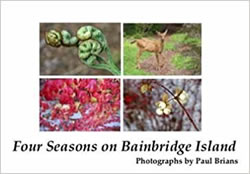 Four Seasons on Bainbridge Island is a photo essay by Paul Brians celebrating the flora of the island, some from his own garden, and accented with a few shots of people, animals, and landscapes. Highly recommended for residents of Bainbridge, this book also captures the essence of semi-rural, island living anywhere around Puget Sound.
Four Seasons on Bainbridge Island is a photo essay by Paul Brians celebrating the flora of the island, some from his own garden, and accented with a few shots of people, animals, and landscapes. Highly recommended for residents of Bainbridge, this book also captures the essence of semi-rural, island living anywhere around Puget Sound.
Excerpted from the Fall 2012 Arboretum Bulletin.
Link to this review (permalink)
Edible Heirlooms: Heritage Vegetables for the Maritime Garden by Bill Thorness, 2009
Reviewed by: Brian Thompson on 2016-02-26
Edible Heirlooms is a great little book! Little only in dimensions and number of pages, as the author carefully defines his purpose and limits his scope, but within those parameters shows you how to grow an outstanding vegetable garden in the maritime Pacific Northwest.
Most important, he sees this endeavor as part of a larger picture. "The challenge for me is to somehow integrate my vegetable-growing practices into a diverse ecosystem and, if possible, enhance biodiversity." The key for this is to use heirloom varieties that can be regrown from collected seeds. Besides the mouth-watering descriptions, you will also get an excellent history lesson.
Link to this review (permalink)
The Tao of Vegetable Gardening by Carol Deppe, 2015
Reviewed by: Brian Thompson on 2016-02-25
Carol Deppe is a witty and engaging writer based in western Oregon. Her third book on vegetable gardening, The Tao of Vegetable Gardening, is particularly valuable if you are growing tomatoes in our maritime climate, hoping to maximize your output of salad greens, or passionate about seed saving. Infused throughout are her philosophies on life and gardening, and you can read about the amazing adventures of Garden Woman, while learning some great weeding techniques, too!
Link to this review (permalink)
Straw Bale Gardens Complete by Joel Karsten, 2015
Reviewed by: Jessica Anderson on 2016-02-13
I was surprised to learn that there is a new way to grow vegetables. Inside straw bales. Yes, that is what I said, inside straw. This new book by Joel Karsten, Straw Bale Gardens Complete (Cool Springs Press, 2015), explains a method of growing and harvesting crops which is useful for increasing productivity while reducing labor. The chapters thoroughly cover planning your straw bale garden, and making straw bale greenhouses. There are extensive pages of garden layouts, including single, two, and three-bale gardens with tomato cages, trellises, and suggested plants. This approach to container gardening is using the straw bale itself, held together with two or three strings, with the outside crust of the bale serving as the container. The straw inside the bale will decompose, making it "conditioned" and ready to plant. The author gives step by step instructions for conditioning to create a warm, moist and nutrient rich rooting environment for seedlings. The author points out that straw bale gardens are ideal if you can't do heavy lifting, can't bend over, have poor soil, or limited space.
One thing to keep in mind is the difference between hay and straw, which often are confused. Straw comes from one of the cereal small-grain plants. Most common are oats, wheat, barley, rice, flax and rye. Hay is green, more coarse and wiry than straw. Hay can be baled alfalfa or any dozens of different grasses. Hay is fed to livestock as fodder. It contains all the seed heads inside the bale. But hay is not desirable for bale gardens. The book explains how to find and maintain the best straw for growing plants. If you are looking for a source for straw in the Seattle area, I've been able to supply my chickens with straw from The Grange in the University District. I also recommend using organic straw for vegetable gardening because you will want straw that has not been treated with herbicides or pesticides. Organic bales are usually sold at about the same prices as conventional ones.
Link to this review (permalink)
A Dictionary of English Plant Names by Geoffrey Grigson, 1974
Reviewed by: Rebecca Alexander on 2015-08-13
You may never have wondered about the etymology of vernacular names for plants, but Geoffrey Grigson, author of A Dictionary of English Plant Names (Allen Lane, 1974), has. Why exactly is 'henbane' (Hyoscyamus niger) the bane of hens, aside from the fact that it is toxic? It might be because the plant thrives on disturbed or hen-scratched earth, where hens would be more likely to find and consume its poisonous seeds (which will either stun or kill them). [There is a more recent interpretation suggesting that the ancient root hen meant death, but the meaning was lost, and relating the name to domestic fowl filled in the knowledge gap. Source: An Analytic Dictionary of English Etymology by Anatoly Liberman, University of Minnesota, 2008]
The folk history of traditional English plant names is colorful and captivating. 'Brank-ursine' is a 15th century name meaning bear's claw, describing the shape of an Acanthus mollis flower. One common name for Sedum telephium is 'Midsummer Men,' originating in a loves-me-loves-me-not game of the 17th century in which cook-maids and dairy-maids placed pairs of stems in chinks in the wall and waited to see if they inclined toward or away from each other. Every time I consult this book I learn something new and fascinating.
Link to this review (permalink)
Edward Bawden's Kew Gardens by Peyton Skipwith, 2014
Reviewed by: Rebecca Alexander on 2015-06-06
This book defies easy categorization. Bawden was a renowned British illustrator, graphic artist, and painter who served as an official War Artist during World War II. He and his contemporary Eric Ravilious studied with surrealist landscape painter and engraver Paul Nash, and his influence can be felt in Bawden's lively calligraphic line, and his modernist approach to landscapes and cityscapes. Until exploring this book, I was most familiar with his posters for London Transport, depicting sights and scenes around London.
The first section of the book reproduces Bawden's very early manuscript (created when he was just twenty), A General Guide to the Royal Botanic Gardens Kew, Spring and Easter 1923. The second section is a brief but eccentric sociocultural history of Kew, incorporating Kew-inspired illustrations, verse, and humor. The third section is a selection of Bawden's wry illustrations for Robert Herring's Adam and Evelyn at Kew. The last section summarizes his lifelong artistic fascination with Kew. Those who are interested in 20th century art and the history of Kew will find it a fascinating book to read and savor.
Link to this review (permalink)
Flowers of Volunteer Park Conservatory by Sara L. Chapman, 2011
Reviewed by: Brian Thompson on 2012-10-01
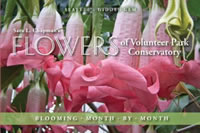 Flowers of Volunteer Park Conservatory is one of the best examples I've seen of a book capturing the spirit of a public garden. Photographer Sara L. Chapman has created monthly visual essays, using both close-ups and panoramas to bring you into the page and remind you of a real life visit. But this is more than just a picture book. The subjects of the photos are carefully captioned, making this a useful identification handbook to conservatory plants.
Flowers of Volunteer Park Conservatory is one of the best examples I've seen of a book capturing the spirit of a public garden. Photographer Sara L. Chapman has created monthly visual essays, using both close-ups and panoramas to bring you into the page and remind you of a real life visit. But this is more than just a picture book. The subjects of the photos are carefully captioned, making this a useful identification handbook to conservatory plants.
Excerpted from the Fall 2012 Arboretum Bulletin.
Link to this review (permalink)
Evolution of the Genus Iris by Robert Michael Pyle, 2014
Reviewed by: Rebecca Alexander on 2014-07-23
The title of Robert Michael Pyle's most recent book might fool readers into supposing it a scholarly treatise aimed at the ultra-specialist in the Family Iridaceae. Look inside the cover of Evolution of the Genus Iris and all will become clear: these are poems of everyday life from the particular perspective of a Pacific Northwest naturalist.
The Miller Library has several other books by Pyle (including Wintergreen about the ecology of the Willapa Hills, and The Butterflies of Cascadia : A Field Guide to All the Species of Washington, Oregon, and Surrounding Territories). These plain-spoken poems feature garden perennials, reflections on the Palouse Giant Earthworm, longhorn beetles, butterflies, banana slugs, and how could I resist mentioning a paean to librarians.
One of my favorites in this first collection of poems is "Botany Lesson: Cleome." It begins, "He called it bee balm, but I heard bee bomb." The poet and his friend are on a butterfly-collecting trip, encountering specimens of wild Cleome. Pyle points out that Theophrastus's coinage of Cleome was based on a mistaken notion that the plant was related to mustard, when it is actually "a caper called spider plant, or bee / plant, for the love of honeybees but never bee balm." It's a poem of friendship and reminiscence as well as an observation about the complexities and accidental poetry of naming things.
Link to this review (permalink)
Encyclopedia of Conifers by Aris G. Auders, 2012
Reviewed by: Brian Thompson on 2014-03-12
The moment I opened this massive, two-volume set, I was immediately engaged. Page after page of high quality photographs show the seemingly endless variety of cultivated forms of conifers--it's mesmerizing.
"Encyclopedia of Conifers" illustrates nearly 5,000 different cultivars, along with the species they are derived from--often with multiple photos from different times of year, or at different ages, or in various horticultural presentations. The variety of cones alone could fill its own book. While these trees are popularly known as evergreens, the rich variety of blues, silvers, golds, and browns along with the rich reds and purples of cones belies that name.
While the photographs are stunning, this is not just a picture book. The authors have notable credentials: Aris Auders maintains one of Europe's largest collections of conifers cultivars in Latvia, while Derek Spicer is the chairman of the British Conifer Society. Their goal was to create a reference work that is both comprehensive in its listing of cultivars and well-illustrated, a combination lacking in earlier publications on this subject.
The result will be the standard for years to come. While the photographs would stand on their own, the text provides description of each species in the wild, including range, elevation, size, notable characteristics, a description of the cones and hardiness zone (using USDA standards). For each cultivar that follows there is a description, origin if known, synonyms, misspellings, and citations to the name in older books, nursery catalogs, websites, and arboretum holdings. This piece too, could stand on its own.
Link to this review (permalink)
Conifers around the World by Zsolt Debreczy, 2011
Reviewed by: Brian Thompson on 2014-03-12
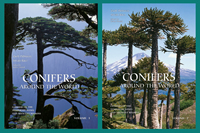 It is a nice balance that a publication of equal stature to the RHS encyclopedia on cultivated conifers has been recently published on conifers in the wild. "Conifers around the World" authors Zsolt Debreczy and István Rácz have been working together since 1975. The predecessor to this current title was published in 2000 in their native Hungarian; Kathy Musial of the Huntington Botanical Gardens provides valuable editing skills to this much expanded English edition.
It is a nice balance that a publication of equal stature to the RHS encyclopedia on cultivated conifers has been recently published on conifers in the wild. "Conifers around the World" authors Zsolt Debreczy and István Rácz have been working together since 1975. The predecessor to this current title was published in 2000 in their native Hungarian; Kathy Musial of the Huntington Botanical Gardens provides valuable editing skills to this much expanded English edition.
The result is massive (again, in two volumes), but very manageable. The authors' intention is to "present photographs of conifers in their natural habitats in a consistent format." These larger images are breathtaking, and are supplemented with close-up photos of cones, leaves, and any distinguishing features. The accompanying text is concise but unlike some botanical descriptions is very readable and reflects the authors' sensitivity to conservation, local culture and ethnobotany.
The focus is on temperate species, and the layout is by broad geographical areas with a detailed description of the geological, vegetative, climatic and human history of each. Maps are used liberally to show topography, sites of major conifer forests, floristic provinces, and the ranges of species. The extensive introduction is a joy to read despite covering some pretty dense subjects, including taxonomy, conifer identification, morphology (lots of drawings help the reader with these), and the history of the earth's climate and other factors that have impacted the distribution of conifers we find today.
The appendix is also fun, with various essays that didn't quite fit elsewhere, and a "bark gallery" giving eye level close-ups. The Pacific Northwest is clearly dear to these Europeans, as the two photos that accompany the Preface are from Washington State, including the authors' portrait standing in front of a giant Sitka spruce (Picea sitchensis) in Olympic National Park. On the inside of the back cover of Volume 2 is the "Sell the Land?" speech attributed to Chief Sealth; a suitable closure to this very rigorous but also very passionate and personal publication.
Link to this review (permalink)
Conifers of the World: The Complete Reference by James E. Eckenwalder, 2009
Reviewed by: Brian Thompson on 2014-03-12
James Eckenwalder graduated from Reed College in Portland, making him a one-time Pacific Northwest resident, although he is now on the faculty at the University of Toronto. "Conifers of the World: The Complete Reference" is an ambitious effort that was years in the making. It is an excellent reference book in a single volume.
Tropical species are given equal treatment to temperate and the A-Z presentation emphasizes descriptive text--there are only a few photos and those are mostly in black and white. The introduction includes a very readable discussion of taxonomy; the author is clearly captivated by the subject but is able to make his points in terms for a general audience. "My overriding motivation behind all of these considerations, however, is to share my fascination and enthusiasm for these wonderful plants."
Link to this review (permalink)
Designing with Conifers by Richard L. Bitner, 2011
Reviewed by: Brian Thompson on 2014-03-12
 Richard Bitner has written three books about conifers in the garden; I think the best is the most recent, "Designing with Conifers." Organized by notable features such as shape, color, or bark, the author uses his own photographs to illustrate a wide range of planting options. He clearly detests foundation plantings: "Why this mandatory dress code? It is time to break free of this tradition and change our practices."
Richard Bitner has written three books about conifers in the garden; I think the best is the most recent, "Designing with Conifers." Organized by notable features such as shape, color, or bark, the author uses his own photographs to illustrate a wide range of planting options. He clearly detests foundation plantings: "Why this mandatory dress code? It is time to break free of this tradition and change our practices."
Specialty situations such as hedges and topiary are included, along with some unexpected chapters on recommended Christmas trees, dwarf cultivars for garden railways, and--the most curious--traditional plantings for German graveyards. Although the author is from the East Coast, I thought his best work was a case study of a garden near Eugene, with a photographic dissection of the different purposes for the plants used in the landscape--quite instructive.
Link to this review (permalink)
The Front Yard Forager by Melany Vorass Herrera, 2013
Reviewed by: Brian Thompson on 2014-03-12
Melany Vorass Herrera is an enthusiastic and experienced forager who lives in Seattle. In "The Front Yard Forager" she identifies 30 common weeds found in North American cities that she recommends we add to our regular diet. I found her presentations, including recipes, beguiling--especially as my own garden is filled with several of her selections that until now I've tossed into yard waste.
Before heading to the garden or the vacant lot, however, the author has several cautionary topics to consider to keep you--the foraging consumer--safe and to ensure your collecting doesn't disrupt the ecology or social harmony of the neighborhood. Further caveats fill each plant entry, including "Poisonous Look-Alikes" and "Who Should Avoid It" warnings.
While most of the selections, such as dandelions (Taraxacum officinale), have general consensus in the literature as safe to eat, some of Vorass Herrera's other choices are less certain. This makes as a good companion book the new edition of "The North American Guide to Common Poisonous Plants and Mushrooms" by two University of Victoria authors, Nancy J. Turner and Patrick von Aderkas.
The wild sweet pea (Lathyrus latifolius) illustrates the value of consulting at least these two sources before consuming any wild plant. Vorass Herrera recommends it when identification is certain and when eaten only in moderation. Turner and von Aderkas state that "all species of Lathyrus should be regarded with caution. However, a strong case is made for the edible qualities of wild sweet pea (L. latifolius) by wild food expert John Kallas." A discussion of the arguments by Kallas follows, leaving you--the now well-informed forager--with three distinct opinions on the safety of putting this plant on your dinner table.
The importance of this is best summed up by Vorass Herrera: "The bottom line? A good forager needs to be willing to spend a little time digging for accurate information."
Excerpted from the Winter 2014 Arboretum Bulletin.
Link to this review (permalink)
The Mushroom Hunters by Langdon Cook, 2013
Reviewed by: Brian Thompson on 2014-03-12
In "The Mushroom Hunters," Seattle author Langdon Cook asks what professional foragers get for their efforts: "An itinerant life on the road, continually moving with the seasons? A low hourly wage and no chance for health insurance? A garden variety of potential wilderness pitfalls, including injury, exposure, even wild animals?"
The answer is: all of the above, but that doesn't stop this from being a very big business. The collectors, those who buy from collectors, the distributors, and even the celebrity chefs who are at the top of this commercial food chain weave in and out of these pages much like in a high-energy, first-person novel. The settings, from the Yukon to California are evocative, too, but mostly somewhat vague--the secret locations of valuable hunting grounds are not to be shared.
This is Cook's second book on foraging. The Miller Library also has "Fat of the Land" from 2009. In addition to mushrooms, this book highlights the collection practices for fiddlehead ferns, dandelions, huckleberries, and a selection of animals including clams, crabs, and various fish. Several recipes will set your mouth watering.
Link to this review (permalink)
Backyard Roots by Lori Eanes, 2013
Reviewed by: Brian Thompson on 2014-03-12
"Backyard Roots" is a collection of vignettes about urban dwellers motivated to have a closer connection to their food and their communities. There are many ways to do this, and the strength of this book is its breadth of inspiring ideas that have already been realized. Making it even better, the individuals and families profiled all live on the West Coast, from British Columbia to northern California.
Author/photographer Lori Eanes has a career in food photography and her original intent was a photo essay but, she says in her introduction, "as I learned people's stories their dedication inspired me to write about them too." While the writing is good, her camera is particularly effective at bringing out her subjects' personalities--both human and animal.
While some of the topics, such as raising ducks or goats, are addressed in detail in other books, there are several more adventuresome projects. These include raising tilapia in an aquaponic garden and grafting food fruits onto ornamental street trees, guerrilla style. I gave a copy as a Christmas gift and I recommend it highly, especially to anyone with the spirit and resourcefulness of a homesteader.
Excerpted from the Winter 2014 Arboretum Bulletin.
Link to this review (permalink)
Gardening in Miniature by Janit Calvo, 2013
Reviewed by: Brian Thompson on 2014-04-01
As a boy, I did not embrace the hobby of making models. Yes, I had a train set, but no desire to create a world of villages, forests, and the like to surround the tracks. Instead, I wanted to be outside in the garden and working with full-sized plants.
This makes me feel a bit inadequate to review "Gardening in Miniature" by Seattleite Janit Calvo. However it turns out that at its heart, this is a gardening book, with sound design advice and cultural tips, just all at 1:12 (one inch = one foot) scale, or even smaller.
"Using the basic garden tenets of anchor point, balance, layers, texture, color, and focal point, you can plan your miniature garden with confidence," the author states encouragingly. Step-by-step, fully planned projects provide lots of guidance for the beginner. I worried that plants would not stay to scale, and indeed they might not, but it's easy to swap plants in and out.
I learned from this that while there is some overlap in principles and techniques between miniature gardening and bonsai, they are largely distinct pursuits. However, they can be combined by making a bonsai the centerpiece of your miniature garden. Will I take up miniature gardening? Probably not. But my eyes have been opened to a whole new--and quite small--world.
Excerpted from the Spring 2014 Arboretum Bulletin.
Link to this review (permalink)
Fill of Joy: More Tales from Montlake Fill by Constance J. Sidles, 2013
Reviewed by: Brian Thompson on 2014-03-12
Constance Sidles has written her third book of essays and observations on the Union Bay Natural Area titled "Fill of Joy: More Tales from Montlake Fill". Like her previous books, this includes many excellent photographs and other artistic interpretations of the site (in paintings, poetry, and even dance) and an updated bird list, now counting 255 species recorded since the 1890s.
The heart of the book remains Connie's self-deprecating humor and philosophies about life. While the bird life is her focus, she spots humans and other visitors, too. "When the joggers wheeze by they smile and say hello. I don't know their names, but I know them. The dog walkers who keep their dogs leashed stop to chat while I ruffle their friends' ears; the dog walkers who let their dogs run free usually head the other way "my gimlet eyes are giving them the Look."
Link to this review (permalink)
Beatrix Potter's Gardening Life by Marta McDowell, 2013
Reviewed by: Rebecca Alexander on 2013-11-16
Part biography, part garden photo essay, and part ventriloquist's act, Marta McDowell's Beatrix Potter's Gardening Life (Timber Press, 2013) provides a window into Potter's world. If you have read her children's books, you will have a lasting impression of the charming adventures of rabbits, hedgehogs, kittens, and ducks but you may not think of Beatrix Potter as a botanical illustrator. I was surprised to discover that the highly accomplished sketch of foxglove and periwinkle on page 27 was made when she was only ten. The best feature of this book is the gathering together of selected drawings and watercolors of plants, fungi, and landscapes. Potter's natural history illustrations (particularly of mushrooms) are featured in Ambleside's Armitt museum.
Potter was also a certifiable plant addict, and was not averse to gathering cuttings and seeds in gardens not her own. Royalties from her publications enabled her to acquire property and land, so she ended up with several gardens in England's Lake District. The weakest part of the book is McDowell's attempt to channel Beatrix (as she takes the liberty of calling her) by paraphrasing from her journals and letters to feature aspects of the gardens through the seasons. The accompanying photos are glorious (I am captivated by Hill Top garden's green-painted wrought-iron gate rimed with frost), but it would have been better simply to quote Potter directly.
Link to this review (permalink)
Free-range chicken gardens : how to create a beautiful, chicken-friendly yard by Jessi Bloom, 2012
Reviewed by: Brian Thompson on 2013-01-01
Jessi Bloom is a strong advocate for chickens in almost any garden setting, and in "Free-Range Chicken Gardens," she provides detailed information on compatible plantings--including those that provide food for chickens--and structures that meet the multiple needs of fowl and flora. There is a lot of well-organized information in these pages on all other related topics, too, making this of value to chicken keepers at any experience level. But you can also just enjoy the profiles of gardeners and their chickens (many are local) or the many superb photographs (by Kate Baldwin) of contented hens in their gardens, proving their value as a natural compliment.
Excerpted from the Winter 2013 Arboretum Bulletin.
Link to this review (permalink)
A chicken in every yard : the Urban Farm Store's guide to chicken keeping by Robert Litt, 2011
Reviewed by: Brian Thompson on 2013-01-01
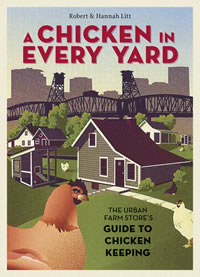 Robert and Hannah Litt own the Urban Farm Store in Portland and wrote "A Chicken in Every Yard" from experience keeping their own chickens, and helping their chicken-keeping customers. While they don't disapprove of raising chickens for food, theirs are clearly pets and the book encourages this attitude with chapters like "Parenting Your Peeps." There is a lot of detail about different types and breeds, including recommendation lists such as "best for children." All stages of raising and caring are covered in depth, but the garden is only briefly mentioned. If your focus is solely on chickens, this book is an excellent choice.
Robert and Hannah Litt own the Urban Farm Store in Portland and wrote "A Chicken in Every Yard" from experience keeping their own chickens, and helping their chicken-keeping customers. While they don't disapprove of raising chickens for food, theirs are clearly pets and the book encourages this attitude with chapters like "Parenting Your Peeps." There is a lot of detail about different types and breeds, including recommendation lists such as "best for children." All stages of raising and caring are covered in depth, but the garden is only briefly mentioned. If your focus is solely on chickens, this book is an excellent choice.
Excerpted from the Winter 2013 Arboretum Bulletin.
Link to this review (permalink)
The urban farm handbook : city-slicker resources for growing, raising, sourcing, trading, and preparing what you eat by Annette Cottrell, 2011
Reviewed by: Brian Thompson on 2013-01-01
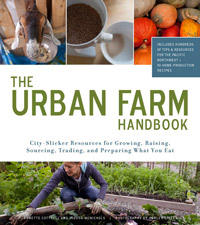 The Urban Farm Handbook is a blending of deeply personal accounts by two urban (Seattle) families seeking ways of becoming self-reliant in producing and preparing food. By sharing both the triumphs and failures (including persuading significant others), Annette Cottrell and Joshua McNichols present a lot of options for choosing your own path to provide food for yourself and loved ones. Recipes are scattered throughout, and many of those contain meat. Dealing with the angst of slaughtering various animals to supply that meat is a significant theme of the book, but here, too, the authors give you many options for finding your own comfort level.
The Urban Farm Handbook is a blending of deeply personal accounts by two urban (Seattle) families seeking ways of becoming self-reliant in producing and preparing food. By sharing both the triumphs and failures (including persuading significant others), Annette Cottrell and Joshua McNichols present a lot of options for choosing your own path to provide food for yourself and loved ones. Recipes are scattered throughout, and many of those contain meat. Dealing with the angst of slaughtering various animals to supply that meat is a significant theme of the book, but here, too, the authors give you many options for finding your own comfort level.
Excerpted from the Winter 2013 Arboretum Bulletin.
Link to this review (permalink)
The urban food revolution : changing the way we feed cities by Peter Ladner, 2011
Reviewed by: Brian Thompson on 2013-01-01
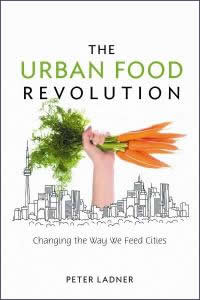 Peter Ladner writes The Urban Food Revolution from the perspective of a policy maker--he was a two-term City Councillor in Vancouver, B.C.--and a journalist. This is not a gardening book or even an urban farming book, but it does examine issues that impact food production and distribution in an urban setting with the goal of telling policymakers "...what they can do to improve access to healthy food for all the people they represent." Subjects addressed include food deserts, childhood obesity, designing new developments with urban farming options, and the safety of locally raised food.
Peter Ladner writes The Urban Food Revolution from the perspective of a policy maker--he was a two-term City Councillor in Vancouver, B.C.--and a journalist. This is not a gardening book or even an urban farming book, but it does examine issues that impact food production and distribution in an urban setting with the goal of telling policymakers "...what they can do to improve access to healthy food for all the people they represent." Subjects addressed include food deserts, childhood obesity, designing new developments with urban farming options, and the safety of locally raised food.
Excerpted from the Winter 2013 Arboretum Bulletin.
Link to this review (permalink)
Grow Cook Eat by Willi Galloway, 2012
Reviewed by: Brian Thompson on 2013-01-01
Many vegetable gardening books include recipes but few are as well integrated as in "Grow Cook Eat" --for Willi Galloway cooking follows sowing, growing, and harvesting as the next logical step (presumably followed by eating). In addition to the formal recipes (none are particularly complex), there are oodles of simple ideas for using the vegetable (or herbs, or even a few fruits) at hand in creative and delicious ways. Jim Henkens's photos expertly capture growing plants, the fresh harvest, and the serving plate, encouraging you to give it a try. The general culture section is brief but sufficient--the goal here is to get growing and get eating--yum!
Excerpted from the Winter 2013 Arboretum Bulletin.
Link to this review (permalink)
Winter Gardening in the Maritime Northwest by Binda Colebrook, 2012
Reviewed by: Brian Thompson on 2013-01-01
Binda Colebrook is on her fifth edition (the first from 1977) of the classic "Winter Gardening in the Maritime Northwest," and it's still a must for any serious food gardener. The emphasis is on crops that will grow throughout the year, so no tomatoes or corn, but instead you'll discover many options that are really better suited for our mild climate. There is much emphasis on ways to reduce the impact of freezes, heavy rains, and cold winds, but Colebrook is great at encouraging experimentation even if your property doesn't have perfect conditions. An excellent reference section completes the book.
Excerpted from the Winter 2013 Arboretum Bulletin.
Link to this review (permalink)
Vertical Vegetables and Fruit by Rhonda Massingham Hart, 2011
Reviewed by: Brian Thompson on 2013-01-01
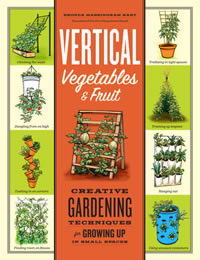 Here is another approach to dealing with limited space: grow up. Vertical Vegetables and Fruit is one of the very few books focused on this technique of food-growing. Some of the featured vegetables and fruits are naturals (beans or kiwi), but many are not. And while the thought of a high-flying watermelon may take a bit of getting used to, the author devotes several pages to slings and other support devices to make this possible. There are many unconventional ideas here to try, including hanging bags and living walls, along with some more familiar espaliers of fruit trees and strawberry pots. The emphasis is on innovation and experimentation--and having fun with your veggies (and fruit)!
Here is another approach to dealing with limited space: grow up. Vertical Vegetables and Fruit is one of the very few books focused on this technique of food-growing. Some of the featured vegetables and fruits are naturals (beans or kiwi), but many are not. And while the thought of a high-flying watermelon may take a bit of getting used to, the author devotes several pages to slings and other support devices to make this possible. There are many unconventional ideas here to try, including hanging bags and living walls, along with some more familiar espaliers of fruit trees and strawberry pots. The emphasis is on innovation and experimentation--and having fun with your veggies (and fruit)!
Excerpted from the Winter 2013 Arboretum Bulletin.
Link to this review (permalink)
The Dirt-Cheap Green Thumb by Rhonda Massingham Hart, 2009
Reviewed by: Brian Thompson on 2013-01-01
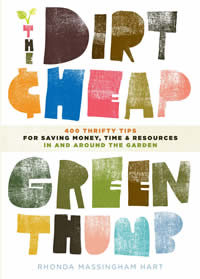 Massingham Hart has re-engineered another of her older titles with "Dirt-Cheap Green Thumb". This is essentially a general gardening book (including ornamentals) packaged in short, snappy bits of information and is perfect for the newer gardener who is anxious to get started right now. The reader who is frugal will even be more pleased as there are lots of tips (400 according to the sub-title) for saving money while growing the garden of your dreams.
Massingham Hart has re-engineered another of her older titles with "Dirt-Cheap Green Thumb". This is essentially a general gardening book (including ornamentals) packaged in short, snappy bits of information and is perfect for the newer gardener who is anxious to get started right now. The reader who is frugal will even be more pleased as there are lots of tips (400 according to the sub-title) for saving money while growing the garden of your dreams.
Excerpted from the Winter 2013 Arboretum Bulletin.
Link to this review (permalink)
Apartment Gardening by Amy Pennington, 2011
Reviewed by: Brian Thompson on 2013-01-01
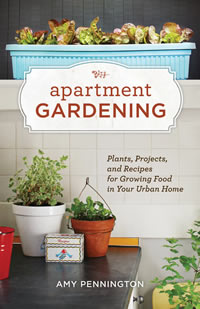 Apartment Gardening takes the whole concept of gardening in your available space a step farther, or I should say, smaller. Amy Pennington has considerable gardening experience in a setting with plentiful space, but now confined to a Seattle apartment, she wasn't about to stop. She distills her plant selections to a short but well-tested list. Some surprised me (zucchini on a balcony?) but overall I was impressed by the what-works approach. Large compost bins are out, but worm bins are still possible; she even advocates a beehive on the deck. But check with the neighbors first! Hers nixed the idea. Helpful recipes use only the plants listed, and include making lip balms and lotions, and herbal teas.
Apartment Gardening takes the whole concept of gardening in your available space a step farther, or I should say, smaller. Amy Pennington has considerable gardening experience in a setting with plentiful space, but now confined to a Seattle apartment, she wasn't about to stop. She distills her plant selections to a short but well-tested list. Some surprised me (zucchini on a balcony?) but overall I was impressed by the what-works approach. Large compost bins are out, but worm bins are still possible; she even advocates a beehive on the deck. But check with the neighbors first! Hers nixed the idea. Helpful recipes use only the plants listed, and include making lip balms and lotions, and herbal teas.
Excerpted from the Winter 2013 Arboretum Bulletin.
Link to this review (permalink)
The Lavender Lover's Handbook by Sarah Berringer Bader, 2012
Reviewed by: Brian Thompson on 2013-01-01
Many urban farming and vegetable gardening books include lavender as a staple plant, but "The Lavender Lover's Handbook" provides much greater detail on the particular needs and benefits of these sub-shrubs. Sarah Berringer Bader is a lavender farmer in western Oregon and shares her expertise on selection, planting, maintaining, harvesting, and--yes!--cooking with lavender. Best is her selection of cultivars for various purposes such as best scent, richest color (in various hues), or in a landscape. She even includes the best choices for using in her recipes. An encyclopedia of available varieties is quite thorough and enhanced by Janet Loughrey's skilled photography.
Excerpted from the Winter 2013 Arboretum Bulletin.
Link to this review (permalink)
Handmade Garden Projects by Lorene Edwards Forkner, 2011
Reviewed by: Brian Thompson on 2013-01-01
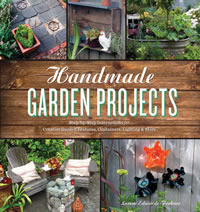 Lorene Edwards Forkner has addressed a real need on the Garden Library bookshelf. While there are a handful of books (none of them by local authors) about using foraged materials for garden decoration, none adequately take the next step of using these materials to create useful yet attractive objects that we all need in our gardens. Handmade Garden Projects has everything from fountains to potting benches with clear instructions and lots of encouragement to build these yourself, at a fraction of the cost of having someone else be your handy man or woman. Another plus: many of the examples are from gardens created by familiar people in the Seattle area horticultural community.
Lorene Edwards Forkner has addressed a real need on the Garden Library bookshelf. While there are a handful of books (none of them by local authors) about using foraged materials for garden decoration, none adequately take the next step of using these materials to create useful yet attractive objects that we all need in our gardens. Handmade Garden Projects has everything from fountains to potting benches with clear instructions and lots of encouragement to build these yourself, at a fraction of the cost of having someone else be your handy man or woman. Another plus: many of the examples are from gardens created by familiar people in the Seattle area horticultural community.
Excerpted from the Winter 2013 Arboretum Bulletin.
Link to this review (permalink)
Edible Landscaping by Senga Lindsay, 2012
Reviewed by: Brian Thompson on 2013-04-01
"Edible Landscaping" is not your typical vegetable gardening book. You will not find an A-Z encyclopedic listing of popular vegetables, nor is there much cultural information specific to each crop. Instead, this is a garden design book with an eye to making edible plants the key feature.
Author Senga Lindsay, a landscape designer and gardener in North Vancouver, B.C., challenges and encourages you, the home gardener, to take charge of your garden's appearance and assumes that you don't want your "...yard to look like a 'dog's breakfast'--messy, unkempt and utilitarian." After outlining basic planning steps, she presents fifteen different model gardens, each with detailed plans, lists of needed supplies, and step-by-step procedures for installation.
These plans range from the traditional row garden to green roofs and walls to parking strips. Your garden may need to satisfy a gourmet chef, or accommodate a disabled gardener, or engage young children--all are addressed with the same level of detail. While you can follow one plan to the letter, the elements from the plans can easily be blended as needed.
Excerpted from the Spring 2013 Arboretum Bulletin.
Link to this review (permalink)
Gardens Aflame by Maleea Acker, 2012
Reviewed by: Brian Thompson on 2013-04-01
Gardens have taken many forms, depending on the time and culture nurturing them. "Gardens Aflame" considers the gardens created by the indigenous people of the greater Victoria area before the arrival of Europeans. At first, we might not recognize these spaces as gardens, but the Garry Oak (Quercus garryana) meadows were carefully maintained to provide valuable camas roots (Camassia quamash and C. leichtlinii), a staple of the native diet.
Maleea Acker takes a keen interest in the history of these meadows and the efforts to preserve and restore them. As one would expect, these are under threat from expanding development and invasive species. But another challenge comes as the native people can no longer provide the management that kept more aggressive native species (especially Douglas-fir, Pseudotsuga menziesii) from encroaching.
"Meadows were kept clear by the Coast Salish for thousands of years before the arrival of Europeans, and served as a food source for many First Nations up and down the west coast and into the Interior." While camas was the main crop, other plants were also harvested, and the gardens became important places for people to gather, just as they are today.
Excerpted from the Spring 2013 Arboretum Bulletin.
Link to this review (permalink)
From the Hands of a Weaver by Jacilee Wray, 2012
Reviewed by: Brian Thompson on 2013-04-01
"From the Hands of a Weaver" is a history of basket making on the Olympic Peninsula, edited by Jacilee Wray. Gardening was an important part of this craft as "...sophisticated techniques conducted by indigenous cultures altered the landscape, the species composition, and individual plants, ensuring that the highest-quality basketry materials were continuously available for use."
Several plants were used in this craft, ranging from the mighty cedars (Thuja plicata) to more humble beargrass (Xerophyllum tenax), but all required intimate knowledge of these plants for the best results. I found the practices used by the different tribes, from plant selection and harvest to the design and production of the baskets, very engaging.
Excerpted from the Spring 2013 Arboretum Bulletin.
Link to this review (permalink)
Garlic! Grow West of the Cascades by Frank Parente, 2006
Reviewed by: Brian Thompson on 2013-04-01
 "Garlic! Grow West of the Cascades" is a charming and infectious little book--that will make you eager to grow lots of this culinary staple. At least, that was my reaction as Frank Parente has an enthusiasm rarely matched by other garden writers. Based on Whidbey Island, but channeling his garden loving, Italian ancestors on both sides of his family tree, he writes to "...cover some pointers that will ensure success in wet and humid Western Washington."
"Garlic! Grow West of the Cascades" is a charming and infectious little book--that will make you eager to grow lots of this culinary staple. At least, that was my reaction as Frank Parente has an enthusiasm rarely matched by other garden writers. Based on Whidbey Island, but channeling his garden loving, Italian ancestors on both sides of his family tree, he writes to "...cover some pointers that will ensure success in wet and humid Western Washington."
You will need these pointers, as the many varieties of garlic require specialized handling for optimum results. But don't worry; the author takes you carefully through the many selections. He also spares no detail on soil preparation, planting, harvesting, curing, and storing, all supplemented with his instructive photographs and diagrams. You're in good hands!
Excerpted from the Spring 2013 Arboretum Bulletin.
Link to this review (permalink)
City Goats by Jennie P Grant, 2012
Reviewed by: Brian Thompson on 2013-04-01
Jennie P. Grant brings a full measure of enthusiasm to "City Goats," a combination how-to manual, goat keeping manifesto, and love story, made all the better by its Seattle setting. While much of the care-giving information would apply to goats anywhere, the author's campaign to legalize her herd is especially compelling because of its local connections.
I'm not likely to start my own herd, but I couldn't help getting hooked by the exploits and personalities of Brownie, Snowflake, Maple, and Eloise. Is this a gardening book? Perhaps not, as the author makes it very clear that your goats and your roses are not good companions. However as the model of the urban farm continues to flourish, you may embrace having your own source of milk and veggies, from securely separated sites, of course.
Excerpted from the Spring 2013 Arboretum Bulletin.
Link to this review (permalink)
The One-Block Feast by Margo True, 2011
Reviewed by: Brian Thompson on 2013-04-01
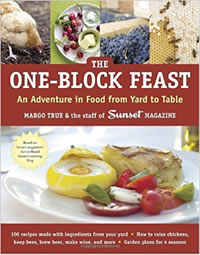 From a publisher a bit out of the region but very familiar to us all is The One-Block Feast by Margo True and the staff of Sunset Magazine. Essentially this is a scrapbook of the an on-going experiment to grow, harvest, prepare, and cook a full menu, all from very local sources--the Menlo Park, California campus of this long-time fount of wisdom for gardeners throughout the west.
From a publisher a bit out of the region but very familiar to us all is The One-Block Feast by Margo True and the staff of Sunset Magazine. Essentially this is a scrapbook of the an on-going experiment to grow, harvest, prepare, and cook a full menu, all from very local sources--the Menlo Park, California campus of this long-time fount of wisdom for gardeners throughout the west.
While one must make modifications for the Pacific Northwest (a calendar of regionally adjusted planting and harvesting dates in the appendix will help), you can't help but come away from reading this book full of ideas. The staff formed teams by food type, and weren't afraid to tackle almost anything from honey to cheese, or beer to olive oil. I thought the stories of Team Salt and Team Escargot were the most intriguing.
Excerpted from the Spring 2013 Arboretum Bulletin.
Link to this review (permalink)
Guide to Pruning by Cass Turnbull, 2012
Reviewed by: Brian Thompson on 2013-04-01
Cass Turnbull needs no introduction to our readers and a new book by her is a cause for celebration. Her "Guide to Pruning" is now available in its 3rd edition with three added chapters, including a much needed essay on Taming the Native-Plant Garden. She also addressed an impressive list of new plants not considered in the earlier editions, including "whackables" such as Lavatera and Perovskia. Oh, how I wish I had read about the dangers of whacking too soon--before making my mid-February cutbacks in my own garden.
Excerpted from the Spring 2013 Arboretum Bulletin.
Link to this review (permalink)
It's a Jungle Out There! by Cass Turnbull, 1988
Reviewed by: Brian Thompson on 2013-04-01
"It's a Jungle Out There!" is a collection of essays by Cass Turnbull from the time of the founding of Plant Amnesty. It give some perspective and appreciation for the success of her efforts in educating the public and professionals on proper tree and shrub care. While not available to borrow, this book is worth looking at for its history and, especially, the charming diagrams.
Excerpted from the Spring 2013 Arboretum Bulletin.
Link to this review (permalink)
David Douglas: A Naturalist at Work by Jack Nisbet, 2012
Reviewed by: Brian Thompson on 2013-07-01
Jack Nisbet's first book about David Douglas ("The Collector" from 2009) was a very popular, journal-like life chronology of the intrepid plant explorer. The enthusiastic response led the author to realize "...I had only begun to touch the dynamic worlds he [Douglas] saw. So I went back on the trail, revisiting places he had described, checking on species of flora and fauna he had collected, following any lead that might reveal additional facets of his career and character."
The result is a new book, "David Douglas: A Naturalist at Work." Instead of a year-by-year account, this is a delightful collection of essays that explores themes as they played out over Douglas's entire, all-too-short career. Several chapters explore the different groups of people he worked or lived amongst including Native Americans, fur traders, sea farers, and members of the scientific community in England and North America. He did his best to fit in with all and this may explain much of his success as a collector--his eager personality encouraged others to share their knowledge or provide help with explorations.
This new book also incorporates observations from current day researchers that are influenced by Douglas almost two centuries later. For example, he was very enamored with the Garry Oak (Quercus garryana) and the communities it formed in the Pacific Northwest. Present day biologist Peter Dunwiddie has tried to understand why these communities are so rare today. While Dunwiddie concludes there are several factors, the most important is "...the way Native Americans throughout the region systematically set fire to these open oak woodlands," a practice that did not continue after the early 19th century.
Excerpted from the Summer 2013 Arboretum Bulletin.
Link to this review (permalink)
The Timber Press Guide to Vegetable Gardening in the Pacific Northwest by Lorene Edwards Forkner, 2012
Reviewed by: Brian Thompson on 2013-07-01
In "The Timber Press Guide to Vegetable Gardening in the Pacific Northwest," Lorene Edwards Forkner gives a whole calendar of ideas of what to plant and what to harvest every month--what's unusual is that the chapter on January, while having fewer pages, is still on equal footing with June, rather than be relegated to an off-season category.
Does year-round engagement with your garden sound daunting? Relax. Further reading encourages a steady but gentle approach--no more herculean "putting in the garden" effort in the spring--instead be strategic and realistic about how much garden you can handle and thankful for the bountiful resources of our region to provide what you leave out.
While this book is packed with information, it will work well for the novice, as Forkner is good with pointers for getting started. "If you are a beginning gardener, I recommend you learn to love your hose. Time spent at the end of it is the best education and the most accurate barometer of your garden's needs." I totally agree.
She also has some interesting ideas for the experienced gardener. She divides her veggies by flavor profiles, and then considers what fits into, for example, "sweet leaves" or "hearty greens." Within each category there are plant options that which will give you a similar taste result, but some are easier to grow, or provide a harvest at different times of the year. This can simplify the planting list enormously.
Excerpted from the Summer 2013 Arboretum Bulletin.
Link to this review (permalink)
Cool Season Gardener by Bill Thorness, 2013
Reviewed by: Brian Thompson on 2013-07-01
Most vegetable gardening books have a long, encyclopedic listing of favorite crops with a relatively short introduction to general cultural. In "Cool Season Gardener," Bill Thorness takes a very different approach--the A-Z listing is confined to a short chapter near the end of the book. While these few pages do contain some excellent recommendations for the late summer-to-spring garden, the heart of this book focuses on the practices of vegetable growing, especially for the cooler months.
To do this, the author invites you to change some of your basic concepts, including dividing the year into only four seasons. "Wanting to tend my garden continually throughout the year in our mild climate has made me chop up our seasons into a few 'miniseasons' so I can more easily plan and plant." Spring stretches into three parts from mid-February to mid-July. Summer is a short two-month season. Fall, in two parts (early and late), extends until Thanksgiving, while winter fills the dark months until early spring.
This is an interesting way to revamp the calendar, but more importantly it gives structure to the planting and harvesting schedule. Sadly, it also emphasizes that short summers are a fact of maritime Pacific Northwest life. But don't despair; the goal of this book is to help you make a success of those long, cool seasons.
Much of this is accomplished with techniques. One whole chapter discusses simple steps for extending the growing season. The next chapter (the longest in the book) covers advanced practices--to a depth of detail not found in other veggie books. Once you've absorbed the theory, the appendix gives you the specifics for numerous building projects. This makes it the perfect book for a handy-with-construction gardener--or perhaps the partnership of a handyperson and a gardener.
Unlike some do-it-yourself books, Thorness keeps everything upbeat and sprinkled with practicality and humor--and always with options depending on your skills and resources. "My brain agitates crazily like an old washing machine when I walk through the secondhand stores. Sometimes I take home a box of treasures; other times I leave with just ideas." You will leave with a treasure of ideas from this book.
Excerpted from the Summer 2013 Arboretum Bulletin.
Link to this review (permalink)
Slow Flowers by Debra Prinzing, 2012
Reviewed by: Brian Thompson on 2013-07-01
"Slow Flowers" is something of a sequel to "The 50 Mile Bouquet," Debra Prinzing's previous book (co-created with photographer David Perry) about local and sustainable cut flower vendors. In this book, she uses the produce (flowers, leaves, seedpods, cones, and other plant material) from those vendors, plus cuttings from her own yard and those of friends to create a calendar full of arrangements, one for each week of the year.
The process for creating each week's offering is carefully recorded, both in narrative and with an ingredient list complete with sources and a count of each stem. I found the detailed descriptions of the vases, some quite historical, particularly interesting. Tips on design, finding materials, assembling your bouquet--without the use of environmentally unfriendly florist foam--and preserving it when done are sprinkled throughout the book, and in a helpful reference section at the end.
What I like best about this book is the author's teacher-like approach to everything. No detail is missed, but each is gently mixed with encouragement, practicality, and a sense of fun that makes you want to participate, too.
Excerpted from the Summer 2013 Arboretum Bulletin.
Link to this review (permalink)
Fine Foliage by Karen Chapman, 2013
Reviewed by: Brian Thompson on 2013-07-01
Two Seattle area garden designers discovered they have a shared passion for leaves. The result of this synergy is "Fine Foliage," a rare garden design book in which almost no flowers are allowed. Karen Chapman and Christina Salwitz fill their book with a gallery of plant combinations highlighting leaf color, patterns, size, and shapes in both intimate and large-scale settings.
For each example there is a memorable name (like "Down the Rabbit Hole" or "Deer Be Damned!"), a summary of combined cultural needs, and a "Meet the Players" highlight of the selected plants. Most useful is the "Why This Works" paragraph that highlights the design principles behind each combination and stressing the importance of foliage first in any planting plan. Readers of "The Bulletin" will be interested to see that three of the designs for shady locations were created by Rizaniño "Riz" Reyes, a gardener on the University of Washington Botanic Gardens staff.
Excerpted from the Summer 2013 Arboretum Bulletin.
Link to this review (permalink)
Passionate Slugs and Hollywood Frogs by Patricia K. Lichen, 2001
Reviewed by: Brian Thompson on 2013-07-01
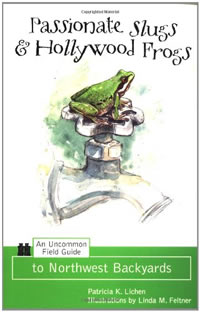 With a title like "Passionate Slugs and Hollywood Frogs," it's hard to know what to expect from the 2001 book by Patricia K. Lichen, but the sub-title helps: "An Uncommon Field Guide to Northwest Backyards." This is mainly a guide to the birds and other animals--natives and non-natives alike--who may call your backyard home, plus a few plants including iconic trees, some troublesome invasives, and even your lawn and its "three million tiny plants." The essays are short and full of whimsy, but also plenty of good information and the incentive to appreciate what you have in your own, well, backyard. The book concludes with an invitation to look up and appreciate rainbows and the stars at night--charming.
With a title like "Passionate Slugs and Hollywood Frogs," it's hard to know what to expect from the 2001 book by Patricia K. Lichen, but the sub-title helps: "An Uncommon Field Guide to Northwest Backyards." This is mainly a guide to the birds and other animals--natives and non-natives alike--who may call your backyard home, plus a few plants including iconic trees, some troublesome invasives, and even your lawn and its "three million tiny plants." The essays are short and full of whimsy, but also plenty of good information and the incentive to appreciate what you have in your own, well, backyard. The book concludes with an invitation to look up and appreciate rainbows and the stars at night--charming.
Excerpted from the Summer 2013 Arboretum Bulletin.
Link to this review (permalink)
Quiet Beauty: The Japanese Gardens of North America by Kendall Brown, 2013
Reviewed by: Brian Thompson on 2013-10-01
"Quiet Beauty: The Japanese Gardens of North America" is itself a book of quiet beauty, and an excellent introduction to Japanese-style gardens throughout Canada and the United States. Photographer David Cobb, from Mosier (near Hood River), Oregon, is particularly adept at emphasizing the contrasts between light and shadow, the subtle reflections in still waters, and the energy of moving water in his subjects. I have visited many of the 26 featured gardens and he captures the spirit of these very well.
Text author Kendall Brown is an Asian Art historian at California State University, Long Beach. His introductory essay places these gardens in the context of what he sees as five distinctive, historical periods beginning at the end of the 19th century. The Seattle Japanese Garden, along with gardens in Portland, at the University of British Columbia, and at the Bloedel Reserve on Bainbridge Island, are all placed in the second of these periods, a time of "Building Bridges" following World War II.
Feeling regional pride, I read the chapter on this period first, and I wasn't disappointed. Brown is good at telling (what are often) convoluted histories. He underscores the importance of our local gardens in the development of the Japanese style in North America: "The Seattle Japanese Garden also set a new standard as the earliest major permanent garden built in North America by well-established designers from Japan." He further compliments it as being "...arguably one of the finest in North America."
Featured in a later chapter is Spokane's Nishinomiya Garden in Manito Park, while another ten gardens from throughout Washington (including the Kubota Garden) and British Columbia are briefly described in the appendices, making this an important garden book for the Pacific Northwest. Brown's earlier (1999) book, "Japanese-Style Gardens of the Pacific West Coast", is also worth reading for a more in-depth general history of this style.
Excerpted from the Fall 2013 Arboretum Bulletin.
Link to this review (permalink)
Gardening for Sustainability by John J Albers, 2013
Reviewed by: Brian Thompson on 2013-10-01
"Gardening for Sustainability" is almost two books in one. The first part takes you on an intimate tour of the Albers Vista Gardens near Bremerton, approximately four acres lovingly crafted by author John Albers and his wife Santica Marcovina over the last 15 years. I kept a post-it note on the garden map for frequent reference as I walked page-by-page through the 14 garden rooms; the history, purpose, and plantings of each made very real by the considerable descriptive detail and excellent photographs.
"As visitors stand among the Three Islands dreaming of distant lands, they have the choice of proceeding through the open sea of crushed granite or continuing up Madrona Lane." Transitions like this hold your interest as you continue your tour, while picking up ideas to use for your own garden such as, "...the underutilized Chaste tree [Vitex agnus-castus]...is an ideal substitute for the [invasive] butterfly bush [Buddleia davidii]."
The author's enthusiasm is especially apparent in a chapter on special collections, including dwarf conifers, striped-bark and Japanese maples, and viburnums. Much of his interest in the latter genus was sparked by the collection at the Washington Park Arboretum, which he studied and described while taking classes through the Center for Urban Horticulture in the 1990s.
The second part of the book is a concise essay on landscape sustainability--excellent reading for any gardener. These principles and practices are the basis for the design and maintenance of the Albers Vista Garden, but despite best intentions the author freely admits that errors do happen. He concludes that it is best to "...learn from your mistake and move on to the next joyful garden project."
The garden is open to visitors by appointment or for special events. More information is available at www.albersvistagardens.org.
Excerpted from the Fall 2013 Arboretum Bulletin.
Link to this review (permalink)
How to Buy the Right Plants, Tools & Garden Supplies by Jim Fox, 2013
Reviewed by: Brian Thompson on 2013-10-01
Jim Fox is a consumer advocate. More specifically, a gardening consumer advocate. His goal is "...to educate you to be a savvy consumer so you can be confident that your gardening dollars are well spent." To achieve this goal, he has written a shopping guide: "How to Buy the Right Plants, Tools & Garden Supplies."
Many general gardening books touch on plant buying or tool selection, but typically at the back of the book, or in a brief introduction that the reader hastily skims over to get the real excitement--an encyclopedia of plants in glorious color. Fox recognizes how critical this basic information is for all gardeners, experienced or not, and uses clarity, broad experience, and considerable wit to engage the reader, leaving the colorful photos and plant bios to the several other books that he recommends.
I found the author's insights into the process of buying and selling plants particularly engaging, demonstrating his perspectives as both an avid collector of specialty plants, and as a long-time nursery worker. "To get good service, you need to be a good customer," he strongly recommends. For example, spouting your own expertise is a quick way to shut down any helpful advice you might have received from the true expert.
After reading this book, I have a much better appreciation for the dedicated men and women who own and run nurseries and must be skilled at managing both plants and people. All so that we can have the cool plants we really, really want.
Excerpted from the Fall 2013 Arboretum Bulletin.
Link to this review (permalink)
Alpine Plants of the Northwest by Jim Pojar, 2013
Reviewed by: Brian Thompson on 2013-10-01
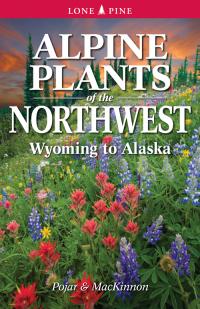 Jim Pojar and Andy MacKinnon became household names, at least among those households interested in native plants, with the publication in 1994 of "Plants of the Pacific Northwest Coast". It has been the most popular field guide in the Miller Library ever since its introduction because of its clarity, organization, plant keys, and many features that give it added value.
Jim Pojar and Andy MacKinnon became household names, at least among those households interested in native plants, with the publication in 1994 of "Plants of the Pacific Northwest Coast". It has been the most popular field guide in the Miller Library ever since its introduction because of its clarity, organization, plant keys, and many features that give it added value.
Now, the two British Columbia authors/editors have matched their earlier work with a new title, "Alpine Plants of the Northwest". While the previous work was a comprehensive study of all plants west of the Cascades, this book extends to the alpine and subalpine areas from the coast east to the Rockies, including north to the Yukon and Alaska. This is a large region, but as the number of plants that thrive above the timberline is limited it is a quite manageable guide, especially for those who hike in these areas. Like the earlier book, the Lone Pine publication has a soft but weather resistant cover, making it worth having at least one copy in your hiking party.
This model for field guides anywhere is a good blend of information for a broad range of competencies. Detailed keys required by the knowledgeable are nicely matched with photographs, drawings, and descriptions that will aid anyone in identification. Vexing, hard-to-distinguish species have additional aids, such as a conspectus with descriptive comparisons of both leaves and flowers of the many Potentilla, or leaf silhouettes of the members of the Carrot Family (Apiaceae).
But even if you are not a high country traveler, there is much to recommend in this book. The extensive introduction is much more than a how-to-use-this-guide as it provides an excellent background to the geology and climate (both historical and as changing) of the area of study, and the adaptations of the plant life. Throughout the body of plant descriptions are short sidebar essays to supplement the introduction.
Some of these are just for fun, such as the authors' top ten favorite alpines, chosen by "flower size relative to the entire plant; appearance and colour; impact factor; plant chutzpah or elan." What is number one? The Mountain Sapphire (Eritrichium nanum). Elsewhere, all five contributing authors describe their favorite alpine areas of the region.
This sense of fun is present throughout all the writing, but typically with a thoughtful point to make. "In past books, we've argued that scientific names are worth learning because they are generally more stable over time[...]it's becoming more and more difficult to make that argument with a straight face." This leads to a discussion of the changes brought often by genetic analysis in the plant genera and families. They conclude, "You can also learn scientific names to impress people", with the tabloid quality tidbit that singer/model Carla Bruni married former French president Nicolas Sarkozy partly because "he knows all the Latin names" of plants!
Excerpted from the Fall 2013 Arboretum Bulletin.
Link to this review (permalink)
Seattle's Orchards: A Historic Legacy Meets Modern Sustainability. by Audrey Lieberworth, 2012
Reviewed by: Brian Thompson on 2013-10-01
Audrey Lieberworth enjoyed an active, outdoor childhood in Seattle, but not until she left for Scripps College did she realize "...just how much the connections I made with these [Seattle] landscapes as a child had shaped the person I had become." The result of this revelation is her senior thesis, "Seattle's Orchards: A Historic Legacy Meets Modern Sustainability."
The heart of this work is a survey of eleven orchards--some historical, others recently planted--including their history, their setting in the neighborhood, and types of trees. Also reviewed are the communities supporting each orchard, broad-based programs that support the preservation of trees throughout the city, and the role of the Seattle Department of Parks and Recreation. This engaging report is available in print at the Miller Library, but also online from Scripps.
Excerpted from the Fall 2013 Arboretum Bulletin.
Link to this review (permalink)
Sir Joseph Dalton Hooker: Traveler and Plant Collector by Ray Desmond, 1999
Reviewed by: Brian Thompson on 2012-04-01
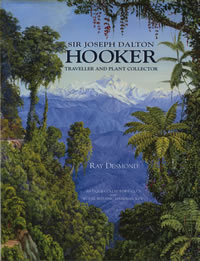 Sir Joseph Dalton Hooker: Traveler and Plant Collector (2001) by Ray Desmond is a marvelous travelogue, masking as a biography. Our hero took two multi-year expeditions (to Antarctica, New Zealand, and Australia from 1839-1843; and to India and the Himalayas from 1847-1851) as well as shorter trips to Morocco, Palestine, and the United States.
Sir Joseph Dalton Hooker: Traveler and Plant Collector (2001) by Ray Desmond is a marvelous travelogue, masking as a biography. Our hero took two multi-year expeditions (to Antarctica, New Zealand, and Australia from 1839-1843; and to India and the Himalayas from 1847-1851) as well as shorter trips to Morocco, Palestine, and the United States.
All the while he was observing, documenting, and collecting plants, leading to the publications of the native floras of these regions. Even better for us today, he was sketching the plants, landscapes, native peoples, and many other attractions. These sketches, and the botanical illustrations made by others from them, make this a richly illustrated book.
The text is engaging, detailing the trials of travel for both man and plants. Hooker "coped remarkably well with the rigours of botanising in the Himalayas. This he attributed to abstinence...a diet of meat and potatoes, and never over-eating."
"His problems as a plant collector did not cease with the boxing and parceling of plants and seeds. Sometimes they were lost or dropped into rivers on the journey to Calcutta; often they died before they reached the port." He tried wrapping seeds in "tins, oilcloth wrapping, paper packets. Sometimes he posted them in letters. But...too often they reached their destination damp or rotting or eaten by insects."
Excerpted from the Spring 2012 Arboretum Bulletin.
Link to this review (permalink)
Fruits and Plains by Philip Pauly, 2007
Reviewed by: Brian Thompson on 2012-04-01
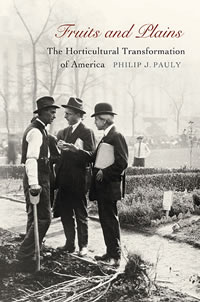 Philip Pauly was a professor of history at Rutgers University. His book, Fruits and Plains , was published by Harvard University Press. These are high academic credentials for a book that at first glance appears to be about gardening. But this is no ordinary gardening book. As suggested by the sub-title, The Horticultural Transformation of America, this is a serious study of the importance of horticulture to all aspects of American life particularly from the founding of the country well into the 20th century.
Philip Pauly was a professor of history at Rutgers University. His book, Fruits and Plains , was published by Harvard University Press. These are high academic credentials for a book that at first glance appears to be about gardening. But this is no ordinary gardening book. As suggested by the sub-title, The Horticultural Transformation of America, this is a serious study of the importance of horticulture to all aspects of American life particularly from the founding of the country well into the 20th century.
The key here is the term horticulture. To Pauly, "In general conversation it is an upmarket synonym for gardening" and includes the design, selection, and maintenance of plants in private and public gardens. But he uses the term more broadly and claims that in the 1800s, "horticulture was equivalent to what is now call plant biotechnology."
The early history he recounts is focused on utility of gardens, particularly fruit producing trees and shrubs. Later he turns to arboriculture, highlighting the arguments for and against native and exotics species; century old arguments that continue today.
But of perhaps greatest interest is chapter nine, "Culturing Nature in the Twentieth Century". Here are some keen insights to focus of gardeners today and the cultural environment at the time of the founding of the Washington Park Arboretum.
Excerpted from the Spring 2012 Arboretum Bulletin.
Link to this review (permalink)
Defiant Gardens: Making Gardens in Wartime by Kenneth I. Helphand, 2006
Reviewed by: Brian Thompson on 2012-04-01
 Defiant Gardens: Making Gardens in Wartime (2007) is not an easy book to read. The descriptions of the front lines, prison camps, Jewish ghettos, and Japanese internment camps from the first half of the 20th century are brutal, detailed, and very unsettling.
Defiant Gardens: Making Gardens in Wartime (2007) is not an easy book to read. The descriptions of the front lines, prison camps, Jewish ghettos, and Japanese internment camps from the first half of the 20th century are brutal, detailed, and very unsettling.
But this is also an important book to read. For those faced with the extremes of human suffering, "Gardens conformed to the expected cycle of seasons and growth and life; a garden was a demonstration of life in order, not a world turned upside down."
Author Kenneth Helphand is a Pacific Northwest author--a professor of landscape architecture at the University of Oregon. He was motivated to write this book by an image of French soldiers beside their small vegetable gardens created while dug in at the front of World War I. His extensive research led him around the world to visit many of the original sites, even if the gardens are long gone.
While these observations give perspective, the heart of this book are the many personal narratives the author found in his research. These tell of the efforts despite great odds to nurture a garden, of the importance these gardens gave both for sustenance and emotional well-being, and the amazing strength of the human spirit.
Excerpted from the Spring 2012 Arboretum Bulletin.
Link to this review (permalink)
Encyclopedia of Garden Ferns by Sue Olsen, 2007
Reviewed by: Brian Thompson on 2007-10-01
 Wow! This may be the crown jewel of an excellent assembly of local books for this year. If you are not a fan of ferns, Sue Olsen's infectious but very informative style will convert you. While addressing a global audience, the Encyclopedia of Garden Ferns is one of the very select treasures of Pacific Northwest garden writing and must not be missed, even if you garden on a sunny, dusty slope. The descriptions, photographs (all by the author), and cultural details are all top notch, and infused with that added extra insight only available from a writer who thoroughly knows her subject.
Wow! This may be the crown jewel of an excellent assembly of local books for this year. If you are not a fan of ferns, Sue Olsen's infectious but very informative style will convert you. While addressing a global audience, the Encyclopedia of Garden Ferns is one of the very select treasures of Pacific Northwest garden writing and must not be missed, even if you garden on a sunny, dusty slope. The descriptions, photographs (all by the author), and cultural details are all top notch, and infused with that added extra insight only available from a writer who thoroughly knows her subject.
In addition to the expected information on cultivation and propagation, Olsen covers the natural history and taxonomy of these fascinating plants, making it of interest to more than just gardeners. The many appendices are excellent, too, with the most intriguing a collection of lists of favorite species by a global who's who of fern specialists, whose gardens range from hardiness zones 4 to 11.
But the heart of the book is the tour of "Ferns from Around the World". At first glance, this resembles many A-Z listings, but there are some key enhancements not often found. Common names are listed, but these are real common names, not made up to fill a slot. The meanings of both the genus and specific epithet are given, the latter particularly useful with ferns. The description is thorough without the mind-numbing detail of many botanic writings. And the photographs are superlative, with almost all taken by the author.
This is all very good, but Olsen is at her best in the "Culture and Comments" sections. This is where you can tell what she knows is from first-hand experience, and shows of her skills as a writer, too. "Most polystichums are considered horticulturally hardy (which means temperate rather than "easy" as in some interpretations)."
Her stories will resonate with any gardener. "When my lone plant is threatened with sweeping arctic freezes, I cover it with horticultural gauze. My last carefully spread protective blanket for such nurturing was carried away by a presumably needy crow and found the following morning in the upper limbs of a neighbor's tree. The fern survived." And at carefully spaced moments, shares her passion. "This is THE species that inspired my interest in cultivation, propagation, and immersion in the wonderful world of ferns". This last sentence is in praise of Dryopteris erythrosora, the Autumn fern.
While perhaps not for the beginning gardener, I believe this book is well within the reach of anyone who has seriously embraced the craft. If that describes you, this is a must for your home library.
Excerpted from the Fall 2007 and Summer 2012 Arboretum Bulletin.
Link to this review (permalink)
Bamboo for Gardens by Ted Meredith, 2001
Reviewed by: Brian Thompson on 2012-07-01
 Bamboo for Gardens is written by Washington State resident, Ted Meredith. While most of the photos are close-ups of their subject, it's fun to see rhododendrons or a Douglas fir lurking in the background of wider shots.
Bamboo for Gardens is written by Washington State resident, Ted Meredith. While most of the photos are close-ups of their subject, it's fun to see rhododendrons or a Douglas fir lurking in the background of wider shots.
Wherever you live, this would be an important and useful book. While there is the expected A-Z encyclopedia of species, it is unusual that the introductory material--such as culture, propagation, uses in the landscape--fills more than half the book. Some unexpected treasures can be found here, including the use of bamboo in both traditional and modern economies, and tips on eating bamboo.
You will learn, for example, that the shoots of Qiongzhuea tumidissinoda "are considered exceptional." The fun continues in the encyclopedia section as we learn that this same, nearly unpronounceable species, which hails from central China, is harvested for walking sticks, and "...is the subject of history, myth, and fable in Chinese culture, dating back to at least the Han Dynasty in the first or second century B.C."
While the author keeps the writing interesting, the more mundane information is very solid, including his discussions of how to deal with "...an attack from the demonic plant that invaded unexpectedly and ceaselessly, and could not be stopped or killed." With the voice of experience and fondness that one might expect to be used on an errant puppy, Meredith carefully explains the different methods of containment for running bamboo.
Excerpted from the Summer 2012 Arboretum Bulletin.
Link to this review (permalink)
Native Trees for North American Landscapes: From the Atlantic to the Rockies by Guy Sternberg, 2004
Reviewed by: Brian Thompson on 2012-07-01
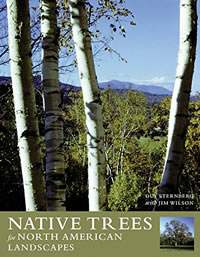 In Native Trees for North American Landscapes: From the Atlantic to the Rockies , the sub-title is very important as trees native only west of the Rockies are excluded. But almost all trees that are included can be found in the Arboretum, and many are widely planted in our region and are available in nurseries.
In Native Trees for North American Landscapes: From the Atlantic to the Rockies , the sub-title is very important as trees native only west of the Rockies are excluded. But almost all trees that are included can be found in the Arboretum, and many are widely planted in our region and are available in nurseries.
As the title suggests, authors Guy Sternberg and Jim Wilson address their book to gardeners and landscape designers, but there is also much here to interest those who love trees for their place in the natural landscape and as interwoven with human history. The quality and diversity of the photography is impressive, and well linked with the engaging text.
Excerpted from the Summer 2012 Arboretum Bulletin.
Link to this review (permalink)
The Jepson Manual : Vascular Plants of California by Bruce G. Baldwin (convening editor), 2012
Reviewed by: Brian Thompson on 2012-10-01
Many of the over 7,000 vascular plant species of California described in The Jepson Manual can also be found in the Pacific Northwest.
The name perhaps needs clarification. Willis Linn Jepson was an early 20th century botanist who published several books on California flora, including the first that was both comprehensive and statewide for vascular plants ("A Manual of the Flowering Plants of California"--1925). The 1993 first edition of "The Jepson Manual" honored his memory, and this new edition continues that honor while incorporating new discoveries and the many changes in botanical systematics of the last twenty years.
Excerpted from the Fall 2012 Arboretum Bulletin.
Link to this review (permalink)
Nonnative Invasive Plants of Pacific Coast Forests by Andrew N. Gray, et al, 2011
Reviewed by: Brian Thompson on 2012-10-01
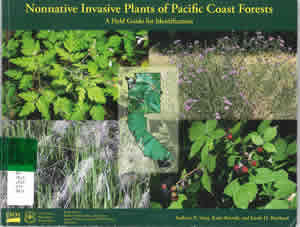 Nonnative Invasive Plants of Pacific Coast Forests is an unusual field guide that helps to identify plants you don't want to find--but you probably will--especially in the forests of Washington, Oregon, and California. In various ways, these plants are negatively affecting our native plants, animals, and ecosystems. The intent of the authors is to make these recognizable to a larger audience beyond highly trained botanists. Many selections, such as purple loosestrife (Lythrum salicaria) and herb-robert (Geranium robertianum), are all too familiar to gardeners and visitors to the Arboretum. Others will be less familiar, or you might not know they are a problem, such as some of our popular cotoneasters (Cotoneaster franchetii and C. lacteus).
Nonnative Invasive Plants of Pacific Coast Forests is an unusual field guide that helps to identify plants you don't want to find--but you probably will--especially in the forests of Washington, Oregon, and California. In various ways, these plants are negatively affecting our native plants, animals, and ecosystems. The intent of the authors is to make these recognizable to a larger audience beyond highly trained botanists. Many selections, such as purple loosestrife (Lythrum salicaria) and herb-robert (Geranium robertianum), are all too familiar to gardeners and visitors to the Arboretum. Others will be less familiar, or you might not know they are a problem, such as some of our popular cotoneasters (Cotoneaster franchetii and C. lacteus).
Excerpted from the Fall 2012 Arboretum Bulletin.
Link to this review (permalink)
Wild in the City by Michael C. Houck, 2011
Reviewed by: Brian Thompson on 2012-10-01
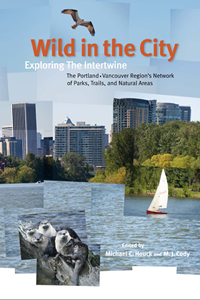 Wild in the City is an invaluable guide for an exploration of the parks and trails in the Portland metropolitan area, but it's quite readable even if you're stuck somewhere else. Scattered amongst the trail maps and descriptions of various sites and walks are essays about wildlife, history--both natural and human--and the complexities of disturbed ecosystems, with a good dose of philosophy on the value of having nature in an urban setting. Over one hundred writers and illustrators have contributed to this fine work.
Wild in the City is an invaluable guide for an exploration of the parks and trails in the Portland metropolitan area, but it's quite readable even if you're stuck somewhere else. Scattered amongst the trail maps and descriptions of various sites and walks are essays about wildlife, history--both natural and human--and the complexities of disturbed ecosystems, with a good dose of philosophy on the value of having nature in an urban setting. Over one hundred writers and illustrators have contributed to this fine work.
Excerpted from the Fall 2012 Arboretum Bulletin.
Link to this review (permalink)
Life Histories of Cascadia Butterflies by David G. James, 2011
Reviewed by: Brian Thompson on 2012-10-01
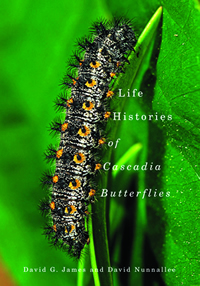 When first picking up the fascinating Life Histories of Cascadia Butterflies, I expected lots of lovely close-up photographs of our native butterflies. While I wasn't disappointed, the majority of the photos are of the early stages of their life histories, i.e., lots of caterpillars! The thoroughness for depicting each species is outstanding with typically five or more photos of the different larval stages. How did authors David James and David Nunnallee do it? By rearing the butterflies from eggs and photographing each stage of their development.
When first picking up the fascinating Life Histories of Cascadia Butterflies, I expected lots of lovely close-up photographs of our native butterflies. While I wasn't disappointed, the majority of the photos are of the early stages of their life histories, i.e., lots of caterpillars! The thoroughness for depicting each species is outstanding with typically five or more photos of the different larval stages. How did authors David James and David Nunnallee do it? By rearing the butterflies from eggs and photographing each stage of their development.
Robert Michael Pyle wrote the Foreword and he best describes the enormous scale of this work: "...this book is the apex of life history treatments to date. In the whole world, no other comparable region enjoys a work of this scale, ambit, and acuity for its butterfly fauna".
Excerpted from the Fall 2012 Arboretum Bulletin.
Link to this review (permalink)
The 50 Mile Bouquet by Debra Prinzing, 2012
Reviewed by: Brian Thompson on 2012-10-01
"When Debra and David began interviewing and photographing people who grow and arrange fresh, seasonal flowers for local markets, I knew they were documenting a new movement...you could call it the slow flower movement." This quote, by Amy Stewart from the Foreword of "The 50 Mile Bouquet," well summarizes this forward-looking book by Debra Prinzing and David Perry, which leaves you with a wider perspective and appreciation of fresh cut flowers and other greenery. This is in sharp contrast to the international florist industry, making Stewart's 2007 book about that industry, "Flower Confidential," a good companion reading (Stewart--who lives in Eureka, California--almost qualifies as a local author).
Excerpted from the Fall 2012 Arboretum Bulletin.
Link to this review (permalink)
Petal & Twig by Valerie Easton, 2012
Reviewed by: Brian Thompson on 2012-10-01
Valerie Easton's "Petal & Twig", tells how to find a source of material for flower arranging in your own garden. If--like me--you've ever struggled with getting your home arrangements just right, Easton will loosen you up and give you permission to just go for it, and open your eyes to more possibilities than you ever imagined a few feet from your back door. "After all, you're crafting performance art that changes hour by hour, day by day, as buds open, petals drop, and flowers droop. Imperfection engages us in the creative process."
Excerpted from the Fall 2012 Arboretum Bulletin.
Link to this review (permalink)
Landscaping for Privacy by Marty Wingate, 2011
Reviewed by: Brian Thompson on 2012-10-01
 "Landscaping for Privacy" by Marty Wingate is very practical and addresses annoying issues like siting the recycle bins, and how to embrace wildlife or pets without letting them run amok, while empowering you to create a space that is very distinctly your own. Relatively few gardening books address fences and hedges in any depth, but for Wingate "screening hedges become more than shrubs planted in a line; they create a green, living wall, incorporating the design elements of sequence and repetition to pull together the landscape."
"Landscaping for Privacy" by Marty Wingate is very practical and addresses annoying issues like siting the recycle bins, and how to embrace wildlife or pets without letting them run amok, while empowering you to create a space that is very distinctly your own. Relatively few gardening books address fences and hedges in any depth, but for Wingate "screening hedges become more than shrubs planted in a line; they create a green, living wall, incorporating the design elements of sequence and repetition to pull together the landscape."
Excerpted from the Fall 2012 Arboretum Bulletin.
Link to this review (permalink)
The Intimate Garden by Brian D. Coleman, 2008
Reviewed by: Brian Thompson on 2012-10-01
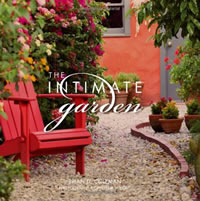 Consider "The Intimate Garden" for very detailed examples of highly individualized garden spaces, with an emphasis on hardscape and ornaments. While both author Brian Coleman and photographer William Wright are from Seattle and the gardens are mostly on the west coast, examples from the east coast and even England are included, making this a very diverse selection of design styles and plant material.
Consider "The Intimate Garden" for very detailed examples of highly individualized garden spaces, with an emphasis on hardscape and ornaments. While both author Brian Coleman and photographer William Wright are from Seattle and the gardens are mostly on the west coast, examples from the east coast and even England are included, making this a very diverse selection of design styles and plant material.
Excerpted from the Fall 2012 Arboretum Bulletin.
Link to this review (permalink)
Native Plant User Guide by Rugged Country Plants, 2010
Reviewed by: Brian Thompson on 2012-10-01
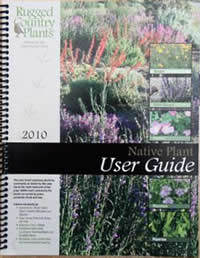 Gardeners east of the Cascades will be pleased to have this addition to the limited collection of garden books for their region. Native Plant User Guide is published by the nursery Rugged Country Plants in Milton-Freewater, Oregon and, while self-promoting, there is far more descriptive detail and cultural help than you'd expect from a nursery catalog. With careful reading, gardeners west of the Cascades will pick up useful ideas, too.
Gardeners east of the Cascades will be pleased to have this addition to the limited collection of garden books for their region. Native Plant User Guide is published by the nursery Rugged Country Plants in Milton-Freewater, Oregon and, while self-promoting, there is far more descriptive detail and cultural help than you'd expect from a nursery catalog. With careful reading, gardeners west of the Cascades will pick up useful ideas, too.
Excerpted from the Fall 2012 Arboretum Bulletin.
Link to this review (permalink)
Sunset Western Garden Book by Kathleen Norris Brenzel, 2012
Reviewed by: Brian Thompson on 2012-10-01
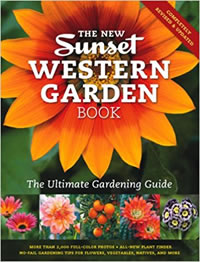 The grandparent of all gardening books for the Pacific Northwest and rest of the west remains the "Sunset Western Garden Book." Now in its new, ninth edition, the proven encyclopedic formula, along with essays, extensive plant selection lists for specific needs, and the much valued Sunset climate zones (all updated) continue to make this a must on any western gardener's shelf. The main addition since the last edition of 2007 is photographs in the encyclopedia--a nice update!
The grandparent of all gardening books for the Pacific Northwest and rest of the west remains the "Sunset Western Garden Book." Now in its new, ninth edition, the proven encyclopedic formula, along with essays, extensive plant selection lists for specific needs, and the much valued Sunset climate zones (all updated) continue to make this a must on any western gardener's shelf. The main addition since the last edition of 2007 is photographs in the encyclopedia--a nice update!
Excerpted from the Fall 2012 Arboretum Bulletin.
Link to this review (permalink)
Gnarly Branches, Ancient Trees by Will Hiltz, 2010
Reviewed by: Brian Thompson on 2012-10-01
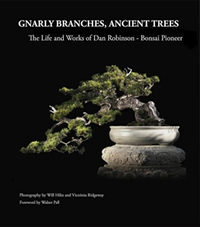 Gnarly Branches, Ancient Trees is a biography of Dan Robinson, a bonsai gardener noted for his naturalistic style. While one could learn much from the examples, this is not a how-to book, but rather a celebration of one man's enthusiasm and perseverance for his art. This led to his establishing Elandan Gardens near Bremerton. His story is well told by the photography and writing of several of his admirers in the local world of bonsai.
Gnarly Branches, Ancient Trees is a biography of Dan Robinson, a bonsai gardener noted for his naturalistic style. While one could learn much from the examples, this is not a how-to book, but rather a celebration of one man's enthusiasm and perseverance for his art. This led to his establishing Elandan Gardens near Bremerton. His story is well told by the photography and writing of several of his admirers in the local world of bonsai.
Excerpted from the Fall 2012 Arboretum Bulletin.
Link to this review (permalink)
What I've Learned from Bonsai by George Bingham, 2008
Reviewed by: Brian Thompson on 2012-10-01
 George Bingham is based in Olympia and had been engaged in bonsai for about nine years when "What I've Learned from Bonsai" was published in 2008. This very personal book shares his observation about both the art of bonsai and the life lessons he has gained while working with his plants and living with multiple sclerosis.
George Bingham is based in Olympia and had been engaged in bonsai for about nine years when "What I've Learned from Bonsai" was published in 2008. This very personal book shares his observation about both the art of bonsai and the life lessons he has gained while working with his plants and living with multiple sclerosis.
Excerpted from the Fall 2012 Arboretum Bulletin.
Link to this review (permalink)
Small Conifers for Small Gardens by Robert L. Fincham, 2011
Reviewed by: Brian Thompson on 2012-10-01
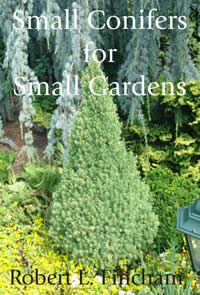 A local garden and nursery that's not well known is Coenosium Gardens in Eatonville. Owner Robert Fincham has traveled widely in his quest for dwarf conifers and the book Small Conifers for Small Gardens catalogs the many fine dwarf firs, spruce, pines, hemlocks, and assorted other species he has collected and grown. If you have considered adding conifers that won't outgrow your garden, this introduction to the merits of over two hundred choices, along with anecdotes about each, is a must read.
A local garden and nursery that's not well known is Coenosium Gardens in Eatonville. Owner Robert Fincham has traveled widely in his quest for dwarf conifers and the book Small Conifers for Small Gardens catalogs the many fine dwarf firs, spruce, pines, hemlocks, and assorted other species he has collected and grown. If you have considered adding conifers that won't outgrow your garden, this introduction to the merits of over two hundred choices, along with anecdotes about each, is a must read.
Excerpted from the Fall 2012 Arboretum Bulletin.
Link to this review (permalink)
Where Lilacs Still Bloom by Jane Kirkpatrick, 2012
Reviewed by: Brian Thompson on 2012-10-01
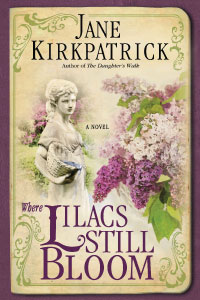 Hulda Klager (1863-1960) was a Pacific Northwest pioneer. This Woodland, Washington farm wife survived numerous hardships, but is best remembered for the wonderful collection of lilacs she hybridized and introduced in the first half of the 20th century, and the garden now open to the public that displays those lilacs. The historical novel "Where Lilacs Still Bloom" by Jane Kirkpatrick is largely an accurate biography, with only minor liberties taken to amalgamate some of the real life personalities in Klager's life.
Hulda Klager (1863-1960) was a Pacific Northwest pioneer. This Woodland, Washington farm wife survived numerous hardships, but is best remembered for the wonderful collection of lilacs she hybridized and introduced in the first half of the 20th century, and the garden now open to the public that displays those lilacs. The historical novel "Where Lilacs Still Bloom" by Jane Kirkpatrick is largely an accurate biography, with only minor liberties taken to amalgamate some of the real life personalities in Klager's life.
Excerpted from the Fall 2012 Arboretum Bulletin.
Link to this review (permalink)
Evergreen Muse: The Art of Elizabeth Colborne by David F. Martin, 2011
Reviewed by: Brian Thompson on 2012-10-01
 A strong woman from the early 20th century was Elizabeth Colborne (1885-1948), who grew up in Bellingham. She was an artist that worked in several media with various subjects, but is best remembered for her color woodcuts of northwest forest scenes, with detailed and accurate renditions of our native trees and other plants. Evergreen Muse by David Martin is a catalog of her works displayed in an exhibit at the Whatcom Museum in Bellingham during the summer of 2011.
A strong woman from the early 20th century was Elizabeth Colborne (1885-1948), who grew up in Bellingham. She was an artist that worked in several media with various subjects, but is best remembered for her color woodcuts of northwest forest scenes, with detailed and accurate renditions of our native trees and other plants. Evergreen Muse by David Martin is a catalog of her works displayed in an exhibit at the Whatcom Museum in Bellingham during the summer of 2011.
Excerpted from the Fall 2012 Arboretum Bulletin.
Link to this review (permalink)
Holden Village Historic Iris by Roxanne Grinstad, 2008
Reviewed by: Brian Thompson on 2008-10-01
 One of the most unique books in the Elisabeth C. Miller Library collections is "Holden Village Historic Iris," the accounting of the surviving garden iris from the village of a mining camp that operated near the upper end of Lake Chelan from 1937 - 1957. Now established at a nearby Lutheran ministry known as Holden Village, these irises are a living history. Grown by the wives of the miners, many survived untended for more than 40 years in abandoned gardens.
One of the most unique books in the Elisabeth C. Miller Library collections is "Holden Village Historic Iris," the accounting of the surviving garden iris from the village of a mining camp that operated near the upper end of Lake Chelan from 1937 - 1957. Now established at a nearby Lutheran ministry known as Holden Village, these irises are a living history. Grown by the wives of the miners, many survived untended for more than 40 years in abandoned gardens.
Newer varieties were added after the village was established in the early 1960's, but like the older varieties, the "real" names are mostly unknown. Instead, authors Roxanne Grinstad and Larry Howard (the latter a garden volunteer at the Center for Urban Horticulture) share the local names that reflect the flowers' place in the community, evocative of both the present day and the history of the area.
Excerpted from the Fall 2008 Arboretum Bulletin.
Link to this review (permalink)
Wild Plants of Greater Seattle by Arthur Lee Jacobson, 2008
Reviewed by: Brian Thompson on 2013-08-14
Arthur Lee Jacobson's "Wild Plants of Greater Seattle" was received with great excitement when published by the author in 2001. In the second edition, the author has added 15 new plants to the illustrated field guide, plus more than 100 to the annotated checklist, and corrected or updated much of the nomenclature throughout.
Link to this review (permalink)
Growing Vegetables West of the Cascades by Steve Solomon, 2007
Reviewed by: Brian Thompson on 2013-08-14
An important contributor to our Pacific Northwest literature has been Steve Solomon, now with his 6th edition of "Growing Vegetables West of the Cascades." Each edition reflects the author's on-going learning in his craft, the major change in this edition concerns the cultivation of asparagus. He now advocates growing these from seed, rather than starting with root crowns.
Link to this review (permalink)
Handbook of Northwest Gardening by Ann Lovejoy, 2007
Reviewed by: Brian Thompson on 2008-10-01
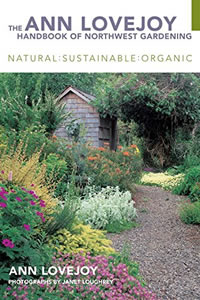 Ann Lovejoy has updated her popular 2004 "Handbook of Northwest Gardening," with a new appendix entitled "What's New in Sustainable Gardening." Here she discusses rain gardens (that capture as much of naturally occurring water as possible), dry gardens (plantings that survive and even thrive with no supplemental watering once established), and the importance of bees and their current peril -- and ways that gardeners can help their cause. All good additions.
Ann Lovejoy has updated her popular 2004 "Handbook of Northwest Gardening," with a new appendix entitled "What's New in Sustainable Gardening." Here she discusses rain gardens (that capture as much of naturally occurring water as possible), dry gardens (plantings that survive and even thrive with no supplemental watering once established), and the importance of bees and their current peril -- and ways that gardeners can help their cause. All good additions.
Excerpted from the Fall 2008 Arboretum Bulletin.
Link to this review (permalink)
Greenscapes: Olmsted's Pacific Northwest. by Joan Hockaday, 2009
Reviewed by: Brian Thompson on 2009-10-01
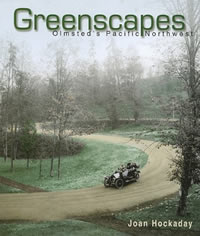 John Charles Olmsted made numerous visits to the Pacific Northwest from 1903-1911. This nephew of Frederick Law Olmsted was himself a highly regarded landscape architect and noted for his attention to fine detail. The chronicle of his many projects in the region is written with this same, careful attention to detail by Joan Hockaday in "Greenscapes: Olmsted's Pacific Northwest."
John Charles Olmsted made numerous visits to the Pacific Northwest from 1903-1911. This nephew of Frederick Law Olmsted was himself a highly regarded landscape architect and noted for his attention to fine detail. The chronicle of his many projects in the region is written with this same, careful attention to detail by Joan Hockaday in "Greenscapes: Olmsted's Pacific Northwest."
Olmsted was a prolific writer, both in his professional records and in his correspondence (5,000 private letters survive), especially his daily letters to his wife Sophia and their daughters at home in Brookline, Massachusetts. Hockaday uses this wealth of sources to create a book that works on several levels: as a history of a important time in the development of our region, as a biography of a skilled landscape architect working in the shadow of his more famous uncle, and as a glimpse of a by-gone era through garden design.
While his work took him from Vancouver Island to the University of Idaho and south to Corvallis, much the book's focus is on Seattle, where he spent some 300 days during those nine years. Hockaday convincingly argues that Olmsted is responsible for much of what now defines the city, especially with the park system, Lake Washington Boulevard, the University of Washington campus (including Rainier Vista), and many private residences.
Excerpted from the Fall 2009 Arboretum Bulletin.
Link to this review (permalink)
Trees for All Seasons: Broadleaved Evergreens for Temperate Climates by Sean Hogan, 2008
Reviewed by: Brian Thompson on 2009-10-01
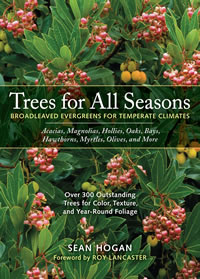 Portlander nurseryman Sean Hogan addresses a neglected part of the garden palette in "Trees for All Seasons: Broadleaved Evergreens for Temperate Climates". And he does it with great enthusiasm; being quite candid that one of his goals is increased planting of these excellent but underused plants.
Portlander nurseryman Sean Hogan addresses a neglected part of the garden palette in "Trees for All Seasons: Broadleaved Evergreens for Temperate Climates". And he does it with great enthusiasm; being quite candid that one of his goals is increased planting of these excellent but underused plants.
First, he defines his scope. Conifers, or monocots such as palms, are not included. He's also strict about evergreen, subjects must "...keep their leaves year-round, or nearly so, but also remain attractive while doing so." Icons with each entry give size and shape, and emphasize these are trees, not shrubs (he's saving those for his next book).
The typical A-Z encyclopedia -- with some bunching of closely related genera -- is written for horticulturists (not botanists!) in temperate zones, and gives considerable gradation to the cold-hardiness and other exacting, cultural needs. For example, I learned that a favorite tree of mine from trips to the southwest, the Texas mountain laurel (Sophora secundiflora) would "...experience imperceptibly slow growth, or even lose ground..." in my Seattle garden without heroic efforts to match its preferred "swamp-cooler" climate.
Always the nurseryman, Hogan gives detailed notes about propagation and the habits of young nursery stock, always written in an easy to understand manner. Need to propagate your olive? Historically this was done by "chopping the heavily burled bases into pieces, pulling chunks out of the ground, then dragging them to the next area where, eventually, an olive tree would grow." He goes on to say that with less effort similar results can be obtained from well-ripened cuttings with a high...ish level of hormone...along with a steep wound."
This book will certainly enhance your appreciation of the Arboretum's collection of broadleaved evergreens.
Excerpted from the Fall 2009 Arboretum Bulletin.
Link to this review (permalink)
Growing Your Own Vegetables: an Encyclopedia of Country Living Guide by Lorene Edwards Forkner, 2009
Reviewed by: Brian Thompson on 2009-10-01
Lorene Edwards Forkner tackled a huge task. She took the 900 plus pages of the late Carla Emery's "The Encyclopedia of Country Living" and distilled out of this sometimes wandering magnum opus (in 10 editions over 35 years) the essentials of vegetable gardening.
The resulting "Growing Your Own Vegetables" is a well organized and very readable work (at a comparatively slim 179 pages) that still captures the enthusiasm and down-to-earth charm of the original. While the authors both have Pacific Northwest roots, this book is written for a general audience, and so the section on okra is best skipped in planning your Seattle P-patch.
That said, there are still lots of useful and practical cultural tips. But I found it most charming in the somewhat quirky side boxes, such as that on Draft Horses and Power Tools: "Pat the animal and let it know you appreciate it after a good hard pull."
Excerpted from the Fall 2009 Arboretum Bulletin.
Link to this review (permalink)
The Weather of the Pacific Northwest by Cliff Mass, 2008
Reviewed by: Brian Thompson on 2009-10-01
 Briefly, gardeners should read "The Weather of the Pacific Northwest" by Cliff Mass, as the local weather is our constant companion. While this doesn't specifically address the concerns of gardeners, it will help you make sense of forecasts and appreciate the unpredictability of our weather.
Briefly, gardeners should read "The Weather of the Pacific Northwest" by Cliff Mass, as the local weather is our constant companion. While this doesn't specifically address the concerns of gardeners, it will help you make sense of forecasts and appreciate the unpredictability of our weather.
Excerpted from the Fall 2009 Arboretum Bulletin.
Link to this review (permalink)
Timber Press Guide to Gardening in the Pacific Northwest by Carol Hall, 2008
Reviewed by: Tracy Mehlin on 2009-01-01
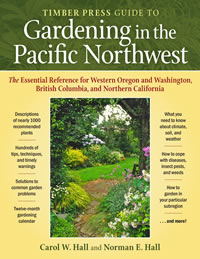 When authors Carol and Norman Hall started gardening in the Pacific Northwest in the 1970's they had to learn to grow their plants by trial and error, because most gardening books of the time addressed only East Coast weather conditions, such as summer rain and winter freezing.
When authors Carol and Norman Hall started gardening in the Pacific Northwest in the 1970's they had to learn to grow their plants by trial and error, because most gardening books of the time addressed only East Coast weather conditions, such as summer rain and winter freezing.
However, perhaps it's just as well the authors had to figure it out on their own because their depth of understanding how the Pacific Northwest climate affects plants is impressive. Although the question of where the boundaries of the Pacific Northwest lie is open to debate, the Halls define them as: the areas stretching between the ocean coast and the Cascade Range, and between latitude 51° in British Columbia and latitude 41° in northern California. The northern boundary was chosen because north of latitude 51° the "difference between high and low temperatures become smaller and light intensity starts to diminish even on clear days... gardening conditions beyond this point are not those of the Pacific Northwest, but those of coastal Alaska." The southern border seems a bit more arbitrary, especially on the coast, but the authors note: "It's only after negotiating the steep descent from [the Cascade Range] to the valley floor and seeing the palm trees lining the streets of Redding, California, that you know you've suddenly entered a whole new gardening world." The unifying climatic conditions that defines the region are wet, mild winters and dry summers.
This large format book with 351 pages and a liberal use of color photographs is divided into 4 sections: the region, 12 month maintenance calendar, recommended plants and common problem & solutions.
Detailed descriptions of climate, soils and horticultural conditions are given about the region's seven sub-regions, which include: the Georgia Basin/Puget Trough, the Olympic Rain Shadow, Puget Sound, Pacific Coast (northern section), Pacific Coast (southern section), the Cascade Slopes/Outflow Valleys and Willamette. The authors recommend their favorite plants that grow well in the Pacific Northwest according to plant types such as: ornamental trees, shrubs, bulbs, and others. Instructions on caring for the recommended plants always refer to specific Pacific Northwest climate considerations. For example, heaths and heathers need supplemental water during our typical regional summer droughts for the first two years, until they become established.
This is an excellent general gardening reference that focuses on the Pacific Northwest climate like no other.
Excerpted from the Winter 2009 Arboretum Bulletin.
Link to this review (permalink)
The Northwest Green Home Primer by Kathleen O'Brien, 2008
Reviewed by: Brian Thompson on 2009-10-01
 "The Northwest Green Home Primer" is a helpful book for planning your garden. While the emphasis is on the home, a chapter entitled "Site Choices" has good advice for the surrounding landscaping, especially how and where to plant trees, and briefly addresses other green practices such as rain gardens to maximize the use of runoff.
"The Northwest Green Home Primer" is a helpful book for planning your garden. While the emphasis is on the home, a chapter entitled "Site Choices" has good advice for the surrounding landscaping, especially how and where to plant trees, and briefly addresses other green practices such as rain gardens to maximize the use of runoff.
Excerpted from the Fall 2009 Arboretum Bulletin.
Link to this review (permalink)
The Garden at Night: Private Views of Public Eden by Linda Rutenberg, 2007
Reviewed by: Brian Thompson on 2009-10-01
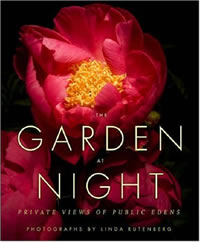 As a resident of Montreal, Linda Rutenberg does not qualify as a Pacific Northwest author, but the collection of her photographs in the 2007 publication "The Garden at Night: Private Views of Public Eden" includes PNW subjects. The Washington Park Arboretum and the Butchart Gardens are both featured, as are several other west coast gardens. The Italian Garden at Butchart is particularly enchanting at night, and one simply must experience Azalea Way -- after dark!
As a resident of Montreal, Linda Rutenberg does not qualify as a Pacific Northwest author, but the collection of her photographs in the 2007 publication "The Garden at Night: Private Views of Public Eden" includes PNW subjects. The Washington Park Arboretum and the Butchart Gardens are both featured, as are several other west coast gardens. The Italian Garden at Butchart is particularly enchanting at night, and one simply must experience Azalea Way -- after dark!
Excerpted from the Fall 2009 Arboretum Bulletin.
Link to this review (permalink)
Sunset Western Garden Book of Edibles by Sunset Publishing, 2010
Reviewed by: Brian Thompson on 2010-10-01
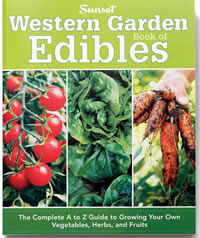 For an encyclopedic approach to vegetable gardening, consider the Sunset Western Garden Book of Edibles. Like most Sunset books, this encompasses the entire west in its scope, so ignore the entry on macadamia nuts, but with the fine tuning that the Sunset zones allow, you can zero in on what will grow for you, including fruits, nuts, berries, and herbs.
For an encyclopedic approach to vegetable gardening, consider the Sunset Western Garden Book of Edibles. Like most Sunset books, this encompasses the entire west in its scope, so ignore the entry on macadamia nuts, but with the fine tuning that the Sunset zones allow, you can zero in on what will grow for you, including fruits, nuts, berries, and herbs.
Excerpted from the Fall 2010 Arboretum Bulletin.
Link to this review (permalink)
Blue Heaven by Bill Terry, 2009
Reviewed by: Brian Thompson on 2010-10-01
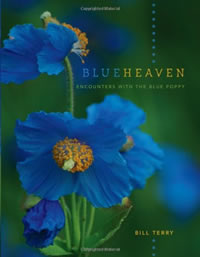 Bill Terry, from the Sunshine coast of British Columbia, has filled a small book ("Blue Heaven") with an ode of praise to Meconopsis grandis, the Himalayan Blue Poppy. His cultural advice will encourage the favored few living in a climate that will nurture this hard-to-please jewel (along with some more easily managed companions like candelabra primulas and other poppies), but anyone can enjoy this display of plant passion at its highest level.
Bill Terry, from the Sunshine coast of British Columbia, has filled a small book ("Blue Heaven") with an ode of praise to Meconopsis grandis, the Himalayan Blue Poppy. His cultural advice will encourage the favored few living in a climate that will nurture this hard-to-please jewel (along with some more easily managed companions like candelabra primulas and other poppies), but anyone can enjoy this display of plant passion at its highest level.
Excerpted from the Fall 2010 Arboretum Bulletin.
Link to this review (permalink)
Perennial Companions by Tom Fischer, 2009
Reviewed by: Brian Thompson on 2010-10-01
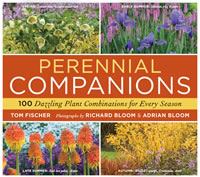 From Oregon, Timber Press editor-in-chief Tom Fischer has created his own book, "Perennial Companions," that demonstrates 100 design combinations using herbaceous perennials and ornamental grasses. I found it best to look at the right hand, full page photographs first (almost like a flip book), then stopping at my favorites to read the interpretive material on the matching left hand page.
From Oregon, Timber Press editor-in-chief Tom Fischer has created his own book, "Perennial Companions," that demonstrates 100 design combinations using herbaceous perennials and ornamental grasses. I found it best to look at the right hand, full page photographs first (almost like a flip book), then stopping at my favorites to read the interpretive material on the matching left hand page.
Excerpted from the Fall 2010 Arboretum Bulletin.
Link to this review (permalink)
The NEW Low-Maintenance Garden by Valerie Easton, 2009
Reviewed by: Brian Thompson on 2010-10-01
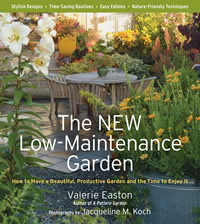 Enjoy it. These final two words of the sub-title to Valerie Easton's new book, "The NEW Low-Maintenance Garden" are the key to her message. Other low maintenance manuals treat the garden as a bothersome necessity to having a house; here the emphasis in on the joy of the garden, without it taking over your life.
Enjoy it. These final two words of the sub-title to Valerie Easton's new book, "The NEW Low-Maintenance Garden" are the key to her message. Other low maintenance manuals treat the garden as a bothersome necessity to having a house; here the emphasis in on the joy of the garden, without it taking over your life.
Organized by broad themes, including "Design with Maintenance in Mind" and "Nature's Rhythms", Easton augments her points with interviews of an impressive list of designers, gardeners, and home owners who have created a successful outdoor space. She completes each chapter with a list of books and other resources (once a librarian...) and throughout there are oodles of tips for simplification. Best of all, she gives the type A gardener permission to relax, and to find the pleasure of it all again.
Excerpted from the Fall 2010 Arboretum Bulletin.
Link to this review (permalink)
The Informed Gardener Blooms Again by Linda Chalker-Scott, 2010
Reviewed by: Brian Thompson on 2010-10-01
Linda Chalker-Scott debunks many gardening practices that don't work in "The Informed Gardener Blooms Again," a sequel to her excellent "The Informed Gardener" from 2008. The format is very similar to the first book, built around a series of short chapters with Sherlock Holmesian titles ("The Myth of the Magic Bullet", "The Myth of Nitrogen-nabbing Wood Chips") that analyze horticultural fads and home remedies from an applied, scientific perspective. After a thorough discussion of the research, a helpful summary ("The Bottom Line") follows, along with references to support her conclusions.
Chalker-Scott clearly has a passion for bringing science based, best practices to both home gardens and professional landscapes, as she has also edited and published "Sustainable Landscapes & Gardens: Good Science-Practical Application." Divided into five, separately bound units--all housed in a three-ring binder--this work has contributors from major universities throughout the Pacific Northwest.
The audience here could be either the home gardener or the professional who designs, installs, or maintains landscape plantings. The writing, while technical, is well-edited for readability for the non-academic reader and teaches not only better horticulture, but also about the research process that generates this advice. The format is designed for easily added updates and additions, so this is likely to be an important reference for our region for a long time.
Excerpted from the Fall 2010 Arboretum Bulletin.
Link to this review (permalink)
The Climate Conscious Gardener by Janet Marinelli, 2010
Reviewed by: Brian Thompson on 2010-10-01
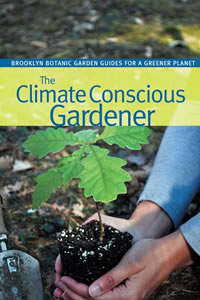 "The Climate Conscious Gardener" is the latest in the Brooklyn Botanic Garden Guides for a Greener Planet. While most of the contributing authors live in the Northeast, one of the five chapters, "Turning Your Landscape into a Carbon Sink," was written by Arboretum Foundation staff member Niall Dunne. To give an objective perspective, I'll quote from a review in HortIdeas (published by Greg and Pat Williams in Gravel Switch, Kentucky -- so no regional bias here): "Dunne's chapter alone is worth getting the book...with valuable information on numerous techniques for sequestering carbon in backyard gardens. Wouldn't it be great if amateurs throughout the U.S. could keep a really huge amount of carbon out of the atmosphere?"
"The Climate Conscious Gardener" is the latest in the Brooklyn Botanic Garden Guides for a Greener Planet. While most of the contributing authors live in the Northeast, one of the five chapters, "Turning Your Landscape into a Carbon Sink," was written by Arboretum Foundation staff member Niall Dunne. To give an objective perspective, I'll quote from a review in HortIdeas (published by Greg and Pat Williams in Gravel Switch, Kentucky -- so no regional bias here): "Dunne's chapter alone is worth getting the book...with valuable information on numerous techniques for sequestering carbon in backyard gardens. Wouldn't it be great if amateurs throughout the U.S. could keep a really huge amount of carbon out of the atmosphere?"
Excerpted from the Fall 2010 Arboretum Bulletin.
Link to this review (permalink)
Greening Cities, Growing Communities by Jeffrey Hou, 2009
Reviewed by: Brian Thompson on 2010-10-01
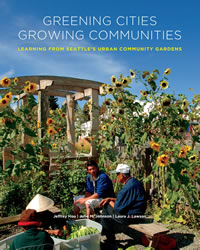 "Greening Cities, Growing Communities" is a case study of community gardens in Seattle. Written by landscape architects, this book is an excellent tool for supporters of community gardens in making their case in language understandable to urban planners and policy makers. For those of us already convinced, the breadth of activities at the profiled gardens will be surprising, and you could use this book as a unique travel guide to the Emerald City.
"Greening Cities, Growing Communities" is a case study of community gardens in Seattle. Written by landscape architects, this book is an excellent tool for supporters of community gardens in making their case in language understandable to urban planners and policy makers. For those of us already convinced, the breadth of activities at the profiled gardens will be surprising, and you could use this book as a unique travel guide to the Emerald City.
Excerpted from the Fall 2010 Arboretum Bulletin.
Link to this review (permalink)
Mushrooms of the Pacific Northwest by Steve Trudell, 2009
Reviewed by: Brian Thompson on 2010-10-01
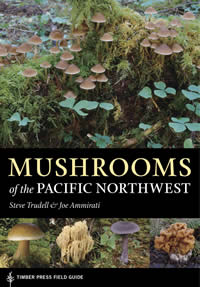 "Mushrooms of the Pacific Northwest" is another in the fine series of Timber Press Field Guide. Like earlier works on wildflowers and insects, it's well designed to be a good field companion with a coated cover, a ruler on the back, and frequently needed facts easily found on the inside covers.
"Mushrooms of the Pacific Northwest" is another in the fine series of Timber Press Field Guide. Like earlier works on wildflowers and insects, it's well designed to be a good field companion with a coated cover, a ruler on the back, and frequently needed facts easily found on the inside covers.
Particularly good is the long introduction which addresses subjects from the ecology of mushroom-fungi, the hazards of hunting in the Pacific Northwest, to "How to avoid becoming a poisoning statistic." Unlike many field guides, the text in the descriptive encyclopedia is in narrative form, rather than having set descriptive elements for each species. Not being a mushroom hunter, I can't vouch for the effectiveness at identification by this approach, but I found it enjoyable reading.
Excerpted from the Fall 2010 Arboretum Bulletin.
Link to this review (permalink)
The Collector by Jack Nisbet, 2009
Reviewed by: Brian Thompson on 2010-10-01
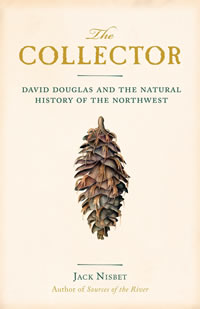 For a total change of pace, pick up Jack Nisbet's "The Collector." Although written in the third person, the story-telling is so good that it reads like a memoir by one of the most influential of the early plant explorers to our region. David Douglas was a keen observer of all things in the natural world, but especially the plant kingdom, and had a natural talent for the recording, collecting, and preserving what he found. And what energy! From 1823 until his tragic death in 1834, Scotsman Douglas was almost constantly exploring the new world, risking many hazards of travels and meeting many interesting people in both academic and frontier life.
For a total change of pace, pick up Jack Nisbet's "The Collector." Although written in the third person, the story-telling is so good that it reads like a memoir by one of the most influential of the early plant explorers to our region. David Douglas was a keen observer of all things in the natural world, but especially the plant kingdom, and had a natural talent for the recording, collecting, and preserving what he found. And what energy! From 1823 until his tragic death in 1834, Scotsman Douglas was almost constantly exploring the new world, risking many hazards of travels and meeting many interesting people in both academic and frontier life.
Excerpted from the Fall 2010 Arboretum Bulletin.
Link to this review (permalink)
Pacific Northwest Native Plant Habitat Garden Manual by Heidi Bohan, 2009
Reviewed by: Brian Thompson on 2010-10-01
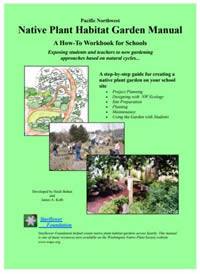 "Pacific Northwest Native Plant Habitat Garden Manual" is a short, loose-leaf bound notebook intended to give the basics for teachers and students establishing school gardens using natives.
"Pacific Northwest Native Plant Habitat Garden Manual" is a short, loose-leaf bound notebook intended to give the basics for teachers and students establishing school gardens using natives.
Excerpted from the Fall 2010 Arboretum Bulletin.
Link to this review (permalink)
Living With Bugs by Jack DeAngelis, 2009
Reviewed by: Brian Thompson on 2010-10-01
![[Living with Bugs] cover](https://depts.washington.edu/hortlib/graphix/livingwithbugs.jpg)
"Living With Bugs" concentrates on the critters that find their way into your house, but there are valuable tips on co-existing for gardeners, too.
Excerpted from the Fall 2010 Arboretum Bulletin.
Link to this review (permalink)
In My Nature: A Birder's Year at the Montlake Fill by Constance Sidles, 2009
Reviewed by: Brian Thompson on 2010-10-01
![[In My Nature] cover](https://depts.washington.edu/hortlib/graphix/inmynature.jpg)
"In My Nature: A Birder's Year at the Montlake Fill" describes the wonderful bird life of the area also known as the Union Bay Natural Area at the Center for Urban Horticulture.
Excerpted from the Fall 2010 Arboretum Bulletin.
Link to this review (permalink)
The Conscientious Gardener: Cultivating a Garden Ethic by Sarah Reichard, 2011
Reviewed by: Brian Thompson on 2011-10-01
Sarah Reichard, the late Director of the University of Washington Botanic Gardens, is also the author of an important book for gardeners: The Conscientious Gardener: Cultivating a Garden Ethic. In reviewing this book, I must make a full disclosure--Sarah is also my new boss and someone I've known and worked with for many years.
Reichard rightfully challenges gardeners to think outside of our individual gardens and see our role in the bigger system of both human endeavors and the natural world, and to see both the good and bad we can do. But she knows that being "good" isn't easy! And being a long-time teacher, she uses a skillful blend of storytelling, humor, and breaking things down to easy steps to make her message understood but not overwhelming.
For example, in her chapter "Aliens among Us", Reichard begins with the story of her concerns about introducing invasive plant species during a seed collecting trip early in her career. The scarcity of existing research led her to become a leader in the study of what makes plants invasive and the establishment and advocacy of guidelines for plant introductions in horticulture.
Recounting all this could be pretty heavy going, but she keeps it succinct and lightened with side boxes such as the role of the automobile ("Driving the Daisy") in seed dispersion. Then, she both encourages, "Gardeners, take action!", and tells how to do it, "Read on to plan your attack!" Like all chapters, this one ends with a set of Guidelines, very practical and doable steps each of us can take.
Excerpted from the Fall 2011 Arboretum Bulletin, by Brian Thompson.
Professor and UW Botanic Gardens director Sarah Reichard has her finger on the pulse of the planet in this erudite and accessible book. For those who have become complacent and fixed in their gardening ways, or for those just emerging as gardeners, there is much to learn in this handsome, information-rich volume. Are native plants always the preferred choice in our gardens? Do we really need soil amendments? Are we putting things on our lawns and landscapes that pollute nearby waters? What about those worms making compost in our worm bins: might they be invasive? Readers will discover that doing the right thing in our gardens is not only simpler than one might imagine, but deeply rewarding both personally and globally.
If you have been a persistent (but always polite!) thorn in the side of less conscientious (or simply unaware) gardeners and businesses who are purveyors of ivy and loosestrife, spreaders of weed-and-feed, and sprayers of pesticides, you will feel vindicated! If you have never spoken out before, you will feel inspired to do so! Reichard's clearheaded call to action is well worth heeding.
Reviewed by Plant Answer Line librarian Rebecca Alexander, April 2011.
Link to this review (permalink)
Field Guide to the Rare Plants of Washington by Pamela Camp, 2011
Reviewed by: Brian Thompson on 2011-10-01
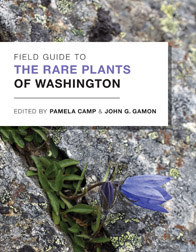 Most field botany guides help with identifying the most common trees, shrubs, and wildflowers. Field Guide to the Rare Plants of Washington takes a very different approach by choosing as its subjects over 300 of the rarest plants, ferns, and lichens in the state.
Most field botany guides help with identifying the most common trees, shrubs, and wildflowers. Field Guide to the Rare Plants of Washington takes a very different approach by choosing as its subjects over 300 of the rarest plants, ferns, and lichens in the state.
Why do this? Editors Pamela Camp and John G. Gamon, and the many contributors, anticipate that by helping both professional and amateur botanists in recognizing and identifying rare plants, this will promote conservation of these plants. The hope is also to engage more "...nature enthusiasts, opening a window into the beauty and diversity of Washington's rare flora."
That said, this book takes a solid base of botanical knowledge to appreciate. Selections are arranged alphabetically by genus within four broad plant types (lichens, ferns, dicots, and monocots). This means you must identify an unknown plant to the genus level before you can make use of the detailed plant and habitat descriptions to determine if you've found something rare. Most entries have line drawings and both close-up and site photographs, but these are for fine-tuning identification and not for the beginner.
Besides its value to the keen botanists, this book makes an important contribution to keeping pace with changes in taxonomy and nomenclature, and in linking different resources for this information. For example, each entry includes the name (if different) used in the standard reference Flora of the Pacific Northwest (Hitchcock and Cronquist, 1973). It also preserves in a book format much information that was only available in "...earlier loose-leaf and online treatments of many the species included..."
Excerpted from the Fall 2011 Arboretum Bulletin.
Link to this review (permalink)
Lakewold : a magnificent Northwest garden by Ronald Fields, 2011
Reviewed by: Brian Thompson on 2011-10-01
 Among my favorites of recent new books is Lakewold: A Magnificent Northwest Garden. It reminds me of a well-crafted exhibit catalog, beginning with detail from an oil painting of the garden on the cover.
Among my favorites of recent new books is Lakewold: A Magnificent Northwest Garden. It reminds me of a well-crafted exhibit catalog, beginning with detail from an oil painting of the garden on the cover.
Inside a rich history of photographs--dating from the early 20th century and drawing from most decades since then--tell the story of a dynamic garden. As a gardener, I appreciated seeing the old and the new, the changes and what stayed, and the large scale, formal plantings that gave way to simpler plans.
The style and quality of the book is not surprising as the editor is Ronald Fields, Emeritus Professor of Art History at the University of Puget Sound, who has been a docent for Lakewold since it opened to the public in 1989. The choice and layout of photographs is quite engaging, and includes unexpected hardscape details, many close-ups of signature plants, and the people who shaped the garden--primarily Eulalie Wagner and Thomas Church.
Several short essays provide their own history, including those written by local horticultural luminaries Valerie Easton, Dan Hinkley, and Steve Lorton, recounting visits to Lakewold early in their careers. Other sections highlight the vitality of the garden that continues today and its importance amongst the great estate gardens in the country.
If nothing else, this book will make you want to visit Lakewold. We are very fortunate to have this garden close-by, open to the public, and continuing the vision and spirit of those who developed and shaped it.
Excerpted from the Fall 2011 Arboretum Bulletin.
Link to this review (permalink)
To Look Closely: Science and Literacy in the Natural World by Laurie Rubin, 2013
Reviewed by: Dorothy Crandell on 2017-03-01
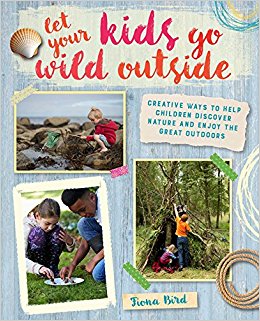
Teacher Laurie Rubin weekly features nature study in her elementary school classes in Ithaca, New York, in part based on an idea developed by Jon Young and instructors at the Wilderness Awareness School in Duvall, Washington. Rubin's child-centered program integrates critical thinking skills in science, mathematics, and language arts across the seasons of the year in the great outdoors.
In her program, once a week the students investigate a particular place, in whatever weather, in the natural environment near the school – a creek. Students discover that the creek experience is never the same twice. They have grown and developed, and the creek environment keeps changing over time. They keep journals of their observations, looking closely at plants, birds, insects, weather, and more. Stewardship of the natural world inspired at an early age is destined to last a lifetime.
Link to this review (permalink)
Field Guide to the Wild Flowers of the Algarve by Chris Thorogood, 2014
Reviewed by: Brian Thompson on 2015-03-01
"Field Guide to the Wild Flowers of the Algarve" introduces the rich Mediterranean flora of the southernmost province of Portugal. Several indigenous plants have become mainstays of western horticulture, including species of Cistus, Quercus, Euphorbia, and Narcissus. This is also a major tourist destination – a chance to combine fun in the sun with serious botanizing!
Published in the March 2015 Leaflet for Scholars Volume 2, Issue 3.
Link to this review (permalink)
Weeds of North America by Richard Dickinson, 2014
Reviewed by: Brian Thompson on 2015-05-01
"Weeds of North America" is an excellent new guide to more than 600 invasive plants throughout the United States and Canada. Designed in field guide style, the photographs are a particularly strong feature of this book, with 3-5 for each plant, including leaves, flowers, and seeds. The text includes a description of the life cycle, jurisdictions that have identified the plant as noxious, and details on the reasons for concern, including displacement of native plant habitat, toxicity to livestock, and/or status as an alternative host of a serious plant disease.
Published in the May 2015 Leaflet for Scholars Volume 2, Issue 5.
Link to this review (permalink)
The Plant Lover's Guide to Epimediums by Sally Gregson, 2015
Reviewed by: Brian Thompson on 2015-05-01
Kew Gardens has begun a very helpful series of books for gardeners known as The Plant Lover's Guides. One of the best, partly because of the scarcity of other books on this topic, is The Plant Lover's Guide to Epimediums by Sally Gregson. The availability of both species and hybrid epimediums has exploded in recent years, and this guide will introduce you to the new Chinese epimediums – "these are the divas" – as well as all the old favorites for dry shade. I'm especially impressed with the photographs as I know from experience the delicate flowers of this genus are very difficult to capture.
Published in the May 2015 Leaflet Volume 2, Issue 5.
Link to this review (permalink)
Field Guide to Sedges of the Pacific Northwest by Barbara L. Wilson, 2014
Reviewed by: Brian Thompson on 2015-06-01
"Field Guide to Sedges of the Pacific Northwest" is regarded by reviewers across the country as one of the best field guides on any topic, and is even better in the newly released 2nd edition. Included are entries for all 169 species, subspecies, and varieties that grow wild in Oregon and Washington, with typically 4-6 photographs or diagrams of each. An extensive key helps with identification, as do detailed tips with each entry, while comments discuss habitat, ethnobotanical uses, and the significance for restoration.
Published in the June 2015 Leaflet for Scholars Volume 2, Issue 6.
Link to this review (permalink)
Epic Tomatoes: How to Select & Grow the Best Varieties of All Time by Craig LeHoullier, 2015
Reviewed by: Brian Thompson on 2015-06-01
Can you grow "Epic Tomatoes" in the Pacific Northwest? A challenge, perhaps, but this new book by Craig LeHoullier will inspire you to try. Yes, he's from Raleigh, North Carolina, but he lived in Seattle early in his gardening career. He's most interested in heirlooms, suggests a rainbow of color options to try (a brown tomato anyone?), encourages you to grow from seed, and enlists the help of regional gardeners in finding the best varieties for our cool summers.
Published in the June 2015 Leaflet Volume 2, Issue 6.
Link to this review (permalink)
The Garden Classroom by Cathy James, 2015
Reviewed by: Laura Blumhagen on 2015-06-01
"Anything you can teach in an indoor classroom can be taught outdoors, often in ways that are more enjoyable for children." This bold assertion opens Cathy James' new book, and she proves her point with simple steps anyone who teaches children can take to enhance the curriculum outdoors. The projects are flexible, affordable and practical for small or large groups, aged 4 to 8. An invaluable resource for early education!
Published in the June 2015 Leaflet Volume 2, Issue 6.
Link to this review (permalink)
Field Guide to Grasses of California by James P. Smith, 2014
Reviewed by: Brian Thompson on 2015-07-01
"Field Guide to Grasses of California" is an excellent survey of the most common of the 603 taxa, both native and naturalized, in the state. James P. Smith is a professor emeritus of Humboldt State University and his teaching skills are evident throughout. While many species are not found in Washington (only 337 taxa), there is overlap especially with northern California. If you study grasses, this book is well worth reading for its methodology and for a confession (p. 123): "I do not want to discourage you, but you will not be able to identify every grass that you run through the key in this book…" The absolution that follows will lighten the heart of any student botanist.
Published in the July 2015 Leaflet for Scholars Volume 2, Issue 7.
Link to this review (permalink)
Field Guide to Manzanitas: California, North America, and Mexico by Michael Edward Kauffmann, 2015
Reviewed by: Brian Thompson on 2015-08-01
"Field Guide to Manzanitas" is a nearly comprehensive review of the genus Arctostaphylos, covering 104 of the 105 taxa in the world. Why is one missing? The excellent introduction to this book will answer that question and explore the origins and diversification that has led to one species (Arctostaphylos uva-ursi) being found throughout the northern hemisphere, while 60% of the remaining taxa are considered local endemics within the California Floristic Province. This book is a must for botanizing in California and helpful in making horticultural selections in the Pacific Northwest.
Published in the August 2015 Leaflet for Scholars Volume 2, Issue 8.
Link to this review (permalink)
RHS Plants from Pips: Pots of Plants for the Whole Family to Enjoy by Holly Farrell, 2015
Reviewed by: Laura Blumhagen on 2015-08-01
Working in the kitchen, have you ever wondered whether you could grow peppers from pepper seeds? How about a mango tree from a mango pit? This book for gardeners of all ages explains how to germinate a wide range of commonly-seen seeds most people would usually toss in the bin. The entries detail what each plant would need to grow on to maturity, while an illustrated section at the end highlights basic gardening techniques as well as common problems and solutions.
Published in the August 2015 Leaflet Volume 2, Issue 8.
Link to this review (permalink)
Lucy and the Green Man by Linda Newbery, 2010
Reviewed by: Laura Blumhagen on 2015-08-01

For middle readers, this illustrated chapter book follows Lucy, who loves working in her grandfather's garden over her school holidays. Together, Lucy and Grandpa Will see a magical Green Man called Lob in the garden. While Lucy is back at school, her grandfather dies suddenly, and Lucy decides to seek the Green Man on her own. Even though she can't get to Grandpa's garden, she works to create a space for Lob closer to home. Readers who garden, especially in the city, will reflect on the unique magic that comes of hard work close to home.
Published in the August 2015 Leaflet Volume 2, Issue 8.
Link to this review (permalink)
Reinventing the Chicken Coop by Kevin McElroy, 2012
Reviewed by: Jessica Anderson on 2015-11-01
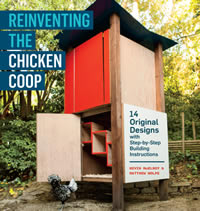 As a new graduate of the University of Washington's Library and Information Science Master's program, I began volunteering at the Miller Library in July 2011. I had some experience in academic libraries, and had worked as a student assistant in the UW's Natural Sciences Library. After I began volunteering, I started reading and checking out several books on fruit and vegetable gardening. The books were great, and really helped me learn how to grow food.
As a new graduate of the University of Washington's Library and Information Science Master's program, I began volunteering at the Miller Library in July 2011. I had some experience in academic libraries, and had worked as a student assistant in the UW's Natural Sciences Library. After I began volunteering, I started reading and checking out several books on fruit and vegetable gardening. The books were great, and really helped me learn how to grow food.
I decided to add chickens to my urban garden, making it a small urban farm. One of the best books that helped me prepare for my chickens was "Reinventing the Chicken Coop" by Kevin McElroy and Matthew Wolpe. The book contains 14 coop designs. It covers chicken coop essentials including space requirements, roosts, ventilation, and nesting boxes. This information was very helpful to me as I was learning what it would take to keep chickens in my yard. In the Coop-Building Basics chapter the authors explained, "One of our goals for this book was to keep things simple, using ordinary shop tools and building with similar materials and repeatable processes as much as possible" (p. 21). In the end, my husband and I built our coop using their design, SYM, which is "much more than a chicken coop; it's a symbiotic urban farming system" (p. 106). This was exactly what we needed. The step by step instructions were easy to follow and it didn't take too long to build this simple yet stable coop for our new flock. "Reinventing the Chicken Coop" is a great resource for building chicken houses with ease and low cost. Most pre-built coops cost twice as much as the materials used for building your own coop. I enjoyed the collection of contemporary designs and my chickens love their little home in my city backyard.
Now, I am a librarian at the Miller Library, with two years of experience in chicken husbandry and a growing knowledge of year-round vegetable and fruit gardening. I take pleasure in being knowledgeable on these subjects and plan to continue learning, expanding my understanding of urban farming.
Published in the November 2015 Leaflet Volume 2, Issue 11.
Link to this review (permalink)
Artful Rainwater Design by Stuart Echols, 2012
Reviewed by: Brian Thompson on 2016-03-01

Stuart Echols and Eliza Pennypacker are on the faculty of the Department of Landscape Architecture at Penn State University. They have combined their academic interests in stormwater management and sustainable landscapes to write "Artful Rainwater Design".
Much of the tone of the book is captured in this quotation about changing terminology: "Stormwater—a waste product and common enemy blamed for property damage through flooding and for surface water and aquatic system damage through pollutant conveyance—has morphed into rainwater, a valued natural resource beneficial to our water cycle." Techniques, design principles, dealing with public relations, and many case studies—including several in the Pacific Northwest—make this an important book for anyone involved with any aspect of water management in urban settings.
Published in the March 2016 Leaflet for Scholars Volume 3, Issue 3.
Link to this review (permalink)
The Art of Gardening: Design Inspiration and Innovative Planting Techniques From Chanticleer by William Thomas, 2015
Reviewed by: Brian Thompson on 2016-03-01
In June 2005, I attended a conference for plant science librarians in Philadelphia. After a long day of presentations, business meetings, and visits to libraries, I wasn't expecting much from a visit to small garden west of the city near Villanova University.
Instead, that evening at Chanticleer was one of the most magical garden experiences of my lifetime. The weather was perfect, cooled down from the already warm and humid beginning of summer. A glass of wine and a convivial group of colleagues added to the good feelings, but mostly it was the stunning garden rooms, plantings, and artwork of this most amazing garden.
Now there is an exciting new book, "The Art of Gardening", which takes its place among the best of all garden profiles. Written by R. William Thomas and the horticultural staff of Chanticleer, this not only transports the reader to the garden, it is also an excellent source of design ideas and plant choices for your own garden. I don't purchase many gardening books for my home library since I have daily access to the Miller Library collections, but this is one that I will get for sure.
Published in the March 2016 Leaflet Volume 3, Issue 3.
Link to this review (permalink)
Container Theme Gardens by Nancy J. Ondra, 2016
Reviewed by: Brian Thompson on 2016-05-01
It's time to plan and plant your summer container gardens. But what plants will you select? "Container Theme Gardens", a new book in the Miller Library, will help you choose, with 42 different designs that will meet almost every need: sun or shade, flowers or foliage, ornamentals in your favorite color or a mini-kitchen garden that will fit on your balcony, deck, or windowsill.
Salad greens and herbs are naturals for this treatment; more unusual are plants grown for their berries or for making tea. Other selections are designed to attract: hummingbirds, butterflies, even your kids. Best of all, this is only the newest book in our excellent collection on containers that will help you plant a garden no matter how limited your space or time!
Link to this review (permalink)
Nature Preschools and Forest Kindergartens by David Sobel, 2016
Reviewed by: Laura Blumhagen on 2016-05-04
Reading David Sobel's latest book feels like attending a national conference on outdoor early childhood education. Each chapter draws on the expertise and experience of key decision-makers working with young children in nature programs all over the country. The format also gives a sense of history and progress over time, with Sobel's journal entries from his work in outdoor education in the 1970s and his personal parenting journals from the 1990s presented alongside his contemporary research and observations from visits to today's outdoor preschools.
Sobel first distinguishes forest kindergartens from nature preschools, explaining how they differ in genesis, mission, philosophy, curriculum, and focus, and how both types of programs in North America differ from the European Waldkindergarten schools which arose in the late 1960s in Germany and have influenced similar programs in Scotland and other European countries.
A central theme is the developmental case for a style of outdoor education where instructors act as mentors and guides as children experiment, choose activities and learn to work together, not only solving their own problems but deciding for themselves what questions they will ask and what games and projects to invent on the spot. These experiences, he argues, lead young children to develop initiative, perseverance and creativity as well as a richer vocabulary, a love of nature, and social skills that will serve them (and their communities) well in later life. Sobel's reasoning is persuasive and the examples he gives are diverse and fascinating.
The chapter entitled "The Dollars and Sense of Business Planning and Budgeting," contributed by Ken Finch, covers factors to consider when starting or expanding such a school. This detailed information seems particularly useful in a field that is growing quickly and likely attracts idealistic people who aren't predisposed to draw up balance sheets and strategic plans. Whether a school is a non-profit organization or a for-profit business, it will be essential for founders to understand how to budget, how to attract staff, donors, families, and investors, and what rules and regulations affect such schools.
Sobel and his coauthors use stories, photos, and dialogue gathered from fledgling and more established nature preschools and forest kindergartens around the United States to highlight best practices in curriculum, focus, staffing, administration and funding. The book closes with a chapter by Erin K. Kenny, the cofounder and director of Cedarsong Forest Kindergarten on Vashon Island. Kenny details the events of a fall day there to illustrate some of the ways the school supports scientific inquiry, language learning, and emotional development for the children who attend. This book will intrigue anyone with an interest in outdoor education for young children.
Link to this review (permalink)
Steppes: The Plants and Ecology of the World's Semi-Arid Regions by Michael Bone, 2015
Reviewed by: Brian Thompson on 2016-07-01
The term "steppes" may conjure up images of Russia and the wide plains of central Asia, but "Steppes: The Plants and Ecology of the World's Semi-Arid Regions", a new book published by the Denver Botanic Gardens, brings this exotic image much closer to home.
According to the authors, the Intermountain North American Steppe includes much of eastern Washington and Oregon, and is one of five such regions in the world. In addition to the Central Asian Steppe, these other regions are in central North America, Patagonia in South America, and parts of South Africa.
This book has an even closer connection to home. One of the authors, Larry Vickerman, was a 1993 MS graduate of the Center for Urban Horticulture and the College of Forest Resources.
Published in the July 2016 Leaflet for Scholars Volume 3, Issue 7.
Link to this review (permalink)
Alien Plants by Clive A. Stace, 2015
Reviewed by: Brian Thompson on 2016-08-01
"Alien Plants" is a recent addition to the New Naturalist Library, an ongoing series about natural history in the British Isles. It is also a new addition to the Miller Library. While intended for a general reader, these books provide excellent overviews of the latest scholarly research, especially in the UK.
Why are these of interest to scholars in the Pacific Northwest? While the flora and fauna are mostly different, many of the practices of research, management, and instruction are relevant anywhere. These books are also fascinating for their difference of perspective.
For example, in "Alien Plants", invasives are divided into those known prior to 1500, and the "neophytes" that came later. Some of our natives have become their invasives, and I was surprised to learn that "English" laurel was introduced to the British Isles and escaped into the wild there about 250 years ago.
Published in the August 2016 Leaflet for Scholars Volume 3, Issue 8.
Link to this review (permalink)
Be in a Treehouse by Pete Nelson, 2014
Reviewed by: Brian Thompson on 2016-08-01
This spring I had the opportunity to visit the Cleveland Botanical Garden. Throughout this small garden are a number of treehouses, delighting the school children with whom I was sharing my visit. After climbing the steps up to one and looking out from this new perspective, I understood their enthusiasm. Later, in the Garden's gift shop, I explored their several books on treehouses. I was surprised to learn that the most prominent author, Pete Nelson, is from the Seattle area. I quickly had his latest book, "Be in a Treehouse" (2014), added to the Miller Library collection.
At its heart, this book is inspirational. Page after page of excellent photographs will bring out your inner child. The author's images of his own bed and breakfast of treehouses, located near Issaquah, may inspire your next vacation. If you decide to build your own, "Treehouse U" introduces the design and construction principles that one must consider for a structure typically located 10 to 20 feet off the ground and anchored to a living being.
While many of the examples are in the Pacific Northwest, Nelson also explores the world for outstanding and widely varying houses. Ranging from Austria to Zambia, this review demonstrates that almost any climate that has trees is perfect for elevated houses. In describing one favorite masterpiece, now sadly gone, the author declares it "…inspired many of us to reach for the highest branch and build our wildest dreams."
Published in the August 2016 Leaflet Volume 3, Issue 8.
Link to this review (permalink)
The Nature and Properties of Soils by Nyle C. Brady, 2017
Reviewed by: Brian Thompson on 2016-10-01
"If you are a student…you have chosen a truly auspicious time to take up the study of soil science." This encouragement is found in the preface of the new fifteenth edition and is explained by emphasizing the growing need across many fields for scientists and managers with this expertise.
This venerable publication – the first edition was in 1909 – can be read in depth, but at over 1,000 pages more likely will be used as a reference book for learning about a particular interest or to solve a specific problem. Throughout, it is very readable, and will be of value to those at almost all levels of soils knowledge. While this new edition is restricted to use in the Miller Library, the still authoritative fourteenth edition (from 2008) is available to check out.
Published in the October 2016 Leaflet for Scholars Volume 3, Issue 10.
Link to this review (permalink)
Vitamin N: the Essential Guide to a Nature-rich Life by Richard Louv, 2016
Reviewed by: Laura Blumhagen on 2016-10-01
New on our shelves this month you'll find Richard Louv's new book, Vitamin N: the essential guide to a nature-rich life. Joining his earlier work, Last child in the woods: saving our children from nature-deficit disorder, this thought-provoking yet hands-on manual introduces many simple ideas for getting outside and benefiting from everything nature has to offer, no matter one's age and ability.
While the book will be useful for parents of small children, it also covers what individual teens and adults can do to have a nature-rich life as well as how teachers and grandparents can support outdoor play and learning for the children in their lives. Check it out!
Published in the October 2016 Leaflet Volume 3, Issue 10.
Link to this review (permalink)
Food and the City: Histories of Culture and Cultivation by Dorothée Imbert, 2015
Reviewed by: Brian Thompson on 2016-11-01
The UW Farm is a great example of the increasing interest in urban agriculture, but this is not a new movement. Food and the City: Histories of Culture and Cultivation provides historical snapshots of food growing projects from around the world, concentrating on the late 19th century through the mid-20th century. Two global depressions and two world wars made this a particularly difficult time for city dwellers.
These essays were developed from lectures given at a "Food and the City" symposium held at the Dumbarton Oaks research institution in Washington, D.C. in May 2012 that "…sought to historically contextualize the current discourse on urban agriculture." I found the chapter written by Laura Lawson and Luke Drake of Rutgers University particularly engaging with its focus on American cities and because Lawson was a co-author of the 2009 book Greening Cities Growing Communities: Learning from Seattle's Urban Community Gardens.
Both books bring an academic perspective on this very human activity of gardening. However, neither is locked in a strictly scholarly discourse. At the end of Lawson and Drake's chapter in Food and the City, the authors conclude "In cities across America, food is being grown to feed families, to enliven communities, to provide economic opportunities, and to educate young and old…it is reassuring to realize that gardening for food is a normal part of the urban landscape..."
Published in the November 2016 Leaflet for Scholars Volume 3, Issue 11.
Link to this review (permalink)
Planting Design for Dry Gardens by Olivier Filippi, 2016
Reviewed by: Brian Thompson on 2016-11-01
Planting Design for Dry Gardens is an excellent book but unfortunately is poorly titled. Author Olivier Filippi lives in the south of France and the original French title, Alternatives au gazon, or "alternatives to lawn" more accurately describes his work, a very detailed and practical study of the options for replacing resource demanding turf grass.
A translation of a different type, from the parameters of Filippi's classic Mediterranean climate to our more modified version, will take some work on the reader's part. I found the effort worthwhile, as it exposed me as a gardener to ideas not typically found in a Pacific Northwest oriented garden book.
For example, Filippi does not recommend using a drip irrigation system for a dry garden of groundcover plants. Instead he advocates hand watering, using temporary basins created around the new plantings, so that plants will more likely to survive without supplemental watering once established. Many other general gardening topics, from planting to attract beneficial insects to concerns about invasive plants, are addressed from a refreshingly distinctive, continental European perspective.
Published in the November 2016 Leaflet Volume 3, Issue 11.
Link to this review (permalink)
Growing a Life: Teen Gardeners Harvest Food, Health, and Joy by Illène Pevec, 2016
Reviewed by: Laura Blumhagen on 2016-12-01
For anyone who would like to understand more about the empowering effect of programs like Seattle Youth Garden Works and the UW Farm, I highly recommend Illène Pevec's Growing a Life: Teen Gardeners Harvest Food, Health, and Joy. The author transcribes her face-to-face interviews with 90 youth gardeners participating in twelve different programs across the country. Her goal is to discover how growing food at their school, community center, or non-profit organization affects these teens' health as well as the attitudes, job prospects, and hopes for the future they share. The result is inspirational!
Published in the December 2016 Leaflet for Scholars Volume 3, Issue 12.
Link to this review (permalink)
When Green Becomes Tomatoes by Julie Fogliano, 2016
Reviewed by: Laura Blumhagen on 2016-12-01
Do you read poems with the children in your life? Whether they are already poetry lovers or you would like to raise their consciousness about poetry, Julie Fogliano's When Green Becomes Tomatoes is a gift with year-round appeal. Get ready for any weather as you enjoy the lyrical quality of these illustrated seasonal poems with outdoor themes, from harvesting tomatoes to admiring winter trees. One example: "february 3: with snowy arms sagging/the spruce seemed to know/that beautiful outweighs the snow."
Set against a backdrop of expansive illustrations by Julie Morstad, these spare poems evoke universal moments of wonder from childhood.
Link to this review (permalink)
The Secret World of Slugs and Snails by David George Gordon, 2010
Reviewed by: Brian Thompson on 2011-10-01
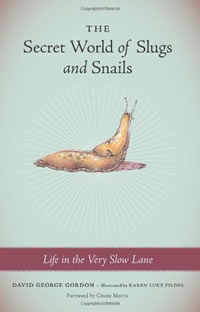 David George Gordon wrote a delightful booklet (48 pages) in 1994 titled Field Guide to the Slug. After chuckling over the concept, I found there was a lot of information packed in those few pages.
David George Gordon wrote a delightful booklet (48 pages) in 1994 titled Field Guide to the Slug. After chuckling over the concept, I found there was a lot of information packed in those few pages.
The Secret World of Slugs and Snails greatly expands the earlier work by not only including snails, but also the natural and cultural histories--yes, including cooking suggestions and even shell collecting--of these incredible creatures. For the even more adventurous, there is a short essay on keeping slugs as pets. For example, banana slugs have a good temperament for this (the author has a pair named Chiquita and Dole) but they will overheat in the typical household.
The final chapter is where most gardeners might begin: "Sharing Our Gardens: Coexisting with Slugs and Snails" but unlike in most gardening books, slugs and snails are not portrayed as an indisputable enemy. Yes, there are suggestions on how to both discourage and eliminate them, but the gardener is urged to have a heart and not apply salt as "...salting causes undue pain for the slug."
Excerpted from the Fall 2011 Arboretum Bulletin.
Link to this review (permalink)
The Gardener's Color Palette by Tom Fischer, 2010
Reviewed by: Brian Thompson on 2011-10-01
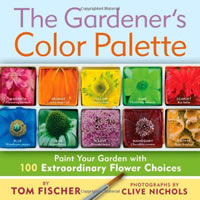 The Gardener's Color Palette at first glance is a pretty book, but I was prepared to dismiss it as having little information of consequence. However, like with most books, it is important to read the author's introduction. Tom Fischer's second sentence summarizes his intent: "Flowers are nature's most direct and accessible route to enjoying the pure pleasures of color."
The Gardener's Color Palette at first glance is a pretty book, but I was prepared to dismiss it as having little information of consequence. However, like with most books, it is important to read the author's introduction. Tom Fischer's second sentence summarizes his intent: "Flowers are nature's most direct and accessible route to enjoying the pure pleasures of color."
As an experienced gardener, I was already familiar with almost all of the one hundred flowers (mostly herbaceous perennials) profiled. I know their size, habits, foliage, texture, and even fragrance, or lack of one. And color, of course. Or so I thought. Fischer, and the superb photographs of Clive Nichols, invites you to isolate color from all other qualities.
This is best done on the beginning page of each of the ten color groups, with thumbnail style, tight close-ups of the full view examples that follow. Here, the shape of the flower is gone; all that is left is the color. It's quite a change in perspective.
The text gives a brief but insightful and often witty description of each plant, but the most valuable advice is for suggested companions, complimentary color ranges, or little gems like this entry on joe-pye weeds: "Their pinks and purples have a slightly dusty quality, which isn't necessarily a drawback; in fact, a hot fuchsia joe-pye weed would be terrifying--what on earth would you do with it?"
Excerpted from the Fall 2011 Arboretum Bulletin.
Link to this review (permalink)
Thru the lens: 50 years of the Japanese Garden by Penny Kimmel, 2010
Reviewed by: Brian Thompson on 2011-10-01
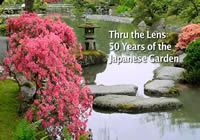 Thru the lens: 50 years of the Japanese Garden is a nearly hour-long documentary on DVD that explores both the history and current activities in the garden. Several docents, gardeners, and supporters are interviewed. I found the in-depth presentation of the tea ceremony particularly interesting. This documentary has a limited availability, but can be viewed with headsets at the Miller Library.
Thru the lens: 50 years of the Japanese Garden is a nearly hour-long documentary on DVD that explores both the history and current activities in the garden. Several docents, gardeners, and supporters are interviewed. I found the in-depth presentation of the tea ceremony particularly interesting. This documentary has a limited availability, but can be viewed with headsets at the Miller Library.
Excerpted from the Fall 2011 Arboretum Bulletin.
Link to this review (permalink)
A stroll through the first 50 years of the Seattle Japanese Garden by Shizue Prochaska , 2010
Reviewed by: Brian Thompson on 2011-10-01
A stroll through the first 50 years of the Seattle Japanese Garden is a PowerPoint presentation with slides and narration, focused on the founding of the garden--with many historical photographs--and significant changes up to the present. This documentary on CD has a limited availability, but can be viewed with headsets at the Miller Library.
Excerpted from the Fall 2011 Arboretum Bulletin.
Link to this review (permalink)
Cottonwood and the River of Time by Reinhard F. Stettler, 2009
Reviewed by: Brian Thompson on 2011-10-01
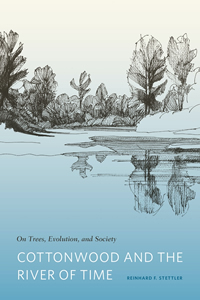 Cottonwood and the River of Time by Reinhard Stettler explores an unlikely topic, cottonwood trees and their kin including poplars and aspens. A retired University of Washington professor of forestry, the author writes an engaging natural history beginning with a single tree, an old matriarch near the Snoqualmie River. While eventually global in scope, many of the examples continue to be set in the Pacific Northwest.
Cottonwood and the River of Time by Reinhard Stettler explores an unlikely topic, cottonwood trees and their kin including poplars and aspens. A retired University of Washington professor of forestry, the author writes an engaging natural history beginning with a single tree, an old matriarch near the Snoqualmie River. While eventually global in scope, many of the examples continue to be set in the Pacific Northwest.
While many of the titles from the middle chapters may look a bit dull, e.g., "Natural Hybridization" and "Adaptation and Its Limits", the writing is quite engaging and aimed at a general audience. The book concludes with cultural history of poplars--the importance of poplars in agriculture, forestry, and landscapes.
Excerpted from the Fall 2011 Arboretum Bulletin.
Link to this review (permalink)
The Naming of Names by Anna Pavord, 2005
Reviewed by: Brian Thompson on 2012-04-01
 Anna Pavord's The Naming of Names sets the groundwork for the system of nomenclature we use so freely today. More than just names, this book chronicles the development of human understanding of plants, how they live and propagate, but most importantly how we've come to identify and categorized them.
Anna Pavord's The Naming of Names sets the groundwork for the system of nomenclature we use so freely today. More than just names, this book chronicles the development of human understanding of plants, how they live and propagate, but most importantly how we've come to identify and categorized them.
While beginning in the classical period, the core of this story is set in the revival of science during the Renaissance, from about 1400 - 1700. Pavord treats her human subjects as protagonists in a story of the development of the science of botany, and while supported with excellent scholarship, the writing is also very passionate.
The last hero of her narrative is the English scholar and plantsman John Ray (1627-1705), who she credits with the invention of the discipline of taxonomy. "No fireworks, no claps of thunder, no swelling symphonic themes mark Ray's achievement. It is a quiet, lonely, dogged consummation, and, in its insistence on the importance of method before system, critical in shaping future thinking on the subject to which he had devoted the whole of his adult life."
Excerpted from the Spring 2012 Arboretum Bulletin.
Link to this review (permalink)
The Brother Gardeners by Andrea Wulf, 2009
Reviewed by: Brian Thompson on 2012-04-01
 Andrea Wulf, in The Brother Gardeners, starts at the beginning of the 18th century. Up to that time gardening was "traditionally the preserve of the aristocracy...now, amateur gardeners began to take an obsessive interest in their smaller plots." Her focus is on the transformation in England, but much of this was fueled by the interchange with American gardeners and particularly the importing of American plants to English gardens.
Andrea Wulf, in The Brother Gardeners, starts at the beginning of the 18th century. Up to that time gardening was "traditionally the preserve of the aristocracy...now, amateur gardeners began to take an obsessive interest in their smaller plots." Her focus is on the transformation in England, but much of this was fueled by the interchange with American gardeners and particularly the importing of American plants to English gardens.
Most compelling is the four decades of correspondence between Peter Collinson (1694-1768), a merchant and avid gardener in London, and John Bartram (1699-1777), a farmer and self-taught botanist near Philadelphia. Bartram regularly shipped boxes of seeds, pressed plants, and occasionally live plants, while in exchange Collinson would ship books and tools, and even clothes for Bartram's family.
Collinson would use his connections to introduce Bartram wealthy and learned Americans, hoping to find new and different plants. These introductions came with specific instructions, "'Pray go very Clean, neat & handsomely Dressed to Virginia' and don't 'Disgrace thyself or Mee.'" As time passed, however, the roles changed as the farmer from the colonies began to assert his importance in these exchanges, forcing Collinson and his clients from the English learned class to recognize Bartram's knowledge, skills, and importance to their endeavors.
Excerpted from the Spring 2012 Arboretum Bulletin.
Link to this review (permalink)
Rhododendrons in the Landscape by Sonja Nelson, 2000
Reviewed by: Brian Thompson on 2007-04-01
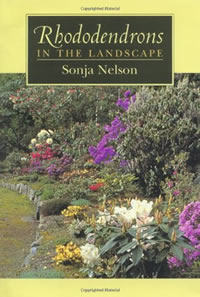 "The rhododendron landscapes in our modern gardens were first inspired by the sight of rhododendrons growing in the wild." So begins Mt. Vernon, Washington author Sonja Nelson in "Rhododendrons in the Landscape, " a book that brings both historical perspective and practical design to using these iconic plants in Pacific Northwest gardens.
"The rhododendron landscapes in our modern gardens were first inspired by the sight of rhododendrons growing in the wild." So begins Mt. Vernon, Washington author Sonja Nelson in "Rhododendrons in the Landscape, " a book that brings both historical perspective and practical design to using these iconic plants in Pacific Northwest gardens.
Excerpted from the Spring 2007 Arboretum Bulletin.
Link to this review (permalink)
The Neighborhood Forager by Robert K. Henderson, 2000
Reviewed by: Brian Thompson on 2007-04-01
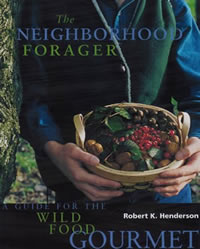 Robert Henderson dedicates "Neighborhood Forager" to Euell Gibbons, "...who invented the genre that sustains me, literally and figuratively." This handbook for living from nature is based on the author's considerable experience harvesting and using the native and naturalized plants near his home in Rosedale, British Columbia.
Robert Henderson dedicates "Neighborhood Forager" to Euell Gibbons, "...who invented the genre that sustains me, literally and figuratively." This handbook for living from nature is based on the author's considerable experience harvesting and using the native and naturalized plants near his home in Rosedale, British Columbia.
Excerpted from the Sprng 2007 Arboretum Bulletin.
Link to this review (permalink)
Plant This! by Ketzel Levine, 2000
Reviewed by: Brian Thompson on 2007-04-01
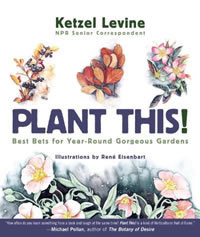 "Fall is tough on the vocabulary of a garden writer. I don't think I have another riotous, spectacular, or gorgeous left..." But Ketzel Levine does find her unique voice in "Plant This!," an often whacky but insightful review of favorites from her Portland garden.
"Fall is tough on the vocabulary of a garden writer. I don't think I have another riotous, spectacular, or gorgeous left..." But Ketzel Levine does find her unique voice in "Plant This!," an often whacky but insightful review of favorites from her Portland garden.
Excerpted from the Spring 2007 Arboretum Bulletin.
Link to this review (permalink)
Wetland Plants of Oregon & Washington by B. Jennifer Guard, 1995
Reviewed by: Brian Thompson on 2007-04-01
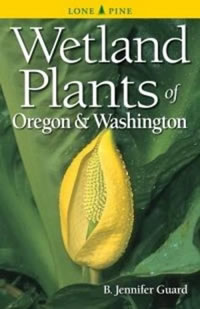 "Wetland Plants of Oregon & Washington" is a smart little guide perfect for taking into the field with its water resistant cover and handy size. Author B. Jennifer Guard's use of photographs, line drawings, plant and habitat descriptions, keys, and notes makes this a most effective book for plant identification.
"Wetland Plants of Oregon & Washington" is a smart little guide perfect for taking into the field with its water resistant cover and handy size. Author B. Jennifer Guard's use of photographs, line drawings, plant and habitat descriptions, keys, and notes makes this a most effective book for plant identification.
Excerpted from the Spring 2007 Arboretum Bulletin.
Link to this review (permalink)
Wild Lilies, Irises, and Grasses: Gardening with California Monocots by Nora Harlow, 2003
Reviewed by: Brian Thompson on 2007-04-01
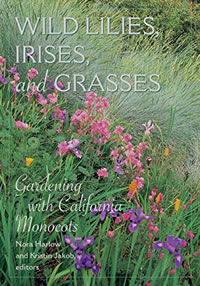 A who's who of experts collaborated on "Wild Lilies, Irises, and Grasses: Gardening with California Monocots." You ask, is nothing safe from invading Californians? Perhaps not, but many of these showy plants already have Pacific Northwest residency. Our collection includes this title and others from the Golden State with relevancy for our part of the coast.
A who's who of experts collaborated on "Wild Lilies, Irises, and Grasses: Gardening with California Monocots." You ask, is nothing safe from invading Californians? Perhaps not, but many of these showy plants already have Pacific Northwest residency. Our collection includes this title and others from the Golden State with relevancy for our part of the coast.
Excerpted from the Spring 2007 Arboretum Bulletin.
Link to this review (permalink)
This Rambling Affair: A Year in a Country Garden by Des Kennedy, 1998
Reviewed by: Brian Thompson on 2007-04-01
 Des Kennedy shares from the heart in "This Rambling Affair: A Year in a Country Garden," set on Denman Island in British Columbia. He knows his audience. "Gardeners are like people who endlessly take self-help courses and seminars to try make things better. We are chronic improvers, not necessarily of ourselves, but certainly of our landscapes..."
Des Kennedy shares from the heart in "This Rambling Affair: A Year in a Country Garden," set on Denman Island in British Columbia. He knows his audience. "Gardeners are like people who endlessly take self-help courses and seminars to try make things better. We are chronic improvers, not necessarily of ourselves, but certainly of our landscapes..."
Excerpted from the Spring 2007 Arboretum Bulletin.
Link to this review (permalink)
Going Native: Making Use of New Zealand Plants by Ian Spellerberg, 2004
Reviewed by: Brian Thompson on 2007-04-01
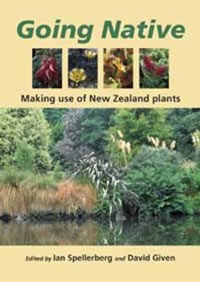 "Going Native: Making Use of New Zealand Plants" combines the expertise of several kiwi botanists, ecologists and horticulturists. Aimed at a New Zealand audience, it is still well worth a read by Cascadia gardeners, especially the more daring.
"Going Native: Making Use of New Zealand Plants" combines the expertise of several kiwi botanists, ecologists and horticulturists. Aimed at a New Zealand audience, it is still well worth a read by Cascadia gardeners, especially the more daring.
Excerpted from the Spring 2007 Arboretum Bulletin.
Link to this review (permalink)
Japanese-Style Gardens of the Pacific West Coast by Kendall H. Brown, 1999
Reviewed by: Brian Thompson on 2007-04-01
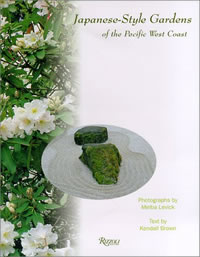 "From the first the Japanese garden -- whether in Kyoto or Kansas City -- has stood as a tangible antithesis to Western values." Working from that premise, Kendall H. Brown profiles "Japanese-Style Gardens of the Pacific West Coast" , including our own. The 20 gardens -- all open to the public -- are enticingly presented by Melba Levick's photographs.
"From the first the Japanese garden -- whether in Kyoto or Kansas City -- has stood as a tangible antithesis to Western values." Working from that premise, Kendall H. Brown profiles "Japanese-Style Gardens of the Pacific West Coast" , including our own. The 20 gardens -- all open to the public -- are enticingly presented by Melba Levick's photographs.
Excerpted from the Spring 2007 Arboretum Bulletin.
Link to this review (permalink)
The Garden Art of China by Lifang Chen, 1986
Reviewed by: Brian Thompson on 2007-04-01
 For an immersion course in Chinese gardens, look to native landscape architect and historian Chen Lifang and "The Garden Art of China." Expertly translated by botanist Yu Sianglin, this is one of the richest introductions -- filled with plans, sketches, design principles, and many, many examples -- to any art form imaginable.
For an immersion course in Chinese gardens, look to native landscape architect and historian Chen Lifang and "The Garden Art of China." Expertly translated by botanist Yu Sianglin, this is one of the richest introductions -- filled with plans, sketches, design principles, and many, many examples -- to any art form imaginable.
Excerpted from the Spring 2007 Arboretum Bulletin.
Link to this review (permalink)
Garden Design Illustrated by John A. Grant, 1954
Reviewed by: Brian Thompson on 2007-04-01
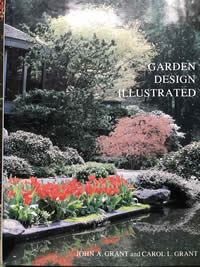 John A. and Carol L. Grant's "Garden Design Illustrated" is a historical gem. This husband and wife team is better known for "Trees and Shrubs for Pacific Northwest Gardens", first published in 1948 with help from the Arboretum Foundation. But their 1954 design book is perhaps more relevant today, teaching time-honored basics that haven't become outdated.
John A. and Carol L. Grant's "Garden Design Illustrated" is a historical gem. This husband and wife team is better known for "Trees and Shrubs for Pacific Northwest Gardens", first published in 1948 with help from the Arboretum Foundation. But their 1954 design book is perhaps more relevant today, teaching time-honored basics that haven't become outdated.
Excerpted from the Spring 2007 Arboretum Bulletin.
Link to this review (permalink)
Perennials : the gardener's reference by Susan Carter, 2007
Reviewed by: Brian Thompson on 2007-10-01
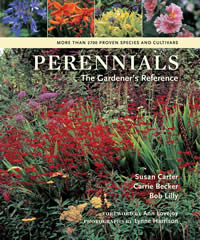 Drawing on over two hundred years of local experience, authors Susan Carter, Carrie Becker and Bob Lilly are best known for the magnificent Borders at the Bellevue Botanical Garden. This encyclopedia organizes that collective plant knowledge from A-Z in a well-structured format. But what makes this especially valuable are the signed introductions to each genus (including guests authors) and the notes and comments throughout -- all learned directly in the field. Of course it's a perfect fit for gardeners of the maritime Northwest, but the on-the-job commentaries make this book useful to gardeners in almost any temperate climate.
Drawing on over two hundred years of local experience, authors Susan Carter, Carrie Becker and Bob Lilly are best known for the magnificent Borders at the Bellevue Botanical Garden. This encyclopedia organizes that collective plant knowledge from A-Z in a well-structured format. But what makes this especially valuable are the signed introductions to each genus (including guests authors) and the notes and comments throughout -- all learned directly in the field. Of course it's a perfect fit for gardeners of the maritime Northwest, but the on-the-job commentaries make this book useful to gardeners in almost any temperate climate.
Excerpted from the Fall 2007 Arboretum Bulletin.
Link to this review (permalink)
Sunset Western Garden Book by Kathleen Norris Brenzel, 2007
Reviewed by: Brian Thompson on 2007-10-01
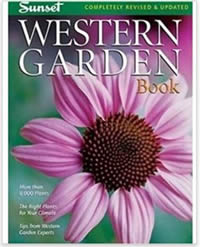 Every new edition of the most venerable of west coast gardening publications is a treat, bigger and better than before. Since the last in 2001, there are 500 new entries, a cleaner layout, highlights by subject experts and updated climate zones (although western Washington looks unchanged). "Post cards" from each state -- short essays, Washington's is written by Ciscoe Morris -- warm up the introduction and give some personal perspective on the zone maps that follow.
Every new edition of the most venerable of west coast gardening publications is a treat, bigger and better than before. Since the last in 2001, there are 500 new entries, a cleaner layout, highlights by subject experts and updated climate zones (although western Washington looks unchanged). "Post cards" from each state -- short essays, Washington's is written by Ciscoe Morris -- warm up the introduction and give some personal perspective on the zone maps that follow.
Excerpted from the Fall 2007 Arboretum Bulletin.
Link to this review (permalink)
The Story of the Apple by David J. Mabberley, 2006
Reviewed by: Brian Thompson on 2007-10-01
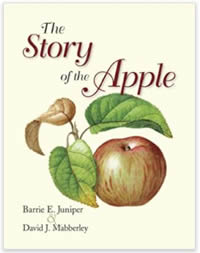 The origin of this commonplace fruit has long been uncertain, but David Mabberley and co-author Barrie Juniper find answers in this fascinating story. The authors use the expected DNA analysis and other traditional botanical tools of discovery, but also geology, climatology and a study of bears and horses to identify the first home (it wasn't Eden) of the sweet apple. But they don't stop there. They trace the process by which the apple has become a world-wide food crop, an iconic element in the culture of many peoples, and even a "determined, effective, subversive influence" that challenges the global agribusiness complex by its ability to easily new varieties, giving hope that even a small scale orchard or wild seedling could produce the next, outstanding variety.
The origin of this commonplace fruit has long been uncertain, but David Mabberley and co-author Barrie Juniper find answers in this fascinating story. The authors use the expected DNA analysis and other traditional botanical tools of discovery, but also geology, climatology and a study of bears and horses to identify the first home (it wasn't Eden) of the sweet apple. But they don't stop there. They trace the process by which the apple has become a world-wide food crop, an iconic element in the culture of many peoples, and even a "determined, effective, subversive influence" that challenges the global agribusiness complex by its ability to easily new varieties, giving hope that even a small scale orchard or wild seedling could produce the next, outstanding variety.
Excerpted from the Fall 2007 Arboretum Bulletin.
Link to this review (permalink)
A Botanist's Vocabulary by Susan Pell, 2016
Reviewed by: Rebecca Alexander on 2016-11-18
In my work as a horticulture reference librarian, I am often presented with a scrap of leaf or flower or twig, and asked to identify it. Although I have a pretty good visual memory for plants and their names, I have no formal training in botany. A Botanist's Vocabulary by Susan Pell and Bobbi Angell (Timber Press, 2016) is a useful tool not just for botanists but for all who work with plants—home gardeners and professionals alike. The book is arranged in straight alphabetical dictionary order, which makes it easy to look up a term you may have come across in the course of learning about a plant. It complements a book like The Cambridge Illustrated Glossary of Botanical Terms (Michael Hickey and Clive King, 2000), which is organized by the parts of a plant—the roots, seeds, flowers, leaves, fruits, and so forth. The pen and ink illustrations by Bobbi Angell are very clear, and red arrows or markings indicate the part of the plant referred to by a term, when such clarification is needed. The definitions are also concise, and include synonyms or in some cases antonyms, as relevant. I found familiar as well as unfamiliar terms, and as a word-nerd this is the kind of reference book that is a great joy to browse. The only desired feature the book lacks is consistent identification of the plant or plant family shown in each illustration. Some are named, but many are not. It would be helpful, once one has looked up the word, to have at least one example of which genus or family exhibits the characteristic being described and defined.
Link to this review (permalink)
The Wild Places by Robert Macfarlane, 2007
Reviewed by: Rebecca Alexander on 2008-12-04
 Though I will probably never survey my surroundings from the top of a tall beech tree, or climb a frozen waterfall in the dark, I thoroughly enjoyed discovering unspoiled natural areas of Britain through Robert Macfarlane's book The Wild Places (Granta Books, 2007).
Though I will probably never survey my surroundings from the top of a tall beech tree, or climb a frozen waterfall in the dark, I thoroughly enjoyed discovering unspoiled natural areas of Britain through Robert Macfarlane's book The Wild Places (Granta Books, 2007).
In richly descriptive prose, he leads the reader to these increasingly rare spots on the map, from saltmarshes and moors to hedgerows and holloways (tunnels of vegetation). Under the tutelage of his friend Roger Deakin (author of Wildwood, who died in 2007), Macfarlane's conception of wildness evolves over the course of his travels to include the humbler, smaller wild places that are within reach of even the most city-bound nature lovers:
"I thought about how the vision of wildness with which I had begun my journeys - inhuman, northern, remote - was starting to crumble from contact with the ground itself... The human and the wild cannot be partitioned. Everywhere that day I had encountered blendings and mixings."
Link to this review (permalink)
How to Grow a School Garden by Arden Bucklin-Sporer, 2010
Reviewed by: Laura Blumhagen on 2010-06-05
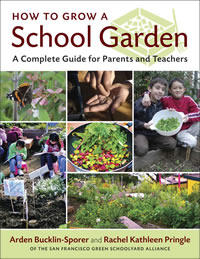 The authors, who are members of the San Francisco Green Schoolyard Alliance, recognize a fact that is becoming clear in schools across the country: if we are to have school gardens in this era of tightening budgets, increased academic testing and expanding class sizes, parents must step up and offer their time and energy to establish and maintain them. My own personal experience with this process as a volunteer in the garden at my neighborhood elementary school indicates that while a few parents at each school might have the necessary time and energy to devote to this, it is rare to find anyone at all with the practical knowledge, patience and understanding that are necessary to make such a garden flourish. That's why this book is so important and useful. Not only does it empower parents and teachers to get something growing, it educates them about the planning, funding, building, maintenance, use, and enjoyment of such a garden. Valuable topics include dealing with vandalism, training students in basic garden tasks, preparing for garden lessons, scheduling class activities in the garden, and planning for summer watering. This book is a must-have for any gardening library.
The authors, who are members of the San Francisco Green Schoolyard Alliance, recognize a fact that is becoming clear in schools across the country: if we are to have school gardens in this era of tightening budgets, increased academic testing and expanding class sizes, parents must step up and offer their time and energy to establish and maintain them. My own personal experience with this process as a volunteer in the garden at my neighborhood elementary school indicates that while a few parents at each school might have the necessary time and energy to devote to this, it is rare to find anyone at all with the practical knowledge, patience and understanding that are necessary to make such a garden flourish. That's why this book is so important and useful. Not only does it empower parents and teachers to get something growing, it educates them about the planning, funding, building, maintenance, use, and enjoyment of such a garden. Valuable topics include dealing with vandalism, training students in basic garden tasks, preparing for garden lessons, scheduling class activities in the garden, and planning for summer watering. This book is a must-have for any gardening library.
Link to this review (permalink)
So You Want to Be a Garden Designer by Love Albrecht Howard, 2010
Reviewed by: Laura Blumhagen on 2010-06-05
 Love Albrecht Howard's first book fills a gap in our collection. To my knowledge, it is the only recent book on running a garden design business that is written for plant lovers who may not have formal horticultural or business training, but who do have a fair amount of common sense and are willing to get their hands (and feet!) dirty learning. The author certainly approves of formal education, recommending that prospective designers take courses, but she knows firsthand that hands-on experience gained through internships, volunteer work, and garden shows, as well as time spent with gardening books and magazines can be even more valuable than coursework. Indeed, fifteen out of twenty chapters focus on day-to-day operations, including best gardening practices, rather than on estimating costs, hiring staff, and other money-related aspects of the business.
Love Albrecht Howard's first book fills a gap in our collection. To my knowledge, it is the only recent book on running a garden design business that is written for plant lovers who may not have formal horticultural or business training, but who do have a fair amount of common sense and are willing to get their hands (and feet!) dirty learning. The author certainly approves of formal education, recommending that prospective designers take courses, but she knows firsthand that hands-on experience gained through internships, volunteer work, and garden shows, as well as time spent with gardening books and magazines can be even more valuable than coursework. Indeed, fifteen out of twenty chapters focus on day-to-day operations, including best gardening practices, rather than on estimating costs, hiring staff, and other money-related aspects of the business.
To its credit, this book has a comprehensive index, with topics ranging from accent plants to Rocky Mountain spotted fever to zone creep. Albrecht Howard offers a wealth of knowledge gained from real-world experience, along with basic guidelines to help ensure the fledgling business does well financially. The underlying message is one most readers will want to hear: if a new designer can perfect skills in garden design, plant care, and customer relations, the money is secondary, and it will come.
Link to this review (permalink)
Garlic and Other Alliums : The Lore and the Science by Eric Block, 2010
Reviewed by: Lyn Sauter on 2010-06-05
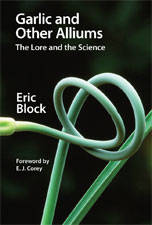 The genus Allium covers onions, garlic, leeks, chives and others. Their pungent odor comes from sulfur compounds they contain. Dr. Eric Block is a professor at New York State University at Albany, and has spent over 35 years studying the chemistry of alliums. His book covers an enormous range of information on the genus Allium. The "Lore" portions are fascinating, with references to archaeology, literature, painting, folk medicine, cultivation, and more. The "Science: parts are - well - scientific. For those who would like to explore the phytochemistry of alliums and its sulfur components, the long chapter on these topics is comprehensive.
The genus Allium covers onions, garlic, leeks, chives and others. Their pungent odor comes from sulfur compounds they contain. Dr. Eric Block is a professor at New York State University at Albany, and has spent over 35 years studying the chemistry of alliums. His book covers an enormous range of information on the genus Allium. The "Lore" portions are fascinating, with references to archaeology, literature, painting, folk medicine, cultivation, and more. The "Science: parts are - well - scientific. For those who would like to explore the phytochemistry of alliums and its sulfur components, the long chapter on these topics is comprehensive.
For the rest of us, browsing the other chapters one can discover a 1600-1700 BCE recipe for braised turnips containing onions, turnips, and garlic and leek juice. Allium references in literature range from the Bible to Shakespeare to Rudyard Kipling. There is a whole chapter on folk medicine, both its uses and some cautions, such as this one: alliums including onion, garlic, leeks and chives are toxic to cats, dogs and monkeys.
Link to this review (permalink)
Backyard Bounty by Linda A. Gilkeson, 2011
Reviewed by: Rebecca Alexander on 2011-04-30
Amidst the bumper crop of new food-gardening titles, Backyard Bounty : The Complete Guide to Year-Round Organic Gardening in the Pacific Northwest by Salt Spring Island, B.C. resident Linda Gilkeson stands apart. I put three recent edible plant titles by Northwest authors to the test by trying to find answers to commonly asked questions in them. Whether you are a beginning gardener or an experienced (or jaded!) old hand, this book will neither insult your intelligence nor blind you in a blizzard of technicalities. If you want to know about soil in raised beds, what to grow over the winter, or how to protect your grapes from predacious raccoons, this is the place. Though it lacks photos of primped and prinked up fruit and veggie glamour, the information is well-organized and clearly presented. I learned enough from reading it that I may just have to own a copy.
Link to this review (permalink)
Bug Zoo by Nick Baker, 2010
Reviewed by: Laura Blumhagen on 2011-05-20
Does someone you know want an earwiggery? How about a wormery or a dragonfly den? If you know a child who loves bugs, this illustrated handbook of bug habitats will teach him or her how to capture, observe, and learn from these tiny animals respectfully, with an understanding of their delicate biology.
Link to this review (permalink)
Grow It, Cook it by Amanda Grant, 2010
Reviewed by: Laura Blumhagen on 2011-05-20
Parents of enthusiastic young gardeners, and farmers' market shoppers alike will love this useful guide to home-growing and cooking. It features easy, photo-illustrated recipes grouped by their main ingredients, so that chocolate zucchini cake is right next to zucchini salad and stir fry, allowing cooks to choose a recipe based on what they have on hand. Better yet, each chapter begins with step-by-step instructions for growing children's favorites like herbs, peas, beans, and berries.
Link to this review (permalink)
Radical Gardening by George McKay, 2011
Reviewed by: Rebecca Alexander on 2011-06-10
 "The law condemns the man or woman
"The law condemns the man or woman
Who steals the goose from off the common
But lets the greater villain loose
Who steals the common from the goose."
-Anonymous Victorian author, 1854
This epigraph opens the first chapter ("The Garden in the [City] Machine") in George McKay's Radical Gardening: Politics, Idealism & Rebellion in the Garden, and refers to the conflict between between affluent private landowners and poor villagers over access to open space which was once shared by all. Don't be put off by the crude cover art: McKay offers thoughtful discussion based on his extensive research into the role of public and community gardens, the politics of the organic movement and its offshoots (biodynamics and permaculture), gardens of peace and war, and the many ways in which gardens and open space have figured into politics, society, and culture. McKay enjoys wordplay (remember that 'radical' is rooted!), coining the term 'horticounterculture' to describe gardening-related movements which represent activism and resistance, as well as utopian (or dystopian) visions.
Of local note: McKay cites Professor Linda Chalker-Scott's debunking the pseudo-scientific underpinnings of biodynamics (a philosophy of agriculture developed by Rudolf Steiner, whose views held some appeal for National Socialists). Seattle is also noted briefly in a list of cities with an active community garden movement.
Link to this review (permalink)
Urban Agriculture by David Tracey, 2011
Reviewed by: Rebecca Alexander on 2011-07-26
Though I personally am cheered by the sight of a P-Patch, a front garden, or a tiny apartment balcony resplendent with edible plants, there is still resistance to seeing raised beds replete with tomatoes and lettuce overtake a lawn or other underutilized space. Activist and arborist David Tracey's Urban Agriculture: Ideas and Designs for the New Food Revolution opens with an account of conflict over creating a community garden in his native Vancouver, B.C. Despite this negative note, the book is an antidote to despair. Tracey's informal and humorous style diminishes the sense of helplessness we feel in the face of corporate control over our food supply, and its attendant environmental devastation and cost to human health. Tracey does not provide detailed directions on how to grow various vegetables from seed, or how to make your own compost; his purpose is to inspire and empower the reader to begin or continue the worthwhile work of growing food (as opposed to "fuud," the term he coins for the products of Big Ag). You may not think you are engaged in agricultural pursuits but by the author's definition, anyone who grows edible plants is a farmer.
The book is explicitly organized from the smallest to largest scale of edible cultivation (sprouts on the kitchen counter to full-scale farming). There are some unusual inclusions here, such as sections on aquaponics (in case you want to grow fish and greens together!) and school farms, the self-sufficiency model of Cuba's urban farming project, and a checklist of questions to ask politicians before the next election (ask where she or he stands on the use of public space to grow food by raising the concept of usufruct, the legal right to use and enjoy the fruits or profits of something belonging to another). There are numerous quotable lines in this book, such as: "It takes food to grow a village," and "The seed knows what to do." The library also has his previous book, Guerrilla Gardening: A Manualfesto.
Link to this review (permalink)
Patio Produce by Paul Peacock, 2009
Reviewed by: Jessica Anderson on 0201-04-26
 As a first time vegetable gardener, I was looking for a resource for planting and growing vegetables from a small space: my deck. This handy book, Patio Produce: How to Cultivate a Lot of Home-Grown Vegetables from the Smallest Possible Space by Paul Peacock really helped me start my garden. It simply showed me how to make the most out of my pots and how to plan for a reasonable crop yield. I especially enjoyed the chapters on how to grow vegetables on the patio. The author has an A-Z plant list and inside there are detailed step-by-step instructions on how to grow on the patio, including an "at a glance" table that contains helpful information on the plant's pot size, sowing dates, care, and harvest information. The short but thorough snippets on specific plants, such as raspberries, strawberries, potatoes, and tomatoes helped me understand how to plant and take care of my crops.
As a first time vegetable gardener, I was looking for a resource for planting and growing vegetables from a small space: my deck. This handy book, Patio Produce: How to Cultivate a Lot of Home-Grown Vegetables from the Smallest Possible Space by Paul Peacock really helped me start my garden. It simply showed me how to make the most out of my pots and how to plan for a reasonable crop yield. I especially enjoyed the chapters on how to grow vegetables on the patio. The author has an A-Z plant list and inside there are detailed step-by-step instructions on how to grow on the patio, including an "at a glance" table that contains helpful information on the plant's pot size, sowing dates, care, and harvest information. The short but thorough snippets on specific plants, such as raspberries, strawberries, potatoes, and tomatoes helped me understand how to plant and take care of my crops.
Link to this review (permalink)
American Grown by Michelle Obama, 2012
Reviewed by: Rebecca Alexander on 2012-06-13
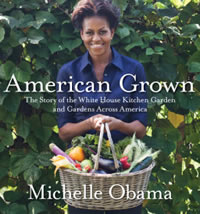 First Lady Michelle Obama's new book, American Grown: The Story of the White House Kitchen Garden and Gardens Across America (Crown Publishers, 2012) has much to say about gardening as a learning process. A novice gardener, she doesn't hesitate to admit that not all of the Kitchen Garden efforts succeeded on the first try: there were raised berms that succumbed to foot traffic and were replaced with untreated wooden boxes, troubles with cutworms, and trials and tribulations with pumpkins. But her motivation to create a food garden on the South Lawn with the participation of numerous horticulturists, chefs, and schoolchildren, has resulted in a beautiful, productive example for every aspiring urban farmer (even someone without a staff of dozens or a large growing space!).
First Lady Michelle Obama's new book, American Grown: The Story of the White House Kitchen Garden and Gardens Across America (Crown Publishers, 2012) has much to say about gardening as a learning process. A novice gardener, she doesn't hesitate to admit that not all of the Kitchen Garden efforts succeeded on the first try: there were raised berms that succumbed to foot traffic and were replaced with untreated wooden boxes, troubles with cutworms, and trials and tribulations with pumpkins. But her motivation to create a food garden on the South Lawn with the participation of numerous horticulturists, chefs, and schoolchildren, has resulted in a beautiful, productive example for every aspiring urban farmer (even someone without a staff of dozens or a large growing space!).
For readers who want to cultivate a closer relationship to the source of the food we eat (either by growing our own or by supporting small farms), this book is a good starting point. The book, which opens with a brief history of gardens at the White House, is arranged by season, and includes plans, descriptions of techniques and hands-on growing experiences, and recipes. Various experts on the garden staff contribute parts of the text. Seattle makes two appearances in the section on "How Our Gardens Grow Stronger Communities," with a page on Picardo Farm P-Patch, and a historic photo of Pike Place Market. The book ends with a resource list and bibliography.
If you are curious about the source of initial hesitation/opposition to the first White House beehive ever, here's a hint: the beehive is sited not far from the basketball court!
Link to this review (permalink)
Gossip from the Forest by Sara Maitland, 2013
Reviewed by: Rebecca Alexander on 2013-07-03
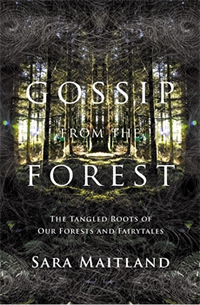 Why do forests capture our imagination? And why are so many fairytales, at least in the Northern European tradition, rooted in forests? Sara Maitland's Gossip from the Forest is a fascinating and freewheeling exploration of how people shape the natural world, which shapes the tales we tell, which in turn shape us.
Why do forests capture our imagination? And why are so many fairytales, at least in the Northern European tradition, rooted in forests? Sara Maitland's Gossip from the Forest is a fascinating and freewheeling exploration of how people shape the natural world, which shapes the tales we tell, which in turn shape us.
Maitland opens with the original meaning of the word 'gossip' ("one who has contracted a spiritual relationship to another, or a familiar acquaintance or friend"). As a feminist writer, she is reclaiming a term she believes has been trivialized to dismiss the power of women's communication. (The American edition of the book has truncated the title to From the Forest, which is a shame.)
The chapters run from March through February, and in each Maitland visits a different forest in England or Scotland, and ends with a unique retelling of a familiar fairytale. There is much to ponder and to absorb. The descriptions of coppicing and pollarding were surprising to me, and I had to overcome my reflexive distaste for human interventions in the growth of forest trees. In a deciduous forest setting, these practices can be beneficial not only to humans (who need wood for fuel, building, and other uses) but to the trees as well. She notes that coppicing extends the lifespan of oaks, for example. Pollarding, which is done higher up on the tree, makes the thin branches accessible to humans but not to browsing deer and other mammals.
Another observation that intrigued me was the venerated position beech trees hold in British culture (see Richard Mabey's book Beechcombings, or the widespread use of beeches in private estates to "posh up the landscape," to quote the book) compared to the birch, which the author prefers for its aesthetic and useful qualities. Beech is thought of as native, but is widespread across Europe; in Britain it mainly grows in the southern half of the country. She recalls her father's saying that "tyranny is like a beech tree; it looks very fine but nothing grows under it."
This is a book with a wide reach. Maitland touches on the history of the powerful and the powerless as evidenced in policies like enclosure (ending public rights and access to land which was once held in common), and on the cultural and psychological underpinnings of tales in which common folk are skilled and wise while kings are fools and landed gentry are consumed by greed. Her walks through the forest evoke the mystery of the natural world and the stories we tell to understand our place in it. Adam Lee, Maitland's son (who took the photographs which accompany the text), provides a useful image which summarizes the essence of the book: fairytales, forests, and people are interdependent, like mycorrhizae and tree roots.
Link to this review (permalink)
The Adorable Plot by Tessa Newcomb, 2012
Reviewed by: Rebecca Alexander on 2013-07-19
Here in Seattle, we have our picturesque and productive P-Patches. In England, allotment gardens trace their roots to the policies of enclosure of open fields which had been held in common, and to industrialization and burgeoning urban populations. This fencing in and privatization began as early as the 14th century but was widespread through the 18th and 19th centuries, when allotments were offered as a small compensation to villagers and city dwellers who did not own private land.
Painter Tessa Newcomb's The Adorable Plot is an exuberant celebration of the beauty and bounty of the allotments in her native Suffolk coast. The first striking thing about her art is the sense of scale. Dried poppy heads, trellis-climbing beans, and giant artichokes dwarf the humans who tend these busy and productive plots. Newcomb's use of color and space is reminiscent of Stanley Spencer, but her style is looser and more dynamic. Although Newcomb's paintings and drawings are the focal point, the text also delights with humor and poetic description. Poppies which have shed their petals are "lovely green globes, ginger cartwheels at the top and secret openings ready to disperse their seeds." Of a couple observing the fruits of their labor: "They sat in the chairs overlooking the plot which swayed like the sea." Whether or not you have an adorable plot of your own, this book will inspire you to head out to a garden with your eyes open, and perhaps your favorite garden tool or paintbrush in hand.
Related titles:
- Stanley Spencer and the English Garden edited by Steven Parissien (Compton Verney Gallery, 2010)
- Allotments by Twigs Way (Shire, 2008)
Link to this review (permalink)
Plants of Haida Gwaii by Nancy Turner, 2004
Reviewed by: Brian Thompson on 2007-10-01
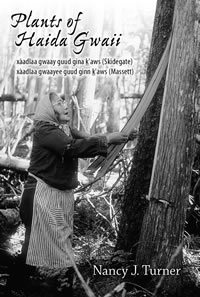 Haida Gwaii, known by many as the Queen Charlotte Islands, has a rich and distinctive history of using plants in all aspects of the life of the indigenous Haida people. Nancy Turner has completed a project of over 30 years to document these practices, which is present here in a very thorough, yet quite readable presentation. Organized using the indigenous taxonomic systems, the use of plants for food, medicine, technology, and ceremony is interwoven with narratives of traditional stories and beliefs, often told through the interaction between plants and animals. These are juxtaposed with current issues of conservation, dealing with invasive species to these fairly isolated islands, and the disappearance of a way of life.
Haida Gwaii, known by many as the Queen Charlotte Islands, has a rich and distinctive history of using plants in all aspects of the life of the indigenous Haida people. Nancy Turner has completed a project of over 30 years to document these practices, which is present here in a very thorough, yet quite readable presentation. Organized using the indigenous taxonomic systems, the use of plants for food, medicine, technology, and ceremony is interwoven with narratives of traditional stories and beliefs, often told through the interaction between plants and animals. These are juxtaposed with current issues of conservation, dealing with invasive species to these fairly isolated islands, and the disappearance of a way of life.
Excerpted from the Fall 2007 Arboretum Bulletin.
Link to this review (permalink)
Invasive Species in the Pacific Northwest by P.D. Boersma, 2006
Reviewed by: Brian Thompson on 2007-10-01
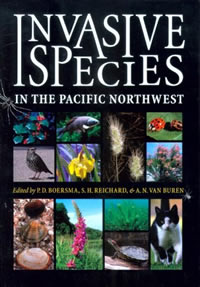 This collaboration of over 80 authors, most of them students at the University of Washington, is a field guide to the region's invasive species that includes not only the noxious weeds gardeners fear, but aquatic plants, animals, invertebrates and even diseases. Sarah Reichard, head of conservation for UWBG, is one of the three editors that managed the project. The inclusion of the domestic cat is sure to get your attention, but a thorough reading describes a complex ecological web that will influence the way we look at the world around, especially in our gardens. The whole discussion of what constitutes an invasive species is fascinating in itself. A special section on these issues as they pertain to the Haida Gwaii is nice companion reading to the previous book.
This collaboration of over 80 authors, most of them students at the University of Washington, is a field guide to the region's invasive species that includes not only the noxious weeds gardeners fear, but aquatic plants, animals, invertebrates and even diseases. Sarah Reichard, head of conservation for UWBG, is one of the three editors that managed the project. The inclusion of the domestic cat is sure to get your attention, but a thorough reading describes a complex ecological web that will influence the way we look at the world around, especially in our gardens. The whole discussion of what constitutes an invasive species is fascinating in itself. A special section on these issues as they pertain to the Haida Gwaii is nice companion reading to the previous book.
Excerpted from the Fall 2007 Arboretum Bulletin.
Link to this review (permalink)
Restoring the Pacific Northwest by Dean Apostol, 2006
Reviewed by: Brian Thompson on 2007-10-01
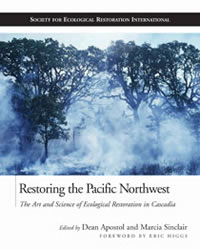 This book details our major ecosystems, how they've worked historically, how that work has been interrupted, and possible corrections. These systems are defined first by plant zones or geographical features, such as bunchgrass prairies or tidal wetlands, and then reexamined as large scale landscapes that cross zones, including urban natural areas and watersheds. This is not a field guide, and not a quick read (and not cheap!), but the more technical parts are brought to life by case studies from throughout the area. Invasive vegetation is given its own chapter, as is a study of ecological knowledge and restoration practices by indigenous peoples. Editors Dean Apostol and Marcia Sinclair present a good survey of this large and important topic.
This book details our major ecosystems, how they've worked historically, how that work has been interrupted, and possible corrections. These systems are defined first by plant zones or geographical features, such as bunchgrass prairies or tidal wetlands, and then reexamined as large scale landscapes that cross zones, including urban natural areas and watersheds. This is not a field guide, and not a quick read (and not cheap!), but the more technical parts are brought to life by case studies from throughout the area. Invasive vegetation is given its own chapter, as is a study of ecological knowledge and restoration practices by indigenous peoples. Editors Dean Apostol and Marcia Sinclair present a good survey of this large and important topic.
Excerpted from the Fall 2007 Arboretum Bulletin.
Link to this review (permalink)
Wild Orchids of the Pacific Northwest & Canadian Rockies by Paul Martin Brown, 2006
Reviewed by: Brian Thompson on 2007-10-01
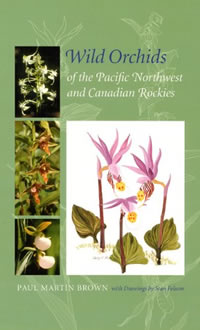 A field guide "to assist the user in identifying" the wild orchids throughout an expansion of our region that includes Alaska and western Alberta and Montana. Author Paul Martin Brown, of the University of Florida, has a series of similar titles covering all of North America except for the southwest; however he has clearly spent considerable time in our region. Appendices brim with reference materials, many trying to untangle the nomenclature of our orchids, but more romantic is the "Orchid Hunting" section with tips such as "watch for small, shaded cemeteries along the way." Essays such as "The Correct Name for the Northwestern Twayblade" add to this slightly eccentric but fun book.
A field guide "to assist the user in identifying" the wild orchids throughout an expansion of our region that includes Alaska and western Alberta and Montana. Author Paul Martin Brown, of the University of Florida, has a series of similar titles covering all of North America except for the southwest; however he has clearly spent considerable time in our region. Appendices brim with reference materials, many trying to untangle the nomenclature of our orchids, but more romantic is the "Orchid Hunting" section with tips such as "watch for small, shaded cemeteries along the way." Essays such as "The Correct Name for the Northwestern Twayblade" add to this slightly eccentric but fun book.
Excerpted from the Fall 2007 Arboretum Bulletin.
Link to this review (permalink)
A Pattern Garden by Val Easton, 2007
Reviewed by: Brian Thompson on 2007-10-01
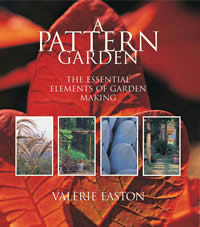 Val Easton's warm and clear writing style is very familiar, but her subject matter in this book breaks new ground as she applies the architectural concepts of patterns, or putting "human instincts into words," to garden setting. Throughout she "helps us to understand why we feel comfortable in a space" and why, in other places, we don't. The patterns are not unfamiliar: Scale, Garden Rooms, Ornamentation, Containers, etc., but some associations may be new, such as grouping Patios, Sheds and Focal Points under destinations. This makes it important to read the book as a whole, even though you'll return to favorite sections again and again for specifics. A short review of favorite plants concludes the book, but these are just one more pattern in the larger design.
Val Easton's warm and clear writing style is very familiar, but her subject matter in this book breaks new ground as she applies the architectural concepts of patterns, or putting "human instincts into words," to garden setting. Throughout she "helps us to understand why we feel comfortable in a space" and why, in other places, we don't. The patterns are not unfamiliar: Scale, Garden Rooms, Ornamentation, Containers, etc., but some associations may be new, such as grouping Patios, Sheds and Focal Points under destinations. This makes it important to read the book as a whole, even though you'll return to favorite sections again and again for specifics. A short review of favorite plants concludes the book, but these are just one more pattern in the larger design.
Excerpted from the Fall 2007 Arboretum Bulletin.
Link to this review (permalink)
Ask Ciscoe by Ciscoe Morris, 2007
Reviewed by: Brian Thompson on 2007-10-01
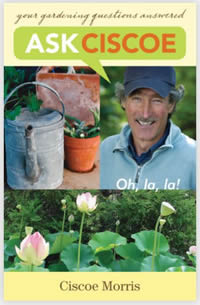 Ciscoe Morris writes like he talks, so you know this book will be fun. Less appreciated is his vast knowledge base that he has acquired from years of experience both as a professional and avid home gardener. That knowledge is presented in a Question (sometimes as funny as the answers) and Answer format, broadly organized into categories such as Flower Plants, Edible Plants, Garden and Lawn Care, etc. Good for the bedside table -- to foster ideas as you read as little or as much as you want, or use the excellent index to find a specific topic. There's much more here -- and its all experience based -- than first meets the eye.
Ciscoe Morris writes like he talks, so you know this book will be fun. Less appreciated is his vast knowledge base that he has acquired from years of experience both as a professional and avid home gardener. That knowledge is presented in a Question (sometimes as funny as the answers) and Answer format, broadly organized into categories such as Flower Plants, Edible Plants, Garden and Lawn Care, etc. Good for the bedside table -- to foster ideas as you read as little or as much as you want, or use the excellent index to find a specific topic. There's much more here -- and its all experience based -- than first meets the eye.
Excerpted from the Fall 2007 Arboretum Bulletin.
Link to this review (permalink)
Garden to Vase by Linda Beutler, 2007
Reviewed by: Brian Thompson on 2007-10-01
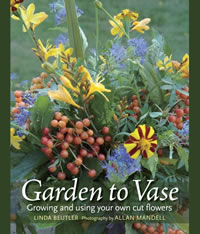 Linda Beutler thinks every gardener should be a florist, at least for his or her own home. On this premise she has written this extensive primer addressing all aspects of filling your vases (or whatever) for any and all occasions. Or for no occasion, other than to better enjoy the bounty of your garden. And the tips are great, such as how to "rinse" your daffodils so they don't kill the tulips you add to their arrangement. The second half of the book is an A-Z listing the best cutting plants, including growing tips, harvesting tips, vase life, when (or when not) to use preservatives, and what parts of the plant -- seeds, flower, leaves, etc. -- can be used, either fresh or dried. All this is clearly illustrated with Allan Mandell's excellent photos.
Linda Beutler thinks every gardener should be a florist, at least for his or her own home. On this premise she has written this extensive primer addressing all aspects of filling your vases (or whatever) for any and all occasions. Or for no occasion, other than to better enjoy the bounty of your garden. And the tips are great, such as how to "rinse" your daffodils so they don't kill the tulips you add to their arrangement. The second half of the book is an A-Z listing the best cutting plants, including growing tips, harvesting tips, vase life, when (or when not) to use preservatives, and what parts of the plant -- seeds, flower, leaves, etc. -- can be used, either fresh or dried. All this is clearly illustrated with Allan Mandell's excellent photos.
Excerpted from the Fall 2007 Arboretum Bulletin.
Link to this review (permalink)
Natural Insect, Weed & Disease Control by Linda Gilkeson, 2006
Reviewed by: Brian Thompson on 2007-10-01
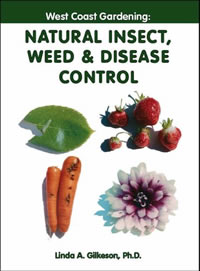 A Salt Spring Island, British Columbia entomologist, Linda Gilkeson is enthralled with the work of beneficial insects in the garden, especially in combating pests. This manual is based on her experience and is very specific to our region. She clearly gives her opinion on what works, and what doesn't. While the focus is on insects, weeds and diseases get their turn, too. Most of the information is available from other sources, but like many hands-on work, there's much valuable empirical knowledge. One suggestion caught my eye: planting alyssum amongst gladiolus to attract pirate bugs, who in turn will eliminate the thrips that devastate the glads. It's worth a try!
A Salt Spring Island, British Columbia entomologist, Linda Gilkeson is enthralled with the work of beneficial insects in the garden, especially in combating pests. This manual is based on her experience and is very specific to our region. She clearly gives her opinion on what works, and what doesn't. While the focus is on insects, weeds and diseases get their turn, too. Most of the information is available from other sources, but like many hands-on work, there's much valuable empirical knowledge. One suggestion caught my eye: planting alyssum amongst gladiolus to attract pirate bugs, who in turn will eliminate the thrips that devastate the glads. It's worth a try!
Excerpted from the Fall 2007 Arboretum Bulletin.
Link to this review (permalink)
Coastal Gardening in the Pacific Northwest by Carla Albright, 2007
Reviewed by: Brian Thompson on 2007-10-01
 A coastal garden book, this written by a transplanted Pennsylvania Master Gardener, who took the training again in Oregon. Written to a very specific audience, a fact brought home by the second chapter: "Dune Gardening." Yes, this is for those with lots of sand in their soil. Carla Albright has designed this as a handbook, with many pages of worksheets for the reader to fill out based on experiences. The tips are very basic, too. "In my tool bucket I keep two trowels, a narrow one and a wide one. The narrow one is good for..." Following a review of native beach plants, there are suggestions for appropriate beach garden aesthetics, and an extensive list of shore tested vegetable varieties.
A coastal garden book, this written by a transplanted Pennsylvania Master Gardener, who took the training again in Oregon. Written to a very specific audience, a fact brought home by the second chapter: "Dune Gardening." Yes, this is for those with lots of sand in their soil. Carla Albright has designed this as a handbook, with many pages of worksheets for the reader to fill out based on experiences. The tips are very basic, too. "In my tool bucket I keep two trowels, a narrow one and a wide one. The narrow one is good for..." Following a review of native beach plants, there are suggestions for appropriate beach garden aesthetics, and an extensive list of shore tested vegetable varieties.
Excerpted from the Fall 2007 Arboretum Bulletin.
Link to this review (permalink)
The Bellevue Botanical Garden by Marty Wingate, 2007
Reviewed by: Brian Thompson on 2007-10-01
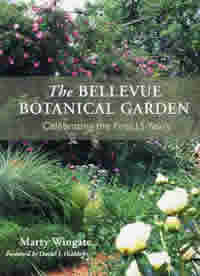 The authors of this book were nurtured and informed by the well-known Northwest Perennial Alliance Borders at the Bellevue Botanical Garden. Here, Marty Wingate tells how the Borders are part of a much greater whole brought together by a diverse group of plant lovers. The detailed history is followed by descriptions in word and photo that highlight features and plants in each of the nine gardens, augmented with short profiles of key players. A Garden promotion, yes, but there's also some good history and enough about the individual plantings to take some ideas home, especially if this book accompanies your next visit to Bellevue.
The authors of this book were nurtured and informed by the well-known Northwest Perennial Alliance Borders at the Bellevue Botanical Garden. Here, Marty Wingate tells how the Borders are part of a much greater whole brought together by a diverse group of plant lovers. The detailed history is followed by descriptions in word and photo that highlight features and plants in each of the nine gardens, augmented with short profiles of key players. A Garden promotion, yes, but there's also some good history and enough about the individual plantings to take some ideas home, especially if this book accompanies your next visit to Bellevue.
Excerpted from the Fall 2007 Arboretum Bulletin.
Link to this review (permalink)
Hortus Miscellaneous by Lorene Edwards Forkner, 2007
Reviewed by: Brian Thompson on 2007-10-01
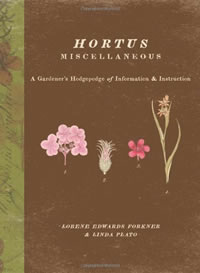 Whimsy, science, puzzles, construction plans, trivia, lists, do-it-yourself instructions -- it's all here in this very hard to describe book. Lorene Edwards Forkner and the late Linda Plato have created a one-of-a-kind book that, like so many other books described in this column, travels well beyond the Pacific Northwest. Turning to a random page, one finds a list of suitable plans for a knot garden, followed by the comparative definitions of monoecious and dioecious, sports teams with horticultural themes (The Fighting Okra?!?), and instructions on how to lay a flagstone pathway. You get the idea.
Whimsy, science, puzzles, construction plans, trivia, lists, do-it-yourself instructions -- it's all here in this very hard to describe book. Lorene Edwards Forkner and the late Linda Plato have created a one-of-a-kind book that, like so many other books described in this column, travels well beyond the Pacific Northwest. Turning to a random page, one finds a list of suitable plans for a knot garden, followed by the comparative definitions of monoecious and dioecious, sports teams with horticultural themes (The Fighting Okra?!?), and instructions on how to lay a flagstone pathway. You get the idea.
Excerpted from the Fall 2007 Arboretum Bulletin.
Link to this review (permalink)
Flora Celtica by William Milliken, 2004
Reviewed by: Brian Thompson on 2008-01-01
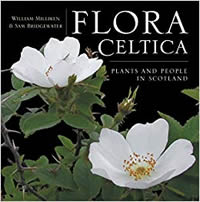 If I could only have one book on Scottish plants, it would be "Flora Celtica: Plants and People in Scotland." While the main title suggests a comprehensive, taxonomic review of natives, authors William Milliken and Sam Bridgewater instead use ethnobotany as their framework to categorize plants by their impact on humans.
If I could only have one book on Scottish plants, it would be "Flora Celtica: Plants and People in Scotland." While the main title suggests a comprehensive, taxonomic review of natives, authors William Milliken and Sam Bridgewater instead use ethnobotany as their framework to categorize plants by their impact on humans.
And there is quite a range to this impact. Besides the expected foods, traditional crafts and medicines, this book both looks to the past -- recounting much folklore and ceremony -- and to the future, exploring the role of plants as we grapple with climate change, restoration and sustainability of resources.
The genius is in the presentation -- turn to any page and find fascinating biographies, historical photos and drawings, even poetry and lyrics of traditional songs, all woven around a very readable text. But this is not just about history -- the photographs (many by author Milliken) clearly illustrate the landscape and people of today.
"We no longer fumigate our houses with juniper leaves...or tie rowan twigs onto our cows' tails to ward off the fairies. But we do still...decorate our homes with holly at Christmas and plant marram grass to hold back the sea. And, while some practices are being lost, others are being acquired..." This quote from the introduction captures the spirit of this large, complex, and thoroughly engaging book.
Excerpted from the Winter 2008 Arboretum Bulletin.
Link to this review (permalink)
Scottish Wild Plants by Philip Lusby, 1996
Reviewed by: Brian Thompson on 2008-01-01
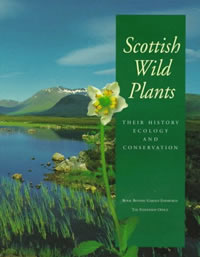 For something to fit in your suitcase when travelling to Scotland, consider "Scottish Wild Plants: Their History, Ecology and Conservation." Authors Philip Lusby and Jenny Wright skillfully weave into some 40 plant profiles description, habitat, ecological niche, associated plants and animals, natural history, and even something of the history of Scottish botany. This is good reading straight through, yet still useful as a reference work, although you'll want a pocket field guide, too -- there are several good ones in any Scottish bookstore. This book is more for setting the mood. For example, you'll learn that Primula scotica is one of the few endemic plants in Scotland and its survival is linked to rabbits, an introduced animal to Britain in Roman times. But the relationship isn't what you'd guess. The Scottish primrose actually thrives best where rabbits are plentiful, as they eat the plants that shade this tiny, post-glacial relic.
For something to fit in your suitcase when travelling to Scotland, consider "Scottish Wild Plants: Their History, Ecology and Conservation." Authors Philip Lusby and Jenny Wright skillfully weave into some 40 plant profiles description, habitat, ecological niche, associated plants and animals, natural history, and even something of the history of Scottish botany. This is good reading straight through, yet still useful as a reference work, although you'll want a pocket field guide, too -- there are several good ones in any Scottish bookstore. This book is more for setting the mood. For example, you'll learn that Primula scotica is one of the few endemic plants in Scotland and its survival is linked to rabbits, an introduced animal to Britain in Roman times. But the relationship isn't what you'd guess. The Scottish primrose actually thrives best where rabbits are plentiful, as they eat the plants that shade this tiny, post-glacial relic.
Excerpted from the Winter 2008 Arboretum Bulletin.
Link to this review (permalink)
The Gardens of The National Trust for Scotland by Francesca Greenoak, 2005
Reviewed by: Brian Thompson on 2008-01-01
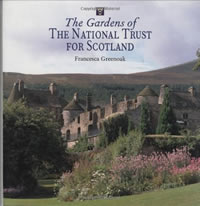 How I wish "The Gardens of The National Trust for Scotland," by Francesca Greenoak had been available when I visited Scotland gardens, as nearly every garden on my short list was part of the Trust. I would have known before my visit that Inverewe is indeed a rhododendron haven with over 2,000 different types, and that the founder was known as "bigleaf" Osgood for his love of large-leaf rhodies. Greenoak is skilled at teasing out these life-giving facts for her garden descriptions. Of equal importance are the photographs of Brian Chapple. Much more than coffee table filler, his images tell a story, such as the rejuvenation of the massive and ancient yew hedges at Crathes Castle. I gasped at seeing stately walls of green cut back to bare stumps, but subsequent images show the gradual regrowth and restoration of these 300 years old masterpieces. The gardening staff knows their craft!
How I wish "The Gardens of The National Trust for Scotland," by Francesca Greenoak had been available when I visited Scotland gardens, as nearly every garden on my short list was part of the Trust. I would have known before my visit that Inverewe is indeed a rhododendron haven with over 2,000 different types, and that the founder was known as "bigleaf" Osgood for his love of large-leaf rhodies. Greenoak is skilled at teasing out these life-giving facts for her garden descriptions. Of equal importance are the photographs of Brian Chapple. Much more than coffee table filler, his images tell a story, such as the rejuvenation of the massive and ancient yew hedges at Crathes Castle. I gasped at seeing stately walls of green cut back to bare stumps, but subsequent images show the gradual regrowth and restoration of these 300 years old masterpieces. The gardening staff knows their craft!
Excerpted from the Winter 2008 Arboretum Bulletin.
Link to this review (permalink)
Private Gardens of Scotland by James Truscott, 1988
Reviewed by: Brian Thompson on 2008-01-01
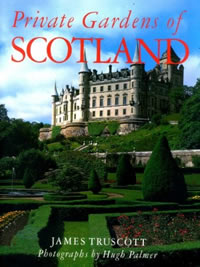 James Truscott states in the introduction to Private Gardens of Scotland his hope to transport the reader to "...a temporary withdrawal from humdrum everyday life into a cloistered world of scents and colours, where half-forgotten feelings of wonderment and awe can be rediscovered." An ambitious goal, but he succeeds by having one of the best pens for garden description I've ever read. The photographs of Hugh Palmer compliment the writing, but they are not the stars. This book is meant to be read -- even if you never visit the gardens, Truscott's nuance of detail and narrative style of "touring" will teach you much, especially about design, as is befitting for an author who is also a landscape architect. He's full of fun facts, too: Did you know that Mary Queen of Scots, the Crown Prince of Imperial Japan, and Margaret Thatcher have all planted trees at Scone Palace near Perth?
James Truscott states in the introduction to Private Gardens of Scotland his hope to transport the reader to "...a temporary withdrawal from humdrum everyday life into a cloistered world of scents and colours, where half-forgotten feelings of wonderment and awe can be rediscovered." An ambitious goal, but he succeeds by having one of the best pens for garden description I've ever read. The photographs of Hugh Palmer compliment the writing, but they are not the stars. This book is meant to be read -- even if you never visit the gardens, Truscott's nuance of detail and narrative style of "touring" will teach you much, especially about design, as is befitting for an author who is also a landscape architect. He's full of fun facts, too: Did you know that Mary Queen of Scots, the Crown Prince of Imperial Japan, and Margaret Thatcher have all planted trees at Scone Palace near Perth?
Excerpted from the Winter 2008 Arboretum Bulletin.
Link to this review (permalink)
4 Gardens in One by Deni Bown, 1992
Reviewed by: Brian Thompson on 2008-01-01
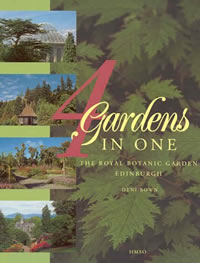 "4 Gardens in One," by Deni Bown is an excellent source for learning about the four sites of the Royal Botanic Gardens Edinburgh. Written with passion and an eye for lively history -- Bown took the photographs, too -- in her details about the Younger Botanic Garden at Benmore, I learned the full truth of Rhododendron ponticum. "Even today one will encounter areas in the far west of the garden which are yet to be cleared; these are still ponticum territory and virtually impenetrable."
"4 Gardens in One," by Deni Bown is an excellent source for learning about the four sites of the Royal Botanic Gardens Edinburgh. Written with passion and an eye for lively history -- Bown took the photographs, too -- in her details about the Younger Botanic Garden at Benmore, I learned the full truth of Rhododendron ponticum. "Even today one will encounter areas in the far west of the garden which are yet to be cleared; these are still ponticum territory and virtually impenetrable."
Excerpted from the Winter 2008 Arboretum Bulletin.
Link to this review (permalink)
The Art and Science of William Bartram by Judith Magee, 2007
Reviewed by: Brian Thompson on 2008-07-01
 Children's books may lead to some interesting discoveries in adult literature. The story of Billy, the little botanist, grows up in "The Art and Science of William Bartram" by Judith Magee. Here the simple leaf-drawing boy is revealed as more than an intrepid explorer and skilled artist of nature.
Children's books may lead to some interesting discoveries in adult literature. The story of Billy, the little botanist, grows up in "The Art and Science of William Bartram" by Judith Magee. Here the simple leaf-drawing boy is revealed as more than an intrepid explorer and skilled artist of nature.
Despite the title and the inclusion of nearly 70 of William's drawings, many of birds, fish, and reptiles in addition to plants, this is not primarily an art book. It is a wide-ranging narrative that places the Bartrams, in particular William, in the context of the science, philosophy, religion, culture, and politics of their time.
Excerpts from publications, journals, and correspondence are skillfully woven into a narrative that I found as engaging as the simple tale in "Flower Hunter." Extensive asides profile important associates, many which were themselves instrumental in the beginnings of the American scientific community.
Throughout Magee concludes that William Bartram was not fully appreciated in his own time and place. His astute concerns about the ecology (well before the term was coined) of the natural world, and his beliefs in the equality of the Native Americans, were views shared by very few others. She sees his influence not only in botany, zoology and ethnography, but also on the European poets of Romanticism at the turn of 19th century.
When studied today, the author concludes William is "often seen as a pioneer in the field of ecology, a radical rather than a conservative in his politics, nationalism and religion, and a Romantic rather than a man of the Enlightenment." It is also noteworthy that he spent a long retirement in his garden, as it "remained the single most important thing" in his later years.
Excerpted from the Summer 2008 Arboretum Bulletin.
Link to this review (permalink)
The Flower Hunter by Deborah Kogan Ray, 2004
Reviewed by: Brian Thompson on 2008-07-01
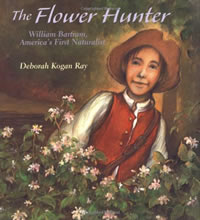 "My father, John Bartram, is a botanist. He studies plants and trees. I help him with his work. My name is William, but everyone calls me Billy. Father calls me his 'little botanist.'"
"My father, John Bartram, is a botanist. He studies plants and trees. I help him with his work. My name is William, but everyone calls me Billy. Father calls me his 'little botanist.'"
Thus Deborah Kogan Ray begins her first person narrative of the life of William Bartram (1739-1823) in "The Flower Hunter," a book written for children that can be read with enjoyment by adults as well. Much has been written about this early American naturalist and artist -- and his equally famous botanist father, John Bartram (1699-1777) -- but none can match the charm of this 40-page book, which is richly illustrated by the author.
"The Flower Hunter" tells the story of a young boy who grows up on a farm near Philadelphia and early becomes fascinated by his father's love of plants and botanical exploration. Throughout his childhood, Billy's father leads him on field trips that range farther and farther away from the farm. Eventually their roles reverse, and the son becomes an explorer who returns home triumphantly to share his discoveries about the natural world with his aging father.
Kogan Ray places her straightforward account against a wider backdrop -- the struggles of an emerging nation and the hardships and thrills of travel through a landscape and time very different from today. New plants, animals and even peoples are waiting to be found, described and - unusual for scientific traditions of the time -- cherished in their natural state.
Why do the Bartrams remain important to us now? Together they discovered the Franklin tree (Franklinia alatamaha) in coastal Georgia in 1765; a short time later the tree became extinct in the wild. An example of this beautiful tree, that blooms in autumn while its foliage is turning bright red, can be found on the east edge of the Arboretum's Azalea Way, about 100 yards north of the Winter Garden.
While today's botanic gardens and arboreta would be duller places without the Franklin tree, the Bartrams left us far more than this one showstopper. Their farm became one of the first botanic gardens in the United States, and is open to the public. (see ). And they were instrumental, along with their friend Benjamin Franklin and others, in developing an American tradition of studying the natural sciences.
Perhaps best, they both wrote detailed journals of their travels. William's "Travels," published in 1791, is still in print today and is credited by Kogan Ray with having "inspired Henry David Thoreau and Charles Darwin with its observations of the world of nature."
Excerpted from the Summer 2008 Arboretum Bulletin.
Link to this review (permalink)
The Passionate Gardener by Des Kennedy, 2006
Reviewed by: Brian Thompson on 2013-07-24
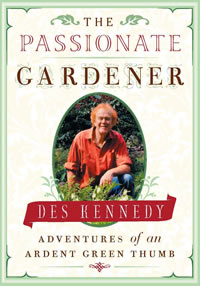 Based on his earlier, high-energy books, it is not hard to imagine Des Kennedy as the author of book entitled "The Passionate Gardener". With wicked humor and incredible insight to both gardens and gardeners, he warns of the seven deadly sins of gardening, and extols its ten commandments. Other chapters are more reflective, but he's always ready to see the irony and contradictions in how we conduct our favorite pursuit.
Based on his earlier, high-energy books, it is not hard to imagine Des Kennedy as the author of book entitled "The Passionate Gardener". With wicked humor and incredible insight to both gardens and gardeners, he warns of the seven deadly sins of gardening, and extols its ten commandments. Other chapters are more reflective, but he's always ready to see the irony and contradictions in how we conduct our favorite pursuit.
Kennedy also displays a knack for travel writing, making trips to Hawaii, Ireland, and New Zealand entertaining while packing in a lot of names and facts that would be handy for planning your own trip. This is the perfect reading companion for a winter's evening and between the laughs, you just might soak up some good, sound gardening counsel based the author's years of gardening in the British Columbia Gulf Islands.
Excerpted from the Fall 2008 Arboretum Bulletin.
Link to this review (permalink)
Best Plant Picks by Steve Whysall, 2008
Reviewed by: Brian Thompson on 2008-10-01
 Steve Whysall has been a regular garden writer for the Vancouver Sun for 15 years. "Best Plant Picks" selects trees, shrubs, perennials, bulbs, and ferns from his more recent columns and organizes them in a gardening calendar, including tips on monthly chores and seasonal highlights. While not a major departure for the author's earlier books, there are some interesting juxtapositions here. A good choice for a new gardener who is willing to experiment.
Steve Whysall has been a regular garden writer for the Vancouver Sun for 15 years. "Best Plant Picks" selects trees, shrubs, perennials, bulbs, and ferns from his more recent columns and organizes them in a gardening calendar, including tips on monthly chores and seasonal highlights. While not a major departure for the author's earlier books, there are some interesting juxtapositions here. A good choice for a new gardener who is willing to experiment.
Excerpted from the Fall 2008 Arboretum Bulletin.
Link to this review (permalink)
Uncommon Beauty by Neil L. Jennings, 2006
Reviewed by: Brian Thompson on 2013-07-24
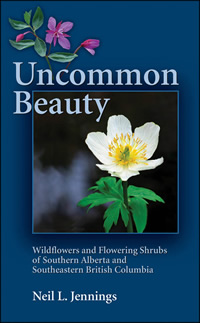 Excellent photographs are the outstanding quality of "Uncommon Beauty", a new field guide focused on an underexplored part of the Pacific Northwest -- southeastern British Columbia. Written by an enthusiastic outdoorsman and native of the area, Neil L. Jennings provides a very readable description of over 200 plants, many who have ranges that extend southward into eastern Washington.
Excellent photographs are the outstanding quality of "Uncommon Beauty", a new field guide focused on an underexplored part of the Pacific Northwest -- southeastern British Columbia. Written by an enthusiastic outdoorsman and native of the area, Neil L. Jennings provides a very readable description of over 200 plants, many who have ranges that extend southward into eastern Washington.
Excerpted from the Fall 2008 Arboretum Bulletin.
Link to this review (permalink)
The Flora of Mount Adams, Washington by David Biek, 2007
Reviewed by: Brian Thompson on 2013-07-24
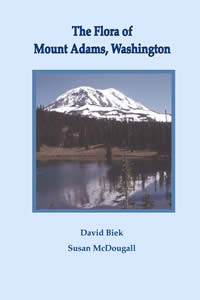 For the serious student of native plants, "The Flora of Mount Adams, Washington" will be an important work. Considered to be the most diverse flora in the state, Mt. Adams hosts several, quite distinct habitats and over 800 distinct species of plants. As there are no photographs and only botanist-oriented descriptions and identifying keys, this is not for the casual seeker of wildflowers. Instead, look for co-author Susan McDougall's "The Wildflowers of Mount Adams, Washington."
For the serious student of native plants, "The Flora of Mount Adams, Washington" will be an important work. Considered to be the most diverse flora in the state, Mt. Adams hosts several, quite distinct habitats and over 800 distinct species of plants. As there are no photographs and only botanist-oriented descriptions and identifying keys, this is not for the casual seeker of wildflowers. Instead, look for co-author Susan McDougall's "The Wildflowers of Mount Adams, Washington."
Excerpted from the Fall 2008 Arboretum Bulletin.
Link to this review (permalink)
Encyclopedia of Northwest Native Plants for Gardens and Landscapes by Kathleen A. Robson, 2008
Reviewed by: Brian Thompson on 2008-10-01
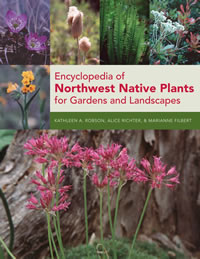 For gardeners, the most important new book of the year will be the "Encyclopedia of Northwest Native Plants for Gardens and Landscapes". A trio of southwest Washington writers brings extensive experience in botany, propagating and growing native plants, and photography together in this very comprehensive and extensive book that will be a standard reference for many years to come.
For gardeners, the most important new book of the year will be the "Encyclopedia of Northwest Native Plants for Gardens and Landscapes". A trio of southwest Washington writers brings extensive experience in botany, propagating and growing native plants, and photography together in this very comprehensive and extensive book that will be a standard reference for many years to come.
A brief introduction lays the ground rules: only natives -- nothing naturalized since the arrival of "non-indigenous human explorers". Plants that are rare and nearly impossible to grow in cultivation are out, too. An example being the various lovely but sensitive slipper orchids.
There are some seeming exceptions to this last rule, such as Erythronium montanum, the stunning but notoriously difficult-to-cultivate avalanche lily seen at Hurricane Ridge. However, the authors note, it can be grown by gardeners who live at higher elevations.
The heart of the book is a listing of over 500 species that gives a basic description, cultivation requirements, native range and habitat, plus notes about related species, ethnobotany and selected varieties. Propagation tips are included, with a strong emphasis on conservation of plants in situ.
The excellent photographs make this a pretty good identification book, too, and will convince you to add more natives to your home garden, including ferns, shrubs, and trees, both broad leaf and conifers. The appendices include helpful lists of plants to meet various gardening needs (for shade, for wildflower meadows, for hummingbirds, etc.). This book is a must have!
Excerpted from the Fall 2008 Arboretum Bulletin.
Link to this review (permalink)
The Last Oasis by Tom Reese, 2007
Reviewed by: Brian Thompson on 2013-07-24
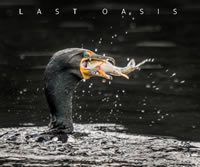 "The Last Oasis," by Seattle Times photographer Tom Reese extends a bit beyond the Arboretum in its scope, including human subjects and their impact, some of it benign but much that's troubling. However the message is much the same -- these urban wetlands are a treasure that is critical to preserve.
"The Last Oasis," by Seattle Times photographer Tom Reese extends a bit beyond the Arboretum in its scope, including human subjects and their impact, some of it benign but much that's troubling. However the message is much the same -- these urban wetlands are a treasure that is critical to preserve.
Excerpted from the Fall 2008 Arboretum Bulletin.
Link to this review (permalink)
The Wild Within by Joan Burton, 2007
Reviewed by: Brian Thompson on 2013-07-24
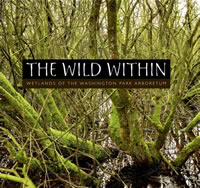 "The Wild Within" is a photo collection highlighting the wetlands -- with a special emphasis on the animals of the Washington Park Arboretum. It is a real page-turner, but pages that you'll return to and savor frequently with an even deeper appreciation of the value of our Arboretum.
"The Wild Within" is a photo collection highlighting the wetlands -- with a special emphasis on the animals of the Washington Park Arboretum. It is a real page-turner, but pages that you'll return to and savor frequently with an even deeper appreciation of the value of our Arboretum.
Essays provide occasional breaks in the photographs and they are well worth reading. Notables Dale Chihully, Dan Evans, Peter Steinbrueck, William Ruckelshaus and others shed their public faces to give very personal accounts of the importance of the Arboretum.
Excerpted from the Fall 2008 Arboretum Bulletin.
Link to this review (permalink)
Emily Dickinson's Herbarium by Emily Dickinson, 2006
Reviewed by: Brian Thompson on 2013-07-24
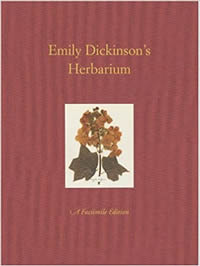 "Emily Dickinson's Herbarium" is a full-size, facsimile of an album of pressed flowers, leaves, and other plant parts created in the 1840s when Dickinson was a student at Amherst Academy. There is no stated purpose or obvious order to this collection, which includes both native plants of western Massachusetts and specimens that could only come from a garden or conservatory. As a traditional herbarium the value is limited, as none of the important collection information (date, exact location, etc.) are recorded.
"Emily Dickinson's Herbarium" is a full-size, facsimile of an album of pressed flowers, leaves, and other plant parts created in the 1840s when Dickinson was a student at Amherst Academy. There is no stated purpose or obvious order to this collection, which includes both native plants of western Massachusetts and specimens that could only come from a garden or conservatory. As a traditional herbarium the value is limited, as none of the important collection information (date, exact location, etc.) are recorded.
Over 400 specimens survive, some accurately labeled by the author using botanical guides of the day, others with descriptive if incorrect Latin binomials (for example, Petunia alba for a white petunia). Others have lost their labels. The Harvard University Herbaria staff has identified nearly all despite numerous challenges. A detailed catalog records all this detective work.
But the value of this book is not as a traditional herbarium. I see it as a piece of history, and of an early glimpse of the life of one of our country's most valued poets. And, if you've ever attempted your own collection of pressed plants, you will appreciate the considerable effort taken not only to produce this book, but also to preserve it for over 160 years.
Accompanying essays document the herbarium's conservation, the history of the family battles over Dickinson's legacy, and securing the Dickinson collection for Harvard. Best is the article by Richard B. Sewall, "Science and the Poet: Emily Dickinson's Herbarium and 'The Clue Divine,'" in which he begins, "Take Emily's Herbarium far enough, and you have her." Perhaps. In any case, he argues for the close connection she found between science and art -- an argument that could be equally well applied to William Bartram.
"Emily Dickinson's Herbarium," because of its size, cannot be checked out, but is available to all to study and view in the Miller Library.
Excerpted from the Summer 2008 Arboretum Bulletin.
Link to this review (permalink)
Wild Flowers of the Undercliff, Isle of Wight by Charlotte Grace O'Brien, 1881
Reviewed by: Rebecca Alexander on 2016-11-05
The Miller Library receives many donations of books each year, and sometimes we open a box and a particular book enchants us. A recent example is a small volume entitled Wild Flowers of the Undercliff, Isle of Wight, published in London in 1881. It is a field guide to a small area of the southern coast of the Isle of Wight, England. The region is prone to landslides and possesses a unique microclimate, as it is protected beneath an escarpment, facing south. The authors, Charlotte O'Brien and C. Parkinson, hoped the book would enable temporary residents of the Undercliff to acquaint themselves with the various plants blooming throughout the year. "As a rule, they are very timid, these 'wildings of Nature,' and recede before the advances of man and his bricks and mortar," and this book seeks to help "seekers after one of the purest of earthly pleasures" [wildflowers] find them.
As a librarian, I have absorbed a concern for 'bibliographic control,' the attention to details that help people find the information they need. I was troubled by the lack of a first name for the co-author, and curious about the note in the preface in which the two authors thank "Miss Parkinson" for her colored drawings [8 plates] that illustrate the book. Our copy of the book was inscribed by M. Parkinson, with a dedication to "Miss Prince." Who were these nameless Parkinsons, I wondered, wanting to give bibliographic credit where it was due.
I asked assistance from a friend who is a gardener and genealogist in England, and she found a reference to an article by David E. Allen (affiliated with the Botanical Society of Britain and Ireland), "C. Parkinson, A mystery Wight Botanist identified," which was published in the 2009 proceedings of the Isle of Wight Natural History & Archaeological Society. We could not obtain a copy, and that made both of us even more eager to solve the mystery.
The initials F.G.S. after Parkinson's name on the book's title page might stand for 'Fellow of the Geological Society,' and that led to a discovery of an obituary for a "Cyril Parkinson" in the Quarterly Journal of the Geological Society of London Vol 26 (1920): "Cyril Parkinson was born at Hesgreave [Hexgreave] Park, near Southwell (Nottinghamshire), and died in London on August 20th, 1919, at the age of 65. During five years' residence in the Isle of Wight (1875-¬80) he made a collection of fossils, which was acquired by the British Museum (Natural History). He became a Fellow of our Society in 1880. He was a member of the Worcester Naturalists' Club, and an occasional contributor to 'Borrow's [Berrow's] Worcester Journal' on natural history subjects. He also contributed articles to various periodicals on natural history, geology, and botany, and brought out a handbook of the Isle of Wight Marine Algae in collaboration with Mrs. O'Brien, of Ventnor."
Now that I had birth and death dates and a first name, I used genealogy resources like Ancestry.com and found that Cyril had a sister Marian who lived with him for a time, and she was undoubtedly the illustrator whose signature is in our copy. Census records indicate that she was a woman of "private means," and this squares with the family's history as landed gentry with their own coat of arms. At the time of the book's publication, the 1881 census lists Cyril as a tile manufacturer living with his unmarried sister Marian in Bournemouth, not terribly distant from the Isle of Wight. Their parents were John and Catherine Parkinson of Southwell, Nottinghamshire.
A review of Wild Flowers of the Undercliff appeared in the October 11, 1901 edition of The British Architect and it makes special note of the illustrations: "There are eleven different species of the orchid tribe growing in the Undercliff, and this guide helps one to find these 'wildings of Nature.' The beautiful coloured drawings were executed by Miss Parkinson."
It is very satisfying to list the full names of the co-author and illustrator in the bibliographic record for this book. I would love to discover whether Marian Parkinson illustrated any other botany books, but that is still a mystery.
Link to this review (permalink)
The Wildlife-Friendly Vegetable Gardener by Tammi Hartung, 2014
Reviewed by: Rebecca Alexander on 2016-09-09
Here's a book on growing edible crops with a unique perspective, that our vegetable gardens can be planned and designed to encourage or at least coexist peacefully with wildlife. For example, you may not want to share your lettuce with slugs and snails, but you can make the garden hospitable to predators that consume mollusks (such as birds, toads, lizards, foxes, and skunks).
Many of the author's recommendations are common-sense organic approaches to gardening, such as starting with the soil: respect the microorganisms and other soil-dwelling life forms by not over-tilling and disturbing soil structure; observe nature in your garden (keep a journal or sketchbook) and get to know the insects—beneficial and nuisance—and their life cycles, and the other creatures who visit regularly or seasonally.
Design elements in a wildlife-friendly edible landscape include a "perennial backbone" of fruiting trees and shrubs (fruiting ornamentals that will attract birds and other animals and dissuade them from eating the fruit you've planted for your own consumption), a water source, and "decoy plants" planted as a border around plants you intend to harvest for yourself. Some of the ideas here require a fair amount of space: not every urban food gardener has room for a hedgerow, or can afford to plant extra (sacrificial!) rows of crops for hungry critters. Still, you may have room for a few ornamental plants that attract pollinators or a few aromatic shrubs and herbs (like curry plant, Helichrysum italicum, or santolina, or lavender) that may discourage browsing by deer and rabbits.
Deer and rabbits are grazers, so they may not wipe out an entire crop in one fell swoop in the way that gorgers (such as raccoons) or hoarders (like squirrels) can. My own garden has become a favorite spot for these creatures, and they do not even wait for fruit to ripen before absconding with it. I was familiar with many of the "scare tactics" and devices the author suggests, but I had not thought of putting rubber snakes around fruit tree branches to intimidate birds, squirrels, and small rodents, or perching fake owls atop poles to ward off nocturnal foragers.
The book concludes with design plans for edible gardens that are aesthetically pleasing, functional, and inviting for humans as well as other living beings.
Link to this review (permalink)
Lemon: A Global History by Toby Sonneman, 2012
Reviewed by: Rebecca Alexander on 2013-11-27
I've always wondered about the warty etrog (citron, or Citrus medica) used as part of the Jewish observance of Sukkot (etrog represents one of The Four Species mentioned in the Biblical description of this festival; the others are palm, myrtle, and willow): what purpose did the fruit serve beyond the ritual, and how was this odd-looking fruit related to lemon? The answers to these and many other citrus-related questions may be found in Toby Sonneman's Lemon: A Global History, a volume in the Edible series from Reaktion Books (2012). It was a surprise to discover the important role of the citron (probably a wild species from northeast India) in the development of a 'citrus culture' that eventually gave rise to the lemon we use for its flavor. Citron, thick-skinned and inedible, was valued for its fragrance (mentioned in a Hindu text from before 800 B.C.E.). Its centuries-old use in Jewish ritual would eventually lead to cultivation in different parts of the world after the fall of Jerusalem in the year 70 C.E., when so many Jews dispersed across North Africa, into the Aegean, Spain, and Italy.
The lemon was probably an ancient natural hybrid, and its route to the Mediterranean is difficult to trace because of the confusion in written and visual depictions: lemons and citrons are hard to distinguish, and common names can be unreliable. Lemons hold an important place in Arab culture, and were also prized in Persia. Because of the lemon's need for water, farmers developed ingenious irrigation canals with stone tiles to regulate and direct water flow, these methods were widely adopted.
The first recipes using lemon appeared in a 12th century Egyptian treatise called On Lemon: Its Drinking and Use by Ibn Jumay, a Jewish physician in the court of Saladin. He devised a way of preserving lemons with salt, and mentions the fruit's medicinal uses for a wide range of conditions. Ibn Jumay's writing was translated, and lemon's culinary and medicinal fame spread.
Other points of interest:
- Lemons were scarce and costly, and therefore a status symbol, in Northern Europe. You will find them in many 17th century Dutch still life paintings.
- Cosimo III de'Medici grew 116 varieties of citrus in his gardens. The name Medici is possibly related to the name for citron, Median apple (Media being the Greek name for ancient Persia).
- It took a long time for sea voyagers to figure it out, but lemons were an essential preventive against scurvy. (If you think about the term 'ascorbic' acid--something which is found in lemons and other citrus--you can see that it is anti-scurvy!) British English does not use 'lemon' in the pejorative sense of American English, perhaps a bow to the fruit's life-saving properties.
- Harvesting lemons is a thorny business but the Meyer lemon has fewer thorns.
This pocket history reaches from antiquity to the present time, and is packed with colorful details and illustrations. You may also want to try making Ibn Jumay's preserved lemons, included along with several other more recent recipes.
Link to this review (permalink)
Dates: A Global History by Nawal Nasrallah, 2011
Reviewed by: Rebecca Alexander on 2013-11-27
 Dates: A Global Historyis another title in the Edible series from Reaktion Books. An unusual aspect of the fruit (technically a berry) of the date palm tree is that it may be harvested at three different stages of ripeness--the ultrasweet dates one usually finds for sale in groceries are at the final stage, when they have sun-dried on the tree and the skin has begun to wrinkle and darken. Dates have been used as a food staple for centuries. Once called 'bread of the desert' and 'cake for the poor,' dates are still considered of vital importance in combating world hunger.
Dates: A Global Historyis another title in the Edible series from Reaktion Books. An unusual aspect of the fruit (technically a berry) of the date palm tree is that it may be harvested at three different stages of ripeness--the ultrasweet dates one usually finds for sale in groceries are at the final stage, when they have sun-dried on the tree and the skin has begun to wrinkle and darken. Dates have been used as a food staple for centuries. Once called 'bread of the desert' and 'cake for the poor,' dates are still considered of vital importance in combating world hunger.
The date palm's botanical name (Phoenix dactylifera) derives from the tree's origins in Phoenicia (now Lebanon, Syria, and Israel), while the species name might refer back to the Semitic roots of the word for palm (dekel in Hebrew, diqla in Aramaic, etc.) or could refer to the finger-like (dactylos) shapes of clusters of fruit, or more: it's shrouded in mystery and confusion, as with so many names. You will also learn of a connection to the firebird or phoenix of myth and legend, which built a nest of cassia twigs and frankincense in the top of a date palm.
Other aspects of the date palm:- Once a full crown of leaves has developed, the trunk does not widen with age; there are no annual growth rings if one cuts a cross-section. Leaves which die off protect the trunk with their bases that remain attached. The tree's roots are fibrous, and secondary roots grow out of the bottom of the trunk. Both a male and female tree are needed to produce fruit. Trees must be hand-pollinated in spring (this has been common knowledge since the days of Mesopotamian agriculture!).
- Even in the days of Pliny the Elder, there were numerous varieties of dates. The ones American consumers will probably recognize are medjool and deglet noor, but there are nightingale's eggs (beidh il-bilbil), khalasa (quintessence), and even an Obama date named for our president.
- Although we mainly think of date palms for their edible uses, the hollowed trunks were made into aqueduct pipes for irrigation, and were used in building (the first mosque in Medina, built in about 630 C.E., was reportedly made of palm trunks, thatched with palm leaves, with prayer mats of woven leaves).
- Indio in Southern California is the date capital of the U.S., and holds an annual date festival.
The book ends with several tempting recipes (sweet ones such as a 13th-century recipe for date syrup, and a personal favorite: a filled cookie called ma'moul, as well as savory uses).
Like the other books in this series, this title includes footnotes, bibliography, and index.
Link to this review (permalink)
Stonescaping by Jan Whitner, 1992
Reviewed by: Brian Thompson on 2014-07-01
Two traits stand out in Jan Kowalczewski Whitner's collected writings: her passion for stonework and her considerable skill at using words to describe a garden. Both are apparent in her first book from 1992, "Stonescaping." Also apparent is her training as an historian as she expertly traces the history of stone in gardens as it has been used in Chinese, Japanese, and European traditions. She then presents simple but engaging descriptions of home-scale gardens that adapt and meld these traditions.
This would be plenty to fill the first book by most authors, but Jan had more to offer. She continued with an extensive practicum on building everything from stone hardscapes to rock gardens and even hypertufa birdbaths. This combination of history, design, and construction is what makes this book so unusual.
One paragraph from the chapter on rock gardens demonstrates this synergy. "If you have a flat site on which you wish to build a rock garden, use a construction technique first developed by ancient Chinese gardeners to introduce different levels to the composition by digging out low areas and then mounding the excavated earth into ridges and plateaus above them. Use half-buried, weathered stones to replicate outcrops, and work from the bottom of the rock garden toward the top."
Excerpted from the Summer 2014 Arboretum Bulletin.
Link to this review (permalink)
Garden Touring in the Pacific Northwest by Jan Whitner, 1993
Reviewed by: Brian Thompson on 2014-07-01
You may wonder why a tour book more than 20 years old would still be useful and of interest. Details such as opening times and admissions are out of date, most of the gardens described have gone through significant changes, and, sadly, some outstanding gardens—like the Berry Botanic Garden in Portland—are gone.
The answer is the quality of the descriptive writing. Jan Kowalczewski Whitner had an ability to bring gardens alive, for example this opening about the Arboretum: "At first glance, it looks simply like a tranquil Northwest woodland garden, but Seattle's Washington Park Arboretum actually contains exotic horticultural treasures around every bend in the path…"
I've read a lot of garden touring books and the layout for many is reminiscent of the Yellow Pages. By contrast, this book is a series of vignettes, stylishly inviting you to keep reading, even if the destination is not on your travel itinerary. Her description of the VanDusen Botanical Garden in Vancouver, British Columbia was an excerpt for the Winter 1992/93 issue of the "Bulletin" and includes such descriptive gems as "…the twisting papery branches of the deciduous hydrangeas show off well against the berried hollies in winter…" or "a magical woods…bordering a shallow lake dotted by uprooted snags that look like drowned bonsais."
Tucked between the major gardens are fascinating bits on minor parks, noteworthy plantings in public places, and private gardens that were—at that time—viewable by the public. If nothing else, this is a walk through garden history, and will leave the reader with a richer sense of our region's gardening heritage.
Excerpted from the Summer 2014 Arboretum Bulletin.
Link to this review (permalink)
A Handbook of the World's Conifers by Aljos Farjon, 2010
Reviewed by: Brian Thompson on 2014-01-01
A Handbook of the World's Conifers, by Aljos Farjon, was published in 2010 and is described by the author as "not a monograph purely for taxonomists. Its content aims at a much wider audience." This is accomplished in part by discussing the ecology, conservation, and uses of all species along with the etymology of the botanical name and vernacular names in local languages. Calling this a handbook diminishes its stature; this is a set of two hefty volumes with entries more typical of an encyclopaedia.
It includes all tropical species (about 200, which accounts for nearly one-third of all known conifers in the world) and an emphasis on description including--despite the author's stated intentions--extensive taxonomic notes. The images and illustrations that are included are of good quality, but are comparatively few and collected on photo pages separated from the related text.
The introduction to "Handbook" is relatively brief, but that's because Farjon regards his 2008 publication, "A Natural History of Conifers," as the real introduction. This is a book to be read cover-to-cover, and is a selection of essays on subjects "sometimes communicated at the coffee table in the staff room of your institute, but that would not have been allowed through by the editor of a scientific journal." This suggests light reading, and the author does show a flair for storytelling, but he also chooses pretty meaty subjects. If you are confused by cladistics, phylogenetic relationships, and other concepts of modern taxonomy and systematics, these terms are explained in language that a lay reader can--with a bit of work--understand.
Excerpted from the Winter 2014 Arboretum Bulletin.
Link to this review (permalink)
Second Nature: Tales from The Montlake Fill by Constance Sidles, 2011
Reviewed by: Brian Thompson on 2012-10-01
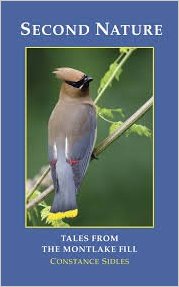 Any reader of Connie Sidles' first book, ("In My Nature: A Birder's Year at the Montlake Fill"--2009) will be delighted to learn she has written and published a second collection of her observations, insights, and quiet life lessons gleaned from her continuing visits to the landfill known officially as the Union Bay Natural Area (UBNA). The style of Second Nature is much like the first, but there are more great close-up photographs of birds, including rarities like a Lazuli Bunting or a Western Scrub-Jay.
Any reader of Connie Sidles' first book, ("In My Nature: A Birder's Year at the Montlake Fill"--2009) will be delighted to learn she has written and published a second collection of her observations, insights, and quiet life lessons gleaned from her continuing visits to the landfill known officially as the Union Bay Natural Area (UBNA). The style of Second Nature is much like the first, but there are more great close-up photographs of birds, including rarities like a Lazuli Bunting or a Western Scrub-Jay.
Excerpted from the Fall 2012 Arboretum Bulletin.
Link to this review (permalink)
The Gossler Guide to the Best Hardy Shrubs by Marjory Gossler, 2009
Reviewed by: Brian Thompson on 2010-10-01
![[The Gossler Guide to the Best Hardy Shrubs] cover](https://depts.washington.edu/hortlib/graphix/gosslerguide.jpg)
I have long enjoyed the folksy but information packed annual catalogs from Gossler Farms Nursery in Springfield, Oregon. It is a great pleasure to now have the first book by the family (mom Marjory and sons Roger and Eric Gossler), The Gossler Guide to the Best Hardy Shrubs. Here the very practical, learned-by-experience descriptions of the catalog are expanded to 350 of their favorites, and all would make a good choice for local gardens.
The highlight of the introductory chapters is "How Not to Kill Your Plants" with lots of advice on how to select, buy, plant, and nurture your new shrubby children. "Consider it an open adoption: you want to know about the birth parents, what neighborhood the plant came from, whether drugs were involved, and so on." This same professional insiders advice continues in the A-Z listings, where I learned that a favorite of mine, Enkianthus perulatus, is rarely found in nurseries "...because it grows too slowly to be profitable."
Excerpted from the Fall 2010 Arboretum Bulletin.
Link to this review (permalink)
Conifers of California by Ronald M. Lanner, 1999
Reviewed by: Brian Thompson on 2012-06-01
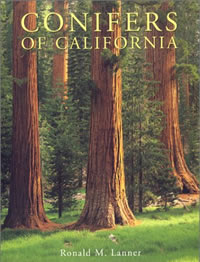 Conifers of California is a delightful introduction to many of our native conifers, as well as the incredible diversity of these cone bearing trees to be found further down the coast. Author Ronald M. Lanner writes what could be best described as a biography of each tree, telling the natural history and the interaction of each with humans and animals. While there are helpful descriptions, (including "At a distance", "Standing beneath it", and "In the hand"), this is not primarily a field guide.
Conifers of California is a delightful introduction to many of our native conifers, as well as the incredible diversity of these cone bearing trees to be found further down the coast. Author Ronald M. Lanner writes what could be best described as a biography of each tree, telling the natural history and the interaction of each with humans and animals. While there are helpful descriptions, (including "At a distance", "Standing beneath it", and "In the hand"), this is not primarily a field guide.
The photographs are excellent, but a bigger visual draw are the botanical paintings by Eugene Otto Walter Murman (1874-1962), which besides being beautiful, clearly show the distinctiveness of the cones, cone scales, seeds, needles in a single bundle, and a growing tip. Adding to the history are quotes by some of the great describers of trees, including Charles Sprague Sargent, John Muir, and, one of my favorites, Donald Culross Peattie.
I'm adding Lanner to this list. His descriptions of the relationship between the Clark's nutcracker and whitebark pine (Pinus albicaulis), or the unusual combinations of factors that lead to the long, long lives of the bristlecone pine (Pinus longaeva), are detailed and lengthy but totally engaging.
Of incense-cedar (Calocedrus decurrens) he explains how forestry practices have led to a population explosion of this tree little valued by the timber industry. This is "...good for those Americans who eschew the use of greasy-inked ballpoint pens, because incense-cedar is the unrivaled champion of available domestic pencilwoods. It may not be so good for those...who must past through thickets...for those thin dead, lower limbs seem always positioned to welt a cheek or poke an unsuspecting eye."
Many of the rarer California conifers can be found in the Arboretum and this book is a good introduction. Look for the Coulter pine (Pinus coulteri) but don't stand under its eight pound cones "with talonlike appendages", while from the Siskiyou Mountains comes the weeping Brewer spruce (Picea breweriana) with "long, dark-foliaged, pendulous branches."
Link to this review (permalink)
Modern Homestead : Grow, Raise, Create by Renee Wilkinson, 2011
Reviewed by: Brian Thompson on 2013-01-01
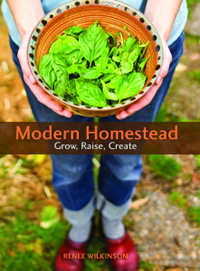 Drawing a parallel with the homesteaders who settled the Oregon frontier, Portland author Renee Wilkinson recognizes that same spirit--and lack of knowledge and experience--in today's pioneers seeking self-sustaining, urban homes. Modern Homestead is not an A-Z encyclopedia of vegetable crops, but instead provides general rules-of-thumb to help you decide what you want, including a sizeable portion of the book that is given over to "Citified Creatures." Preserving your harvest is important, too, but the strongest message is don't work alone. Find some buddies to help you with your homestead, and you will collectively be more innovative and much more successful.
Drawing a parallel with the homesteaders who settled the Oregon frontier, Portland author Renee Wilkinson recognizes that same spirit--and lack of knowledge and experience--in today's pioneers seeking self-sustaining, urban homes. Modern Homestead is not an A-Z encyclopedia of vegetable crops, but instead provides general rules-of-thumb to help you decide what you want, including a sizeable portion of the book that is given over to "Citified Creatures." Preserving your harvest is important, too, but the strongest message is don't work alone. Find some buddies to help you with your homestead, and you will collectively be more innovative and much more successful.
Excerpted from the Winter 2013 Arboretum Bulletin.
Link to this review (permalink)
Growing at the speed of life : a year in the life of my first kitchen garden by Graham Kerr, 2011
Reviewed by: Brian Thompson on 2013-01-01
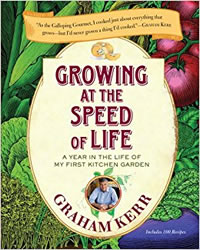 Graham Kerr is an (now local--Mt. Vernon) author who easily includes recipes amongst his recommendations for a kitchen garden, but that's not surprising as he is much better known as a chef (remember the Galloping Gourmet) than a gardener. He has embraced raising his own, healthful food as eagerly as any of his past pursuits. Growing at the Speed of Life is filled with the same enthusiasm--Kerr hasn't lost any of his wit or knack of turning a phrase that made him such a popular television personality in the early 1970s.
Graham Kerr is an (now local--Mt. Vernon) author who easily includes recipes amongst his recommendations for a kitchen garden, but that's not surprising as he is much better known as a chef (remember the Galloping Gourmet) than a gardener. He has embraced raising his own, healthful food as eagerly as any of his past pursuits. Growing at the Speed of Life is filled with the same enthusiasm--Kerr hasn't lost any of his wit or knack of turning a phrase that made him such a popular television personality in the early 1970s.
Excerpted from the Winter 2013 Arboretum Bulletin.
Link to this review (permalink)
Food grown right, in your backyard : a beginner's guide to growing crops at home by Colin McCrate, 2012
Reviewed by: Brian Thompson on 2013-01-01
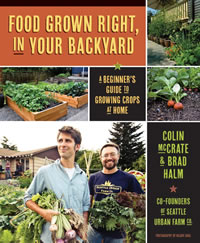 The Seattle based authors of Food Grown Right, in Your Backyard operate a business that gets homeowners started growing their own vegetables (along with herbs, edible flowers, and a few berry fruits) no matter what the challenges may come from inexperience or a difficult site. Colin McCrate and Brad Halm advice is great for beginners, providing a lot of structure and many details while including a teaching element with every entry. For example, by growing radishes you'll learn how to harvest at the right time for the best taste, while planting corn will teach you about wind pollination.
The Seattle based authors of Food Grown Right, in Your Backyard operate a business that gets homeowners started growing their own vegetables (along with herbs, edible flowers, and a few berry fruits) no matter what the challenges may come from inexperience or a difficult site. Colin McCrate and Brad Halm advice is great for beginners, providing a lot of structure and many details while including a teaching element with every entry. For example, by growing radishes you'll learn how to harvest at the right time for the best taste, while planting corn will teach you about wind pollination.
Excerpted from the Winter 2013 Arboretum Bulletin.
Link to this review (permalink)
The Orchard Mason Bee by Brian L. Griffin, 1999
Reviewed by: Brian Thompson on 2013-06-01
 The Orchard Mason Bee by Bellingham author Brian Griffin has long been my go-to book on this subject, but from just across the border in Coquitlam, B.C., is a slightly newer book (2002) on these fascinating garden helpers. "Pollination with Mason Bees" by Margriet Dogterom, takes a bit more of a do-it-yourself approach to creating and maintaining your bee nests, but if you're interested in this subject, I'd recommend referring to both books.
The Orchard Mason Bee by Bellingham author Brian Griffin has long been my go-to book on this subject, but from just across the border in Coquitlam, B.C., is a slightly newer book (2002) on these fascinating garden helpers. "Pollination with Mason Bees" by Margriet Dogterom, takes a bit more of a do-it-yourself approach to creating and maintaining your bee nests, but if you're interested in this subject, I'd recommend referring to both books.
Excerpted from the Summer 2013 Arboretum Bulletin.
Link to this review (permalink)
The gardener's guide to growing hellebores by Graham Rice, 1993
Reviewed by: Tracy Mehlin on 2003-02-05
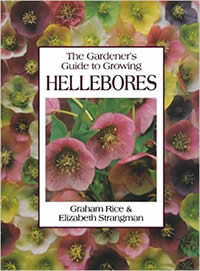 Once you've spent a pretty penny on a new hellebore you will want to protect your investment by learning exactly what they need to thrive. Read The Gardener's Guide to Growing Hellebores by Graham Rice and Elizabeth Strangman for details on cultivation, propagation and essays on hellebore species and hybrids. Color pictures will whet your appetite for more of these delightful winter bloomers.
Once you've spent a pretty penny on a new hellebore you will want to protect your investment by learning exactly what they need to thrive. Read The Gardener's Guide to Growing Hellebores by Graham Rice and Elizabeth Strangman for details on cultivation, propagation and essays on hellebore species and hybrids. Color pictures will whet your appetite for more of these delightful winter bloomers.
Link to this review (permalink)
Gaia's Garden: A Guide To Home-scale Permaculture by Tocy Hemenway, 2009
Reviewed by: Tracy Mehlin on 2009-07-12
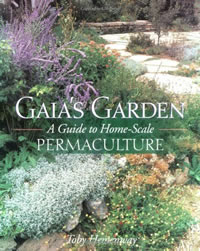 Start healing the planet right in your own backyard! Learn about the principles of ecological garden design, water conservation strategies and supporting wildlife from Toby Hemenway, author of Gaia's Garden: A Guide to Home-Scale Permaculture. Inspiring anecdotes make this book fun to read, while practical advice, illustrated examples and long lists of useful plants help gardeners start transforming their backyards right away.
Start healing the planet right in your own backyard! Learn about the principles of ecological garden design, water conservation strategies and supporting wildlife from Toby Hemenway, author of Gaia's Garden: A Guide to Home-Scale Permaculture. Inspiring anecdotes make this book fun to read, while practical advice, illustrated examples and long lists of useful plants help gardeners start transforming their backyards right away.
Link to this review (permalink)
Recent Bonsai Books Offer Local and Broader Perspectives by multiple authors,
Reviewed by: Ann Hobson on 2017-03-22
These books profile, or are written by, three of the best-known artists in the American bonsai community. Two of the artists are based in the Puget Sound region.
David De Groot was the curator of the Pacific Rim Bonsai Collection (now the Pacific Bonsai Museum) in Federal Way for 25 years, until his retirement in 2014. His book Principles of Bonsai Design is the long-awaited new and expanded version of his 1995 classic Basic Bonsai Design. In his new book the author enlarges on his view that bonsai should be considered as a fine art rather than a horticultural novelty. Interestingly, he was a classical musician before becoming a bonsai practitioner, and is a collector of Asian art. There is little information here about how to train trees as bonsais or how to care for them. The emphasis is on choosing a design that references nature, but is a work of art in its own right. The book has many very clear drawings illustrating his points about proportion, balance, container selection and display options. Photographs show examples of trees in nature that can act as inspirations for bonsai design. This is not the book to page through for awe-inspiring pictures of bonsai, but rather to use as a reference when deciding how to convert starting plant material into an aesthetically-pleasing bonsai.
The second book, Gnarly Branches, Ancient Trees profiles the life and work of Dan Robinson, written by a friend and fellow bonsai enthusiast, Will Hiltz, with additional photography by Victrinia Ridgeway. Dan Robinson is the owner of Elandan Gardens near Bremerton and is known to many local residents through his display gardens at the Seattle Flower and Garden Show. He trained in forestry and worked for many years as a landscaper. This work, and his posting to Korea while serving in the army in the 1960's, inspired an interest in bonsai. His bonsai creations are highly original—naturalistic and free-form, in contrast to the refined style of traditional Japanese bonsai. Many originated with trees collected locally from sites where they were surviving under stress, such as in bogs or on rocky mountain peaks. The appeal of this book is not just the story of a local personality in the bonsai community, but also the beautiful photography of the bonsais he has created.
Finally, Classical Bonsai Art by William N. Valavanis is both an introduction to the basic techniques and design of bonsai, and also a detailed description of the development of 100 of his bonsai creations over several years. The author is the founder of the International Bonsai Arboretum in Rochester, New York, the organizer of several U.S. National Bonsai Exhibitions and a nationally known bonsai teacher. He relates that his interest in bonsai began when he was 11 years old, and continued through his undergraduate studies in ornamental horticulture. He subsequently made many trips to Japan and apprenticed with famous bonsai masters there. The most fascinating aspect of the book is the insight it gives into the way the author plans a design from his starting material and then manipulates the tree to achieve his goal. He documents the process with detailed photographs often spanning periods of up to 30 years. Along the way we see how he tried out various containers or different orientations of the tree. Each sequence ends with a beautifully-staged photograph of the bonsai in its current state.
Link to this review (permalink)
On Guerrilla Gardening: A Handbook for Gardening Without Boundaries by Richard Reynolds, 2008
Reviewed by: Karen Fardal on 2010-06-03
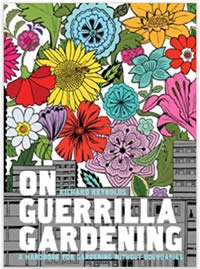 Have you ever passed by a patch of barren, overgrown or otherwise neglected ground and thought, "Someone should plant a garden there?" Richard Reynolds not only did, he established and nurtured a garden at his housing block's previously bleak site. And then he went one better, and founded a movement that has spread worldwide. He fervently believes that gardening should not be the exclusive province of those who own property or manage to score a coveted spot at the P-patch. Instead, he advocates taking over landscape installation and maintenance anywhere it is not already being done, or done well, in public and private spaces alike.
Have you ever passed by a patch of barren, overgrown or otherwise neglected ground and thought, "Someone should plant a garden there?" Richard Reynolds not only did, he established and nurtured a garden at his housing block's previously bleak site. And then he went one better, and founded a movement that has spread worldwide. He fervently believes that gardening should not be the exclusive province of those who own property or manage to score a coveted spot at the P-patch. Instead, he advocates taking over landscape installation and maintenance anywhere it is not already being done, or done well, in public and private spaces alike.
Despite his almost comically serious reliance on the language and "lessons" of actual guerrilla warfare (the book starts out with Che and Mao, shows a photo of seed "bombs" in the shape of a 9mm pistol, and gardeners can sign up at www.guerrillagardening.com to get a "troop number"), Reynolds aims to inspire beautification, so half the book is devoted to practical advice. He addresses the myriad issues an aspiring guerrilla gardener must face, from site selection to plant choice for hardiness and maximum visual impact, the non-availability of water, how to discourage vandalism, and, eventually, perhaps legitimize the established garden.
Of course, humans have been sneaking seeds and plants into spaces that are technically not their own for millennia - Reynolds just gave their actions a name and labeled it a cause.
Link to this review (permalink)
Big Ideas for Northwest Small Gardens by Marty Wingate, 2003
Reviewed by: Tracy Mehlin on 2013-02-19
 A good book to help those of us living on tiny urban lots, or in the even smaller spaces of condominiums and townhouses is Big Ideas for Northwest Small Gardens by Marty Wingate. It guides the city gardener through design consideration and appropriate plant selection. One chapter answers common questions city gardeners have, such as "Can I have a wildlife garden?" Color photography by Jacqueline Koch helps make this informative book a pleasure to read.
A good book to help those of us living on tiny urban lots, or in the even smaller spaces of condominiums and townhouses is Big Ideas for Northwest Small Gardens by Marty Wingate. It guides the city gardener through design consideration and appropriate plant selection. One chapter answers common questions city gardeners have, such as "Can I have a wildlife garden?" Color photography by Jacqueline Koch helps make this informative book a pleasure to read.
Link to this review (permalink)
Beth Chatto's Gravel Garden: Drought-resistant planting through the year by Beth Chatto, 2000
Reviewed by: Tracy Mehlin on 2002-05-05
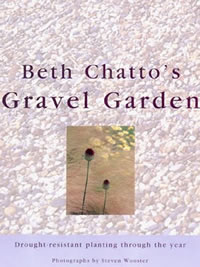 Droughty summers are a mainstay of the Pacific Northwest and water shortages are only going to get worse. Here's a hands-on solution by one of the world's finest gardeners living in a part of England that shares our cool but dry summers. This book requires some work on the reader's part as the plant names are in Latin, but the proven design examples and plant selections are well worth the effort. Excellent photographs hold the reader's attention and clearly say dry is beautiful.
Droughty summers are a mainstay of the Pacific Northwest and water shortages are only going to get worse. Here's a hands-on solution by one of the world's finest gardeners living in a part of England that shares our cool but dry summers. This book requires some work on the reader's part as the plant names are in Latin, but the proven design examples and plant selections are well worth the effort. Excellent photographs hold the reader's attention and clearly say dry is beautiful.
Link to this review (permalink)
Bob Flowerdew's Complete Fruit Book by Bob Flowerdew, 2009
Reviewed by: Tracy Mehlin on 2009-05-05
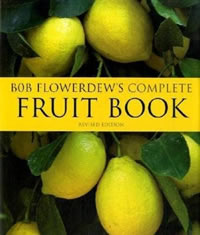 Bob Flowerdew's Complete Fruit Book is worth reading for the recipes and color pictures, even if you don't grow fruit. But if you do, you will find details on history, care and maintenance of the fruit garden instructive and you may be inspired to grow some of the more exotic varieties he describes. Flowerdew writes about normal fruits and nuts from apples to walnuts and everything in between, including unusual fruits like sapodillas and Cornelian cherries.
Bob Flowerdew's Complete Fruit Book is worth reading for the recipes and color pictures, even if you don't grow fruit. But if you do, you will find details on history, care and maintenance of the fruit garden instructive and you may be inspired to grow some of the more exotic varieties he describes. Flowerdew writes about normal fruits and nuts from apples to walnuts and everything in between, including unusual fruits like sapodillas and Cornelian cherries.
Link to this review (permalink)
The Pacific Northwest Garden Tour by Donald Olson, 2014
Reviewed by: Brian Thompson on 2015-04-01
Donald Olson brings extensive experience as a writer of novels, plays, and travel guides along with his passion as a gardener to "The Pacific Northwest Garden Tour." He also brings the zeal of a convert. As a native Minnesotan and world traveler who now lives in Portland, he extols our gardens, our native landscapes, and our climate – yes, even the grey of winter.
The focus is on the three major metropolitan areas of the region: Seattle/Tacoma, Vancouver, B.C., and Portland, and this book is essential to consult for travel to any of these. Even as a nearly life-long Seattle area resident, I discovered there are local treasures awaiting my discovery, including the Evergreen Arboretum and Gardens in Everett and the newer gardens of PowellsWood in Federal Way and Soos Creek in Auburn.
Donald Olson praises the 1915 design by the Olmsted Brothers of the Dunn Gardens in Seattle, noting how the "essential Olmsted aesthetic remains intact" a century later. He notes that reds, purples, and whites were favored in the design, while yellow was "severely frowned upon."
At the end of this Dunn Gardens entry, Olson mentions the newer Curators' Garden, tucked in behind the visitor center and created by co-curators Charles Price and Glen Withey "…using a bright, brilliant palette of plant color decidedly different from the muted tones favored by Olmsted Brothers. There's even yellow."
No trips in the planning? This is still a book easily read cover-to-cover, especially for the history and the author's often witty turns-of-phrase. The Lake Wilderness Arboretum "…rescues old gardens that have lost their owners and moves them phlox, stock, and marrow to new digs at the arboretum" while at the Elisabeth Carey Miller Botanical Garden it was "…Betty who wore the plants in the family."
Like most garden tourists, I enjoy visiting destination nurseries, and many are included by Olson, especially those which have lavish display gardens. Of course, you'll read about the gardens and nurseries you know, but don't skip over the unfamiliar; I'm already thinking of a garden tour in the Portland area to share the author's special passion for several of his recommendations there.
Excerpted from the Spring 2015 Arboretum Bulletin.
Link to this review (permalink)
Walking Washington's Gardens by Angie Narus, 2014
Reviewed by: Brian Thompson on 2015-04-01
Angie Narus brings a tremendous attention to detail in "Walking Washington's Gardens", which is the perfect size for keeping in the car for quick reference. She limits her scope to non-profit or public gardens in Washington, and hopes her book "…encourages more people to not only visit gardens, but also join the effort to preserve them for the enjoyment of future generations."
Each garden narrative is supplemented with a page-length table of all the important facts, including nearby gardens and other attractions to batch together on your tour. She does the best I've seen of any "outsider" in understanding the scope of the University of Washington Botanic Gardens and its spread over two sites, the Washington Park Arboretum and the Center for Urban Horticulture.
The activities of each garden, including annual events, plant sales, and education programs, are well documented, encouraging the reader to think of these gardens as year-round resources. For example, did you know that the Meerkerk Gardens on Whidbey Island offer a class on "fairy house-building" or that the Highline SeaTac Botanical Garden has an annual Ice Cream Social? More immediate questions like "Can I have a picnic?" or "Do you have restrooms?" are also answered—faster than you could ever find on your smart phone.
Excerpted from the Spring 2015 Arboretum Bulletin.
Link to this review (permalink)
Garden On, Vashon! by Karen Dale, 2013
Reviewed by: Brian Thompson on 2015-04-01
"Garden On, Vashon!" is a most intriguing book, and one that's hard to categorize. In some ways, it's a basic gardening book, tailored to the specific soils and microclimates of Vashon and Maury Islands. At the same time, author Karen Dale is telling the history of the islands from a ground-up perspective, beginning with the last ice age, but rapidly moving to the human history of the last 100 years or so.
She easily moves from history to present day, from accounts she has researched to her own style of memoir. The result is charming and recommends this book to readers of regional history as well as gardening. Throughout there are lots of gardening tips, such as when to plant for winter crops and when/how to prune your apples. Or not. "All over the Island these old apple trees stand—carpeted with green moss, shagged over with lichen and mistletoe, into their second century but still bearing fruit."
Vashon is famous for its history of fruit growing, with the Strawberry Festival a fixture of every July. Unfortunately, there are very few strawberries grown on the island anymore, even though the crop was a mainstay in 1909 when the Festival began. Why has this happened? This is a fascinating story, which this book addresses from a historical perspective, but also from the author's empirical efforts to understand the difficulties of growing a good crop of this luscious fruit.
The stories of island nurseries—such as the Beale Greenhouses, once one of the largest producers of cut-flower roses and orchids—are thoroughly documented, as is the Vashon Garden Tour. This latter chapter includes a lot of names, but even a casual read through shows how closely tied the island horticultural community was and still is to Seattle and the rest of the mainland.
Excerpted from the Spring 2015 Arboretum Bulletin.
Link to this review (permalink)
Real Gardens Grow Natives by Eileen Stark, 2014
Reviewed by: Brian Thompson on 2015-04-01
Eileen Stark has a mission: to convince other gardeners of the Pacific Northwest to embrace the native plant palette in designing and planning our gardens. In this pursuit, she is not alone, but "Real Gardens Grow Natives" is one of the most thorough efforts to review the benefits of native plants, combined with basic garden techniques and design principles (she is a landscape designer in Portland).
Stark is a realist, knowing that "…naturalistic, 'real' gardens aren't created overnight, and what will work best for your site may not be apparent right away." She discusses in great detail the ecology and habitat of native plants and the animals they support. While size does matter—"…many wild species have space requirements beyond our wildest dreams…"—she still encourages us to see our gardens, however small, as part of a larger system.
The last half of the book is an encyclopedia of recommended plants, divided by sunlight requirements. Within these categories, the author has organized her list alphabetically, so that a grand fir (Abies grandis) is only two entries before the wee nodding onion (Allium cernuum). While I found this odd at first, it forces you to consider the full range of scale for your garden, and to put nearly as much thought into your groundcovers as the trees and shrubs.
Each entry has the usual cultural requirements of any garden encyclopedia, but here you will also find the environmental benefits of each, especially to wildlife, and other typically associated natives. There is also a handy list of traditional garden plants that these natives could replace, while still providing your desired ornamental impact.
Excerpted from the Spring 2015 Arboretum Bulletin.
Link to this review (permalink)
Common Threads by Sharon Kallis, 2014
Reviewed by: Brian Thompson on 2015-04-01
We all know that invasive, non-native plants are one of the biggest problems for the health of both our native plants and native animals. Sharon Kallis has come up with an interesting approach to dealing with these invaders – weave them into art! She accurately describes her book, "Common Threads," as "…part philosophy and part toolkit."
The toolkit is the easiest part for gardeners. An extensive technique chapter on making baskets, ropes, clothing, and other everyday necessities can be applied to many plants you have on hand. Kallis hopes that readers will apply her techniques to invasive plants wherever they live. Fortunately for us, she lives in Vancouver, B.C., and so her examples are easily found throughout this region.
The philosophy part of "Common Threads" more closely addresses the art community, encouraging the use of local materials as art supplies. She tells how her introduction to gardening was through a Means of Production garden, "…a place that artists could get involved and learn about where their materials came from [and] develop a seasonal awareness to material acquisition." She's also keen that an artist understands that resources are not limitless by asking such questions as, "How many plants does it take to make the six cups of dye you might want for that project?"
A significant part of the book includes interviews with an interesting cross section of artists and managers of public spaces, including some with involvement in both arenas. She encourages artists to think of the value of creating impermanent art using plant materials, as well as the collective good of group art projects in public spaces, and art as a form of honoring and memorializing.
Excerpted from the Spring 2015 Arboretum Bulletin.
Link to this review (permalink)
The Seasoned Gardener by Carolyn Singer, 2012
Reviewed by: Brian Thompson on 2015-04-01
Grass Valley, California is on the outer rim of our region, but the gardening columns Carolyn Singer has written for her local paper are worth knowing about, especially for gardeners in the foothills of the Cascades. "The Seasoned Gardener" is a compilation of those columns and gives advice for areas with lots of rain and a wider temperature range than for those of us close to the Sound.
She is also very experienced with the ravages of deer, and throughout gives ways to manage Bambi. A couple of older titles by Singer, recently acquired by the Miller Library, address this concern more directly. "Deer in My Garden" (2006 – with much of the writing done while the author spent the summer of 2005 in Seattle) led to "Deer in My Garden: Volume 2" (2008), the first with an emphasis on perennials and subshrubs, while the latter considers groundcovers and edgers.
Both are part of "The Yucky Flower Series," honoring the advice of her then 3-year-old grandson: "The deer wouldn't eat yucky flowers!" So that is what she planted and her deer-resistant recommendations are based on her own experience, or those of gardeners who grew trial plants for her, knowing that in the interest of science (or cervid consumer selection), the trial plants might disappear.
While yucky to deer, the selected plants are all quite lovely to gardeners and would make many other recommended plant lists. Most are drought tolerant and adapted to a wide temperature range. Best of all, the author enthusiastically rates the maintenance requirements of most as "EASY!" to "VERY, VERY EASY!" Deer or no deer, these are great garden plants.
Excerpted from the Spring 2015 Arboretum Bulletin.
Link to this review (permalink)
The Maritime Northwest Garden Guide: Planting Calendar for Year-Round Organic Gardening by Carl Elliot, 2005
Reviewed by: Tracy Mehlin on 2005-03-05
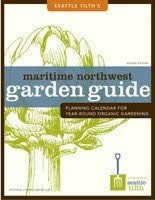 Wondering what's the best time of year to sow your cilantro seeds or plant onion sets? The Maritime Northwest Garden Guide: Planting Calendar for Year-Round Organic Gardening by Seattle Tilth (and multiple authors over the years)defines a complete time-line for sowing a wide range of edibles and flowers. Also included are a number of excellent articles on organic gardening techniques, like summer cover crops and recipes for preventing powdery mildew. Buy online.
Wondering what's the best time of year to sow your cilantro seeds or plant onion sets? The Maritime Northwest Garden Guide: Planting Calendar for Year-Round Organic Gardening by Seattle Tilth (and multiple authors over the years)defines a complete time-line for sowing a wide range of edibles and flowers. Also included are a number of excellent articles on organic gardening techniques, like summer cover crops and recipes for preventing powdery mildew. Buy online.Link to this review (permalink)
Northwest garden style : ideas, designs, and methods for the creative gardener by Jan Kowalczewski Whitner, 1996
Reviewed by: Brian Thompson on 2014-07-01
Jan Kowalczewski Whitner immediately won my approval in "Northwest Garden Style" by explaining her approach to determining the most common landscaping problems for regional gardeners. She reviewed the reference questions received at the Miller Library over a five year period—brilliant! While I haven't done the same exhaustive review of more recent questions to the library, I would expect the list of today would be very similar, making this book still very relevant.
Three of the eight topics she found in her research explore some aspect of what Jan dubbed a "natural garden", specifically creating landscape plans that use native plants, attract wildlife, and conserve water. She begins each topic with examples from local gardens, interviewing the owners and/or designers, and validating the many approaches to reaching the same goal.
As in her other books, both sides of your brain are exercised. The photographs by Linda Quartman Younker suit and expand on the lyrical descriptive prose of the designs very well. Yet each garden is also summarized in a side box with practical elements like topography, soil, lighting, climate, and the impact of surrounding properties; concluding each chapter are businesslike checklists to make sure you achieve your earlier inspirations.
Later chapters delve into the limitations of slopes or very small properties, and with creating special settings using hardscapes or water features. Again, she begins from a very personal perspective: "All gardeners follow different paths to their own, personal epiphanies—those moments of divine illumination…by adding the anarchic element of water to my garden, I was inviting a dash of divine chaos into my soul at the same time."
The only chapter in "Northwest Garden Style" that seems from a different era is on roses, as today this would most likely be replaced by an essay on kitchen gardens or similar. Roses are not my favorite plant, but after reading the description of informal rose garden in Portland, I had a new perspective. Here, "birds find a welcome in this rose garden year-round, where they can nest and forage in tall thickets, dine on choice aphids and slugs in summer, and pick over nutritious rosehips left on the branches in winter."
Excerpted from the Summer 2014 Arboretum Bulletin.
Link to this review (permalink)
Edible Flowers: From Garden to Palate by Cathy Wilkinson, 1995
Reviewed by: Tracy Mehlin on 2007-04-03
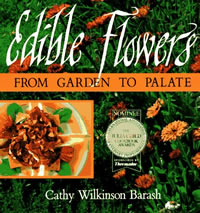 What could be more satisfying than creating a meal with home-grown edible flowers? Author Cathy Wilkinson Barash, in her book Edible Flowers: From Garden to Palate (Fulcrum, 1995) tempts the reader with sweet and savory recipes that feature fresh flowers. Barash goes far beyond a mere sprinkling of nasturtiums in a summer salad to include recipes for lilac chicken, bee balm ice cream and dandelion eggs. For each flower featured the descriptions include botanical, historical and growing information plus color photos of the plant and many of the recipes. The last chapter is perhaps most important because it gives the "ten rules of edible flowers," explaining precautions that must be taken before a person starts eating flowers.
What could be more satisfying than creating a meal with home-grown edible flowers? Author Cathy Wilkinson Barash, in her book Edible Flowers: From Garden to Palate (Fulcrum, 1995) tempts the reader with sweet and savory recipes that feature fresh flowers. Barash goes far beyond a mere sprinkling of nasturtiums in a summer salad to include recipes for lilac chicken, bee balm ice cream and dandelion eggs. For each flower featured the descriptions include botanical, historical and growing information plus color photos of the plant and many of the recipes. The last chapter is perhaps most important because it gives the "ten rules of edible flowers," explaining precautions that must be taken before a person starts eating flowers.
Link to this review (permalink)
Understanding Garden Design by Vanessa Nagel, 2010
Reviewed by: Brian Thompson on 2014-04-01
"Understanding Garden Design," by Portland-based landscape designer Vanessa Gardner Nagel(published in 2010) is so well organized and structured it could easily be used as a textbook, but that may unfortunately imply dullness to what is a very readable and engaging book.
To get the best out of this book, however, the author does expect work on the part of the reader, leading you through the steps that a professional designer would follow. Much of this work is required before you reach the fun part of choosing plants. These aren't discussed until Chapter 8, and then only as elements of structure, using the analogy of punctuation to describe the different selections (some plants are commas, others are parentheses, etc.).
Building with each chapter is a hypothetical garden design using the principles discussed that effectively ties all the concepts together. Even if you decide to hire a designer, this book will help you speak and understand the language and be better at expressing your desires. You will also find very useful a whole chapter on working with contractors.
Excerpted from the Spring 2014 Arboretum Bulletin.
Link to this review (permalink)
The Professional Designer's Guide to Garden Furnishings by Vanessa Nagel, 2013
Reviewed by: Brian Thompson on 2014-04-01
"The Professional Designer's Guide to Garden Furnishings" by Portland Landscape Designer Vanessa Gardner Nagel identifies its primary audience in the title, but there's much here for the discriminating homeowner, too. Especially valuable are the detailed, chapter-length analyses of the many materials that can be used in furnishings, including wood, metal, textiles, and even wicker, glass, or stone. Each chapter includes the industry standards for high quality, finishing options, best maintenance practices, and the sustainability of each material.
The author is at her best when—after carefully presenting a concept—she explains how she will bend the rules. In a section from "Furnishings" on Scale and Proportion, she states, "The old concept of small things in a small space simply isn't true. A couple of large objects in a small space can work splendidly…" and she goes on to explain why this works.
Excerpted from the Spring 2014 Arboretum Bulletin.
Link to this review (permalink)
Gardening in Miniature by Janit Calvo, 2013
Reviewed by: Brian Thompson on 2017-05-17

As a boy, I did not embrace the hobby of making models. Yes, I had a train set, but no desire to create a world of villages, forests, and the like to surround the tracks. Instead, I wanted to be outside in the garden and working with full-sized plants.
This makes me feel a bit inadequate to review "Gardening in Miniature" by Seattleite Janit Calvo. However it turns out that at its heart, this is a gardening book, with sound design advice and cultural tips, just all at 1:12 (one inch = one foot) scale, or even smaller.
"Using the basic garden tenets of anchor point, balance, layers, texture, color, and focal point, you can plan your miniature garden with confidence," the author states encouragingly. Step-by-step, fully planned projects provide lots of guidance for the beginner. I worried that plants would not stay to scale, and indeed they might not, but it's easy to swap plants in and out.
I learned from this that while there is some overlap in principles and techniques between miniature gardening and bonsai, they are largely distinct pursuits. However, they can be combined by making a bonsai the centerpiece of your miniature garden. Will I take up miniature gardening? Probably not. But my eyes have been opened to a whole new—and quite small—world.
Excerpted from the Spring 2014 Arboretum Bulletin.
Link to this review (permalink)
Gardening with stone : using stone features to add mystery, magic, and meaning to your garden by Jan Kowalczewski Whitner, 1999
Reviewed by: Brian Thompson on 2014-07-01
Transforming of perspectives is Jan Kowalczewski Whitner's greatest strength as a writer and I think it is best illustrated in this, her final book. When I first flipped through the pages (with excellent photographs by Linda Quartman Younker), I thought that Jan had traveled throughout Europe, finding centuries old examples of stonework. I was surprised, upon looking at the captions, that almost all of the gardens are in the United States and many were not very old.
I realized, too, that this is not a book to flip through. It is best understood by allowing Jan to lead you through at her pace and in her order. It begins with a review of various garden styles, from formal to natural, from Asian to English cottage gardens. After your attention is firmly fixed on the role stonework plays in these gardens, she shifts to habitats in stone, such as those found in fissures, screes, outcrops, and in wider settings such as a beach or in the desert. Each of these descriptions comes with a recommended list of plants.
Now the real fun begins. The use of stones as art, as tools, or as symbols of spiritual significance goes beyond the garden setting. Or does it? Jan addresses this with, "What significance do today's gardeners find in this legacy of using stone in the landscape for spiritual effects? As the following stone features illustrate, gardeners either adapt the traditions of earlier cultures to their own landscape designs or they carry the spirit, rather than their precise form, into modern pieces."
To finish, Jan features six gardens from across the country, clearly favorites of hers. Mostly beyond the reach of the home gardener, these are realized fantasies of long years or many resources or both. While the following statement was applied to a garden near Miami, it could be used for all, "Because of its sheer size and over-the-top opulence, Vizcaya holds few obvious lessons for the home gardener who contemplates adding a stone feature or two to the back garden, but it remains a compelling place of pilgrimage for those who relish its completely realized vision of stone-driven theatrics."
Jan traveled extensively outside the Pacific Northwest for this book, but throughout she keeps coming back here for examples, and it's fitting that she finishes at home with her last two gardens. The first, the Walker Rock Garden in West Seattle, faces an uncertain future at the time of this writing, but for Jan the later work of Milton Walker "…took on some of the fantastical qualities of structures by the Spanish architect Antonio Gaudi"—high praise, indeed.
Finally, we visit the Ohme Gardens near Wenatchee. This was described in "Garden Touring" as like "a stage set for The Sound of Music", and was used as the cover photograph of that book. In "Gardening with Stone", the description is more thoughtful, "…Ohme Gardens stands as a quintessential example of mountainous, high-desert terrain, whose most characteristic natural features—stone outcrops, wide sloping meadows, and precipitous ravines—have been isolated, highlighted, and arranged to display their best design possibilities."
Summarizing "Gardening with Stone", and the blending of the inspirational and the practical that is found in all of Jan's writing, is the concluding sentence of the Introduction: "Our focus is on those magical, metaphorical stone features that will spark the imagination, as well as on creative design solutions to common landscaping problems."
Excerpted from the Summer 2014 Arboretum Bulletin.
Link to this review (permalink)
Trees live here : the arboretums of America by Susan McDougall, 2013
Reviewed by: Brian Thompson on 2014-10-01
There are very few books specifically dedicated to arboreta, and it is always exciting when a new one is published, but even more exciting when the author lives in Seattle! In "Trees Live Here," Susan McDougall has photographed and written about 33 arboreta throughout the United States, but her "home" arboretum is our very own Washington Park Arboretum. Of course, I turned to that chapter first.
McDougall's camera leads the tour. While the photos showcase the color of Azalea Way in spring and floral highlights from the Witt Winter Garden, the author also favors some of the less well-known collections. The Pinetum and conifers throughout the Arboretum are highlighted, as are the Lindens (Tilia) at the north end. I need to spend more time exploring both of these areas. Elsewhere the subjects may be familiar, but the focus is often on unexpected features such as leaf buds swelling in spring, or close-ups of peeling bark.
The photographer's eye is clear in McDougall's description of the Hybrid Rhododendron Garden. "It is not necessarily a photographer's dream, for though this collection is uniquely-colored and filled with leaves of varying brightness and size, the shades and angles of flowers and stems pose a challenge for the camera."
Tearing myself away from "our" chapter, I found other Pacific Northwest arboreta presented, including the Hoyt Arboretum in Portland, the Peavy Arboretum in Corvallis, and the University of Idaho Arboretum in Moscow. Like in all the chapters, the photographs "…provide a sense of the plants in each arboretum's collections, while the text serves to describe, augment, and inform."
The introductory chapters answer such basic questions as "What is an arboretum?" and "What is their history?" beginning by quoting the Oxford English Dictionary definition, which is simply 'a place for trees.' Her research found the first use of the term to be by John Claudius Loudon in his 1838 encyclopedia "Arboretum et Fruticetum Britannicum", which he translated in his sub-title as "The Trees and Shrubs of Britain." Loudon not only wrote about his interest in trees, he acted upon it, establishing an arboretum in Derby, England. McDougall quotes from his writings to the Town Council, "The Derby Arboretum would not only serve as a source of recreation and instruction to the inhabitants of Derby and its neighborhood, but as a standard of nomenclature…the collection of trees and shrubs being one of the most extensive ever planted, and the whole being named with a degree of correctness scarcely to be found in any other garden." This standard of excellence for an arboretum is still very valid today!
These chapters also tackle more challenging topics such as "Why are they still important?" This is partly answered in the criteria for those arboreta selected for this book, which require an accessioned collection with records of provenance, a staff that is committed to public education, and programs dedicated to outreach, conservation, and research.
As an interesting aside, McDougall did most of her research by train, traveling with her husband, David Biek, with whom she collaborated on a 2007 book on the flora of Mt. Adams. In the spring of 2011 they took Amtrak to all four corners and the middle of the country, visiting 28 arboreta and taking 15,000 photos, timing their arrivals in each location with the coming of spring. Quite an adventure!
Excerpted from the Fall 2014 Arboretum Bulletin.
Link to this review (permalink)
Trees and Shrubs of the Pacific Northwest by Mark Turner, 2014
Reviewed by: Brian Thompson on 2014-10-01
Mark Turner, another gifted photographer, has produced his second Timber Press Field Guide: "Trees & Shrubs of the Pacific Northwest," co-authored with Ellen Kuhlmann. As with his earlier book on the wildflowers of the region (co-authored with Phyllis Gustafson), this is designed for use in the field. Quickly accessible inside the front and back covers are diagrams of the various types of flower parts, leaves, fruits, and seeds. The cover is weather-resistant and a ruler, in both inches and centimeters is handily placed on the back cover.
This guide is also very comprehensive. "While a few readers may gripe about the size and weight of this volume, we chose to err on the side of clarity and include at least a pair of photographs for most of the 568 taxa that have a main entry." The authors also joke that this book was "…our excuse to learn the willows" and sure enough, 28 pages are devoted to this genus that is notoriously difficult to identify at the species level.
The plant descriptions begin with conifers, followed by angiosperms divided by leaf types. There are no keys, but the extra photographs, and their high quality, makes finding plants pretty straightforward. The range maps include all of Washington and Oregon, along with southern British Columbia and northern California, showing all the counties or regional districts where the plant has been documented. The maps are a fascinating study all on their own.
The helpful introduction is only slightly modified from Turner's earlier book, but no matter: it is useful information on how to get the best use out of this book and make the most of your plant exploration. The descriptions of the different ecoregions could make a useful booklet by itself.
Excerpted from the Fall 2014 Arboretum Bulletin.
Link to this review (permalink)
For the love of trees : an arboreal odyssey by Roy Forster, 2010
Reviewed by: Brian Thompson on 2014-10-01
Roy Forster was the first curator and director of the VanDusen Botanical Garden in Vancouver, British Columbia, designing much of the plantings that help make this one of the outstanding botanical gardens in our region. "For the Love of Trees" is in some ways his autobiography, but in a most unusual format, as he uses his own paintings to tell most of that story.
His life has taken him to many locations, providing a wide range of subjects for the "Arboreal Odyssey" of his sub-title. After making comparisons to Homer, he clarifies that "the giants of my story are not fearsome cyclopean monsters but giant redwood trees, ancient venerable pines, and cedars that ascend to the sky."
Many of his subjects are found in another gem of the Vancouver landscape, Stanley Park. While the large conifers are well-represented, my favorite piece is of a particularly large red alder (Alnus rubra), shown in winter time "when the red dormant buds, twigs and catkins show on the naked branches, contrasting with the somber green of the coniferous forest."
Travels have given him many more stories, and the human elements that surround his trees are significant. A hawthorn (Crataegus monogyna) is seen in front of the Glastonbury Tor, the legendary burial place for the Holy Grail. A venerable olive tree (Olea europaea) dwarfs the gates of Les Collettes, the garden of the painter Pierre-Auguste Renoir in southern France.
Throughout, Forster shares his philosophy on trees, which is also his philosophy on life. He describes the profits of his life as a tree planter in public landscapes: "The rewards are of a different kind, consisting mainly in the joy of observing the vigorous growth of the trees over the decades of life, knowing they will be there long after the planter is gone. There is a kind of love in that."
Excerpted from the Fall 2014 Arboretum Bulletin.
Link to this review (permalink)
Beauty by design : inspired gardening in the Pacific Northwest by Bill Terry , 2013
Reviewed by: Brian Thompson on 2014-10-01
Bill Terry and Rosemary Bates both had extensive careers in journalism. It shows in the quality of their interviews in "Beauty by Design," a book about gardeners in a "passionate pursuit of perfection." These profiles capture in just a few pages the personality of their subjects, and the intimate relationship of gardener to garden.
Every chapter reads like a memoir. All would captivate readers within a wide spectrum of artistic interests as many of the subjects are artists in a different medium, including painters, a potter, and poets. Terry and Bates conclude that "these gardeners, indeed all gardeners, are alchemists of nature, art, and artifice."
Some of the eleven individuals or couples profiled are familiar names around Seattle, including Dan Hinkley, Linda Cochrane, George Little, and David Lewis. Most are better known in the gardening circles of southwest British Columbia, but a common theme is they have spent a significant part of their lives in other places, and have been strongly influenced by very different climates, traditions, and histories.
An example is Robin Hopper, a potter living in Metchosin, British Columbia, near Victoria. He describes the fusion in his garden as "Anglo-Japanadian." He is quite familiar with the various styles—he counts five—of Japanese gardening, and acknowledges their impact, but the description of his garden makes it clear that it has its very own style.
"The forest floor is all happy chaos: hostas mingling with hellebores (H. foetidus) in flower, the leaves of hardy cyclamen, bits of iris, various self-seeded woodland wildlings, and, most delightfully, the flowers of the white fawn lily (Erythronium oregonum). Birds and bugs must love this place."
Excerpted from the Fall 2014 Arboretum Bulletin.
Link to this review (permalink)
Back in the garden with Dulcy : the best of The Oregonian garden writer Dulcy Mahar by Ted Mahar, 2013
Reviewed by: Brian Thompson on 2014-10-01
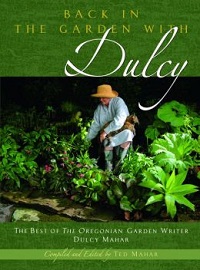
A book that took me totally by surprise is "Back in the Garden with Dulcy", a selection of articles by Dulcy Mahar, who for 22 years wrote a gardening column for The Oregonian in Portland. Clearly, I haven't been paying enough attention to gardening south of the Columbia!
Sadly, Dulcy died in 2011 after a long battle with cancer, but she continued writing up to a few weeks before her death. Fortunately her husband, Ted Mahar, has edited and published a selection of her writings. I am completely charmed by the results.
While Ted is understandably also a fan, I heartedly agree with him when he describes her columns as "…filled with solid advice, warnings, lists, ideas and experiments worth trying, the latest trends, yearnings for a change of season, and more. Whatever the subject, Dulcy's wit glowed through. Pick a week, and you'd likely find a quotable quote."
I would add that she had a knack of reaching out to young or inexperienced gardeners, putting them at ease, urging them not to be afraid to just go for it. She also had a love of animals, especially her cats (although one lucky dog, Hector, gets a lot of press, too). One of her Wagnerian felines is posed with her on the front cover, "helping" in the garden.
An example of her advice: "Make a list so that you can get exactly what you need when you hit the nurseries and plant sales. Oh, I could hardly say that with a straight face. I am practically rolling on the floor, and the cats and Hector the dog are looking askance. Of course, it is excellent advice. But can I follow that advice? Hardly."
Excerpted from the Fall 2014 Arboretum Bulletin.
Link to this review (permalink)
Cornelia Hahn Oberlander : making the modern landscape by Susan Herrington, 2013
Reviewed by: Brian Thompson on 2015-10-01
In the summer of 2013, I visited Vancouver, B.C. Across the street from my hotel was a wonderful urban space, Robson Square; I spent one morning of my precious two days exploring this space. On the same trip I visited the dazzling new visitor center at the VanDusen Botanical Gardens. Although these two projects had widely spaced completion dates (1983 and 2011), the landscape architect for both projects was Cornelia Hahn Oberlander, the subject of a new biography by Susan Herrington.
Oberlander, in addition to being one of the premier landscape architects of our region, has lived a fascinating life – she and her family escaped Nazi Germany shortly before World War II. She graduated from the Harvard Graduate School of Design in 1947, one of the first women to do so, and spent several years of her early career on projects in Philadelphia "…working directly with communities and incorporating their views into the design process."
She and her husband moved permanently to Vancouver in the late 1950s when the city was…"a tiny town…I was able to conquer new ground. In the east I would have never been able to do that." She also became a mother and this perhaps led to a strong interest in the design of playgrounds, using her three children as subjects in her research on what design elements work from a child's perspective. One of her most famous projects was the outdoor play environment at Expo 67 in Montreal, which proved more popular than the more structured, indoor Children's Creative Centre it adjoined.
The Jim Everett Memorial Park on the University of British Columbia campus is one of Oberlander's more recent projects (2002). Intended for the children of students living in nearby university housing, the challenges were significant: liability issues surrounding playgrounds have tightened in recent years and there were already several demands on the space for junior soccer, festivals, and providing pleasing views from the resident's apartments. The results relied on a landscaping – berms, sunken ovals, and small mounds – and limited hardscape, mostly seating areas for the parents, to create the play space. There is no playground equipment. In the planning state, one member of the public declared a "playground without a swing-set, slides, and teeter-totters was un-Canadian!" This same parent, observing her children happily at play in the completed park, commented to Oberlander that this was "not so much a Canadian playground as a human one."
While these small scale projects have been very successful, Oberlander is best known for her larger works, which include subjects in a wide range of settings and climate zones such as the Museum of Anthropology at the University of British Columbia (1976 and 1997), the Legislative Assembly Building in Yellowknife, Northwest Territories (1994), and the courtyard of the New York Times building (2007).
Excerpted from the Fall 2015 Arboretum Bulletin.
Link to this review (permalink)
The landscape architecture of Richard Haag by Thaïsa Way, 2015
Reviewed by: Brian Thompson on 2015-10-01
Richard Haag's life story, as told in "The Landscape Architecture of Richard Haag", a new biography by Thaïsa Way, has many twists and turns before he arrived in the Pacific Northwest. Growing up on a family nursery and farm near Louisville, Kentucky, he studied and was mentored on both coasts and in Midwest, but a two year visit to Japan, as one of the first recipients of a Fulbright scholarship to visit that country, he later claimed "changed my whole life." Here he learned "conservation and economy…[and] working with what you have."
He came to Seattle in 1958 to develop what became the Landscape Architecture Department at the University of Washington. One of the core courses, "Theory and Perception", Haag taught from 1959 to 1996, "using it to articulate his vision of landscape architecture as a melding of the humanities, the arts, and the sciences, a means of stewardship of the earth and its cultures."
He continued his private practice as well, and it is from this that he has his greatest fame today, primarily through two projects. The first, Gas Works Park, is the result of a nearly 20-year public debate. Haag's ability as a designer is almost overshadowed by his ability as a political operator. His techniques for transforming a highly toxic site into a safe place for the public, all with the minimum of soil removal, is also a remarkable. He certainly mastered "working with what you have."
The story of his work at the Bloedel Reserve is not quite as unqualified a success. Some of his designs, most notably the Garden of Planes, were later removed. Other plans were altered despite the notable accolades they received. A thread throughout this book is the challenges Haag faced to be honored in his profession, and—since he is now in his 90s—to see his projects live on as he intended.
Excerpted from the Fall 2015 Arboretum Bulletin.
Link to this review (permalink)
Practical Permaculture by Jessi Bloom, 2015
Reviewed by: Brian Thompson on 2015-10-01
What is Permaculture? The authors of "Practical Permaculture" go to considerable effort to define the evolving meaning of this term, while emphasizing the ethics and principles on which proponents mostly agree. The most important are care for the earth and the care of people.
The introduction continues with the basics of nature and how the earth "works," and then the principles of design, using co-author Jessi Bloom's house as a case study. After that a wide range of topics are considered, and options discussed for sites from the tropics to mild temperate zones – all ways to illustrate how working with our environment instead of against it has proven successful in many different settings and with many different peoples.
The book goes far beyond gardening to consider energy sources and their alternatives, the design and construction of homes, even the processing of human waste – essentially a handbook to all physical aspects of life, including our social structures. Near the end is a list of fifty plants that they consider useful for permaculture landscapes. The list was not what I expected – many of the plants were unfamiliar, especially those that will only thrive or in some cases survive in a tropical climate.
Does this all work? This certainly is a book for generating ideas. I would want to vet the list of the recommended plants carefully. Will they survive? Will they become invasive? If nothing else, this book will make you realize there's much to consider in all of your gardening decisions.
Excerpted from the Fall 2015 Arboretum Bulletin.
Link to this review (permalink)
Native Trees of Western Washington by Kevin Zobrist, 2014
Reviewed by: Brian Thompson on 2015-10-01
"Native Trees of Western Washington" is accurately described in the sub-title as "A Photographic Guide" to trees that can be found west of the Cascade Crest. Each entry has several photos, and include close-ups of all the parts you will need to help with identification.
The author, Kevin Zobrist, is an associate professor of Extension Forestry for Washington State University but grew up and is based in western Washington, and is a Husky by schooling. He leads the WSU extension program in Forestry for the counties of the northern Puget Sound.
While the forestry background is evident in his descriptions of habitats and growth characteristics, his descriptions are well-rounded and engaging. An example is his interest in the production of syrup from bigleaf maples (Acer macrophyllum): "…it produces an exceptional syrup that has rich maple flavor with hints of vanilla and can hold its own against anything the Northeast has to offer."
Excerpted from the Fall 2015 Arboretum Bulletin.
Link to this review (permalink)
Conifers of the Pacific Slope by Michael Edward Michael Edward Kauffmann, 2013
Reviewed by: Brian Thompson on 2015-10-01

If your exploration of native trees takes you on a trip farther afield, consider bringing "Conifers of the Pacific Slope" by Michael Edward Kauffmann. Inspired as a youth by a family visit to the forests of California, this Virginia native returned to work amongst the majestic trees that stirred his younger self. This field guide is a product of that passion and is designed for easy packing.
The scope is all of the native conifer species of the Pacific Coast from northern Baja California to well into British Columbia, and eastward to the Rockies. This includes some very impressive trees. In addition to the familiar Pacific Northwest conifers highlighted in the previous book, there are the many cypresses, junipers, and pines of California plus representatives from a few other genera, including the most impressive of them all, the coast Redwood (Sequoia sempervirens)and giant Sequoia (Sequoiadendron giganteum).
While intended as a field guide, the author provides lots of interesting bits of natural history with his descriptions and some wonderful maps that group related species together, including areas of hybridization. These, along with essays at the front and back, make this a book easily readable from cover-to-cover.
Excerpted from the Fall 2015 Arboretum Bulletin.
Link to this review (permalink)
The Triumph of Seeds by Thor Hanson, 2015
Reviewed by: Brian Thompson on 2015-10-01
Thor Hanson's son Noah became fascinated with seeds at an early age. After reading "The Triumph of Seeds", this is not surprising. Having a father who could tell such compelling stories could make the commonplace imprint on almost any child.
Adults will find Hanson's stories equally engaging. He is an excellent researcher, interweaving the importance of seeds in botany, ecology, and natural history with their significance in both human history and what you are serving for dinner. Why are the seeds of chili peppers hot? What's in it for the coffee bean to be full of caffeine?
These questions have chapter-long answers that introduce a wealth of characters, ranging from Christopher Columbus to Johann Sebastian Bach to a barista in Ballard. Through both history and modern culture the relationships between humans and plants (and animals) are very deep, on-going, and ever-developing.
As his son ages, Hanson involves him in his experiments, but the end results are often about more than just the research. Describing the flight of the seed of a Javan cucumber, with its six inch wing, he recalls, "We watched that seed fly for the simple joy of seeing something beautiful doing what it is meant to do. Standing there together, heads tilted skyward, we laughed and laughed until it disappeared from view—a papery wisp at the edge of visions, still rising."
Excerpted from the Fall 2015 Arboretum Bulletin.
Link to this review (permalink)
Forty-Six Views of Montlake Fill by Constance Sidles, 2014
Reviewed by: Brian Thompson on 2015-10-01
The three books by Constance Sidles about her experiences with birding in the Montlake Fill (also known as the Union Bay Natural Area) have been amongst the most circulated titles from the Miller Library. All are filled with her careful observations of the life in this urban wetland and her philosophical observations to broader life. In "Forty-Six Views of Montlake Fill" she takes a different linguistic approach: poetry.
The poems are distilled observations of this ecosystem throughout the seasons. Hiroko Seki, an accomplished artist of sumi-e, the Japanese style of ink wash or literati painting, has created paintings to accompany each poem, making for a simple but profound combination.
"In the pond,
A female Cinnamon Teal paddles with her babies,
Mother ship followed by seven little tugboats,
Fueled with green algae."
Excerpted from the Fall 2015 Arboretum Bulletin.
Link to this review (permalink)
Wildflowers of Southern Oregon by John Kemper, 2006
Reviewed by: Brian Thompson on 2016-01-01
"Wildflowers of Southern Oregon" was written by John Kemper, a natural history writer who settled in Medford, and recognized the need for a simple guide to the native and naturalized flowers of the region. He's also a skilled photographer, and even though each entry has only a single image, this will work well for most readers. Plants are divided by color and by families within colors.
In the forward, Frank Lane, retired chairman of the Biology Department at Southern Oregon University in Ashland, writes that until this book was written, "there was no book for beginners covering all of Southern Oregon." The author includes a short list of best hikes and to help with planning, each image includes a description of the location and time of year when the photograph was taken.
Excerpted from the Winter 2016 Arboretum Bulletin.
Link to this review (permalink)
Oregon's Best Wildflower Hikes: Southwest Region by Elizabeth L. Horn, 2006
Reviewed by: Brian Thompson on 2016-01-01
The author of three more conventional field guides to wildflowers, Elizabeth L. Horn makes "Oregon's Best Wildflower Hikes: Southwest Region" about hikes to see wildflowers. Throughout she uses only common names, but this helps move you along the trail.
"Both Table Rocks are known for their colorful displays of springtime wildflowers. We hiked the area in both early April and early May and found the wildflowers breathtaking." Lest this sound a little too idyllic, she warns that the trail rating is "strenuous" and that "poison oak and ticks are plentiful, so stay on the trail."
While this is not a field guide, many prominent species are highlighted with close-up photos (all by the author) with interesting facts that make each distinctive. Detailed directions and GPS coordinates will help you find the trailhead while close-up maps will help along the trail.
Excerpted from the Winter 2016 Arboretum Bulletin.
Link to this review (permalink)
Flowers of the Table Rocks by Susan K. MacKinnon, 2014
Reviewed by: Brian Thompson on 2016-01-01
If you have enjoyed a hike up one of the Table Rocks in Southern Oregon, you might be interested in "Flowers of the Table Rocks" by Susan K. MacKinnon. These distinctive geological features in the Rogue River Valley just north of Medford are the likely remnants of a lava flow some seven million years ago. Erosion has left two plateaus standing well above the surrounding valley, and the mostly open and grassy tops are home to over 300 plant species, including 200 wildflowers.
This self-published book primarily speaks through its numerous close-up photos, with enough detail to engage the serious field botanist, but presented by the author/photographer to help anyone who just wants to know the names of the flowers. "I hope that some of the photos will inspire in even the casual reader the sense of awe, excitement and discovery that I experienced in studying the flowers."
Much of the text discusses recent changes in nomenclature and a table in the appendices records these changes. Other tables show times of flowering, common names, and – perhaps the most interesting – the meaning or source of the scientific names.
Excerpted from the Winter 2016 Arboretum Bulletin.
Link to this review (permalink)
Conifer Country by Michael Edward Kauffmann, 2012
Reviewed by: Brian Thompson on 2016-01-01
Michael Edward Kauffmann presents an excellent introduction to the ecology and the geology of the Klamath Mountain region in his book "Conifer Country." He also helped me understand the names of the mountains. The Klamath Mountains include nine distinct sub-ranges beginning in the north with the Umpqua Valley of Oregon and reaching south to the Yolla Bolly Mountains west of Red Bluff, California.
The Siskiyou Mountains sub-range is by far the biggest, and includes all of the Oregon portion of the Klamath Mountains and a sizable part of California, especially closer to the coast. But to complicate matters, the coast has its own, separate mountains (the North Coast Range).
Confused? The maps that Kauffmann has drawn for his book will help tremendously. The main take-away is that this is an extremely rich area for botanists. "The Klamath-Siskiyou Ecoregion is world renowned for being a crossroads for biodiversity, representing one of the most species rich temperate coniferous forests on Earth."
Following this engaging introduction, the author profiles the 35 conifer species of this region, including excellent range maps and photos, along with text that is suitable for the amateur to tell these often similar trees apart. These are followed by a series of suggested hikes, all geared for seeing the most of conifers, the richest being the so-called Miracle Mile. This square mile near Little Duck Lake, about 50 miles west of Mount Shasta, has over 400 vascular plant species including 18 different conifer species!
Excerpted from the Winter 2016 Arboretum Bulletin.
Link to this review (permalink)
Mount Shasta Wildflowers by Jane Cohn, 2015
Reviewed by: Brian Thompson on 2016-01-01
Mount Shasta in Northern California has an interesting flora, and also has one of the most interesting field guides to that flora. "Mount Shasta Wildflowers" uses the watercolor paintings of Edward Stuhl (1887-1984) for its images. Stuhl was born in Budapest and studied art in Austria and Germany before coming to the United States to work in stained glass. He quickly left that pursuit and ended up in northern California where he spent the rest of his long life painting the native flowers that he grew to love.
Four authors combined forces to bring this book into being, it appears primarily to make the Stuhl art collection, housed at California State University Chico, better known. They have also spent considerable effort to make this a worthy field guide by ensuring the taxonomy is up to date, providing a comprehensive and updated plant list for Mount Shasta, and giving guidance – through a series of recommended hikes – to finding each of the subjects.
A detailed visual index, with roughly inch-square reductions of the images arranged by colors, is a charming way to find your way through the book, but my favorite feature is the illustrated glossary with examples of numerous flower and leaf parts all taken from Stuhl's paintings.
Excerpted from the Winter 2016 Arboretum Bulletin.
Link to this review (permalink)
Wildflowers of Northern California's Wine Country & North Coast Ranges by Reny Parker, 2007
Reviewed by: Brian Thompson on 2016-01-01
In defining the Pacific Northwest for the purposes of collecting books for the Miller Library, we have included the portion of California north of the San Francisco Bay area. That inclusion was confirmed for me when visiting Mendocino County this past summer where I especially enjoyed the Mendocino Coast Botanical Garden, which includes an arboretum of conifers and a closed-cone pine forest.
A new book in the Miller Library collection, "Wildflowers of Northern California's Wine Country & North Coast Ranges," highlights the herbaceous natives of this area and fills in another gap in the field guides to our defined region.
Author Reny Parker has solid northwest credentials, having learned to love the outdoors from outings with her father in central Oregon and British Columbia. She is primarily a photographer and this book includes an elegant collection of close up photos arranged by colors and ordered so that species that resemble each other are together for easy comparison. At the end, there is a section for ferns, grasses, and woody plants and maps of "Hot Spots for Wildflowers". Since this book includes Marin, Napa, and Sonoma counties, it would be the perfect companion for a winery tour, giving you a chance to clear your head between tastings.
Excerpted from the Winter 2016 Arboretum Bulletin.
Link to this review (permalink)
Flora of Oregon. Volume 1. by Stephen C. Meyers, 2015
Reviewed by: Brian Thompson on 2016-01-01
The first comprehensive flora of the state of Oregon in over 50 years is in progress with the first of three volumes released this summer. This volume is focused on ferns and their kin, conifers, and monocots, but in addition to the expected and detailed plant descriptions and range maps, there is an excellent introduction to the wide diversity of ecosystems in this state, including the Siskiyou Mountains. "Rare plants in the region are concentrated on serpentinite and dunite and soils derived from these heavy-metal rich rocks. Many of these plants are narrow endemics of only southwestern Oregon, but several have ranges that extend into adjacent northwestern California."
Taking a cue from field guides, "Flora of Oregon" includes a list of recommended places throughout the state to see the greatest number of plant species. Highlights in the Siskiyou Mountains ecoregion include the Table Rocks (although beware, there are geographical features elsewhere in Oregon that also go by this name), the trail through the Rogue River canyon downstream from Grants Pass, and the Mt. Ashland-Siskiyou Peak ridge that "is home to a unique flora that is transitional between California and Oregon floras."
If you'd prefer to explore nature from the comfort of your couch (or one of the comfortable chairs in the Miller Library), you might vicariously go botanizing by reading the biographies of a dozen or so prominent Oregon botanists included in the introduction. I found the story of Lilla Leach (1886-1980) most interesting, especially her discovery of the Siskiyou Mountains endemic and monotypic genus Kalmiopsis leachiana.
In 1930, she was walking ahead of her husband John Leach, who was also an active field botanist, and their pack burros when "'suddenly I beheld a small patch of beautiful, low growing, deep rose-colored plants. Because of their beauty, I started running and dropped to my knees.'" May we all have such exciting moments when exploring for our native plants!
Excerpted from the Winter 2016 Arboretum Bulletin.
Link to this review (permalink)
How Plants Work by Linda Chalker-Scott, 2015
Reviewed by: Brian Thompson on 2016-04-01
Linda Chalker-Scott, the urban horticulturist for Washington State University Extension and author of "How Plants Work," uses both her own experience as a gardener and her education and research as a scientist to look at gardening aesthetically and at the molecular level. The result is very user-friendly way to learn more about how your garden operates from the perspective of the plants (and the bugs and the fungi, etc.).
That's not to say this is easy reading. To get the most out of this book you need to spend time learning some terminology and concepts not typically needed when shopping in your local garden center. This effort will be worthwhile, as the author is very keen to steer you away from using products that will waste your money or damage your plants. She does all of this with humor and good examples which often come from her own garden in Seattle.
Her verbal illustrations are often quite vivid. "Imagine your head is an oxygen atom and your hands are hydrogen atoms, joined by your arms in between (the bonds). Now make a Y with your arms (perhaps performing a molecular version of The Village People's 'YMCA')." After you've stopped singing this ditty, you'll continue reading, but now with a nifty mnemonic to remember the cohesive and adhesive properties of water.
Throughout, Chalker-Scott is enthusiastic about plants. In a world that seems to favor animals, they have done quite well, managing "to use every body part and exploit animals as well as the forces of nature to ensure their spread into every environment." All this is an "amazing accomplishment by a life form that's literally rooted in place."
Excerpted from the Spring 2016 Arboretum Bulletin.
Link to this review (permalink)
Wild Berries of Washington and Oregon by T. Abe Lloyd, 2014
Reviewed by: Brian Thompson on 2016-04-01
There are several books in the Miller Library collection on the wild berries and similar fruit of the native plants of the Pacific Northwest. However, none of these are recent, so it is delightful to add "Wild Berries of Washington and Oregon" to the collection, especially as it is published by Lone Pine, which has a history of publishing excellent field guides with nearly weatherproof covers, for exploring our region.
T. Abe Lloyd and Fiona Hamersley Chambers have created a practical guide to finding, foraging, and savoring the bounty of our local berries. It is a beautiful book, too, with excellent close-up photographs. If these don't make your mouth water, the authors' favorite recipes—and they are both experienced foragers—surely will.
This is not an ethnobotany book, although both of the authors studied with noted ethnobotanist Nancy Turner at the University of Victoria. It is not surprising that the entries in this book include the historical, Native American uses of each fruit, including the management of the prized plants that produce them. This includes more recent adaptations native peoples learned from Europeans, such as this treatment of red-osier dogwood (Cornus sericea) berries: "They were also occasionally stored for winter use, either alone or mashed with sweeter fruits such as serviceberries, and in more modern times with sugar."
Berries are defined here in the popular sense, so included are drupes, pomes, and a few other fruits such as rose hips and juniper "berries". Escaped and invasive berry producing plants such as the several types of introduced blackberries (Rubus species) are given equal treatment since you'll easily find these, and most are tasty. Poisonous berries are carefully described, as are toxic parts of plants bearing edible fruit.
Excerpted from the Spring 2016 Arboretum Bulletin.
Link to this review (permalink)
The Urban Farmer by Curtis Stone, 2016
Reviewed by: Brian Thompson on 2016-04-01
Curtis Stone, the author of "The Urban Farmer", sums up the purpose of his book with a most succinct subtitle: "Growing Food for Profit on Leased and Borrowed Land." This is a manual for a very specific but growing audience. While there are many books to provide inspiration for would-be urban farmers, I don't know of any other that is so detailed in the nuts and bolts of turning this activity into a part- or full-time livelihood.
Gardening advice is mostly on crop rotation and timing, most profitable selections, and the preparation of the harvest for sale – all key points in running a business. Chapters cover market streams, labor, self-promotion, and finance options. The author is clear that there's no point in doing this unless you eventually make a living at it. He also warns to start small, don't overextend yourself, and be realistic about the demands on your time and finances.
Stone lives in Kelowna, British Columbia, a city of 117,000, but he is familiar with the needs and challenges of farming in both larger, denser cities and on what he calls peri-urban land: the larger, often 1-2 acre lots where the suburbs make the transition into the rural countryside. He gives the pros and cons of having all your crops at one site (often not possible in an urban setting), or the more likely model of having multiple plots.
How do you find these plots? He has several suggestions and provides a 10-point checklist to consider for each potential site. Before you begin reviewing the list, he does bend a bit from his typical, matter-of-fact tone by reminding the reader that you as a farmer are valuable. "Approach all negotiations [with landowners] from a place of abundance. You are the one in demand, because you are scarce. Land is abundant!"
Excerpted from the Spring 2016 Arboretum Bulletin.
Link to this review (permalink)
The Natural World of Winnie-the-Pooh by Kathryn Aalto, 2015
Reviewed by: Brian Thompson on 2016-04-01
I picked up "The Natural World of Winnie-the-Pooh", expecting it to be lightweight and quick to read, but instead I became enchanted and deeply engaged. The author, Kathryn Aalto, is a former Pacific Northwest resident (she taught at Western Washington University and Everett Community College) who now lives in England.
Almost any list of the best English books for children will include "Winnie-the-Pooh" (1926) and "The House at Pooh Corner" (1928) by A. A. Milne. Much of the inspiration for the places in these books comes from real places in the Ashdown Forest, southeast of London, and from the nearby farm where Milne and his family—including his son Christopher Robin—lived.
After setting the stage with a biography of Milne and of the illustrator, E. H. Shepard, author Aalto gives a detailed review of the story elements as they relate to real places. Fortunately, these places have been little changed in 90 years: "There are no overt signs pronouncing your arrival in Pooh Country. There are no bright lights or billboards, no £1 carnival rides, no inflatable Eeyores, Owls, or Roos rising and falling in dramatic flair."
The last third of the book is essentially a field guide to the Ashdown Forest, including its natural and cultural history. One thing you learn is that despite the name, there are no ash trees, and much of the land is not forested, but it is a place of considerable biodiversity despite much human intervention over many centuries.
Excerpted from the Spring 2016 Arboretum Bulletin.
Link to this review (permalink)
Mediterranean Landscape Design by Louisa Jones, 2012
Reviewed by: Brian Thompson on 2016-04-01
For those interested in the gardens of Provence or in gardening anywhere along the northern shore of the Mediterranean, the books of Louisa Jones may already be very familiar. She writes in both French and English from her base in southern France. What I learned recently is that she lived in Seattle for many years, teaching literature at the University of Washington.
The Miller Library has seven of the books by this author, mostly on gardens in France, including French vegetable and kitchen gardens. The most recent, "Mediterranean Landscape Design," expands her scope into neighboring countries and focuses on the human influence on the landscape, including many examples that may seem natural, but instead are the results of centuries of human activities with the land.
I found the chapter on clipped greenery particularly enlightening, as I've never fully appreciated the formal gardens I've seen in Mediterranean countries. Jones explains that in this region, the many native, broadleaf evergreens "…are already mounded by wind, drought, sheep, fire and frost." Farmers prune these plants further for windbreaks. "When architects and sculptors then organize them into shapes and masses, topiary and parterres, they are not choosing artifice over nature, the tame versus the wild, but merely going one step further than the farmers into human intervention."
Throughout the book there are many other examples of gardening with nature rather than trying to subdue it. This approach tends to deemphasize flowers, which are often fleeting in this climate, and makes "…no distinction between ornamental and productive gardening." The author emphasizes this point as she thinks that "…Northern European cultures have effectively separated the two."
Excerpted from the Spring 2016 Arboretum Bulletin.
Link to this review (permalink)
Unveiling the Landscape by Teresa Moller, 2014
Reviewed by: Brian Thompson on 2016-04-01
Central Chile is represented by one of the five gardens in Pacific Connections. As garden-related books published in Chile are rare, I decided to review a book (in both English and Spanish) by and about a Chilean landscape architect, Teresa Moller. In this beautifully photographed and oversize (and therefore non-lending) book, I was surprised to find much that reminds me of Mediterranean designs.
"Unveiling the Landscape" extends beyond the central, Mediterranean climate zone to the very stark and extremely dry Atacama Desert in northern Chile, and to Moller's own forest home in the Lakes District of south-central Chile. The projects also range in the original condition of the sites, from nearly pristine, rocky coasts to areas long used for agriculture. In all of these, her designs show respect for the existing environment, whether natural or human-made. Often it takes a careful study of the photographs to discern her work from the original landscape.
I found the most intriguing project to be at Punta Pite, where a pathway begins at the Pacific Ocean, climbs up through rocky cliffs and rough woodlands, and eventually to a park of old cypress trees. Dutch landscape architect Michael Van Gessel described it in this way, "It is obvious that Teresa did not look for variety but simply discovered and displayed the existing variety in the landscape. This she achieved in both a most restrained and at times dramatic way. Landscape scenography at its highest level. The coastal pathway Punta Pite is sheer poetry in stone."
Excerpted from the Spring 2016 Arboretum Bulletin.
Link to this review (permalink)
Plants from the Woods and Forests of Chile by Martin F. Gardner, 2015
Reviewed by: Brian Thompson on 2016-04-01
Books about Chilean gardens and plants are rare, especially in English. So it is particularly exciting to have a new book, this being about the country's native flora. "Plants from the Woods and Forests of Chile" was published by the Royal Botanic Garden Edinburgh and includes 81 exquisite plates of Chilean plants, each with engaging, full page write-ups that include the importance of the plant both to native peoples and in today's culture, its ecological niche and conservation status, and general propagation and cultivation advice.
All of the selections are also quite beautiful, and the botanical artistry is of the finest quality. Many of the plants are familiar, including Arboretum plants such as monkey puzzle tree (Araucaria araucana) and Chilean firebush (Embothrium coccineum). This publication is very much of the quality and in the style (and large size) of the great 18th and 19th century floras and as with those, we keep it in the rare book room of the Miller Library where it is available for viewing by appointment.
Excerpted from the Spring 2016 Arboretum Bulletin.
Link to this review (permalink)
Ginkgo: The Tree That Time Forgot by Peter Crane, 2013
Reviewed by: Brian Thompson on 2016-07-01
Perhaps the most iconic of trees, the ginkgo has long deserved a book of its own. This has also been a long-time goal of Peter Crane, a former director of Kew Gardens, who wrote "Ginkgo: The Tree That Time Forgot." Much of his book discusses the fossil records of the ginkgo, its one time vast range around the globe, and its subsequent diminishing to near extinction.
This story has a link to our region in its reference to the Ginkgo Petrified Forest State Park near Vantage, Washington, which is especially unusual because of the presence of preserved wood. Most fossil sites only have leaves. Even closer to home, ginkgo is the iconic plant for China in the Entry Gardens of Pacific Connections and there is also a fine example at the parking lot entry of the Graham Visitor Center.
The research shows that the genus Ginkgo, now monotypic, once had several species, and several closely related genera. No close relatives are living today. Despite considerable interest in this topic, "…exactly how ginkgo fits into the grand scheme of plant evolution remains elusive."
While these stories are important, Crane is at his best in his accounts of the cultural impacts of this tree on humans. This is perhaps because he and his family lived near the "Old Lion" at Kew, a ginkgo planted in 1761 and considered the oldest in the United Kingdom. There are many specimens that mark temples and other holy places throughout China and Japan, the only places it has survived from antiquity. Since its rediscovery and revival in western cultures, it has also become an important landmark in North America, for example the giant specimen that Frank Lloyd Wright built his home around in Oak Park, Illinois.
The awe this tree inspires is captured in the author's description of Hōryō Ginkgo in northern Honshu in Japan. "It is approached with reverence down an aisle of closely spaced, moss-covered stepping-stones. Local people visit it regularly…they explain the tree's legends to local schoolchildren, and they work to spread word of its importance. This tree was a friend to their grandparents; it will probably also be a friend to their grandchildren."
The ginkgo's role in human lives continues to evolve. The male ginkgo, free of odorous fruit, has become a popular street tree in urban centers throughout the temperate world. Many consider roasted ginkgo nuts to be a delicacy and the seeds have been used in traditional Asian medicine for centuries, despite a low level of toxicity. More recently, and mostly in the West, the leaves have become the focus of potential medicinal benefits, with an extract considered to be a memory enhancer.
Excerpted from the Summer 2016 Arboretum Bulletin.
Link to this review (permalink)
The Genus Betula: A Taxonomic Revision of Birches by Kenneth Ashburner, 2013
Reviewed by: Brian Thompson on 2016-07-01
The Royal Botanic Gardens, Kew have published a series of excellent monographs – in-depth botanical books about a single genus or occasionally a few closely related genera. While all are of high quality (and we have them all in the Miller Library), none match the level of enthusiasm displayed by the authors of "The Genus Betula: A Taxonomic Revision of Birches."
While most monographs are written by intensely academic researchers, one of the co-authors of "Betula" was a garden designer (Kenneth Ashburner), whose passion was for the living trees in a designed setting. His frustration with the confusion in the nursery trade was a driving force in his authoring this book. His co-author, Hugh McAllister, is a more traditional tree botanist (having written an earlier monograph on Sorbus, the mountain ashes), but demonstrates his own passion as he marvels over a genus that spans the colder parts of the northern hemisphere.
The result is a book will serve a wide range of interests. It is excellent for learning more about the many birches in the arboretum (at least 50 known taxa plus many hybrids and unknown species). Each species is described with the expected botanically precision, but there is much, much more, including its ethnobotany and natural history, cultivation techniques, conservation status, and identification guides.
This book is also handy for shopping. Recognizing that buyers are drawn to white-barked saplings leads to a discussion of comparative "whiteness" of selections and the age of achieving whiteness by popular nursery stock. The authors are keen about other colors, too, encouraging the use of copper to orange or even pink colored forms of Betula utilis. The remarkable peeling habits of different species are praised as well, as is the showiness of the catkins and fall color.
One of the best features of these Kew monographs is the uniformly superb illustrations. In addition to high quality photographs and numerous diagrams, paintings by Josephine Hague make "Betula" a very beautiful book, too.
Excerpted from the Summer 2016 Arboretum Bulletin.
Link to this review (permalink)
Hardy Heathers from the Northern Hemisphere by E. Charles Nelson, 2011
Reviewed by: Brian Thompson on 2016-07-01
"Hardy Heathers from the Northern Hemisphere" is one of the monographs in a series published by the Royal Botanic Gardens, Kew. As do the others in this series, this book contains beautiful artwork. Many of the paintings were done by Christabel King, a highly regarded English botanical artist, for a 1980s proposed monograph that was never published. These paintings typically include multiple specimens, in combinations that were chosen for their artistic merit but not always their botanical relationships. Many other illustrations are even more historical, dating back as far as the 16th century.
While this detracts a bit from the overall organization, it does make this book visually rich. In addition to the paintings, there are excellent photographs of habitat and flower close-ups, lots of range maps, and very detailed diagrams – I never knew the tiny bits of a heather or heath could be so fascinating!
Author E. Charles Nelson includes the genera Calluna, Daboecia, and Erica in his broad definition of "heather" and has a great deal of curiosity for the range of forms of his subject and is eloquent in his language: "…gardeners have an ineluctable fascination with the anomalous, even the monstrous and bizarre…" Although he considers his interests to be primarily botanical and historical, there is a lengthy appendix of award-winning cultivars and cultivations notes are liberally sprinkled throughout.
His history is perhaps some of the most interesting. Have you ever wondered if a white heather was lucky? Many have, and Nelson gives a thorough review of the history behind this idea.
Excerpted from the Summer 2016 Arboretum Bulletin.
Link to this review (permalink)
Genus Cyclamen in Science, Cultivation, Art and Culture by Brian Mathew, 2013
Reviewed by: Brian Thompson on 2016-07-01
I have become smitten with Cyclamen. Both C. hederifolium and C. coum have been spreading throughout my sun-dappled and shady garden, providing both brilliant color when most needed and an endlessly fascinating pattern of leaves throughout much of the year. There is a lovely spread of C. coum in the Winter Garden and, as many Arboretum fans may remember, they were also a favorite of long time director Brian Mulligan.
There have been several good growing guides about this genus published over the last 30 years, but none are as monumental as "Genus Cyclamen in Science, Cultivation, Art and Culture" – the title only begins to captures the wide scope of this book. Edited by Brian Mathew, who is well-known for his many books on various bulbs, he does a skillful job of linking together the writing and illustrating skills of over 30 individuals.
Like all good monographs, this is first a superb botanical guide to the many species with highly effective photographs showing habitat and various naturally occurring forms. This is followed by an extensive guide to cultural requirements, both in the garden and the greenhouse, with reports from around the world by major growers and exhibitors.
"Art and Culture" is where this book breaks new ground. The earliest illustration of a cyclamen dates to the 6th century and it has been a popular subject of herbals and botanical books ever since. These images are here in excellent reproductions. This account also provides a surprisingly detailed history of botanical illustration and printing practices in western cultures.
In more modern times, cyclamen can be found decorating many media from pottery to jewelry to decorative cards. Here I discovered that Eugene Kozloff, local author of several books on Pacific Northwest native plants and marine life, is also passionate about cyclamen, and has an extensive collection of cyclamen postage stamps.
Excerpted from the Summer 2016 Arboretum Bulletin.
Link to this review (permalink)
The Organic Seed Grower by John Navazio, 2012
Reviewed by: Brian Thompson on 2016-07-01
If you are already an avid veggie grower, and especially interested in organically grown, open-pollinated varieties, I recommend you read "The Organic Seed Grower" by John Navazio. This is not a beginner's book, but it will build on the experience you have, especially if you decide to save your own seeds.
This is also one of the best books for learning about the biology of vegetable crops. The encyclopedia section is not in the expected alphabetical order but instead is grouped by families, each with an introduction to the broadly shared characteristics within the family. A detailed natural and cultivated history of each plant is included along with the growth habits and reproduction methods (I didn't realize that so many of our favorite vegetables are biennials) with the emphasis, as the title suggests, on growing some plants on for seeds.
Navazio writes for a national audience but he is a local writer, living in Port Townsend, Washington. Many of the examples and photographs are from the region, including those of small scale farmers you may meet at local farmers markets. Some advice is impractical for home gardeners (it's hard to provide a mile of isolation between squash varieties on an urban lot), but reading this book will give you a depth of understanding and greater appreciation of the fascinating plants you are growing for your salads and stir-fry recipes.
Why write a book like this? Navazio sums this up in his introduction: "My hope is that I have been able to deliver this information in a simple enough fashion to be easily understood and used, while at the same time remaining scientifically based...I'll know that I've been successful in this when I see a dog-eared, dusty, and smudged copy of this book on the front seat of a seed farmer's pickup truck."
Excerpted from the Summer 2016 Arboretum Bulletin.
Link to this review (permalink)
Apples of North America by Tom Burford, 2013
Reviewed by: Brian Thompson on 2016-10-01
Tom Burford has a goal to restore the apple to near the diversity and prominence it enjoyed in America during the early 20th century, when one nursery catalog alone listed 17,000 cultivars. He is optimistic that this return to greatness is happening. To further this effort, he has selected 200 varieties that he regards as "apples of the real world" (not the supermarket), to feature in his book "Apples of North America."
The A-Z encyclopedia of these varieties is the heart of the book. All are of American origin. For example, 'Hawaii' was introduced in Sebastopol, California and has a "distinctive pineapple flavor and is exceptionally sweet when grown in western regions."
'Criterion' was introduced in 1973 from Parker, Washington (south of Yakima) and while it does well in our region, in more humid apple growing areas, such as the author's home in Virginia, it does not color well and is more susceptible to diseases. It is noted as being one of the best apples for salads as it does not oxidize quickly after slicing.
Many apples do not store well but are delicious for fresh eating. Others are noted for baking, pie-making, cider-making, or even frying. Some don't look that great. 'Kinnaird's Choice' is mottled red with purple spots, and would like be rejected by most shoppers. However, it was a mainstay during the Great Depression because it was dependable and its good flavor worked well for all purposes.
The book concludes with a section on "Planning and Designing an Orchard", a very detailed look at the cultural needs of apples, from planting, propagation (including rootstocks and grafting), pruning, and dealing with diseases and pests. He even tells you how to properly eat an apple, a "mind-expanding experience." He finds it "…mildly irksome to see someone eating an apple while walking down the street, unaware that a body sense event is happening, and perhaps focusing on something else entirely at the time."
Excerpted from the Fall 2016 Arboretum Bulletin.
Link to this review (permalink)
Apples of Uncommon Character by Rowan Jacobsen, 2014
Reviewed by: Brian Thompson on 2016-10-01
Rowan Jacobsen, the author of "Apples of Uncommon Character," lives in Vermont and is fascinated by apples, but instead of a grower he is primarily an "apple stalker" to use his own term. He credits many professionals for his knowledge, including Tom Burford, author of "Apples of North America," who "helped me see the eternal in the apple tree."
The author's list of favorite varieties, including some that originated outside North America, is the principal part of this book. These include 'Spokane Beauty': "This Brobdingnagian apple is probably the best to hail from Washington State….yet its fame has not spread beyond the Northwest." He notes it may be the largest apple known, but retains its crispness and "…makes wonderfully zippy sweet cider."
Another favorite is 'Hudson's Golden Gem' from Tangent, Oregon (east of Corvallis). He describes this apple as thinking it's a pear in shape, coloring, russeting (freckles on the skin) and "…the intense aromatics. Even the granular texture is pearlike."
Jacobsen is a well-known food author and he particularly enjoys sharing his favorite recipes for apples, and making recommendations on which varieties to use for each (although he also urges the reader to experiment). While I expected a number of desserts, I was surprised to learn that apples can be used in everything from appetizers to salsa to pot pies.
The photographs of each dish will have you drooling, and throughout the photographs of the apple varieties are engaging and distinctive, with some taken at Harmony Orchards in Tieton, Washington.
Excerpted from the Fall 2016 Arboretum Bulletin.
Link to this review (permalink)
Pawpaw by Andrew Moore, 2015
Reviewed by: Brian Thompson on 2016-10-01
Andrew Moore's "Pawpaw" is the result of an individual's love for a favorite fruit. While it is a native small tree to 26 states in the eastern United States, the pawpaw is still unfamiliar to most Americans.
To those who love this fruit, Asimina triloba has been sadly overlooked. The author compares it to the blueberry, another native that was relatively unknown 100 years ago, and was included among the "wild foods that Americans gathered and ate." The blueberry, thanks to the dedicated work of a handful of enthusiasts, has become a mainstay of the American diet. The pawpaw lacked such champions.
Moore writes most of the book like a travelogue, visiting growers and enthusiasts throughout the native range of the pawpaw. You get the impression that but for a few twist of fates, the pawpaw might have come to share the blueberry's popularity. While this is not a culture book, you'll pick up some ideas from the many stories on how to grow your own and even more ideas on how to prepare the fruit for eating.
There are some suggestions that a pawpaw will grow well here, and one Oregon nursery, One Green World in Portland, is listed as a source. If reading this book whets your appetite, you can visit the nursery this fall for variety tastings and pawpaw ice cream!
Excerpted from the Fall 2016 Arboretum Bulletin.
Link to this review (permalink)
The Book of Pears by Joan Morgan, 2015
Reviewed by: Brian Thompson on 2016-10-01
"The Book of Pears" is primarily a meticulous history book. Author Joan Morgan traces the human pursuit and usage of the pear from the empires of Persia, Greece, and Rome to the culinary heights of industrial Europe, especially in Italy, France, England, and Belgium. This British author does not ignore North America, as from the late 19th century on the story of the pear becomes global in scope.
Will this book help you with growing pears? Somewhat, with a brief cultivation section, but better help is found in the extensive directory of varieties, as the choices you need to make will influence your cultural decisions. Do you prefer early fruits which often don't hold so well? Or good keepers that fruit late? Will these pears be used for eating fresh, canning, for cooking, or for making perry (the pear equivalent of cider)?
If you have a tree of unknown variety, another section on pear Identification may help. Presented in a chart, pear varieties are classified by season and by shape, including pyriform, the traditional pear silhouette, although pears come in many shapes. Further identifiers include color (everything from near white to deep red, including flushes of a deeper color), size, and the amount of russeting or spotting.
As any fruit shopper knows, there are pears and then there are Asian pears. The latter is given some consideration in this book. Each type probably developed separately, one in modern day Iran and eastern Turkey, the other in the Yangtze Valley, from two different wild species. There is evidence of hybridization between the two forms as early as the fifth century CE, but this possibly occurred much earlier.
Throughout the book are 40 stunning plates showing varieties of pears, including the fruit, both unripe on the tree and ripe and sliced for eating, along with the fresh leaves and flowers of spring. These works by Elisabeth Dowle are worthy of a folio book on their own, as they would benefit from presentation in a larger size.
This is an excellent book, I only wish it had been printed in a bigger format, partly for the beauty of the plates, and also to make the minutiae of detail, especially in the directory, more readable.
Excerpted from the Fall 2016 Arboretum Bulletin.
Link to this review (permalink)
A Rich Spot of Earth by Peter Hatch, 2012
Reviewed by: Brian Thompson on 2016-10-01
Peter Hatch has been the Director of Gardens and Grounds at Monticello, near Charlottesville, Virginia, since 1977. I find his recently (2012) published "A Rich Spot of Earth" to be the most engaging of the Miller Library's several books on Thomas Jefferson's famous home.
Hatch is a skillful writer, blending much of Jefferson's own words into his narrative. The narrative tells how the former President was enthralled with all matters of gardening, especially of food crops throughout his life, despite his many public duties. He was also deeply involved with the fabric of his local community and region, and seemed to value friendships that did not overlap with his professional career.
Not surprisingly, I found the chapter on gardening books in the presidential library especially interesting. I think all gardeners will find something of value in the discussions on Jefferson's approaches to garden layout, planting methods, soil amending, staking, seed saving, and dealing with pests and weeds – you'll easily forget that your mentor lived roughly 200 years ago.
The second half of the book is subtitled "A Catalog of Selected Monticello Vegetables." Similar to many how-to books on vegetable gardening, this is an evaluation of the many favorite crops grown on the estate, broadly divided by the edible portion of each, including fruits, roots, and leaves. Most of the selections are familiar, but some were used in different ways than we do now, and some the modern reader may find a bit odd.
For example, nasturtiums were grown primarily for their seeds, while the flowers were only a garnish. Jefferson had a passion for sesame (Sesamum indicum), and experimented unsuccessfully with different pressing techniques to produce oil.
Finally, every gardener has his or her favorites, and "Jefferson fussed over his garden asparagus far more than any other vegetable." It was only grown in "in carefully amended beds because this long-lived perennial…was a major investment." I think most gardeners can relate to this type of obsession.
Excerpted from the Fall 2016 Arboretum Bulletin.
Link to this review (permalink)
One Writer's Garden by Susan Haltom, 2011
Reviewed by: Brian Thompson on 2016-10-01
Susan Haltom has written about restoring an historic garden, that of author Eudora Welty in Jackson, Mississippi. Haltom had the advantage of knowing her subject's creator over the last few years of her life, learning that Welty did not want the garden to be "pretentious, inappropriate, or filled with plants chosen for showiness."
The resulting book, "One Writer's Garden," co-written with Jane Roy Brown, is primarily an engaging biography of this 20th century master of novels and short stories set in the American south. Many of her stories have garden or gardening themes, likely inspired by the family garden. The final chapter not only recaps the restoration process, but also brings to light the gardening practices and customs of the garden's heyday in the 1920s through 1940s.
Excerpted from the Fall 2016 Arboretum Bulletin.
Link to this review (permalink)
The Bold Dry Garden by Johanna Silver, 2016
Reviewed by: Brian Thompson on 2017-01-01
Twice in the early aughts, I participated in garden tours to the greater San Francisco area, once in April and once in September. A highlight of both tours was the Ruth Bancroft Garden in Walnut Creek, California. I was delighted to learn recently of a new book capturing and celebrating this garden, and to learn that Ms. Bancroft, whom our group met briefly at age 94, is still with us at 108!
This garden has two distinct personalities, reflecting different periods of its creator's gardening interests. In her childhood she was introduced to bearded iris by neighbors who were experts on these plants. When she had her own house, she developed a huge selection of historical cultivars that were just finishing their bloom during my spring visit. These are carefully maintained on a schedule of digging up one-third of the collection every year to divide and replant. The health of the collection reflected this high level of care.
As an adult, Bancroft became fascinated with succulent plants. Initially this was a collection of small, potted plants maintained near her home. In the 1970s, her husband's removal of a diseased walnut orchard provided three empty acres on their property. Despite losing much of her collection to a freak freeze shortly after planting the garden out, she never looked back.
The results are sublime and I would highly recommend a visit to this garden anytime you are in the area. However, if that's not in the offing, or if you're just back and want a keepsake, I also highly recommend "The Bold Dry Garden" written by Johanna Silver with photographs – many gorgeous photographs – by Marion Brenner.
This book would happily grace any coffee table, but ideally it will be read and cherished and studied – the "signature plants" chapter could be a stand-alone book on succulents. If these plants are not your interest, then read this book for the story of Ruth Bancroft.
At age 63 she started her succulent garden, an untested concept in her climate at the time. She began with plants in gallon-size pots or smaller. At 83 she opened the now-maturing succulent garden to the public, and she continued working in it daily well into her nineties. Hers is a story to keep all of us gardeners going when we're bothered by a few aches and pains!
Excerpted from the Winter 2017 Arboretum Bulletin.
Link to this review (permalink)
Gardening for the Homebrewer by Wendy Tweten, 2015
Reviewed by: Brian Thompson on 2017-01-01
A photograph of a frosty mug of golden ale, surrounded by hop vines and fruit, graces the cover of "Gardening for the Homebrewer." I was immediately intrigued, especially when I learned that authors Wendy Tweten and Debbie Teashon live on the Kitsap Peninsula.
I expected this book to highlight garden-grown additives for your home brewed beer, but it does much more that, advocating growing your own hops, and even your own barley – all in western Washington! According to the enthusiastic authors, there's also no reason not to grow your own pumpkins for Pumpkin Ale or experiment with varying mixtures of herbs, other grains, or perhaps hot peppers or spruce needles to make a brew that is distinctly your own.
Once you master these techniques, move on to making your own wine (using grapes or other fruit), cider, or perry (pear based cider). Each chapter helps with the plant culture, preferred varieties, terminology, the techniques of harvest, curing, and fermentation, and necessary or recommended additives and equipment. A final chapter explores liqueurs with the same enthusiasm found throughout the book: "…chances are if you can grow and eat it, you can turn it into a liqueur." What are you waiting for?
Excerpted from the Winter 2017 Arboretum Bulletin.
Link to this review (permalink)
The Gardens of Jeffrey Bale by Jeffrey Bale, 2010
Reviewed by: Brian Thompson on 2017-01-01
Jeffrey Bale describes "The Gardens of Jeffrey Bale" as his first step in writing the book others have urged him to write. He started with the photographs, which seems appropriate for an artist who creates pathways, steps, walls, and other landscape features using stones and mosaic pebbles. Most images have captions, sometimes extended captions, but this is primarily a photo album of his numerous projects throughout the Pacific Northwest.
He begins with projects for his own house in Eugene, Oregon, where the garden hardscape is a shrine to many spiritual traditions. He describes how "lounging in the garden on dry days is a foretaste of heaven."
While most of his work is in Oregon, visitors to Windcliff Garden of Dan Hinkley and Robert Jones near Indianola, Washington will see his fine work in a fire pit and surrounding terrace. He also built a mosaic over a cistern at Islandwood School on Bainbridge Island, with help from area school children.
Excerpted from the Winter 2017 Arboretum Bulletin.
Link to this review (permalink)
What's Wrong with my Plant by David Deardorff and Kathryn Wadsworth, 2009
Reviewed by: Brian Thompson on 2017-01-01
"What's Wrong with my Plant" is a very unusual book. The first half is a diagnostic flow chart, with many either/or examples of plant problems, effectively illustrated with colored line drawings. Depending on your answer to the first question, you turn to another page for more questions to help you focus in on the exact problem. It's somewhat similar to a taxonomic key for identifying plants.
Once you have reached the end of your investigative journey, you are directed to the relevant section in the second half of the book for a more conventional description of plant problems, including pests and diseases and close-up photographs to confirm your results.
Authors David Deardorff and Kathryn Wadsworth live in Port Townsend and tested their charts with the help of local Master Gardeners. While the book is intended for a broader audience, I think local gardeners will find it particularly relevant.
Excerpted from the Winter 2017 Arboretum Bulletin.
Link to this review (permalink)
High-Yield Vegetable Gardening by Colin McCrate, 2016
Reviewed by: Brian Thompson on 2017-01-01
I reviewed the first book by Colin McCrate and Brad Halm, "Food Grown Right, in Your Backyard," in the Winter 2013 issue of the "Bulletin". This reflected their efforts as the founders of The Seattle Urban Farm Company to encourage people to grow food, no matter what their limitations of space or experience.
Their second book, "High-Yield Vegetable Gardening," addresses a more experienced audience – gardeners who want the maximum yield from their space, no matter how large or small. Their ideas would work throughout most of North America, although here and there it reminds you of its Seattle roots, to the benefit of local readers.
They have selected three real examples (with pseudonyms for the owners) of gardens of varying sizes, one each in an urban, a suburban, and a rural setting, and use these as examples throughout – an effective approach. You'll want to keep this book handy and use it for notes; there are many spaces for you to fill in blanks for your specific climate and harvest needs.
Excerpted from the Winter 2017 Arboretum Bulletin.
Link to this review (permalink)
Mason Bee Revolution by Dave Hunter, 2016
Reviewed by: Brian Thompson on 2017-01-01
Most of the bee books in the Miller Library collection are either guides to keeping honey bees, or field guides to native bees. A new book by Pacific Northwest authors has a different focus – living with bees as an active, vibrant part of your garden.
While this may include European honey bees, the focus is on less well-known native bees. Most of these are solitary bees that do not form hives or make honey, but they are outstanding pollinators. "Mason Bee Revolution" by Dave Hunter and Jill Lightner (both from the Seattle area) emphasizes the encouragement and care of Mason bees for spring pollination, followed by leafcutter bees for the summer.
To these authors, the bees are almost pets. While the care requirements are minimal compared to many other garden tasks, they still are important, and can be a fun and useful way to share bee knowledge with friends and neighbors.
You'll learn that storing your Mason bee cocoons in the refrigerator is an ideal winter home, if you don't mind them sharing the crisper with your salad greens. However, leafcutter bees are best a bit warmer, such as in an unheated garage. Why go to all this trouble? "Pest control is the primary reason for harvesting cocoons. We want our bees to thrive, not just survive, for next season's pollination."
Excerpted from the Winter 2017 Arboretum Bulletin.
Link to this review (permalink)
The Bee-Friendly Garden by Kate Frey, 2016
Reviewed by: Brian Thompson on 2017-01-01
Kate Frey and Gretchen LeBuhn in "The Bee-Friendly Garden" consider all the various types of native bees found in northern California and how to create an inviting environment for them. There is a chapter on recommended bee-friendly plants, both woody and herbaceous, always with an emphasis on natives. There are lists of plants to avoid, including those with double flowers as single, pollen rich flowers have more to offer to pollinators. Thinking from the bee's perspective, you are advised to plant more than single specimens, otherwise they "…may not have enough floral rewards to make it worthwhile."
Providing sufficient nesting options is critical. While the authors briefly cover human-made nests and bee "hotels", they encourage a more passive approach such as using plants that have naturally hollow stems and leaving a few logs around. They recommend leaving some bare patches of ground, free of layers of mulch that are troublesome for bees to dig through. Of course, like all wildlife, your bees need to have a pesticide-free environment.
Excerpted from the Winter 2017 Arboretum Bulletin.
Link to this review (permalink)
Going to Seed by Charles Goodrich, 2010
Reviewed by: Brian Thompson on 2017-01-01
According to his website, Charles Goodrich supported his poetry and other writings with a 25-year career as a professional gardener in Corvallis, Oregon. "Going to Seed" is a fine example of his avocation. Reading through his selection of brief essays, organized by seasons, I'm keenly reminded of the many forms of life we can observe in our gardens. I was struck by this quotation from a selection by Goodrich titled "The Master."
"It's hard to take this bumblebee seriously, with his stubby wings, pudgy thorax, geodesic eyes. When he lifts his ponderous body in flight, he fudges several laws of aerodynamics. If this is how plants get pollinated, it's a wonder the planet survives. Weird, how evolution flirts with absurdity."
Excerpted from the Winter 2017 Arboretum Bulletin.
Link to this review (permalink)
The Carefree Garden by Bill Terry, 2015
Reviewed by: Brian Thompson on 2017-04-01
Upon retirement at age 57, Bill Terry told his friends that he wanted to use his extra time to create the perfect garden. He already had a site. Although at the time he and his wife lived in eastern Canada, they owned property on British Columbia's Sunshine Coast.
"The Carefree Garden" is the story of making that property into a garden. He quickly discovered this wasn't a solo effort. "We should not resist being directed by Nature to some extent. We can let her own a part of the garden, even control a majority share."
"Mother," as he affectionately calls nature, is an equal partner in this story. Typically, she speaks to him through a Steller's jay and she has a lot to say – mostly telling him all the things he's doing wrong.
This whimsy is very engaging and many long-time gardeners will have practiced their own version (I have), but this book is also very practical. Terry is fond of simplicity, concentrating on native plants, starting his plant introductions from seeds, and using only the simple, species forms when introducing exotics. His useful list of ninety-nine perennials that thrive in our climate are almost all species, many of them native.
He concludes that the perfect garden is "…like the end of the rainbow, that never can be reached. I wouldn't know what to do if I did—reach it." I think most avid gardeners would agree.
Excerpted from the Spring 2017 Arboretum Bulletin.
Link to this review (permalink)
A Garden for Life by Mary Greig, 2015
Reviewed by: Brian Thompson on 2017-04-01
In the Winter 1945 issue of the "Bulletin", Else Frye recounts her trip to Royston Nursery on Vancouver Island, a significant journey at that time but with a mecca of rhododendron cultivars and species waiting at the end. "When we came away the car was so full of plants that the botanist husband could not see out of the back window; our suitcase was fastened to the outside and the very last box was firmly planted on my lap!"
In 1936, when the nursery was established, it was an eight-hour trip (about 130 miles) on mostly gravel roads from Victoria to Royston. Under these conditions, the establishment of a destination nursery is hard to imagine, but "A Garden for Life" recounts this engaging story.
The focus is on the lives of Mary and Ted Greig, who established and ran the nursery during its existence from 1936-1966. Many quotations, written at the time by Mary, provide an intimate look at their life. Other sources cite family and close friends from horticultural circles, giving historical insight to the challenges and passions of regional gardeners.
My parents lived on Vancouver Island from 1945 until the early 1950s. Beginning in Nanaimo, they gradually moved up island to the town of Campbell River while my father, an electrical engineer, worked with B. C. Power to install the first electrical infrastructure that connected the many communities with reliable power. For a while, they lived in Comox, very near the Royston Nursery. As renters who moved frequently, my parents did not have an opportunity to establish a garden. I don't know if they knew of the Royston Nursery, but the stories they told of living in that area are very similar to those of Mary Greig. For example, in June 1946 a powerful earthquake (7.3 on the Richter scale) had its epicenter near Comox and Royston. Both my parents and the Greigs were fortunate that their homes sustained only minimal damage, but an estimated 75% of the chimneys in the area were destroyed. My parents joked about the event, mostly remembering how their piano slid from one room, through the doorway to another. Mary Greig had a similar light-hearted reaction. She wrote to family, "What was all the fuss about?"
Although the Greig's nursery closed at the time of Ted's death, the collection lives on at Stanley Park in Vancouver, B.C. Some 4,500 plants were moved there between 1966-1967. Almost 50 years later, Steve Whysall wrote in the August 19, 2013 "Vancouver Sun": "…for avid greenthumbs looking for botanical treasures and keen to see something rare and out of the ordinary, there is nothing in the park like the Ted and Mary Greig Garden."
Mary Greig continued to be active in rhododendron circles into the 1980s and many of the later stories in this book include familiar names from local garden clubs and plant societies. There is even mention of a new library named after Elisabeth C. Miller!
Excerpted from the Spring 2017 Arboretum Bulletin.
Link to this review (permalink)
Design & Build Your Own Rain Gardens for the Pacific Northwest by Zsofia Pasztor, 2017
Reviewed by: Brian Thompson on 2017-04-01
When I first picked up "Design & Build Your Own Rain Gardens for the Pacific Northwest," I immediately turned to the back to look at the recommended plant list. But this list is placed at the end with good reason. It is not the place to start!
Instead, the authors thoughtfully take you through the many considerations that go into a rain garden. First of all, why do we need them in our (supposedly) rainy climate? How do the various areas of our region differ in their rainfall and geological factors? Once that's figured out, there is the human element. What do our various cities, counties, and other government entities think about or allow with rain gardens?
Once you have a handle on these questions, you need to look at your own property. What permits do I need? Whom do I need to notify that I'm digging a big hole? Are there incentive programs in my area for rain gardens? How do I want to incorporate this new major project into my outdoor living space, so that it only positively affects my home and the properties of my neighbors? Finally, what do I actually need to buy from the hardware store and nursery to build and plant a rain garden?
These are many questions, but this book takes you through them systematically and in great detail. Many instructive photographs and building diagrams will help, too. I soon found myself getting intrigued by the process. Building a rain garden is not a simple process to complete over a free weekend, but if you are serious about it, this book will be an excellent resource.
Excerpted from the Spring 2017 Arboretum Bulletin.
Link to this review (permalink)
Japanese Horticulture: Origins and History by Yōtarō Tsukamoto , 2015
Reviewed by: Brian Thompson on 2017-04-01
There are many books in the Miller Library on Japanese gardens and even more on Japanese-style gardens outside of Japan, but very little about the history of Japanese horticultural practices. A new book, "Japanese Horticulture: Origins and History" by Yōtarō Tsukamoto (1912-2005) and John L. Creech (1920-2009), helps fill this gap.
We are very fortunate to have this book at all. Although Tsukamoto and Creech had long planned this collaboration, the manuscript was not completed before their deaths, and it was only through the work of a group of Japanese editors that the book was published in 2015.
The authors begin their study by looking at the rich (over 6,000 species) native flora of Japan, introducing the plant communities by reviewing 26 sites in the national park system. This is an important starting point, as few of the plants used in early Japanese gardens were non-natives. A chapter follows on the iconic plants of Japan, including ornamental cherries, iris, and azaleas, plus a few introduced plants, especially chrysanthemums and peonies.
The book concludes with the long history of visiting horticulturists to Japan, and especially the exchange between that country and the United States, such as the partnership that led to this book. "Among the complexities of Japan/United States relationships, plant have played a singular but often ignored role in fostering a harmonious social environment."
This book is a rare, new treasure in the Miller Library collection, and as such is not available to borrow. However, for all who are interested in the history of Japanese gardening, or perhaps after attending a tea ceremony at Seattle's Japanese Garden, I recommend seeking it out when visiting the library.
Excerpted from the Spring 2017 Arboretum Bulletin.
Link to this review (permalink)
Street Farm by Michael Ableman, 2016
Reviewed by: Brian Thompson on 2017-04-01
Street Farm is not a gardening book, but I'm reviewing it because it has a powerful message of the benefits of gardening, or – more accurately – urban farming, especially for those who do not have much else to bring hope and well-being to their lives. Author Michael Ableman is the co-founder of Sole Food Street Farms, a charitable organization that includes four farms on abandoned lots in downtown Vancouver, B. C. This book is the story of that organization and the people it has hired to become the urban farmers.
The neighborhoods around these farms are not tourist attractions. The author points out that "…while Vancouver's prosperity is celebrated, its concentration of poverty and raw desperation endures in the midst of the polished and the preened."
There are losses on these farms, both of the produce and of the humans who tend the crops, but overall this is a book of hope. Ableman is very clear that this endeavor is not a panacea for the challenges of poverty, mental health diseases, or addictions. He also recognizes his is a position of privilege by always having "…had a place to live and food to eat, and the color of my skin is not black or brown."
Besides the human stories, all gardeners will relate to the challenges of growing plants in less than ideal circumstances, including outsmarting pests, in this case a sophisticated rat population that only chooses the best vegetables. No less interesting is the harvesting and marketing of crops to the more than 30 restaurants and five farmers markets that Sole Food supplies, plus its CSA (Community Supported Agriculture) shares and donations of over $20,000/year to community kitchens.
Excerpted from the Spring 2017 Arboretum Bulletin.
Link to this review (permalink)
Forest Under Story by Nathaniel Brodie, 2016
Reviewed by: Brian Thompson on 2017-04-01
The H. J. Andrews Experimental Forest east of Eugene was established in 1948. At nearly 16,000 acres, it covers the entire Lookout Creek watershed on the west side of the Cascades. The Forest is used to study ecosystems, wildlife, logging practices, and many other natural and human processes in both old-growth and managed forests.
Started in 2003, the Long-Term Ecological Reflections program through Oregon State University sponsors "writers-in-residence" to spend one to two weeks in the Andrews Forest. Collectively, they have "…come to know the forest via the paths laid down in stories, stories told in anecdotes, photographs, essays, and poems, or in hypotheses, data, and graphs."
The founders of this program are ambitious; they expect it to continue for 200 years. Fortunately, as readers, we don't have to wait so long to read the results. Some of the early creativity is now captured in the book "Forest Under Story."
This is a collection of poems, essays, and even field notes. Interspersed sections titled "Ground Work" provide the scientific basis that supports the more artistic writing. The black and white photography of Bob Keefer offers further context. This is a book to savor slowly, with lessons that are applicable to all coastal forests.
Excerpted from the Spring 2017 Arboretum Bulletin.
Link to this review (permalink)
Look Up!: Bird Watching in Your Own Backyard by Annette LeBlanc Cate, 2013
Reviewed by: Priscilla Grundy on 2017-07-01
This looks like a comic book with bird commentary, but it packs a barrelful of information for budding bird watchers. Annette LeBlanc Cate lures young readers with wisecracking robins and sparrows (and people). In the page on A Rainbow of Color, for instance, the European starling explains, "I'm covered with colorful speckles . . . like stars. 'Cuz I'm a STARling. Get it?" Her goal is to encourage young readers to watch carefully, to see details, and to place birds in context. She also urges sketching birds as a way to increase focus and create a personal record. Cate begins the book by saying you don't really need equipment to begin bird watching, and if you want binoculars, they needn't be costly. By mid-book, she suggests it's time for a field guide, and she lists several in the bibliography. So she moves the reader from a boy saying that bird watching "Looks kinda boring" to several pages on rather scientific bird classification at the end. The reader (of any age) who follows the book all the way through will have a solid start on the enjoyment of birding. And if you never go beyond reading the book, you will still have had a good time.
Published in the July 2017 Leaflet Volume 4, Issue 7.
Link to this review (permalink)
Urban Roosts: Where Birds Nest in the City by Barbara Bash, 1990
Reviewed by: Priscilla Grundy on 2017-07-01
After you read this book to a child, go for a walk in the urban landscape and ask, "Where could birds roost?" Children will be eager to look up and around for the kinds of nesting spots described and pictured in Urban Roosts. Barbara Bash has chosen a dozen species and multiple city sites to tell how pigeons, finches, crows, and falcons have adapted to the city, finding tiny but sheltering niches to call home. The colors are soft, mainly pastels, and the bird sketches clearly identifiable. Although this is aimed at the picture book set, adults may find themselves searching for city nests, too, after sharing this book with a child.
Published in the July 2017 Leaflet Volume 4, Issue 7.
Link to this review (permalink)
Phyto: Principles and Resources for Site Remediation and Landscape Design by Kate Kennen, 2015
Reviewed by: Brian Thompson on 2017-07-01
What is phytotechnology? Kate Kennen and Niall Kirkwood define it in part as "the use of vegetation to remediate, contain or prevent contaminants in soils, sediments and groundwater."
How is this done? Kennen and Kirkwood use their new book, Phyto: Principles and Resources for Site Remediation and Landscape Design, to answer this question. They specifically target landscape architects, urban planners, and others who are interested in applying the lessons of the relatively new field of using plants as problem solvers in design, construction, and maintenance.
This book is superbly organized and very detailed, but the reader is not expected to have a deep understanding of the science or engineering of phytotechnology. Instead, the emphasis is on results, particularly on properties that have a significant history of degradation and are in close proximity to urban development, including active industrial, commercial, and residential neighborhoods.
There are many case studies. The examples are typical to any city, but some of the at-risk properties are surprising, and include community gardens and cemeteries – humans have a significant impact on almost any development. Once the hazards of a site are identified, solutions are suggested and clearly illustrated. This excellent book concludes with guides to additional resources and an extensive bibliography.
Published in the July 2017 Leaflet for Scholars Volume 4, Issue 7
Link to this review (permalink)
One City's Wilderness by Marcy Cottrell Houle, 2010
Reviewed by: Brian Thompson on 2017-06-01

Urban forests are rare treasures, and one of the largest in the country is located nearby in Portland, Oregon. Forest Park encompasses over 5,000 acres of second growth forest left mostly to develop naturally since the park was established in 1948.
The third edition (2010) of One City's Wilderness by Marcy Cottrell Houle, now available in the Miller Library, is an excellent introduction to the flora and fauna of Forest Park, along with its history, geology, and topography. Summaries of these topics form the introductory chapters, with highlights found in the extensive descriptions of 29 recommended hikes that follow.
The maps, elevation graphs, and finding aids for these hikes are top-notch. Even from my home in Seattle some 200 miles away, I enjoyed the narrative of these forest adventures located only a few minutes from downtown Portland. As author Houle concludes, "Forest Park's pristine and natural features are what set it apart from all other city parks in the nation. No other urban park in the United States offers anything comparable in quantity or quality."
Forest Park would be an excellent destination for your summer travels. I recommend reading this book to get the most enjoyment from your visit.
Published in the June 2017 Leaflet for Scholars Volume 4, Issue 6.
Link to this review (permalink)
Environmental Horticulture: Science and Management of Green Landcapes by Ross Cameron, 2016
Reviewed by: Brian Thompson on 2017-05-01

This book covers many topics, beginning with the value of green spaces for human well-being and biodiversity. Many types of plantings are considered, ranging from trees and shrubs to bedding plants, and including formal settings and semi-natural grasslands. Even plantings as diverse as lawns or sports turf and green roofs or rain gardens are studied with the same depth of research as other types.
The authors define Environmental Horticulture as "…the subset of horticulture that is concerned with the use and management of plants in public and semi-public environments." They discuss how this term is nearly the equivalent of "urban horticulture" or "landscape horticulture" with the difference uses reflecting national preferences. "Urban horticulture," for example, hasn't caught on as a descriptor in Great Britain.
The authors are on the faculty of the Department of Landscape at the University of Sheffield in England. Although some of the terminology is distinctly British, much of the discussion is based on North American research. One of the most valuable assets of this book are the references, which include many American sources.
Published in the May 2017 Leaflet for Scholars Volume 4, Issue 5.
Link to this review (permalink)
Seeds on Ice by Cary Fowler, 2016
Reviewed by: Brian Thompson on 2017-03-01
In this morning's edition of "The Seattle Times" (February 24, 2017), I was interested to see an Associated Press article by Matti Huuhtanen about an "Arctic 'doomsday' seed vault." This refers to the Svalbard Global Seed Vault that is also the subject of a new book in the Miller Library, Seeds on Ice.
The Miller Seed Vault, located in the Douglas Research Conservatory, is the largest of its kind in the Pacific Northwest and preserves more than 320 rare plant species from Washington. By comparison, the Svalbard Vault has over 4,000 species of food or agriculture crops from around the world. For most species, the vault also protects many, many selected varieties.
This book tells the short history (it opened in 2008) of the Svalbard Vault, its operations, and its location in the far north of Norway (with many stark and beautiful photographs). It also tells the chilling story of its first withdrawal by an agricultural research institution in Syria, that fortunately sent seeds to Svalbard just before hostilities erupted in that country. Fortunately, those withdrawn seeds are now being grown outside of Syria to replenish the original stock.
Published in the March 2017 Leaflet for Scholars Volume 4, Issue 3.
Link to this review (permalink)
Snowdrop by Gail Harland Harland, 2016
Reviewed by: Brian Thompson on 2017-02-01
A few months ago, when I was considering potential books for the Miller Library, my first reaction to Snowdrop by Gail Harland was, "Oh no, we don't need another book on snowdrops!"
I was wrong. This is an excellent addition to the library and is quite different from our several other titles on the genus Galanthus. It is part of the Reaktion Books Botanical series of books (we have many in the series) which are uniform in their ability to bring a fresh prospective to many garden subjects already well recounted by others.
These other authors provide extensive descriptions of the hundreds of snowdrop varieties that eager galanthophiles will snap up, while this book is more interested in the passion that drives such collectors. It is also a wonderful history of the role these early spring flowers have played in culture, including art, literature, and music.
For example, do you remember the white kitten in Through the Looking Glass and What Alice Found There? Yes, that was Snowdrop, who later became the White Queen. Did you know that earliest English translations of Schneewittchen by the Brothers Grimm was Snow-Drop? It was only after the Walt Disney animation of the same story that we came to know the heroine as Snow White.
For these stories and many others, this is a delightful book to read especially during these late, cold days of winter. Moreover, if you hurry, you can check out Snowdrop while its eponymous flower is still in bloom in your garden!
Published in the February 2017 Leaflet Volume 4, Issue 2.
Link to this review (permalink)
Urban Tree Management by Andreas Roloff, 2016
Reviewed by: Brian Thompson on 2017-02-01
In the opening chapter of Urban Tree Management, editor Andreas Roloff introduces the common problems associated with trees growing in the public spaces of cities. He quickly dismisses these by concluding: "…the positive aspects are always likely to prevail. The occasional inconvenience caused by trees should therefore be tolerated."
This no-nonsense approach is typical of this collection of essays by numerous German experts that Roloff, the chair of Forest Botany at Dresden University of Technology, has collected. Of course – the authors would agree – trees are essential to cities!
While this attitude may represent an especially German viewpoint, I believe it will resonate with local arborists and others who care for the trees in city landscapes. In later chapters, the problems the editor initially presents, and many more, are addressed pragmatically and in considerable detail.
The result is an excellent reference book. All aspects of tree health, maintenance, and selection are considered. Potential issues with governing bodies and conflicts with human activities are discussed. The educational, social, and public health benefits of urban trees are championed.
This book is somewhat rare in this country, so is for library use only. However, each chapter includes an extensive list of references, most in English, and many that are readily available in print or online. For another positive review and perspective on the value of this book, see the article by Julian Dunster in the Summer 2016 issue of Pacific Northwest Trees. It's available in the library, or online via the Pacific Northwest International Society of Arboriculture website.
Published in the February 2017 Leaflet for Scholars Volume 4, Issue 2.
Link to this review (permalink)
Native Plants of the Southeast by Larry Mellichamp Mellichamp, 2014
Reviewed by: Brian Thompson on 2017-01-01
In the spring of 2014, I visited the North Carolina Botanical Garden in Chapel Hill, NC. I was delighted by this extensive collection of herbaceous and woody plants mostly native to the southeastern United States. Many of these plants, or their close relatives, can thrive in our Pacific Northwest gardens.
These are featured in a book that was published later in 2014: Native Plants of the Southeast. Author Larry Mellichamp is the retired director of the botanical garden at the Charlotte campus of the University of North Carolina and has considerable experience with plants throughout the temperate southeast.
This book is much more than a field guide. Each plant is evaluated for garden cultivation. An extensive introduction discusses the merits and challenges of using native plants in a landscape, with principles that would be applicable in our region. The plant encyclopedia is interspersed with essays on broad groupings of plants with an emphasis on garden adaptability.
If this book sparks your interest in this region, consider visiting! The University of Washington Botanic Gardens is leading a trip to Savannah, Georgia and Charleston, South Carolina this coming March. All the details are online, but hurry – reservations must be received by January 19.
Published in the January 2017 Leaflet Volume 4, Issue 1.
Link to this review (permalink)
Let Your Kids Go Wild Outside by Fiona Bird, 2016
Reviewed by: Dorothy Crandell on 2017-10-04
 Fiona Bird is a true champion of appreciating the wild outside world. Her work inspires deeply breathing fresh air, opening up the mind, and enjoying the excitement and mystery of the world we live in, starting early in life. Let Your Kids Go Wild Outside: Creative Ways to Help Children Discover Nature and Enjoy the Great Outdoors encourages children to appreciate their countryside. This Scottish author writes with strong feeling as a mother of six: "With encouragement a child will develop a personal relationship with our natural world, one that stretches way beyond facts assimilated in a classroom."
Fiona Bird is a true champion of appreciating the wild outside world. Her work inspires deeply breathing fresh air, opening up the mind, and enjoying the excitement and mystery of the world we live in, starting early in life. Let Your Kids Go Wild Outside: Creative Ways to Help Children Discover Nature and Enjoy the Great Outdoors encourages children to appreciate their countryside. This Scottish author writes with strong feeling as a mother of six: "With encouragement a child will develop a personal relationship with our natural world, one that stretches way beyond facts assimilated in a classroom."
The introduction of the book emphasizes the value of a mentor and highlights the importance of the environment. Chapters include: Into the Woods; Meadows, Hedgerows, and Hills; Seashore; Water and Wetlands; and My Wild Garden and Kitchen. Each chapter describes and explains the particular environment and the wild plants and animal treasures that can be discovered there. Activity suggestions are rich exercises that are realistic, local, and impress all the senses of young citizen naturalists – blossoming conservationists.
Published in the October 2017 Leaflet Volume 4, Issue 10
Link to this review (permalink)
Fronds and Anemones: Essays on Gardening on Nature by William Allan Plummer, 2017
Reviewed by: Brian Thompson on 2017-10-05
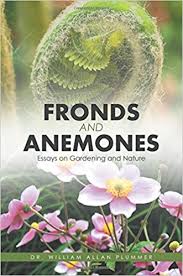 With fronds like these, who needs anemones? This old horticultural quip inspired the title Fronds and Anemones, a book of essays by William Allan Plummer. In his preface he warns, "I am an incorrigible punster, for which I make no apology."
With fronds like these, who needs anemones? This old horticultural quip inspired the title Fronds and Anemones, a book of essays by William Allan Plummer. In his preface he warns, "I am an incorrigible punster, for which I make no apology."
Fun aside, these collected essays reveal the author as a keen and skilled observer of the native birds and wildflowers around his home in upstate New York. He also reflects on his discoveries as an avid gardener, with a particular interest in ferns.
This latter interest led him to join the Hardy Fern Foundation. In the summer of 2003, this organization, along with the British Pteridological Society, sponsored a "Best of the West Fern Excursion" to explore both the gardening and natural attractions found in Washington State. The emphasis, of course, was on those sites rich in ferns.
The resulting essays, which form a significant part of this book, make an outstanding travelogue to some of the best gardens of the region. These include public gardens such as the Elisabeth C. Miller Botanical Garden and the Rhododendron Species Botanical Garden, but many private gardens are featured, too.
These travel stories were originally published in the Hardy Fern Foundation Quarterly, Volume 14, No. 1 and 2 (Winter and Spring 2004). Those issues are available in the Miller Library, but I recommend reading Plummer's writings in the context of his other fine work found in this book.
Published in the October 2017 Leaflet Volume 4, Issue 10
Link to this review (permalink)
The Lord Treasurer of Botany: Sir James Edward Smith and the Linnaean Collections by Tom Kennett, 2016
Reviewed by: Priscilla Grundy on 2017-10-06
James Smith was a lion of the study of botany in 18th century England, when botanizing became a popular activity for both women and men, and the study first entered English university curricula. This biography aims to bring Smith's accomplishments to twenty-first century attention. Son of a Norwich woolen draper, Smith was smitten with botany at an early age. His astounding accomplishment was to purchase all the botanical specimen collections and manuscripts of Carl Linnaeus, the great Swedish botanist, when Smith was only 25. Then he parlayed this coup into a career in botany which involved a vast output of books and papers, plus hundreds of public and university lectures. And he helped found the Linnaean Society in London, which to this day houses those collections.
Read from cover to cover, The Lord Treasurer of Botany offers a winsome experience that includes social striving, amazing luck, decades of incredibly hard work, and introductions to multiple English and Continental botanists, most notably Sir Joseph Banks, an early mentor of Smith's. The Miller Library copy is a reference edition, which means it must be read in the library, so reading cover to cover would require remarkable persistence. Here are some suggestions for shorter activities: If you have 15 minutes, do look at the photographs. This is a beautifully produced book, and the colored prints of plants, though few, are wonderful, as are the portraits and architectural drawings.
If you are a student of early Flora, start with the index and turn to the numerous discussions of books on mostly British plants. The book includes many by other authors, as well as Smith's.
If you want a sample of the biographical narrative, the opening chapter, "Roots – The Early Life of James Edward Smith," and the second, "London – the Sale of the Century," on buying Linnaeus's collections, are good starts.
None of these shorter stays will give you the ups and downs, the trials of health, the strained generosity of a father who wanted James to earn his own living (which he eventually did), and the long friendships with fellow botanists that the book has to offer. Perhaps they will encourage you to keep coming back for it all.
Published in the October 2017 Leaflet for Scholars Volume 4, Issue 10
Link to this review (permalink)
Hey Kids! Out the Door, Let's Explore by Rhoda Redleaf, 2017
Reviewed by: Dorothy Crandell on 2017-10-26
Editor's note: An emergent curriculum builds on the interests of students, developing as they learn. Rather than being entirely set in advance, emergent curricula grow naturally from the chosen environment (indoor or outdoor), the curiosity of children, and the instructor's knowledge and experience.
A good walk stimulates both mind and body and provides the invigorating theme and energizing structure of Hey Kids! Out the Door, Let's Explore by Rhoda Redleaf. Walking is free, easy, and can be done almost anywhere. The walks are grouped into three categories: Nature Walks, Community Walks, and Concept Walks. Nature Walks include Cold Day, Windy Day, Trees Walk, and more. Community Walks can be Hardware Store Walk, Market Walk, or other walks in the neighborhood. Concept Walks might be What's It Made Of? Walk, Color Walk, Light and Shadow Walk, as examples. Redleaf includes appendices to help teachers organize the excursions.
At the early childhood level, Rhoda Redleaf's approach is emergent curriculum, with an emphasis on human relationships and language development while exploring common everyday experiences that are engaging and meaningful to children. "The most important learning task of young children remains constructing their own knowledge to make sense of the world. You, the adults in their world, provide the bridges from the unknown to the known," writes Redleaf.
The book is full of ideas to explore and to build on, involving flexibility and creativity on the part of the adults as well as an openness to seeing where the learning takes the children. Both adults and children take initiative and make decisions. Children's thinking and learning are documented with suggested activities related to the walks. Hey Kids! Out the Door, Let's Explore is a valuable resource for teachers with both preschool and primary school children.
Published in the November 2017 Leaflet Volume 4, Issue 11
Link to this review (permalink)
Plant Conservation Science and Practice: The Role of Botanic Gardens by Stephen Blackmore, 2017
Reviewed by: Brian Thompson on 2017-10-26
Plant Conservation Science and Practice: The Role of Botanic Gardens is an in-depth study of botanic gardens, arboreta, seed banks, and similar institutions and the responsibility they have in the conservation of plants on a global scale. Editors Stephen Blackmore and Sara Oldfield have included the input of an impressive list of botanists, primarily at botanic gardens, to observe what is being done, and to consider improvements, especially through international cooperation.
Education and demonstration is an important function of public gardens in the promotion of in situ conservation. The know-how that researchers and staff of these gardens have developed in ecology, horticulture, and systematics also contribute to these efforts.
Ex situ conservation is supported by plant collections – many plants exist only in cultivated settings – and by seed banks, that both preserve and make seeds available for research. This research includes searching for solutions to food and fuel security. Demonstrating that these solutions do not come at the loss of biodiversity is another important message that botanic gardens teach.
In conclusion, the editors look to botanic gardens to continue their public outreach and education, but they expect more. They admonish these institutions to use their special expertise to "take their place as key agents for undoing much of the damage we have inflicted on our planet."
Published in the November 2017 Leaflet for Scholars Volume 4, Issue 11
Link to this review (permalink)
HPSO Quarterly by Hardy Plant Society of Oregon,
Reviewed by: Brian Thompson on 2017-11-08
This past summer I enjoyed a three-day tour of Portland area private gardens, public gardens, and nurseries; a trip hosted by the Northwest Horticultural Society. While Seattle and Portland have been long-time rivals in many matters, both are wonderful cities for garden lovers and keen plants people.
I advise calming the competitiveness and instead celebrating our neighbor to the south by becoming acquainted with The HPSO Quarterly, published by the Hardy Plant Society of Oregon. Many plant society publications have no content of interest to non-members. This newsletter is the exception to that, with many articles that will be valuable to gardeners throughout the Puget Sound region.
For example, a recent article included an in-depth look at the newer hybrids of crocosmias. Written by Tom Fischer, the editor-in-chief for Timber Press, this article is both witty and informative. "Rather than planting boring old 'Lucifer', why not try the searingly scarlet 'Hellfire' or 'Lana de Savary'?"
The same issue (Summer 2017) crosses the border into our state with an exploration of the Wildlife Botanical Gardens in Brush Prairie, Washington. This is a new garden to me, but it is now on my must-visit list.
Other articles profile passionate horticulturists, highlight garden wildlife or outstanding designs, and even review new books in the HPSO library! Every issue of this publication I read cover-to-cover; I recommend you do the same.
Published in the November 2017 Leaflet Volume 4, Issue 11
Link to this review (permalink)
Colors of the West by Molly Hashimoto, 2017
Reviewed by: Brian Thompson on 2017-11-08
Molly Hashimoto has exhibited her artwork at the Miller Library for many years. Library patrons and staff alike have delighted in her original works, along with sketchbooks, prints, cards, calendars, and other depictions of regional landscapes and animal life.
It is very exciting to have a new book by Molly, Colors of the West: An Artist's Guide to Nature's Palette. This is in part the story of how she came to embrace watercolor painting en plein air (in the open air) after seeing the field sketchbooks of Thomas Moran from the late 19th century. His work was instrumental in the creation of the first national park at Yellowstone.
"This rendezvous with Moran compelled me to reconsider what it meant to be an artist—how to work, where ideas are generated, the purpose of art. I felt that I, too, had to create work in the field, to keep sketchbooks and journals to record my own experiences in the outdoors."
This book is also an excellent introduction to this style of painting and you quickly learn that Molly is not only an accomplished artist, but also an excellent teacher. "When I teach, I try to reach the 'inner artist' who longs to mimic the beauty of nature, without necessarily knowing all there is to know about color, technique, etc. This book, like my classes, urges you to just pick up a paintbrush and get started!"
Published in the November 2017 Leaflet Volume 4, Issue 11
Link to this review (permalink)
Rhapsody in Green: A Novelist, An Obsession, A Laughably Small Excuse for a Vegetable Garden by Charlotte Mendelson, 2016
Reviewed by: Rebecca Alexander on 2017-11-29
If you have ever sighed wistfully while leafing through garden design books lush with illustrations of meadowy expanses, sweeping perennial borders against a backdrop of graceful tall trees, gently trickling water features, charming gazebos, and kitchen gardens large enough to feed a ravenous extended family, then British novelist Charlotte Mendelson's Rhapsody in Green will provide a welcome relief.
She is wickedly self-deprecating (referring to herself at one point as Incapability Mendelson), and many urban gardeners will identify with her grand ambitions for a very limited space. Her writing is full of sharp wit, and brims over with fierce enthusiasm (for unusual varieties of edible plants in particular). Is it foolhardy to keep trying—and failing--to grow heirloom apple trees, or is it laudable indomitability? You may laugh in recognition when Mendelson describes her "seed worship," a frenetic compulsion to acquire heaps of seed packets for plants she may never have space to grow, or time to sow. Gardening projects fall by the wayside (germinating seeds abandoned, fruit leather made from foraged quinces growing a fur of mold) but Mendelson's devotion to the garden finds her wandering away from her dinner guests to go putter among the leaves in the dark.
Despite the vicarious exhaustion of accompanying Mendelson on her journey of gardening trial and error, what makes this a compelling book to read is the quality of the writing, and the incisive attention to detail. She may struggle to eke a single zucchini or patch of mint out of her small plot, but Mendelson is keenly attuned to the natural world and to the unalloyed happiness that we find in growing things—even if we sometimes kill them. The book is arranged by season (subheadings include: "Wasting Money Wisely," "Tristesse of Germination," "The Fallacy of Mint," "Tree Envy," "On Being a Bad Gardener"). You may find yourself chortling one moment and stunned silent by her closely observed and beautiful description of the natural world the next.
Some books have bibliographies, but this one has "The Blacklist:" books which will "lead you astray; approach with caution." Mendelson singles out Joy Larkcom as the author who started her on this path to ruin. She recommends The Organic Salad Garden as the most important title for the aspiring edible gardener.
Link to this review (permalink)
Meconopsis for Gardeners: the Lure of the Blue Poppy by Christopher Grey-Wilson, 2017
Reviewed by: Sue Nevler on 2018-01-03
![[Meconopsis for Gardeners] cover](https://depts.washington.edu/hortlib/graphix/MeconopsisforGardeners.jpg)
To be scrupulously honest, over twenty years ago, I drank the blue poppy Kool-Aid. I was intoxicated, and have pursued this holy grail of plants ever since. This review therefore is biased. I am under the spell of this legendary plant of superb color and known transitory nature. It thrills and then is, in most cases, gone forever. Well, until the next quest and trial.
So the chance to revel in 384 pages devoted to the blue poppy is pure joy. What does this volume reveal? Christopher Grey-Wilson is well known for his past works on Meconopsis. In this book he has made full use of the expertise of The Meconopsis Group and The Alpine Garden Society in the United Kingdom. This is a trove of information from expert researchers, growers and enthusiasts of the genus. It is a connoisseur's handbook and a very detailed guide for the aspiring Meconopsis grower.
The photos are enticingly beautiful. They are morphologically detailed, illuminating the subtle species differences, aiding in identification, which helps define suitable habitats and growing requirements. For the novice, the photos show the variety of colors beyond the outstanding sapphire blues of Meconopsis 'Lingholm' or M. gakyidiana. It's a revelation to see the fancy jewel-tone colors of pinks, purples, double yellows and the aptly named white Meconopsis superba. Go straight to page 168 to see the Meconopsis 'Kilbryde Castle White,' which will shatter your image of poppies, with its white petals streaked with fine blue brush strokes reminiscent of an Andrew Wyeth painting.
This book has so much: genetics, exact cultivation techniques (in very handy boxed bullet points), suggested siting, legends and lore of the early poppy hunters to excite your thirst, and excellent descriptions of great gardens and nurseries worldwide where poppy cultivation flourishes…places one might visit. Oh dear.
You can't read this book cover to cover. Dip in. Sip. Savor. It's very fine.
Published in the January 2018 Leaflet Volume 5, Issue 1.
Link to this review (permalink)
Sowing Beauty : Designing Flowering Meadows from Seed by James Hitchmough, 2017
Reviewed by: Brian Thompson on 2018-01-03
![[Sowing Beauty] cover](https://depts.washington.edu/hortlib/graphix/SowingBeauty.jpg)
James Hitchmough is the chair of the Landscape Architecture department at the University of Sheffield in England. On his faculty website, he describes his research as focused on the "ecology, design, and management of herbaceous vegetation."
In his new book, Sowing Beauty, he emphasizes the practical application of this research, especially for developing naturalistic meadows in public spaces. He is a strong advocate of sowing carefully designed seed mixes, using established plants only as supplements or embellishments.
I recommend this book to all who are designing restoration sites, especially larger sites where sowing seeds is advantageous to manage costs. Hitchmough has considerable understanding and practice with the creation of new herbaceous plantings, including restoration of native grass communities in Western Australia.
Much of this hefty tome is a handbook to the many steps required in the design, installation, and future maintenance of any new planting. He includes several case studies. While many of his installations include non-invasive, exotic species, he also provides charts using natives from various regions of the world that are effective in restoration projects.
For projects that fall under public scrutiny, Hitchmough considers "how human beings interpret and value" naturalistic plantings, concluding that "human responses are generally very complex, but there are patterns." Fortunately, he provides insights on how to work with these patterns.
Published in the December 2017 Leaflet for Scholars Volume 4, Issue 12.
Link to this review (permalink)
Flora : inside the secret world of plants by Smithsonian/Royal Botanic Gardens, Kew , 2018
Reviewed by: Brian Thompson on 2019-06-01
![[Flora] cover](https://depts.washington.edu/hortlib/graphix/florainsidethesecretworldofplants1.jpg)
I didn't expect to like "Flora: Inside the Secret World of Plants." Publications from big institutions (in this case the Smithsonian and Kew Gardens) can be ponderous. At first glance, it looks like an overblown coffee table book. Lovely photos, but – yawn – not much interesting content.
I was wrong. I recommend this to every gardener. Start with the Table of Contents – pedantic advice, yes, but seeing the layout helps you understand the book's flow. First, it answers the question, what is a plant?
The rest is very systematic, starting from the ground up with roots, moving along the stems and branches to the leaves and flowers, and finally seeds and fruits. It makes a lot of sense to read this in order.
The publisher is DK, well known for books with strong graphic design and as expected, the illustrations are excellent and enhance the text. The individual concepts are brief, easy bites, but as you read, you'll pick up all sorts of knowledge about the plants you love that will inform your gardening. Along the way, too, there are brief bios of the people of plants – the botanists, the gardeners, the illustrators. It's a surprisingly complete package.
Excerpted from the June 2019 Leaflet Volume 6, Issue 6
Link to this review (permalink)
Plants of the world by Maarten J.M. Christenhusz et al., 2017
Reviewed by: Charlotte A. Tancin on 2019-06-01
![[Plants of the World] cover](https://depts.washington.edu/hortlib/graphix/plantsoftheworld1.jpg)
"Plants of the World" by Maarten J. M. Christenhusz, Michael F. Fay, and Mark W. Chase is the first book to explore systematically every vascular plant family in the world. The plants are organized in a modern phylogenetic order, in which more than 450 families are described and illustrated.
Following an introduction that sets out the various aspects that are covered in the treatments, the entries follow an encyclopedic format with information about distribution, phylogeny and evolution, numbers of genera and species, uses, largest genome, and etymology. Illustrations are color photographs showing key features of selected representatives. Small global distribution maps are included.
The information isn't detailed but the entries capture in a summary manner the basic features of every vascular plant family in the world. The end matter includes a glossary, further reading, general references and index.
This ambitious book seems like an important reference work that will set the tone for further works to follow.
Excerpted from the June 2019 Leaflet for Scholars Volume 6, Issue 6
Link to this review (permalink)
Pacific Northwest month-by-month gardening by Christina Pfeiffer, 2017
Reviewed by: Brian Thompson on 2017-07-01
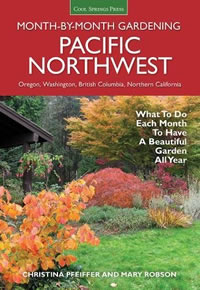 Gardening books that use a calendar format are especially valuable to newer gardeners, and having one that's tailored to our region is even better. Best of all is having an author who worked in the Washington Park Arboretum for many years! Christina Pfeiffer brings her considerable experience to "Month-By-Month Gardening Pacific Northwest" and has consultation help from Mary Robson, a retired Horticulture Extension agent for Washington State University.
Gardening books that use a calendar format are especially valuable to newer gardeners, and having one that's tailored to our region is even better. Best of all is having an author who worked in the Washington Park Arboretum for many years! Christina Pfeiffer brings her considerable experience to "Month-By-Month Gardening Pacific Northwest" and has consultation help from Mary Robson, a retired Horticulture Extension agent for Washington State University.
The same pair collaborated on a 2005 book, with Robson taking the lead on that publication. This new book begins with a short but very meaty introduction chapter covering the basics. The monthly chapters that follow build on the introduction with topics cleverly positioned when you'll most likely want the advice. For example, in June we learned how to turn an area of your lawn into a garden bed, perfect timing so it will be ready for fall planting.
I appreciate that each month begins with a section on planning. What do you want from your garden? What is working well? What needs changing? Only after you've asked and answered these questions, do you start doing. These activities sections include planting and all aspects of caring for common garden plants ranging from annuals to trees. Lawns and houseplants are considered, too.
You are also encouraged to get out to nurseries and plant festivals, and to see our native plants where and when they are at their peak. Enjoying your own and other gardens is important, too. During July, "pause to revel in the beauty and bounty the garden has to offer. This is a time for picnics in the shade and leisurely strolls at local parks and gardens."
Excerpted from the Summer 2017 Arboretum Bulletin.
Link to this review (permalink)
Growing roses in the Pacific Northwest by Nita-Jo Rountree, 2017
Reviewed by: Brian Thompson on 2017-07-01
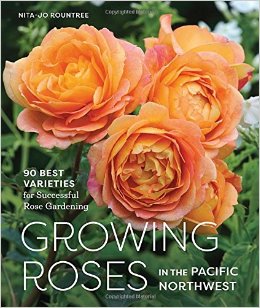 Nita-Jo Rountree move to the Bellevue, Washington 15 years ago after many years as a Master Gardener and the owner of a landscape design and installation company in Atlanta. She quickly learned to separate reality from the myths of our climate and she has used that knowledge to specialize in roses, one her favorite plants – perhaps her very favorite plant (she's a bit coy on this subject; I know she loves hydrangeas, too).
Nita-Jo Rountree move to the Bellevue, Washington 15 years ago after many years as a Master Gardener and the owner of a landscape design and installation company in Atlanta. She quickly learned to separate reality from the myths of our climate and she has used that knowledge to specialize in roses, one her favorite plants – perhaps her very favorite plant (she's a bit coy on this subject; I know she loves hydrangeas, too).
She has chosen an impressive list of roses in all classes, all bred for health, or that have proved their durability in our region without a lot of fussing. Many of them are recent introductions that reflect the work of hybridizers for the home gardener, but she doesn't ignore species or historical roses.
I have a passing knowledge of rose varieties, mostly from a brief period of heavy immersion in gardening with roses many years ago. At the same time, I learned a lot about the frequent spraying and other chemical rites of rose growing, as this was the expectation in almost every rose books of the time. Today, I only know a handful of Rountree's recommendations. There is a good reason for this as her newer, recommended varieties don't need the level of coddling I learned, thus avoiding the potential damage to the garden environment, the wildlife of the garden large and small, or to the gardener.
Rountree is emphatic in her most important advice. "Remember: The most important key to successful rose growing is choosing the right rose for the right place. Many books and articles about roses give generic advice for growing roses in a wide range of climates. They are of little specific help for growing roses in the Pacific Northwest."
Excerpted from the Summer 2017 Arboretum Bulletin.
Link to this review (permalink)
Gardening with foliage first by Karen Chapman, 2017
Reviewed by: Brian Thompson on 2017-07-01
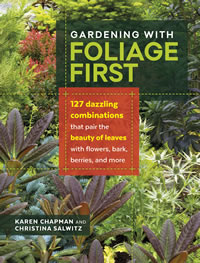 Karen Chapman and Christina Salwitz are crusaders for garden foliage. "Gardening with Foliage First" is their second book on this topic and greatly expands their 2013 book "Fine Foliage." Their goal is to be your "personal design coaches," and they tackle that project with great enthusiasm, starting with your choice of leaves. Flowers come later.
Karen Chapman and Christina Salwitz are crusaders for garden foliage. "Gardening with Foliage First" is their second book on this topic and greatly expands their 2013 book "Fine Foliage." Their goal is to be your "personal design coaches," and they tackle that project with great enthusiasm, starting with your choice of leaves. Flowers come later.
The authors have created a long list of vignettes of plant combinations. Some are simple, two or three plants, while others are very complex and may include ornaments. The setting can be in a large garden bed, or a simple pot. Flowers are allowed, but they must compliment the foliage and be chosen for embellishment. They are not the stars of the show.
The plans all have crazy names. For example, "The Ticklish Porcupine" includes a prickly pear cactus (Opuntia engelmannii) surrounded by Mexican feather grass (Nassella tenuissima). Why these designs work is carefully explained, along with general culture tips. Best is how the design will change with time. Attention is also drawn to potential problems, such as the invasiveness of the above-mentioned feather grass.
Excerpted from the Summer 2017 Arboretum Bulletin.
Link to this review (permalink)
The herb lover's spa book by Sue Goetz, 2015
Reviewed by: Brian Thompson on 2017-07-01
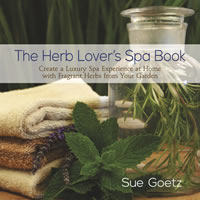 Sue Goetz loves to pamper herself. Even more, she wants you to pamper you. How? There is no single answer to this, but in the "The Herb Lover's Spa Book" she ardently helps you create your own special place – a personal spa to nurture yourself.
Sue Goetz loves to pamper herself. Even more, she wants you to pamper you. How? There is no single answer to this, but in the "The Herb Lover's Spa Book" she ardently helps you create your own special place – a personal spa to nurture yourself.
This blissful goal isn't reached without a lot of practical knowledge. The author's experience as a garden designer helps you create a personal sanctuary in your own back yard. Similar principles are applicable to interior spaces, too.
Next, Goetz walks the reader through a concise list of herbal plants, each defined as "…cultivated for its usefulness in flavoring, perfume, or for cosmetic and medicinal uses." Choosing, growing, harvesting, and preserving are all part of the lessons.
Finally, you create. Lotions and ointments to make your life a little easier, a little more enjoyable. The recipes are easy, difficult concepts are clearly explained, and there's nothing else to do but try it. As you ease into your fragrance-enriched bathtub of steaming hot water, you'll be glad you did.
Excerpted from the Arboretum Bulletin.
Link to this review (permalink)
Victory gardens for bees by Lori Weidenhammer, 2016
Reviewed by: Brian Thompson on 2017-07-01
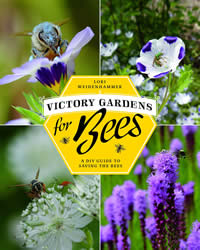 Anyone who regularly dresses up as a queen bee to educate children has to be passionate about her topic. Lori Weidenhammer, a performance artist based in Vancouver, British Columbia, is certainly that. That same energy is now available in her book, "Victory Gardens for Bees." The sub-title well describes the book's style: "A DIY Guide to Saving the Bees." Weidenhammer wants you to be engaged!
Anyone who regularly dresses up as a queen bee to educate children has to be passionate about her topic. Lori Weidenhammer, a performance artist based in Vancouver, British Columbia, is certainly that. That same energy is now available in her book, "Victory Gardens for Bees." The sub-title well describes the book's style: "A DIY Guide to Saving the Bees." Weidenhammer wants you to be engaged!
All this energy at first may distract you from the rich content. This is an excellent introduction and field guide to the many types of bees. Planting charts recommend plants for your gardens – starting with weeds! Each entry tells you which bees are attracted to the plant, and what it provides for them. Planting plans will suggest garden layouts. The photos, mostly by the author, are excellent at showing their small subjects in tremendous detail.
Sometimes, you may feel like a child at one of Queen Bee's performances. Suppose you are accidently stung by a bee. "It hurts a lot and you will feel like unfriending bees. Don't take it personally. Bad stings happen to good people. Once the pain goes away, you'll be ready to forgive and refriend the bees."
Excerpted from the Summer 2017 Arboretum Bulletin.
Link to this review (permalink)
The power of pulses by Dan Jason, 2016
Reviewed by: Brian Thompson on 2017-07-01
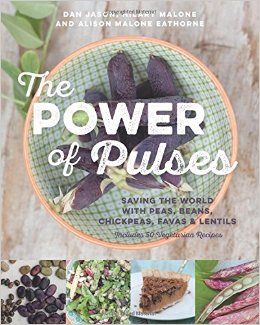 When I first heard the title, "The Power of Pulses," I was perplexed as to the subject of the book. The word pulse has many meanings! This is a book better defined by its sub-title: "Saving the World with Peas, Beans, Chickpeas, Favas & Lentils."
When I first heard the title, "The Power of Pulses," I was perplexed as to the subject of the book. The word pulse has many meanings! This is a book better defined by its sub-title: "Saving the World with Peas, Beans, Chickpeas, Favas & Lentils."
To be more precise, a pulse is a legume harvested mainly for the dry seed. The primary author, Dan Jason of Salt Spring Island, British Columbia, has chosen to concentrate on the five that are the easiest to grow in the temperate climates of Canada and the northern United States.
The sub-title also hints at Jason's proselytizing zeal for growing these plants. Of course, he also sells them through his company, Salt Spring Seeds. But never mind this possible conflict; this is an excellent introduction to these easy-to-grow, highly nutritious, and earth-friendly foods that require little water and no fertilizer. While generally very positive, the author is not afraid to express his disgust on certain matters, noting "…the common white navy bean has practically no taste and a texture that leaves everything to be desired."
The last part of the book is devoted to 50 vegetarian recipes using pulses and contributed by the co-authors, sisters Hilary Malone and Alison Malone Eathorne of Nanaimo, British Columbia. These tasty sounding treats take you well beyond traditional soups and stews to everything from breakfast to desserts.
Excerpted from the Summer 2017 Arboretum Bulletin.
Link to this review (permalink)
Natural history of the Pacific Northwest mountains by Daniel Mathews, 2017
Reviewed by: Brian Thompson on 2017-07-01
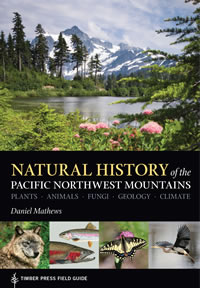 I find field guides fascinating and always enjoy reading new ones. "Natural History of the Pacific Northwest Mountains" by Daniel Mathews is something of a hybrid between a traditional field guide, and a collection of natural history essays. There are enough photos and text descriptions to help you recognize the most common plants, animals, bugs, and even the rocks of our mountains.
I find field guides fascinating and always enjoy reading new ones. "Natural History of the Pacific Northwest Mountains" by Daniel Mathews is something of a hybrid between a traditional field guide, and a collection of natural history essays. There are enough photos and text descriptions to help you recognize the most common plants, animals, bugs, and even the rocks of our mountains.
While field guides with detailed keys or multiple photographs for each species might be better for fine-tuning your plant identification, this is handy if your specimen is occupied by some winged creature – just flip to another part of the book to identify it, too. Interspersed are anecdotes and observations of the more noteworthy genera that make this a delightful book to read from cover to cover.
This isn't exactly a new field guide. Mathews describes it as "essentially an expanded and updated third edition of "Cascade-Olympic Natural History," the second edition under that earlier title was published in 1999. However, it is new to me and I found it quite interesting. Unlike some other all-in-one field guides, plants are not short-changed and – if you include mosses, fungi, and lichens – comprise half of the book.
The essays on the trees, shrubs, and wildflowers are delightful. For example, the glacier (Erythronium grandiflorum) and avalanche (E. montanum) lilies "…seem ideal vehicles for those anthropomorphic virtues we love to foist on mountain wildflowers—innocence, bravery, simplicity, perseverance, patient suffering, and so on. They toil not, neither do they spin, and they don't taste half bad either."
Excerpted from the Summer 2017 Arboretum Bulletin.
Link to this review (permalink)
Witness tree by Lynda Mapes, 2017
Reviewed by: Brian Thompson on 2017-10-01
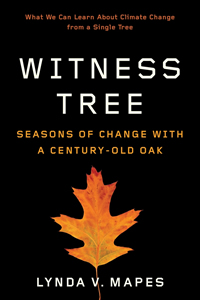 How would it be to spend a whole year observing a forest, the changing seasons and all the beings – plants and animals – that lived there. This is exactly what Lynda Mapes, a science reporter for "The Seattle Times," decided to find out. She lived on the edge of the Harvard Forest, a 3,000 acre managed research forest in Petersham, Massachusetts, over 60 miles west of the main Harvard campus. "The Witness Tree" is the story of this undertaking.
How would it be to spend a whole year observing a forest, the changing seasons and all the beings – plants and animals – that lived there. This is exactly what Lynda Mapes, a science reporter for "The Seattle Times," decided to find out. She lived on the edge of the Harvard Forest, a 3,000 acre managed research forest in Petersham, Massachusetts, over 60 miles west of the main Harvard campus. "The Witness Tree" is the story of this undertaking.
To focus her attention, she concentrates on one tree, a northern red oak (Quercus rubra), of early middle age for this species. She examines this tree in every conceivable way, and with the help of experts from many professional and avocational perspectives. She also considers the humans that interact with the tree and the forest, including the cultural history of the area, and its impact on the natural history.
Throughout there is an ongoing consideration of climate and other changes in the forest. Both from the long view over millennia, and the more recent changes, such as the increase of the hemlock woolly adelgid (Adelges tsugae), and near demise of such forest stalwarts as the American elm (Ulmus americana) and the American chestnut (Castanea dentata). Some of this is told from the supposed perspective of her beloved hundred-plus-year-old red oak.
Mapes stayed in New England during the winter of 2014-2015, one of the coldest and snowiest on record. She writes, "While I froze in the Northeast, my husband at home in Seattle was cutting the grass and watching flowers burst forth in the warmest winter on record." Contrasts like this, and the author's gentle role in teasing them out of the world around her, makes this a very satisfying book.
Excerpted from the Fall 2017 Arboretum Bulletin.
Link to this review (permalink)
Trees of greater Portland by Phyllis Reynolds, 2013
Reviewed by: Brian Thompson on 2017-10-01
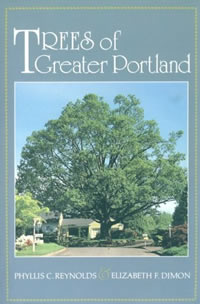 Phyllis Reynolds co-wrote "Trees of Greater Portland", published in 1993. Twenty years later, she has written the second edition of this worthy guide to urban trees, narrowing her definition of "Greater Portland" so that most of the subjects now included are within the city limits.
Phyllis Reynolds co-wrote "Trees of Greater Portland", published in 1993. Twenty years later, she has written the second edition of this worthy guide to urban trees, narrowing her definition of "Greater Portland" so that most of the subjects now included are within the city limits.
She revisited and re-photographed all the trees from the first edition, sadly removing the ones that are gone, but adding some that are new. Most interesting is comparing the photographs of the same tree in the two editions after twenty years more growth. One of the most remarkable is a Malus x domestica 'Yellow Bellflower', a winter apple with pale yellow fruit. Thought to be planted in 1848, it still blooms and bears fruit.
For the Portland resident or visitor, the nine tree tours at the end of each book will be of the most interest. These are in neighborhoods especially rich with notable trees, many profiled earlier in the book. To sharpen your recognition skills, the author only identifies one example of each species on the walk, as she explains, "This should be a learning experience."
Excerpted from the Fall 2017 Arboretum Bulletin.
Link to this review (permalink)
Floret Farm's Cut Flower Garden by Erin Benzakein, 2017
Reviewed by: Brian Thompson on 2017-10-01
 "Florets Farm's Cut Flower Garden" is an excellent handbook to creating and running a very successful cut flower business on the model of Floret Farm in Washington's Skagit Valley. However, if your goals are not quite so ambitious, there is still a lot of advice here for creating a cutting patch in your own garden and using the bounty for filling vases and many other purposes.
"Florets Farm's Cut Flower Garden" is an excellent handbook to creating and running a very successful cut flower business on the model of Floret Farm in Washington's Skagit Valley. However, if your goals are not quite so ambitious, there is still a lot of advice here for creating a cutting patch in your own garden and using the bounty for filling vases and many other purposes.
Primary author Erin Benzakein speaks from a lot of experience. Her farm began as a big patch of sweet peas, grown in memory of her beloved, gardening great-grandmother. Friends requested cut flowers. The tears and emotional memories evoked in one recipient was an epiphany for Benzakein. "In that moment, I realized that I'd found my calling. Witnessing the profound impact that a simple bouquet could have on a person, I knew I had discovered something worth pursuing."
While the introduction prepares the reader for both the cultural and business side of cut flowers, the core of the book is the author's choices of favorites and her hard-earned experience with each. And not just flowers. She encourages growing at least as many plants for their leaves, seed pods, colorful branches, and other features as supporting cast – or stars in their own right – for your arrangements. She also encourages the use of grasses, shrubs, trees, and even vegetables in your cutting plans; a spray of tomatoes – in various stages of ripeness – has considerable ornamental value.
To this end, there is an introduction to all the equipment familiar to a florist. Many of these are useful to the home arranger for various projects involving both fresh and dried flowers. The most striking photo (and there are many) in the book is of the author wearing a spring crown of ranunculus, viburnum, muscari, and campanula!
Excerpted from the Fall 2017 Arboretum Bulletin.
Link to this review (permalink)
Mosaic garden projects by Mark Brody, 2015
Reviewed by: Brian Thompson on 2017-10-01
 "Mosaic and garden design have similar characteristics. They are each made of an assembly of pieces laid out in a certain way." This is the premise of primary author Mark Brody in "Mosaic Garden Projects," co-written with Sheila Ashdown. Both authors, along with photographer Justin Myers, whose work is a critical part of this book, are Portland residents.
"Mosaic and garden design have similar characteristics. They are each made of an assembly of pieces laid out in a certain way." This is the premise of primary author Mark Brody in "Mosaic Garden Projects," co-written with Sheila Ashdown. Both authors, along with photographer Justin Myers, whose work is a critical part of this book, are Portland residents.
Wisely, Brody starts his orderly series of lessons with defining your working space – it must be a dedicated as mosaics take room and some time to complete. You can't just pick up the project to make room for dinner! You'll need tools and, if you jump in with both feet, lots of tools and places to put them. Good lighting, excellent ventilation (some of the materials are smelly), and a handy source of water are other necessities.
If you've completed this checklist, you're set to go. Excellent close-ups introduce the tools, the various types of tesserae (the pieces that make up the mosaic), and other critical parts. These include the substrate that supports your art, including the marvelously garden-sounding wedi (pronounced "weedy") board, the adhesives to attach, and the grouts to fill in the gaps.
There are instructions on creating the image, with many templates to help, but filling the bulk of the book are projects. In my experience, many do-it-yourself books have a number of frivolous projects, but not this one. Each, from easy to challenging, has a place in your garden or nearby – the first and, according to Brody the easiest, is a mosaic of your house numbers to welcome your guests.
Excerpted from the Arboretum Bulletin.
Link to this review (permalink)
Hoptopia by Peter Kopp, 2016
Reviewed by: Brian Thompson on 2017-10-01
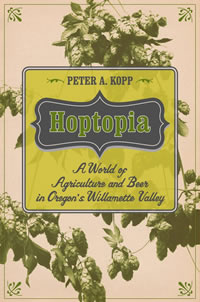 "Hoptopia" is the intriguing name of a well-researched and documented new book by Peter Kopp that tells the history of growing hops, especially in the Willamette Valley of Oregon. To set the stage, the author reviews the natural history of hops, including Humulus lupulus, a wide spread species throughout much of the north temperate world, but that is not found in our region.
"Hoptopia" is the intriguing name of a well-researched and documented new book by Peter Kopp that tells the history of growing hops, especially in the Willamette Valley of Oregon. To set the stage, the author reviews the natural history of hops, including Humulus lupulus, a wide spread species throughout much of the north temperate world, but that is not found in our region.
This all changed in the mid-19th century with the rise of the hops growing in both Oregon and Washington. Puyallup, Washington was an early center for this crop. Residents of that city are likely aware of their historic Meeker Mansion, but perhaps they do not know that its builder, Ezra Meeker, was the "Hop King" during the 1880s.
In the 20th century, prohibition threatened to destroy this industry. However, the opposite happened, because of the rising demand for the American crop in war-torn Europe. By the 1930s, hop growing was at its peak in the Willamette Valley, celebrated by the Hop Fiesta in Independence, Oregon, an event revived in this century. There were challenges, too. The extreme physical demands of harvesting hops led to strife between labor and management. Downy mildew required the breeding of resistant varieties, a process that did not have significant success until the 1970s.
Today, the center of hops growing has shifted back to Washington, as the greater Yakima Valley now is by far the largest producer of hops in the world. Meanwhile, Portland has proclaimed itself "Beervana" for its many small breweries as, according to Kopp, "…there is little question that the hop became the signature ingredient of the craft beer revolution."
Excerpted from the Fall 2017 Arboretum Bulletin.
Link to this review (permalink)
The Northwest coastal explorer by Robert Steelquist, 2007
Reviewed by: Brian Thompson on 2017-10-01
 The Pacific Northwest is blessed with considerable coastline, both on the open Pacific and the shores of the Salish Sea. While beautiful, the coastline might not be the first place a gardener would go for inspiration. "The Northwest Coastal Explorer" by Robert Steelquist may change that attitude.
The Pacific Northwest is blessed with considerable coastline, both on the open Pacific and the shores of the Salish Sea. While beautiful, the coastline might not be the first place a gardener would go for inspiration. "The Northwest Coastal Explorer" by Robert Steelquist may change that attitude.
The author engagingly introduces plants ranging from seaweed to conifers, from underwater to the coastal forests and riverbanks. He includes kelp, eelgrass, and pickleweed – all plants that have adapted to a very specialized environment.
Steelquist understands that these plants, while rather odd-looking and perhaps not as appealing as the animal life, have an equally important role in the coastal ecosystems. If you see on the water surface the floating stems and bulbs of bull kelp (Nereocystis luetkeana), then "…what's underneath is as lush as any rain forest."
Excerpted from the Fall 2017 Arboretum Bulletin.
Link to this review (permalink)
Birds of the Pacific Northwest : a photographic guide by Tom Aversa, 2016
Reviewed by: Brian Thompson on 2017-10-01
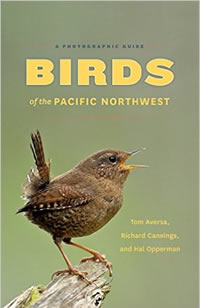 The popularity of birding in our region sparked the release of two new birding books with nearly identical titles by major regional publishers. This book was published in 2016 by the Seattle Audubon Society and the University of Washington Press. In 2017, Timber Press continued their Field Guide series with "Birds of the Pacific Northwest," by John Shewey and Tim Blount.
The popularity of birding in our region sparked the release of two new birding books with nearly identical titles by major regional publishers. This book was published in 2016 by the Seattle Audubon Society and the University of Washington Press. In 2017, Timber Press continued their Field Guide series with "Birds of the Pacific Northwest," by John Shewey and Tim Blount.
Confusing? Yes, and as a minimal birder, I don't feel qualified to make a recommendation between the two, especially as to my eye there are more similarities than differences. If you are serious about identifying the birds in your garden or on your local travels, you clearly need both books!
The photography is one of the outstanding features of both, and the photos capture a very wide range of species, often with multiple images to show variation in sexes, juveniles, breeding plumage, and other color forms. Throughout there is help with identification between near look-alikes, and the authors address behaviors, bird songs, specifics on where to find rarer birds, and conservation status.
The Audubon book includes an excellent essay on the climate, geology, and ecology of different sub-regions, especially as it pertains to the birds found there. It covers a bigger area, extending the region eastward to the continental divide. I like that each photograph includes both the location by county and the month taken.
Excerpted from the Fall 2017 Arboretum Bulletin.
Link to this review (permalink)
Birds of the Pacific Northwest by John Shewey, 2017
Reviewed by: Brian Thompson on 2017-10-01
 The popularity of birding in our region sparked the release of two new birding books with nearly identical titles by major regional publishers. "Birds of the Pacific Northwest: A Photographic Guide" by Tom Aversa, Richard Cannings, and Hal Opperman was published in 2016 by the Seattle Audubon Society and the University of Washington Press. In 2017, Timber Press continued their Field Guide series with this book, "Birds of the Pacific Northwest," by John Shewey and Tim Blount.
The popularity of birding in our region sparked the release of two new birding books with nearly identical titles by major regional publishers. "Birds of the Pacific Northwest: A Photographic Guide" by Tom Aversa, Richard Cannings, and Hal Opperman was published in 2016 by the Seattle Audubon Society and the University of Washington Press. In 2017, Timber Press continued their Field Guide series with this book, "Birds of the Pacific Northwest," by John Shewey and Tim Blount.
Confusing? Yes, and as a minimal birder, I don't feel qualified to make a recommendation between the two, especially as to my eye there are more similarities than differences. If you are serious about identifying the birds in your garden or on your local travels, you clearly need both books!
The photography is one of the outstanding features of both, and the photos capture a very wide range of species, often with multiple images to show variation in sexes, juveniles, breeding plumage, and other color forms. Throughout there is help with identification between near look-alikes, and the authors address behaviors, bird songs, specifics on where to find rarer birds, and conservation status.
The Timber Press book includes helpful and practical introductions to most species. For example, in discussing the American Crow (Corvus brachyrhynchos) and the Northwestern Crow (C. caurinus) the authors conclude "… they are indistinguishable" and if you want to add the latter to your life list, going to the right location "…is the safe bet." While on the large size for taking into the field, this book's heavy cover will help protect it from the weather.
Excerpted from the Fall 2017 Arboretum Bulletin.
Link to this review (permalink)
Rooted in the earth by Dianne Glave, 2010
Reviewed by: Brian Thompson on 2018-01-01
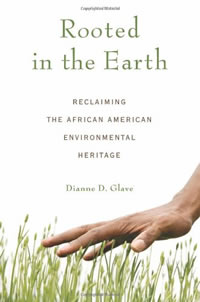 Dianne Glave is very clear about the main argument of her book, "Rooted in the Earth". "Stereotypes persist that African Americans are physically and spiritually detached from the environment. This wrongheaded notion is so ingrained in our culture that many of us have begun to believe it ourselves. But nothing could be less true."
Dianne Glave is very clear about the main argument of her book, "Rooted in the Earth". "Stereotypes persist that African Americans are physically and spiritually detached from the environment. This wrongheaded notion is so ingrained in our culture that many of us have begun to believe it ourselves. But nothing could be less true."
To illustrate this viewpoint, she begins each chapter with a story. While fictional, these stories weave a convincing portrayal of the history of African Americans from their roots in Africa, up to modern times. All emphasize a strong and vibrant connection to the natural environment as expressed in many ways, including through religion, conservation, nature study, and gardening.
I found the chapter entitled "Women and Gardening: A Patch of Her Own" particularly engaging. The focus is on African American women living in the rural southern United States, both before and after the Civil War.
Some used conventional agricultural practices of producing food and other crops in orderly rows. Others embraced a natural aesthetic with a glorious mixture of annuals, perennials, and shrubs. While this has become popular amongst prominent European and American garden designers in recent years, for African Americans this is an older tradition.
The diversity of these plantings was effective at reducing insect pests and left little room for weeds to thrive. Flowers were grown for their beauty and fragrance, and as ways to entice the neighbors over to visit. In addition, "some gardeners sought ethical, moral, and spiritual enlightenment in these chaotic or wilderness spaces much as their African ancestors had."
Excerpted from the Winter 2018 Arboretum Bulletin.
Link to this review (permalink)
The home place by J. Drew Lanham Lanham, 2017
Reviewed by: Brian Thompson on 2018-01-01
 "The Home Place" is best described by its subtitle: "Memoirs of a Colored Man's Love Affair with Nature." J. Drew Lanham's love for nature, especially of birds, and nurtured by his upbringing in rural, western South Carolina, is palpable throughout.
"The Home Place" is best described by its subtitle: "Memoirs of a Colored Man's Love Affair with Nature." J. Drew Lanham's love for nature, especially of birds, and nurtured by his upbringing in rural, western South Carolina, is palpable throughout.
This began in childhood. "When the chores were finally done, however, I could break free of the house and enter a fantasy world of earth and sky." Despite this desire to escape, he was also a good student, and was encouraged to pursue an undergraduate education in engineering. Although this path would have likely led to a more profitable career, Lanham realized his heart had a different goal, and is now a Professor of Wildlife Ecology at Clemson University.
This was not an easy choice, and Lanham laments that very few other men of color have pursued the same career path. It also is sometimes a dangerous choice; black men found with binoculars in a rural setting may risk their lives.
His advice is simple: "Get more people of color 'out there.'" Echoing the thoughts of Glave, he adds: "As young people of color reconnect with what so many of their ancestors knew—that our connections to the land run deep, like the taproots of mighty oaks; that the land renews and sustains us—maybe things will begin to change."
Excerpted from the Winter 2018 Arboretum Bulletin.
Link to this review (permalink)
The good food revolution by Will Allen, 2012
Reviewed by: Brian Thompson on 2018-01-01
 Will Allen grew up on a small farm in the Maryland suburbs of Washington, D. C. His parents grew up as sharecroppers in western South Carolina, very close to the home of J. Drew Lanham. As a young man, he was embarrassed by his heritage, instead hoping to make his career as a basketball player.
Will Allen grew up on a small farm in the Maryland suburbs of Washington, D. C. His parents grew up as sharecroppers in western South Carolina, very close to the home of J. Drew Lanham. As a young man, he was embarrassed by his heritage, instead hoping to make his career as a basketball player.
A talented competitor in both high school and college, he had a limited career as a professional, primarily playing in Belgium. While in Europe, he had time to observe the local agricultural customs, including the many small farms using traditional, organic practices. This reawakened in his interest in growing food. After starting a successful corporate career in metropolitan Milwaukee, he began farming as a hobby.
In 1993 by chance, he discovered the last agriculturally zoned property in the poor, mostly black northern part of the city. At the time he was in his forties, doing well in his career, but feeling unfulfilled. He decided to purchase the property, leave his safe job, and open a vegetable stand because he "wanted to try to heal the broken food system in the inner-city community where my market operated."
He also wanted to connect Wisconsin farmers to African American communities, especially as Milwaukee is one of the most segregated cities in the country. "But on our small piece of earth, we struggled and celebrated together—black and white, Hispanic and Hmong, young and old—as we worked to produce healthy food."
This hasn't been easy, and much of "The Good Food Revolution" by Allen (with Charles Wilson) is the story of the last 20 years of building what is now a very successful urban farming non-profit organization that not only serves its home community but has fostered similar programs in many other cities. The author is a good storyteller, praising the many individuals who contributed to his work, so that they become your heroes, too. While this work is not a panacea to all of the troubles of racism and poverty, there are many happy endings.
Excerpted from the Winter 2018 Arboretum Bulletin.
Link to this review (permalink)
The Color of Food by Natasha Bowens, 2015
Reviewed by: Brian Thompson on 2018-01-01
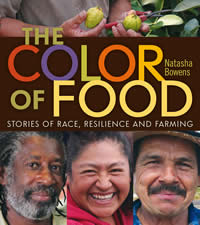 In describing her book, "The Color of Food," Natasha Bowens explains, "I never would have imagined that my desire to dig in the dirt would lead me here, digging instead into the stories of farmers of color across America – Black, Latina, Native, and Asian farmer and food activists." Initially, her interest in improving food and agriculture systems led her to working on organic farms, but often as the only "brown person" there. Through her blog (Brown.Girl.Farming), she discovers there are others like her, and decides their stories need telling.
In describing her book, "The Color of Food," Natasha Bowens explains, "I never would have imagined that my desire to dig in the dirt would lead me here, digging instead into the stories of farmers of color across America – Black, Latina, Native, and Asian farmer and food activists." Initially, her interest in improving food and agriculture systems led her to working on organic farms, but often as the only "brown person" there. Through her blog (Brown.Girl.Farming), she discovers there are others like her, and decides their stories need telling.
At the same time, she was learning about her heritage, including the uneasy discovery that her white mother's ancestors owned her black father's ancestors. "I'm literally the product of ownership and oppression reuniting, as if to rewrite the story."
Her trip takes her across the country. For the purposes of this review, I'll concentrate on stories she found amongst farmers on the West Coast. These include Menkir Tamrat, who came to the United States from Ethiopia for college in the 1970s and now lives in Fremont, California. Missing the special ingredients of the favorite dishes of his native land, he recognized that he would need to grow his own. This is what he does, but also enjoys preparing traditional dishes and some of the intermediate ingredients to sell to Ethiopian markets and restaurants.
In the Skagit Valley of Washington, Nelida Martinez is a Mixteca native – from the state of Oaxaca in Mexico – who now has her own organic farm focusing on raspberries, blackberries, and various vegetables. She made this bold move after her son sickened with leukemia, possibly from exposure to pesticides at the conventional farm where his mother once worked. She describes the experience of Latino farmworkers as "a lot of humiliation for us, and many of us never think about having our own farm because we feel degraded by the work." Now, she is very pleased to not be working "for anyone else!"
Valerie Segrest is not a farmer in the traditional sense, but rather an advocate for the foraging traditions of her people, the Muckleshoot tribe based in Auburn, Washington. This includes cooking and eating traditional foods in season, a practice that has required compromises because of dams, pollution, or what she calls "European land management styles." While she appreciates the role of conservation, she argues that the foraging and harvesting of native peoples ensured "a balance with nature where you're working together and not having dominion over that space. Even as foragers, we use harvesting techniques that make it look like we've never even been there while also actually benefitting the plant."
Excerpted from the Winter 2018 Arboretum Bulletin.
Link to this review (permalink)
American Grown by Michelle Obama, 2012
Reviewed by: Brian Thompson on 2018-01-01
 Michelle Obama needs no introduction and even her book "American Grown," describing the White House Kitchen Garden she started, is already well known. For some, this may be an easy book to dismiss as a public service announcement, or worse, as a political statement. This is unfortunate, because it is a good gardening book, both for techniques and as a model of how gardening improves people's lives in many ways.
Michelle Obama needs no introduction and even her book "American Grown," describing the White House Kitchen Garden she started, is already well known. For some, this may be an easy book to dismiss as a public service announcement, or worse, as a political statement. This is unfortunate, because it is a good gardening book, both for techniques and as a model of how gardening improves people's lives in many ways.
This book has many authors. The White House gardening staff share their experiences and appreciation of the garden along with basic cultural advice, geared to both the new gardener and to those unfamiliar with the wide range of delicious foods they can easily grow. White House chefs share tips on harvesting and preserving, and provide recipes that make it simple to add more fruits and vegetable to your diet.
Equity and diversity are quiet, background themes in "American Grown", but it clear that in this garden "equality is a key part of the message of planting day. We are all down in the dirt. Anyone present can help dig. There is no hierarchy, no boss, and no winner."
Obama also reaches out to those involved with community gardens, school gardens, and food resources across the country (including Will Allen), and with other programs that encourage exercise for youth and healthy school lunch choices.
One such garden is the New Roots Community Farm in San Diego, where gardeners from Uganda, Kenya, Vietnam, Mexico, and Guatemala began working together. "At first, they weren't sure how people from so many different countries would get along—especially since the garden had only two hoses to share and the farmers often didn't speak the same language. But their enthusiasm and determination drew them together."
Excerpted from the Winter 2018 Arboretum Bulletin.
Link to this review (permalink)
Farmer Will Allen and the growing table by Jacqueline Briggs Martin, 2013
Reviewed by: Brian Thompson on 2018-01-01
 The story of Will Allen and his urban farming non-profit organization (described in his book "The good food revolution")has inspired a book found in the children's section of the Miller Library. "Farmer Will Allen and the Growing Table," written by Jacqueline Briggs Martin and illustrated by Eric-Shabazz Larkin, focuses on the role neighborhood children played in helping Allen's enterprise be successful.
The story of Will Allen and his urban farming non-profit organization (described in his book "The good food revolution")has inspired a book found in the children's section of the Miller Library. "Farmer Will Allen and the Growing Table," written by Jacqueline Briggs Martin and illustrated by Eric-Shabazz Larkin, focuses on the role neighborhood children played in helping Allen's enterprise be successful.
In vivid colors, this book captures the diversity of food produced in these greenhouses, including the pools for tilapia, chickens for eggs, sprouts for quick greens, and hives for honey. The people are colorful, too, and of many ethnicities and ages.
The children were especially eager to help bring food garbage, and to come back every day to watch the red wiggler worms turn these scraps into compost. There is tragedy in this story, as some of the worms died until the kids discovered the proper care and feeding they required, but in the end, "the squirmy crew has stayed hard at work."
Excerpted from the Winter 2018 Arboretum Bulletin.
Link to this review (permalink)
Orchid: a cultural history by Jim Endersby, 2016
Reviewed by: Priscilla Grundy on 2018-02-01
"Orchid: A Cultural History" will please anyone who loves orchids and is not offended by frank descriptions. From its first appearance in an ancient Greek herbal, the orchid has been associated with sex, and Jim Endersby makes clear that association continues to the present. Orchids have been associated with subjects as wide-ranging as death (in one fictional account a blossom consumes a human), masculinity, female temptation, and homosexuality.
Endersby traces the orchid's appearance in myth, art, literature, and film. The late 19th century English "orchidmania" is a particularly rich lode. The adventures of real life orchid hunters make fascinating reading, but much fiction grew out of it as well. For instance, in "The Pollinators of Eden" by John Boyd (1969) the pseudocopulation of one type of orchid (a fascinating true phenomenon also described in Orchid) was stretched to include intelligent orchids copulating with humans. The author knows his orchids and includes solid scientific information along with the plant's less rational associations. This is serious history with a light touch.
Published in the February 2018 Leaflet Volume 2, Issue 5.
Link to this review (permalink)
Sustainable stormwater management by Thomas Liptan, 2017
Reviewed by: Brian Thomson on 2018-02-01
 Thomas Liptan introduces his new book, Sustainable Stormwater Management, by recounting an aha! moment early in his career as a landscape architect. While working on a parking lot design, the project's engineer urged putting the water "in the landscape." That is what they did, effectively directing the runoff to shallow gardens for absorption and filtration.
Thomas Liptan introduces his new book, Sustainable Stormwater Management, by recounting an aha! moment early in his career as a landscape architect. While working on a parking lot design, the project's engineer urged putting the water "in the landscape." That is what they did, effectively directing the runoff to shallow gardens for absorption and filtration.
As Liptan's career progressed, he discovered this was very unusual thinking for the time (1978). However, he continued to seek opportunities to further this design concept, his guiding principle being "we continually underestimate the capacity of our built environment to manage rain and runoff, just as we underutilize rainfall's benefit to soil and plants."
This book is an easy-to-read summation of the lessons the author has learned over his career, and is recommended for anyone considering stormwater management projects, large or small. He is both upbeat in encouraging innovation and pragmatic in the need to have results that are functional, economically sound, long-lasting, and look good.
Most engaging are the many case studies and the practicalities of choosing plants and structural materials. Liptan has worked in Portland for many years and uses this city for many of his examples. Given our similar climate, rainfall, and interest in sustainable development, this is an excellent book for projects in the Seattle area, too.
Published in the February 2018 Leaflet for Scholars Volume 5, Issue 2.
Link to this review (permalink)
Companions in Wonder : Children and Adults Exploring Nature Together by Julie Dunlap and Stephen R. Kellert, 2012
Reviewed by: Dorothy Crandell on 2018-03-01
Sharing is a multiplier. The most ordinary things can become extraordinary when shared. Julie Dunlap and Stephen Kellert, in Companions in Wonder: Children and Adults Exploring Nature Together, gather lively examples of how adults and children experience the outdoors together, restoring nature to its rightful place in people's lives.
Personal experiences described by the essayists guide the reader to more deeply understand and appreciate a closer relationship with nature and with people across generations. Voices are from wide-ranging geographic, ethnic, and cultural backgrounds. Building on the legacy of Rachel Carson's essay "Help Your Child to Wonder", contributors include journalist and author Richard Louv ("Fathers and Sons"), Native American writers, educators, and storytellers James and Joseph Bruchac ("Tracking Our Way"), educator and earth historian Lauret Savoy ("Colored Memory"), among many others. The editors conclude with general recommendations for adults as well as particular recommendations for teachers.
Companions in Wonder inspires happy, healthy ways to engage and bond children and adults in the great outdoors. The primal power of regular, positive outdoor experiences is paramount in reversing the trend of "nature deficit disorder" at all levels. Sharing experiences in the natural environment multiplies both discovery and renewal of relationships in considering the past, the present, and the future of life on earth.
Published in the March 2018 Leaflet Volume 5, Issue 3.
Link to this review (permalink)
Garden Revolution : How Our Landscapes Can Be a Source of Environmental Change by Larry Weaner and Thomas Christopher, 2016
Reviewed by: Brian Thompson on 2018-01-07
The title Garden Revolution is hype. This new book by Larry Weaner and Thomas Christopher is instead a retreat, a going back to working with nature.
Yes, it does challenge many traditional horticultural practices. Primary author and long-time garden designer Weaner uses the term ecological gardening to describe his technique. He insists on working with the existing soil, exposure, and other elements of a site, choosing plants that thrive in the given conditions, instead of amending to the needs of plants you want. He also argues against most accepted weeding practices because they disturb the soil, encouraging more weed seeds to sprout.
Most of all, he wants the gardener and anyone who carefully observes a landscape to recognize that change is inevitable, but it can and should be embraced.
Why am I recommending this book to students and researchers in restoration? Because there is a lot of good horticulture that is very applicable to restoration sites. Weaner lives in the eastern United States, but his principles are quite adaptable and applicable.
He is blunt: "Ecological garden design is not a style of garden-making for the micro-manager. To be successful, this sort of design requires letting the landscape make many of the decisions."
So perhaps this is a revolution. One that on a small scale has already proven successful.
Published in the March 2018 Leaflet for Scholars Volume 5, Issue 3.
Link to this review (permalink)
Saving Tarboo Creek by Scott Freeman, 2018
Reviewed by: Priscilla Grundy on 2018-04-01
Saving Tarboo Creek is a local book – by local authors about a local place. Tarboo Creek empties indirectly into the Hood Canal. Scott Freeman teaches biology at the University of Washington. His wife Susan, an artist, is also the granddaughter of Aldo Leopold, whose Sand County Almanac is a bible for ecologists. The book is partly a narrative – a description of how the Freemans have labored over a number of years to restore a patch of land along the creek to its natural state – the one before the pioneers straightened the creek and harvested most of the trees to create farm land. The book is also a call to arms to those who can act to save and restore natural landscapes.
One of my favorite chapters, one that exemplifies the Freemans' approach, deals with beavers. Of course beavers can be disastrous to any tree planting effort, and the Freemans have planted thousands of young trees. The chapter describes clearly, and with some sympathy for the beavers, how the animals live and build and move into new territory like that around Tarboo Creek. Killing them wouldn't help, even if one thought it a good idea, because more beavers would soon show up. Furthermore, beaver dams help make the creek an ideal place for young salmon, a positive effect for the Freemans. So the Freemans (and friends) have painstakingly wrapped trees near the creek with protective wire, and each year they wrap more and more. They expect "an intense beaver chew-down" each March or April, and do the hard labor of saving their young trees.
Each chapter places an aspect of restoration work, such as tree planting, in its historical and ecological context. In the final chapter, directed especially at young people, the Freemans call for a return to a "natural life," giving four criteria: be engaged, be simple, be real, be present. The book conveys an urgent sense of hope.
Published in the April 2018 Leaflet Volume 5, Issue 4.
Link to this review (permalink)
RHS Genealogy for Gardeners by Ross Bayton and Simon Maughan, 2017
Reviewed by: Brian Thompson on 2018-04-01
![[RHS Genealogy for Gardeners]]cover](https://depts.washington.edu/hortlib/resources/http://depts.washington.edu/hortlib/graphix/RHSGenealogyforgardeners (2).jpg)
Confused by plant families? Having trouble keeping track of recent changes based on DNA and other molecular research? RHS Genealogy for Gardeners can help with these questions. Ross Bayton (a long-time volunteer in the Otis Douglas Hyde Herbarium and at the Rhododendron Glen of the Washington Park Arboretum) is co-author with Simon Maughan of this Royal Horticultural Society ("RHS") publication.
Don't be put off by "for Gardeners" in the title. This is an excellent book for field botanists, or anyone interested in understanding the relationships between plants in any setting. The book is published in the United States under the title Plant Families: A Guide for Gardeners and Botanists.
Bayton has his PhD in taxonomy, while Maughan has an extensive background in writing, editing, and publishing both botanical and horticultural works. The combination means this book has scientific accuracy and is very readable for those with all levels of botanical knowledge. Family descriptions include basic characteristics, the genetic history, best-known genera, and the important uses of the members, including as ornamentals and for food crops or other plant-based products.
The introduction section also coaches good techniques in observation and teasing out the family connections of the plants you're considering, with the following words of both warning and encouragement: "The intricacies and subtleties of plant identification are unfortunately beyond the reaches of a simple Internet search engine. The best we currently have to rely on are our own observational skills."
Published in the April 2018 Leaflet for Scholars Volume 5, Issue 4.
Link to this review (permalink)
Play the Forest School Way by Peter Houghton, 2016
Reviewed by: Dorothy Crandell on 2018-05-01
Time in the woods refreshes your spirit and opens your mind. It cultivates appreciation, discovery, and possibilities.
In a woodland setting, Play the Forest School Way: Woodland Games, Crafts and Skills for Adventurous Kids offers hands-on learning experiences for a wide range of children from preschool to about 11 years of age. The Forest School philosophy strengthens confidence and builds self-esteem and social skills through connecting with nature. The movement developed in the 1990s was initially inspired by the play-based, nature-centered teaching of Scandinavia, known in Denmark as friluftsliv ('free open-air life'). In addition, it draws on the learning theories of Rudolf Steiner and Maria Montessori, as well as British Scouting and Woodcraft Folk in the United Kingdom.
Chapters include Nature Explorers, Forest Arts, Survival Skills, and Wildlife Team Games. Inventive and fun activities include making a journey stick, traditionally made by Aboriginal people in Australia to record their travels and help retell their stories. Headdresses can be transformative. Creating natural headdresses from leaves, twigs, acorns, feathers and other finds relate to ceremonial headdresses such as those worn by ancient kings and queens or those worn at carnivals or other celebrations. Survival skills include essential knots, a prehistoric skill that is certainly still important today – even for tying one's shoelaces, for example. Wildlife team games can be ice breakers, helping to build relationships, confidence, and a sense of belonging. The historical references throughout the book give an ancestral link to interacting with the environment.
Peter Houghton and Jane Worroll in the UK are particularly well qualified as authors of Play the Forest School Way. Peter is an artist in woodwork and other media as well as a leader of Forest School sessions. Jane has degrees in ecology and environmental conservation, and as a Countryside Ranger has managed habitat, monitored protected species, and led volunteers.
Play the Forest School Way helps to keep holistic learning in nature alive, reminding us anew about life experiences that are rooted in the real world.
Published in the May 2018 Leaflet Volume 5, Issue 5.
Link to this review (permalink)
Learning with Nature: A How-To Guide to Inspiring Children through outdoor Games and Activities by Marina Robb, 2015
Reviewed by: Dorothy Crandell on 2018-05-05
![[book title] cover](https://depts.washington.edu/hortlib/graphix/LearningwithnatureRobb.jpg)
Learning with Nature covers a wealth of contemporary outdoor practices as well as ancient traditions for the young naturalist. This book is of interest to educators, families, and anyone working with groups of children. Many ideas can be adapted for a wide range of ages and group sizes. While developing practical and social skills, these activities bring laughter and fun to a respect for the natural world. The activities and games include warm-ups, team building, tool safety, foraging wild plants, and learning about birds, animals, plants, and trees in the wild. The book is organized into four sections: Games, Naturalist Activities, Seasonal Activities, and Survival Skills.
"Always leave a place better than you found it" is the basic message, to ensure the regeneration of natural resources. Based in the United Kingdom, authors Marina Robb, Victoria Mew, and Ann Richardson generously share ideas gathered from many sources to encourage young people to make the nature connection, spending more time outdoors. One author, Victoria Mew, trained with the internationally recognized Wilderness Awareness School here in Duvall, Washington. Evidence of this training is the first-hand contact with the natural world emphasized in this book, which translates well to North America. Learning with Nature is a guide to understanding, thriving in, and caring for our environment.
Published in the December 2018 Leaflet, vol. 4, issue 12
Link to this review (permalink)
Thinking the Contemporary Landscape by Christophe Girot, 2016
Reviewed by: Brian Thompson on 2018-05-05
![[Thinking the Contemporary Landscape] cover](https://depts.washington.edu/hortlib/graphix/Thinkingthecontemporarylandscape.jpg)
"Landscape architecture must be one of few disciplines capable of merging a deeply symbolic and cultural understanding of nature with the massive environmental transformations to come." This quotation is from the introduction to Thinking the Contemporary Landscape, edited by Christophe Girot and Dora Imhof.
To expand on this concept, the editors have gathered 17 essays by leading landscape architects worldwide. The first step is recognizing that the ecological discussions of the last many decades have found expression in philosophical discussions and in the arts. Slowly, these are also becoming factors in landscape design.
The changing tools of design are a measure of this transformation, as explained by Seattle architect Kathryn Gustafson. While 3-D models are the standard for any sizeable project, she begins with a clay model to develop a sense of the space she finds difficult to recreate on a computer. Taking this approach to landscape design, she finds that "people use it the way that you imagined."
The later essays seek to understand the power found in a local terrain. However, this power can be in conflict with design principles based on current global trends in ecology and economics, or even the basic concept of what is natural. While these discussions are at times challenging to understand, this book will broaden the reader's understanding of the many aspects to any human designed landscape.
Published in the September 2017 Leaflet for Scholars, vol. 4, issue 9
Link to this review (permalink)
The Living Jigsaw: The Secret Life in Your Garden by Val Bourne, 2017
Reviewed by: Brian Thompson on 2018-05-05
![[The Living Jigsaw] cover](https://depts.washington.edu/hortlib/graphix/living_jigsaw.jpg)
I read a lot of gardening books – one of the joys of my profession! Somehow, the British author Val Bourne had escaped my attention until now, but I will watch eagerly for her future writings. Her new book, The Living Jigsaw, is a delight. I had a hard time putting it down.
Reading this book is like looking at your garden with a close-up lens. As suggested by the title, Bourne is very interested in the inner workings of and the interplay between plants, insects, and other animals, especially as they influence the health and robustness of her garden. Her pesticide free garden – she is opposed to even so-called 'natural insecticides' – thrives with careful planning and management.
Many of her gardening principles were tested when she moved from an established garden that was dry and stony, to a new, unmanaged garden with fertile soil and underground springs. She had to make new choices of plants and plant combinations – some old favorites didn't succeed in the new conditions.
Of course, the animals in her garden are UK natives. Try as I might, nothing I do in my garden will encourage hedgehogs. However, Bourne's garden practices are very applicable to the Pacific Northwest, and her annotated listing of "Top 100 Plants for an Eco-Friendly Garden" has many worthwhile selections for our gardens.
Published in the December 2017 Leaflet, vol. 4, issue 12
Link to this review (permalink)
Among Flowers: A Walk in the Himalaya by Jamaica Kincaid, 2005
Reviewed by: Priscilla Grundy on 2018-05-05
![[Among Flowers] cover](https://depts.washington.edu/hortlib/graphix/AmongflowersKincaid.jpg)
This travelogue about Jamaica Kincaid's Nepal trek with Daniel Hinkley, searching for seeds to introduce to American gardens, is written from Kincaid's experience as a neophyte mountaineer. Her focus is on finding seeds she can use in her home garden in Vermont. When she at last succeeds, the reader can share her excitement. She also makes very clear the challenges of this trip for her. She details extreme temperature changes, distances trudged up and down, scary foot bridges crossed, leeches removed. This was not an easy adventure. Throughout, however, she makes clear the struggles were worth it, and she would do it again.
Published in the August 2017 Leaflet, vol. 4, issue 8
Link to this review (permalink)
Essential Pruning Techniques by George E. Brown, 2017
Reviewed by: Brian Thompson on 2018-05-05
![[Essential Pruning Techniques] cover](https://depts.washington.edu/hortlib/graphix/Essentialpruningtechniques.jpg)
One of the classics of horticultural literature is The Pruning of Trees, Shrubs and Conifers by George E. Brown. Published in 1972, it surveyed the best practices for pruning used on the numerous and wide-ranging woody plants of the Royal Botanic Gardens, Kew near London.
Brown died in 1980. Tony Kirkham, the current head of the arboretum, gardens, and horticultural services at Kew, updated his work with a second edition in 2004. Now Kirkham has published a further revision and considerable expansion of Brown's original work with Essential Pruning Techniques (2017).
This new book is most obviously different by its inclusion of the excellent photographs by Andrea Jones. These not only illustrate pruning challenges and techniques for addressing them, they act as a guide to the collections at Kew, showing a wide selection of woody ornamentals suitable for any temperate garden or arboretum.
While trees predominate, there is a good selection of shrubs and vines, too. Each entry describes the growth habit and the reasons for pruning, which is some cases is "little pruning needed." Most helpful are the Brown and Kirkham insights to the individual goals for each species – what should be done so "…the form and beauty of trees and shrubs in summer and winter be fully realized."
Published in the August 2017 Leaflet for Scholars, vol. 4, issue 8
Link to this review (permalink)
Ecological Literacy by Michael J. Stone, 2005
Reviewed by: Dorothy Crandell on 2018-06-01
![[Ecological Literacy] cover](https://depts.washington.edu/hortlib/graphix/ecologicalliteracy.jpg)
When is the right time to re-read a classic? When the message is compelling and more urgent than ever, as is the call for ecological literacy. Political and business leaders as well as students at all levels of the education system need to fully recognize that the earth is a complex system of interrelationships – geographic, economic, ecological, and sociopolitical. We are all members of this community of life, and need to do our part accordingly.
Ecological literacy: Educating Our Children for a Sustainable World is edited by Michael J. Stone and Zenobia Barlow of the Center for Ecoliteracy, Berkeley, California. American educator David W. Orr and physicist Fritjof Capra coined the term ecological literacy in the 1990s to mean understanding the principles of organization of ecological communities and using those principles for strengthening human communities.
The book features contributions from a range of distinguished writers and educators, such as Wendell Berry, Malcolm Margolin, Alice Waters, as well as David Orr and Fritjof Capra, who share their knowledge and empathy for how the world works and makes life possible. At the basic level, it helps educators weave themes of ecology into their teaching from many perspectives. The book sections include Vision, Tradition/Place, Relationship, and Action.
Published by Sierra Club Books, this book calls upon us to refresh, strengthen, and expand our solution-oriented thinking for a sustainable world. The action of one individual can make a great difference in the well-being of the earth. It is time for each of us to renew our commitment.
Published in the June 2018 Leaflet Volume 5, Issue 6.
Link to this review (permalink)
Botanical Shakespeare: an illustrated compendium by Gerit Quealy, 2017
Reviewed by: Jessica Anderson on 2018-06-01
![[Botanical Shakespeare] cover](https://depts.washington.edu/hortlib/graphix/botanicalshakespeare.jpg)
If you are attending outdoor Shakespeare plays this summer and enjoy plants, this book is for you! With the collaboration of the noted Japanese artist Sumié Hasegawa-Collins, Gerit Quealy provides an alphabetical portrait gallery of plants – The Botanicals. You can discover Shakespeare's flowers, fruits, herbs, trees, seeds, and grasses. Quotations beside the drawings of the plants themselves allow us to experience their "faces" in fascinating and helpful ways. For example, cockle, a flowering weed found in wheat fields, is metaphorically used to describe corruption. It is mentioned by the frantic Ophelia in Hamlet and the raving Jailer's Daughter in Two Noble Kinsmen.
The foreword is by Helen Mirren, who has taken on many Shakespeare roles, including switching up the male character Prospero in The Tempest. Mirren notes her love of gardening began during her time with the Royal Shakespeare Company in Stratford.
This book is pure pleasure: you can thumb through and find a quotation about your favorite plant or learn something new in Botanicals Defined: Syllabic Sketches at the back of the book. I learned that beans seem to suffer from a low reputation in Shakespeare, and are often used as horse feed or food only fit for the poor. The glossary illuminates the history of Shakespeare's era with facts, plant lore, anecdotes, and clever illustrations. For example, the entry on the "Barnacles" mentioned in The Tempest tells of a fourteenth century traveler's tale, accepted by John Gerard, about geese that developed in barnacle-like pods on a tree. We now know that barnacle goslings are hatched by mother geese on islands in the Arctic, but Shakespeare's "Barnacles" would have alluded to a strange plant/shellfish/bird chimera. The most impressive part of this book is how frequently plants arise in William Shakespeare's work.
This labor of love was inspired in part by Gerard's Herball as well as Shakespeare's Plants and Gardens: A Dictionary by Nicki Faircloth and Vivian Thomas . On our wish list, this 2014 dictionary is not currently available in local libraries. The author also cites Henry Ellacombe's The plant-lore and garden-craft of Shakespeare, which has been made available electronically at Archive.org by University College London.
Published in the June 2018 Leaflet Volume 5, Issue 6.
Link to this review (permalink)
A New Garden Ethic by Benjamin Vogt, 2017
Reviewed by: Dennis Saxman on 2018-06-01
![[A New Garden Ethic] cover](https://depts.washington.edu/hortlib/graphix/newgardenethic.jpg)
I recently read and returned a new book to the Elisabeth C. Miller Library: A New Garden Ethic: Cultivating Defiant Compassion for an Uncertain Future by Benjamin Vogt. As I told Laura Blumhagen, this is one of the most important books I have ever read. Bear in mind, I read about 100 nonfiction books a year and I'm not easily impressed. It reminds me of Aldo Leopold's Sand County Almanac, but I find it even better written. In just 163 pages, it contains a rich world that eloquently presents the complexity of our gardening landscapes and practices. Reading the book feels as if you are speaking with its author, and as if he were a lifelong friend. Part history, part memoir, part genealogy, this book conveys a deep sense of its author and of place. It is so absorbing that I bought a copy for my own collection, anticipating sharing and re-reading it.
The author begins with the exposition of a new garden ethic: moving beyond a preoccupation with beautiful trees and flowers to gardening as if other species and other ecosystems mattered. And, of course, they do, as we are coming to realize rather late in the age of global warming. Our gardens matter, and how we tend them matters. Vogt points out that the new garden ethic goes beyond just planting natives to include the preservation of spaces for birds and insects. His third chapter explains why we believe what we believe about gardening and landscape. The fourth chapter includes a brief but informative overview of historic landscape design and public gardens and parks, offering examples of places that he considers exemplars of a new garden ethic.
The book ends with the challenge and plea to learn new languages, for example, from insects and birds, and to change our gardening practices to move beyond beauty to the support of an entire world, inhabited by many other species. Don't miss the delight of reading this thought-provoking book!
Published in the June 2018 Leaflet for Scholars, Volume 5, Issue 6.
Link to this review (permalink)
Chinese Medicinal Plants, Herbal Drugs and Substitutes by Christine Leon, 2017
Reviewed by: Brian Thompson on 2018-06-01
![[Chinese Medicinal Plants, Herbal Drugs and Substitutes] cover](https://depts.washington.edu/hortlib/graphix/Chinesemedicinalplantsherbaldrugsandsubstitutes.jpg)
"Herbal drug ingredients (materia medica) are pivotal to the practice of herbal Traditional Chinese Medicine (TCM), an integral component of China's national healthcare system." After this introduction, the authors of Chinese Medicinal Plants, Herbal Drugs and Substitutes: An Identification Guide discuss the rising global demand for these medicinal plants and their drugs and the need for their proper identification and descriptions in English.
I first read this book with some skepticism. Is it just a well-produced guide to medicines based on folklore? Several facts changed my opinion.
All identified drugs are in the Pharmacopoeia of the People's Republic of China as compiled by that country's Ministry of Health. The authors are at two prestigious organizations that worked together for fifteen years on this project. Christine Leon is at the Royal Botanic Gardens, Kew and Lin Yu-Lin is at the Chinese Academy of Medical Sciences. This collaboration and the depth of scholarship convinced me of the academic merit of this work.
This is not a small field guide. Large in physical dimensions and over 800 pages, it is a major reference work describing both the living plants and the harvested and prepared parts used in medicine. The cross-referencing, especially between Chinese and Western traditions, is extensive. I recommend it to anyone working with or interested in traditional Chinese medicine.
Published in the June 2018 edition of Leaflet for Scholars, Volume 5, Issue 6.
Link to this review (permalink)
Incredible Edibles by Matthew Biggs, 2018
Reviewed by: Brian Thompson on 2018-07-06
![[Incredible Edibles] cover](https://depts.washington.edu/hortlib/graphix/incredibleedibles.jpg)
My favorite publisher of travel guides is DK (Dorling Kindersley Limited). They do very well with gardening books, too, creating visually rich yet uncluttered plant encyclopedias.
A new favorite in this style is Incredible Edibles: Grow Something Different in your Fruit and Veg Plot. The use of the term "veg" is a clue that the author, Matthew Biggs, is British, but he writes for a global audience. But no worries, most of these edibles will do well in a Seattle garden.
Here is the opportunity to expand your palate. While many of the plants are exotic, others are already familiar to gardeners. Fuchsia berries, daylily flowers, and the leaves and flowers of your hosta border all provide tasty treats. Most surprising (for me) was learning that dahlias are edible.
The author typically points out the horticultural value of his subjects and has a knack for taste-tingling imagery. He describes Chilean guava (Ugni molinae) as being a favorite of Queen Victoria because the fruits have little crowns. In addition, "the aromatic fruits are the size of blackcurrants, but taste like wild strawberries and bubblegum. It really should be more widely grown."
Northwest natives, such as camas and Oregon grape, are included. Never taken a class on cooking camas? A sidebar of "cook's tips" will get you started. We purchased this fun book with a grant from the Washington State Nursery and Landscape Association.
Published in the July 2018 Leaflet, Volume 5, Issue 7.
Link to this review (permalink)
Country Notes by Vita Sackville-West, 1940
Reviewed by: Priscilla Grundy on 2018-07-06
Editor's note: A recent review by Dorothy Crandell asked readers "When is the right time to reread a classic?" In the spirit of that question, we're taking a fresh look at some books that have been available here at the Miller Library for many years.
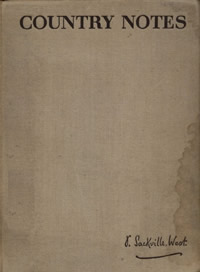 Country Notes is a collection of charming short articles, most of them originally published in New Statesman and Nation magazine in 1938 and 1939. They describe life on the farm as seen by Sackville-West from her estate, Sissinghurst, in Kent, England. She has a knack for description of botanical detail. For example, of the witch hazel she says the "dark brown twigs look as though some child had amused itself by tying them up with bunches of yellow ribbons, and then snipping the ends short." The articles describe farm events such as harvesting hops and dealing with animals, including the horses still pulling plows. She also introduces local characters, like her gardener and the seasonal workers who camp out on the property during harvest time.
Country Notes is a collection of charming short articles, most of them originally published in New Statesman and Nation magazine in 1938 and 1939. They describe life on the farm as seen by Sackville-West from her estate, Sissinghurst, in Kent, England. She has a knack for description of botanical detail. For example, of the witch hazel she says the "dark brown twigs look as though some child had amused itself by tying them up with bunches of yellow ribbons, and then snipping the ends short." The articles describe farm events such as harvesting hops and dealing with animals, including the horses still pulling plows. She also introduces local characters, like her gardener and the seasonal workers who camp out on the property during harvest time. It is particularly intriguing to read this book in the context of its times. By the end of 1939, England was at war. In only one or two spots does the author mention "Herr Hitler" or the threat of conflict. But a cloud of worry must have hung over her writing. In addition, Sackville-West herself, in spite of her protesting that she loves the old ways, was part of the very modern Bloomsbury group, and was herself somewhat infamous for her multiple lovers, including Virginia Woolf. Beyond that background, Sackville-West was a well-known gardener, and wrote several books on gardening, including some in our library. A recent account of the history of her garden appears in Sissinghurst: An Unfinished History, by her grandson Adam Nicholson, also in our collection. So there is much to think about while enjoying these sketches of the Kentish countryside.
Published in the July 2018 Leaflet, Volume 5, Issue 7.
Link to this review (permalink)
The Quiet Extinction: Stories of North America's Rare and Threatened Plants by Kara Rogers, 2015
Reviewed by: Brian Thompson on 2018-07-06
![[The Quiet Extinction] cover](https://depts.washington.edu/hortlib/graphix/quietextinction.jpg)
The Quiet Extinction: Stories of North America's Rare and Threatened Plants profiles plants native to the United States and Canada which are in danger of extinction. The causes vary, but humans are the main culprit, especially by driving climate change and loss of habitat.
While the topic is grim, author Kara Rogers has a knack for telling compelling stories, while still presenting good science. She wisely concentrates on a handful of species to drive her narrative, explaining that these are bellwethers of a much greater problem.
Some of these have special interest for Pacific Northwest readers. White bark pines (Pinus albicaulis) are a key species in the ecology of the Olympic and Cascade Mountains. They are facing a double whammy from white pine blister rust and outbreaks of mountain pine beetles. Hikers at high altitudes may recognize the problem, "but the real tragedy is that few people are aware that the region's iconic tree and beautiful plants are disappearing and that they are doing so rapidly."
As with many of these plants, their interaction with animals, including pollinators and herbivores, and with naturally occurring phenomena such as fire, are important parts of the story. This is an excellent book for anyone interested in the interconnections within North American ecosystems, as well as those fighting to reverse the plight of endangered plants.
Published in the July 2018 Leaflet for Scholars, Volume 5, Issue 7.
Link to this review (permalink)
Butterflies of the Pacific Northwest by Robert Michael Pyle, 2018
Reviewed by: Brian Thompson on 2018-08-01
![[Butterflies of the Pacific Northwest] cover](https://depts.washington.edu/hortlib/graphix/butterfliesofthepacificnorthwest.jpg)
Summer is a great time to see butterflies and now there is an excellent new field guide. Butterflies of the Pacific Northwest by Robert Michael Pyle and Caitlin C. LaBar is the perfect tool to guide you in identifying and learning about the more than 200 species that are native to Washington and Oregon. It "is intended for everyone who wishes to study, watch, collect, photograph, garden, or otherwise enjoy butterflies responsibly."
This Timber Press Field Guide has a sturdy, rain-resistant cover designed for field use. The Miller Library copy is an important reference source and not available to check out, but you can use it to compare with your field notes. Alternatively, check out Pyle's earlier (2002) The Butterflies of Cascadia. The major difference between two books is the quality of the photographs. The advent of digital photography and the special expertise that new co-author LaBar brings have produced stunning results.
Each description includes range maps (within Washington and Oregon), habitat, host plants, and when the species is "on the wing." Carefully documented are the often significant differences between males and females, and between dorsal (with the wings open) and ventral (wings closed) views.
Pyle also writes poetry, and his pleasure in the subtleties of language is evident in the anecdotal section under each species. He describes unusual sightings, gives hints for distinguishing between similar species, and relishes quirks of nomenclature. If you are city bound this summer, he even identifies those species that thrive despite intense urban environments.
Published in the August 2018 Leaflet for Scholars, Volume 5 Issue 8.
Link to this review (permalink)
The Bee Tree by Stephan Buchmann, 2007
Reviewed by: Dorothy Crandell on 2018-08-02
![[The Bee Tree] cover](https://depts.washington.edu/hortlib/graphix/beetree.jpg)
The Bee Tree is composed of two parts. The first part will appeal to a younger audience, and presents in words and pictures the tradition of harvesting honey in the Malaysian rainforest. Bees build the honeycombs on the tualang trees, the tallest trees reaching heights of about 250 feet. Hauling their special tools, honey hunters climb the trees with skill and courage. Gathering the honeycombs is a cooperative venture with rituals that express gratitude for the food and medicine that honey provides. The hunters share their bounty with friends and neighbors, and also sell the honey in local markets. The honey hunt is central to the culture and way of life of the indigenous people of Malaysia.
The second part of the book covers basic background information for adults on Malaysia and its peoples, the rainforest, the giant honeybee, and the tradition and future of the honey hunters. As for the future for honeybees: "As long as there is the rainforest, there will be bees, and as long as there are bees, there will be honey, and as long as there is honey, there will be honey hunters." The giant honeybee, Apis dorsata, is crucial as a pollinator. It is a keystone species, important in the preservation of the entire ecosystem in the rainforest. It is another beautiful example of the interaction of plants and pollinators and their importance to a culture that preserves natural systems.
Published in the August 2018 Leaflet, Volume 5, Issue 8.
Link to this review (permalink)
An Orchard Odyssey : Find and Grow Tree Fruit in Your Garden, Community and Beyond by Naomi Slade, 2017
Reviewed by: Dorothy Crandell on 2018-09-05
![[An Orchard Odyssey] cover](https://depts.washington.edu/hortlib/graphix/orchardodyssey.jpg)
Editor's note: This book was purchased with a grant from The Washington State Nursery & Landscape Association, which offers a certification program for horticulturists. These experts help clients to solve garden challenges successfully with experience, education, and knowledge of horticulture.
Orchards create special dimensions to a sense of place. Growing fruit trees and nut trees is both art and science, and heightens our contact with and appreciation of the interrelated ways of nature. An Orchard Odyssey: Find and Grow Tree Fruit in Your Garden, Community and Beyond by Naomi Slade of the United Kingdom provides insights into not only the reasons for orchard-growing but also the methods. The book highlights the benefits for people and the environment, as well as the local economy and community. It is inspiring to both plant and food enthusiasts.
I was fortunate to grow up on an old orchard homestead in upstate New York, and I have vivid memories of picking Northern Spy apples and packing them into rugged burlap bags in the chilly late fall weather. Climbing the trees to reach the highest branches was an exercise in possibility, capability, vulnerability, and achievement. Warm apple pies and hot mulled cider comforted us all winter long – the ultimate reward. So the odyssey is familiar.
Naomi Slade divides An Orchard Odyssey into two parts. The first part is called The Orchard in the Landscape. Chapter one covers orchard history, From Wilderness to Cultivation. Chapter two, An Orchard Tapestry, describes traditional and chance approaches to design. The Conservation and Biodiversity chapter details an ecological community. The Orchards in the Community chapter is made up of growing, sharing, and foraging, discussing the environment, the local economy, and fruit heritage in the neighborhood.
The second part is called An Orchard of Your Own. It includes the following chapters: Creative Orchard Design; Fruit Trees for Every Space; Tree Planting and Care; and Enjoying the Harvest, with a recipe for Rumtopf, a traditional German delight consisting of fruit preserved with rum and sugar to serve during the winter holidays.
There are many ways to gain hands-on experience with orchards. The Western Cascade Fruit Society and affiliated chapters throughout Western Washington have as their objective "to bring together new and experienced fruit growers who will promote the science, cultivation and pleasure of growing fruit-bearing trees, vines, and plants in the home landscape." The mission of City Fruit in Seattle is to "promote the cultivation of urban fruit in order to nourish people, build community and protect the climate." The Piper's Orchard within Carkeek Park, which was restored in 1983 as a community project. Washington State University offers diagnostic resources for fruit tree pests and diseases through their Hortsense website and Master Gardener outreach in every county. The Western Washington Fruit Research Foundation offers a list of recommended varieties for the region. Washington State is, of course, a leader in orchard production.
By planning, planting, and preserving orchards, a community invests in the future to counter environmental threats. The process provides environmental benefits and economic potential, cultivates continuing education in life science, expands knowledge of one's neighborhood, fosters aesthetic value, encourages community and puts food on the table. What could be a better way to spend time?
Published in the September 2018 Leaflet for Scholars, Volume 5, Issue 9.
Link to this review (permalink)
A People's Curriculum for the Earth by Bill Bigelow, 2015
Reviewed by: Dorothy Crandell on 2018-10-26
![[A People's Curriculum for the Earth] cover](https://depts.washington.edu/hortlib/graphix/people'scurriculumfortheearth.jpg)
The current report of the United Nations Intergovernmental Panel on Climate Change (IPCC) draws our attention to the state of scientific knowledge on climate change. The report confirms that humans are the dominant cause of global warming. The situation is grave, but there is hope. There is time for us to move into action now. A People's Curriculum for the Earth: Teaching Climate Change and the Environmental Crisis, a guide for teachers, is an assemblage of articles written by various authors that include important practical activities and ideas on the value of our earth and the urgency of our situation. It is edited by Bill Bigelow and Tim Swinehart, well-known social studies educators in Portland, Oregon. The book is a Rethinking Schools publication, their mission being "fully committed to equity and to the vision that public education is central to the creation of a humane, caring, multiracial democracy."
Using a social studies perspective to consider scientific evidence, the approach of the curriculum takes sides on behalf of the earth. It strongly advocates for planet earth, responding to the evidence, alerting students to social and environmental injustice, while searching for explanations and encouraging activism. Groups of people together – schools, neighborhoods, clubs and other associations – can make constructive changes. Two key themes run through this curriculum, the introduction explains:
- "Our curriculum must confront the false dichotomy between the environment and people."
- "Everyone on earth is affected by the environmental crisis, but we are affected unequally – based on race, class, nationality, or location."
The guide provides information, insights, inspiration and is an invitation to become actively engaged. It addresses a range of grade levels and audiences. This book calls us to see ourselves "as part of a broader movement to build the kind of society that is clean and just and equal and democratic; one that seeks to leave the world better than we found it." The earth is humanity's responsibility. The message is that by working together there is a lot we can do. This book is well worth our immediate attention, particularly in this sometimes skeptical political climate.
Published in the November 2018 Leaflet, Volume 5, Issue 11.
Link to this review (permalink)
Gardening in the Pacific Northwest by Paul Bonine and Amy Campion, 2017
Reviewed by: Brian Thompson on 2018-04-01
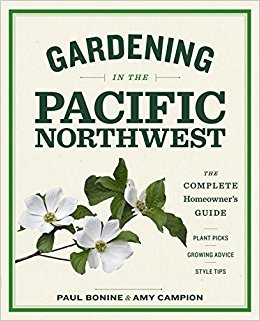 I always look forward to new books intended for Pacific Northwest gardeners. Paul Bonine and Amy Campion's "Gardening in the Pacific Northwest" has been long anticipated, and it doesn't disappoint. As explained in the introduction, this book is mostly from Bonine's perspective, as he grew up here and has gardened in this region for many years. Campion did most of the excellent photography.
I always look forward to new books intended for Pacific Northwest gardeners. Paul Bonine and Amy Campion's "Gardening in the Pacific Northwest" has been long anticipated, and it doesn't disappoint. As explained in the introduction, this book is mostly from Bonine's perspective, as he grew up here and has gardened in this region for many years. Campion did most of the excellent photography.
I found myself reading this book out of order, starting with the final chapter titled "Design: Northwest Garden Style." Intended as an introduction to design styles, this essay is also an excellent, local history of ornamental gardening and why our gardens look the way they do.
Keeping this in mind, I returned to the introductory chapters on climate, soils, and garden culture with a better understanding. Here, I found the authors' selection of climatic sub-regions especially interesting. As expected, Seattle is part of the Puget Sound sub-region, but Portland and its immediate suburbs have a sub-region of their very own, totally surrounded by the Willamette Valley sub-region. While I was at first surprised by this, after reading the distinguishing factors, I decided these divisions make a lot of sense, and will help gardeners make better plant selections.
The plant encyclopedia is especially good for woody plants. While most species are represented by a single cultivar, these are excellent selections. After admiring Albizia julibrissin 'Summer Chocolate' at a couple of Portland gardens last summer, I appreciated learning why it is rarely seen around Seattle. Our immediate sub-region "normally doesn't receive enough summer heat for its wood to harden off properly in preparation for winter's cold, leaving it vulnerable to even mild freezes." Tips like these, make this selection of plant varieties especially valuable.
Excerpted from the Spring 2018 Arboretum Bulletin.
Link to this review (permalink)
The Northwest Garden Manifesto by John Albers, 2018
Reviewed by: Brian Thompson on 2018-04-01
 "The Northwest Garden Manifesto" by John Albers is a new book for our region. While the title may conjure up images of gardeners marching rake-to-rake for their causes, this instead is a very solid and comprehensive gardening book that keeps closely in mind the bigger ecosystem surrounding any private garden. Divided into three broad sections, the book asks you to assess what you have, then make changes that are sustainable (for your garden) and healthful (for you), and finally – for all your actions – think outside the property line.
"The Northwest Garden Manifesto" by John Albers is a new book for our region. While the title may conjure up images of gardeners marching rake-to-rake for their causes, this instead is a very solid and comprehensive gardening book that keeps closely in mind the bigger ecosystem surrounding any private garden. Divided into three broad sections, the book asks you to assess what you have, then make changes that are sustainable (for your garden) and healthful (for you), and finally – for all your actions – think outside the property line.
The author is very good at presenting new approaches to regular garden chores. While these may seem mundane, they fit very well into the overarching structure and message of the book. A handy summary checklist at the end of each chapter helps you track this bigger picture. Many of the examples are from his own four-acre garden on the edge of Bremerton, well-captured by the photography of David Perry.
The selection of recommended plants includes native and non-natives as Albers emphasizes that in developed sites, many of the conditions that help natives thrive have been destroyed. Other recommendations include many food-producing plants, everything from annual vegetables to fruit trees. He also advises engineering your lawn – if you must have one – to be either a green space with low demands on resources, or a self-sustaining meadow.
This book's primary audience is urban dwellers, but that is most of us. "With more than half of humankind living in cities, our first steps must be developing sustainably and restoring urban biodiversity." So perhaps manifesto is an accurate description of Albers' goals. I recommend you read his book and make your own decisions.
Excerpted from the Spring 2018 Arboretum Bulletin.
Link to this review (permalink)
Love Letters to my Garden by Barbara Blossom Ashmun, 2017
Reviewed by: Brian Thompson on 2018-04-01
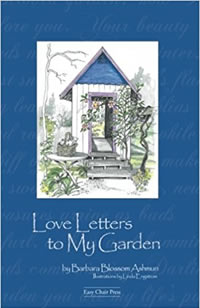 It is no secret that Barbara Blossom Ashmun is an avid gardener. Besides having a floriferous name, there are the intimate titles of her memoirs: "Married to My Garden" (2003) and "Love Letters to My Garden" (2017). This Portland garden designer and writer did not grow up as a gardener, but instead found her calling well into adulthood. A divorce and the desire to leave the world of a social worker helped this process.
It is no secret that Barbara Blossom Ashmun is an avid gardener. Besides having a floriferous name, there are the intimate titles of her memoirs: "Married to My Garden" (2003) and "Love Letters to My Garden" (2017). This Portland garden designer and writer did not grow up as a gardener, but instead found her calling well into adulthood. A divorce and the desire to leave the world of a social worker helped this process.
This may be why she writes with the conviction of a convert. "No one ever died from having too many plants. And never allow partners, spouses, friends, or curmudgeons discourage you from experimenting with new plants. If anyone grills you about how many plants you bought, don't take the bait. Give them a Mona Lisa smile and change the subject."
The author has a knack for writing for both the experienced and novice gardener. She uses a light hand with Latin names, relying on her non-gardening husband's feedback to keep these in check. But that doesn't mean she resists the latest new cultivar from cutting edge nurseries. She understands plant lust very well, but she also found an antidote to that in the Kleingarten movement in Germany. Gardeners whose faces "shone with happiness" cultivate these small spaces with the most common of flowers and vegetables.
Ashmun concludes "Love Letters" with a poignant story (also found in the Winter 2013 issue of "Pacific Horticulture") about the loss of a giant sweet gum that dominated her back yard. Over the short period of time it took to cut down the failing tree, her yard went from shady to sunny. It was a shock. However, this gardener, now in her seventies, had the necessary resilience to create a new patio in the space the sweet gum had occupied, with more space for – yes! – more plants.
Excerpted from the Spring 2018 Arboretum Bulletin.
Link to this review (permalink)
Our Native Bees by Paige Embry, 2018
Reviewed by: Brian Thompson on 2018-04-01
![[Our Native Bees] cover](https://depts.washington.edu/hortlib/graphix/ournativebees.jpg)
Paige Embry is an engaging and humorous writer exploring the topic of bees. And not just any bees. She is passionate about "Our Native Bees", which is also the title of her new book. She gives honey bees their due, but laments they "get all the press – the books, the movie deals – and they aren't even from around here."
While I haven't seen many movies on honey bees, the author makes her point. We have native bees that are far better pollinators, do equal work with fewer numbers, fly in nastier weather, and often use better technique. An example of the latter is buzz pollination, or shaking the pollen from the flower. Honey bees haven't learned this trick, but bumble bees and others have and their work facilitates some of our favorite foods, including tomatoes.
This is not a field guide. While the author lives in Seattle, her scope for natives includes most of North America. There are some excellent, close-up photographs, but their purpose is to supplement the text, not help with ID. Instead, this is an investigative study of many apian topics and to recognize that bees are diverse and have the power to fascinate people, even when we mislabel or misunderstand them.
One of the author's major themes is agriculture. For example, she studies the production of lowbush blueberries in Maine and neighboring New Brunswick, an interwoven history of wild plants, wild bees, managed plants, managed bees, and the impact of various attempts at pest management. Recounting this could be deadly dull, but in Emery's hands, it is most engaging.
Throughout all the stories, there are questions asking what is possible. Can native bees provide better solutions for our pollinating needs? Can we provide better solutions for the needs of native bees? The author provides some answers to these questions, but I think her underlying goal is that we join her on a journey to a better understanding and appreciation of the diversity of bees, especially native bees.
Excerpted from the Spring 2018 Arboretum Bulletin.
Link to this review (permalink)
Peonies: The Best Varieties for Your Garden by David C. Michener & Carol A. Adelman, 2017
Reviewed by: Brian Thompson on 2018-04-01
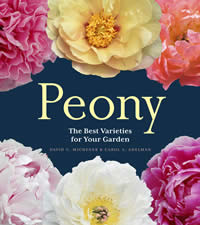 Carol Adelman and her husband own a peony nursery in Salem, Oregon. She has teamed up with David Michener of the University of Michigan to write "Peony: The Best Varieties for Your Garden." Much of this book is a beautiful photo album of the most highly regarded peony hybrids, including tree and intersectional (or Itoh) peonies. While it is easy to thumb quickly through these images, you will miss a lot of information in the notes, including comments on the foliage quality or awards that designate the selection as good for landscapes.
Carol Adelman and her husband own a peony nursery in Salem, Oregon. She has teamed up with David Michener of the University of Michigan to write "Peony: The Best Varieties for Your Garden." Much of this book is a beautiful photo album of the most highly regarded peony hybrids, including tree and intersectional (or Itoh) peonies. While it is easy to thumb quickly through these images, you will miss a lot of information in the notes, including comments on the foliage quality or awards that designate the selection as good for landscapes.
This latter point is important, as in their introduction, the authors ask some important questions of the reader. What is the purpose of your peonies? Do you want a big but short burst of bloom, perhaps to coincide with a special event? Or do you hope to stretch the bloom period out as long as possible, realizing that at best, this will be just over a month? Answering these questions will help you decide the role of peonies in your overall landscape. They are green through the summer and into the fall, often with attractive foliage. What companions will you match with them?
I appreciated that the authors also discuss the early spring, emerging foliage, which can be quite stunning. You are encouraged to choose early spring ephemerals that are a good match, being mindful they don't die an ugly death just when the peonies are blooming. There's a lot to consider!
Excerpted from the Spring 2018 Arboretum Bulletin.
Link to this review (permalink)
What's Wrong with My Marijuana Plant? by David Deardorff and Kathryn Wadsworth, 2017
Reviewed by: Brian Thompson on 2018-04-01
 I reviewed "What's Wrong with My Plant" in the Winter 2017 issue of the Bulletin, but I didn't realize that this 2009 publication was just the beginning for the writing team of David Deardorff and Kathryn Wadsworth of Port Townsend, Washington. They have published four more "What's Wrong with My…" books, including "Vegetable Garden" (2011), "Fruit Garden" (2013), "Houseplant" (2016) and "Marijuana Plant" (2017). The structure of each is similar to the original with chapters to identify the symptoms and causes of the problems, and separate chapters laying out organic solutions or preferred cultural practices.
I reviewed "What's Wrong with My Plant" in the Winter 2017 issue of the Bulletin, but I didn't realize that this 2009 publication was just the beginning for the writing team of David Deardorff and Kathryn Wadsworth of Port Townsend, Washington. They have published four more "What's Wrong with My…" books, including "Vegetable Garden" (2011), "Fruit Garden" (2013), "Houseplant" (2016) and "Marijuana Plant" (2017). The structure of each is similar to the original with chapters to identify the symptoms and causes of the problems, and separate chapters laying out organic solutions or preferred cultural practices.
"Marijuana Plant" was likely the most challenging to write, as there is limited research on its production using organic principles. Deardorff and Wadsworth celebrate the work that has been done: "We also want to acknowledge a lot of people we don't even know. We are grateful for the many marijuana breeders and growers who have labored for years in the shadows."
Excerpted from the Spring 2018 Arboretum Bulletin.
Link to this review (permalink)
Monarchs and Milkweed by Anurag Agrawal, 2017
Reviewed by: Brian Thompson on 2018-07-01
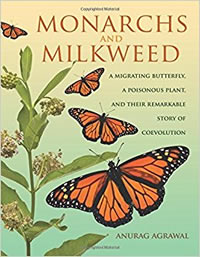 "Monarchs and Milkweed" is like a mystery novel of the highest order. Who will survive? The butterfly or the weed? Even better, this is not fiction!
"Monarchs and Milkweed" is like a mystery novel of the highest order. Who will survive? The butterfly or the weed? Even better, this is not fiction!
Anurag Agrawal's writing is very compelling. I read the pages of his book as quickly as any whodunit. The characters include the baby caterpillar monarchs, trying to survive their first encounter with their only source of food, the leaves of milkweed. Many do not.
The milkweed plant has many ways to protect itself including its own gooey latex-like sap, or by coaxing monarch predators to do the job. There is good reason for this – the plant gains nothing from its interaction as the adult butterflies are not helpful pollinators.
In contrast, the larval and adult butterflies gain a toxicity that protects them from significant predation by birds. But this toxicity is not effective against other insects or various parasites. The plant seems to know this. The battle of coevolution moves on.
Agrawal is a scientist who interweaves his personal life and research. He discovered the caterpillar of an unknown species, brought it into his living room, watched it pupate, and then emerge from its chrysalis as a butterfly. This was a serendipitous lesson in mimicry as it was a viceroy butterfly, with similar coloration to a monarch and thereby gaining some of its protection, even though it lacks toxicity for birds.
This year's winner of the CBHL Award of Excellence in Gardening and Gardens, "Monarchs and Milkweed" has wide appeal, even for parts of the country like ours outside of the natural range of monarchs.
Excerpted from the Summer 2018 Arboretum Bulletin.
Link to this review (permalink)
The Life in Your Garden by Reeser Manley and Marjorie Peronto, 2016
Reviewed by: Brian Thompson on 2018-07-01
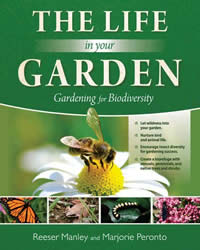 "The Life in Your Garden" has an emphasis on milkweeds, promoting these plants as excellent for overall garden health and biodiversity. Authors Reeser Manley and Marjorie Peronto garden in Maine, but Manley received his PhD in Horticultural Science from Washington State University.
"The Life in Your Garden" has an emphasis on milkweeds, promoting these plants as excellent for overall garden health and biodiversity. Authors Reeser Manley and Marjorie Peronto garden in Maine, but Manley received his PhD in Horticultural Science from Washington State University.
The authors strongly detest the word "pest" but instead see insects and other small garden creatures as pollinators, herbivores, and/or predators. All of these are both good and fascinating. Observing this life has been the source of many realizations for the authors about the positive impact even a small garden can have on its environment.
The book pays special attention to "functional" plants that provide more than just ornamentation, with a special emphasis on understory plants, which "are every bit as important as canopy trees in fostering garden biodiversity." The lengthy encyclopedia section features east coast natives, but in most cases, western counterparts are found in the appendices. The authors also seek functionality in their annuals and perennials, "creating plantings that sustain garden life from the first emerging bumble bees in late April until the last hoverflies of late September."
Excerpted from the Summer 2018 Arboretum Bulletin.
Link to this review (permalink)
Lawrence Halprin by Kenneth I. Helphand, 2017
Reviewed by: Brian Thompson on 2018-07-01
 The Masters of Modern Landscape Design is a series of biographies featuring landscape architects prominent in the mid to late 20th century in North America. Lawrence Halprin (1916-2009) was a west coast landscape architect who lived productively into his 90s. He is best known in Seattle for Freeway Park, but he was also responsible for the master landscaping plan for the Seattle World's Fair, a project he worked on from 1958-1962. Author Kenneth Helphand is a professor emeritus in landscape architecture at the University of Oregon and wrote about "Defiant Gardens: Making Gardens in Wartime" (2007), an award winner which I reviewed in the Spring 2012 "The Bulletin."
The Masters of Modern Landscape Design is a series of biographies featuring landscape architects prominent in the mid to late 20th century in North America. Lawrence Halprin (1916-2009) was a west coast landscape architect who lived productively into his 90s. He is best known in Seattle for Freeway Park, but he was also responsible for the master landscaping plan for the Seattle World's Fair, a project he worked on from 1958-1962. Author Kenneth Helphand is a professor emeritus in landscape architecture at the University of Oregon and wrote about "Defiant Gardens: Making Gardens in Wartime" (2007), an award winner which I reviewed in the Spring 2012 "The Bulletin."
Freeway Park was the first capping of an interstate freeway, a model replicated widely since that time. This biography recounts the initial praise for the project (opened in 1976), the expansion by Halprin associate Angela Danadjieva, the subsequent decline of the park into disuse, and revitalizing revisions to the plantings of the last decade. Before his death, Halprin contributed to this last effort, which leaves the structure of the park in place.
Massive waterfalls are a Halprin signature. I've long admired those at Freeway Park but was surprised last summer to discover Forecourt (now Ira Keller) and Lovejoy Fountains in Portland. He designed these in the 1960s and linked them by an eight-block pedestrian mall. "Like all water features they invite attention—and for Halprin, participation."
He demonstrated this at the dedication of the Forecourt Fountain in 1970. Vietnam War protests at nearby Portland State University created tension between the students and police gathered for the event. Halprin's words, and even more so his action of walking into the cascading water, helped to calm the crowd and spark a celebration of community.
Excerpted from the Summer 2018 Arboretum Bulletin.
Link to this review (permalink)
Ruth Shellhorn by Kelly Comras, 2016
Reviewed by: Brian Thompson on 2018-07-01
 The Masters of Modern Landscape Design is a series of biographies featuring landscape architects prominent in the mid to late 20th century in North America. Ruth Shellhorn (1909-2006) was a west coast landscape architect, who lived productively into her 90s. This biography is written by Kelly Comras, a landscape architect based in Los Angeles. Much of Shellhorn's work was also in greater Los Angeles, but she attended what is now Oregon State University for her undergraduate degree.
The Masters of Modern Landscape Design is a series of biographies featuring landscape architects prominent in the mid to late 20th century in North America. Ruth Shellhorn (1909-2006) was a west coast landscape architect, who lived productively into her 90s. This biography is written by Kelly Comras, a landscape architect based in Los Angeles. Much of Shellhorn's work was also in greater Los Angeles, but she attended what is now Oregon State University for her undergraduate degree.
Comras observes that if Shellhorn had made a greater effort of self-promotion, she would be more famous today. She quotes David Streatfield, a landscape architecture historian at the University of Washington, who "noted the 'terrible imbalance in terms of the public's perception between Ruth Shellhorn…and many of her contemporaries, such as Garrett Eckbo, Lawrence Halprin, and Thomas Church, who wrote books about their own work, hired professional photographers, and published extensively.'"
One of the most fascinating chapters is about Shellhorn's work on Disneyland. She was hired just four months before the opening in 1955, after Walt Disney belatedly recognized the need to "unify the distinctive elements" of the variously themed areas. She proved very skillful in not only unifying buildings that were already in place but also in creating a visitor experience that increases the sense of discovery while mitigating the challenges of large crowds. Comras describes the landscape design by Shellhorn to be largely intact today despite on-going changes to the park.
Excerpted from the Summer 2018 Arboretum Bulletin.
Link to this review (permalink)
The Rose Rustlers by Greg Grant & William C. Welch, 2017
Reviewed by: Brian Thompson on 2018-07-01
 "The Rose Rustlers" is a fun book, a bit of a garden journal, a bit diary mixed with a family photo album. Nominated for an AHS award, the authors Greg Grant and William Welch take turns sharing their stories, their favorite plants (mostly roses), and their favorite people.
"The Rose Rustlers" is a fun book, a bit of a garden journal, a bit diary mixed with a family photo album. Nominated for an AHS award, the authors Greg Grant and William Welch take turns sharing their stories, their favorite plants (mostly roses), and their favorite people.
Their heroes are a dedicated group promoting old roses, many of the plants surviving with no care in cemeteries or abandoned home sites throughout Texas. While this is a very different climate from ours, every gardener will appreciate the tenacity of plants that are good-doers and the humans that cherish them.
One quirk of this book is the nomenclature. Rose variety names in single quotation marks are cultivars, the same as with most plants. Other varieties have double quotation marks, meaning these are study names. These substitute for real names that have been lost in time. No quotation marks means this rose is legendary and needs no further clarification, including "popular roses like the butterfly rose, the sweetheart rose, and the green rose."
There is a lot of good horticultural advice and garden design in this book, but best are the stories. The "Air Conditioner Rose", was name because Grant's first planting of it covered unsightly equipment. It also survived being under salt water for two weeks after Hurricane Katrina. A suckering rose in Scottsville, Texas has possibly survived since 1834. The magenta flowers are sometimes flushed with blue edges.
These roses are resilient. "Roses didn't start out as wimpy flowers. Humans did that to them. In addition to being beautiful in a simplistic way, roses were initially wiry and mean as snakes. This made them perfect Texans, of course. If an antique rose is still around, it's because it's tough and because it's pretty."
Excerpted from the Summer 2018 Arboretum Bulletin.
Link to this review (permalink)
The Trees of North America by Susan M. Fraser and Sally Armstrong Leone (eds.), 2017
Reviewed by: Brian Thompson on 2018-07-01
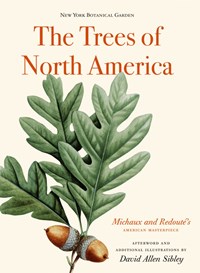 "The Trees of North America" is an excellent new book and winner of one of the three book awards given by the AHS in 2018. Who is the author? It's complicated.
"The Trees of North America" is an excellent new book and winner of one of the three book awards given by the AHS in 2018. Who is the author? It's complicated.
The short answer is François-André Michaux (1770-1855) and Thomas Nuttall (1786-1859) with considerable help from skilled engravers, the most famous being Pierre-Joseph Redouté (1759-1840). Their collective publications span the first half of the 19th century, produced in both France and the United States, and first in French and later in English. The full bibliographic story is in the preface of this new book.
The New York Botanical Garden (NYBG) in their LuEsther T. Mertz Library has perhaps the most complete collection of the (at least) 16 different editions by Michaux and Nuttall. Mertz Library staff have produced this new book, using faithful reproductions of the plates. The horticulture staff for NYBG add notes with current updates of nomenclature, ranges, and horticultural uses.
Enough words. This is mostly a picture book, but what a glorious one it is. We are fortunate to have an 1857-1865 original in the Miller Library rare book collection. While a reprint can never quite match a hand-colored original, this comes very close.
These accurate images made the original the standard reference book for North America trees until the early 20th century. A concluding essay by David Allen Sibley explains the process of making the reprinted images – a process as complex as the authorship. Sibley declares, "The end results are beautiful, and the prints are true works of art on their own, but they are different from the originals."
Excerpted from the Summer 2018 Arboretum Bulletin.
Link to this review (permalink)
The illustrated history of apples in the United States and Canada by Daniel J. Bussey, 2016
Reviewed by: Brian Thompson on 2018-07-01
 "The Illustrated History of Apples in the United States and Canada" is a seven-volume set with description of all apples found in North American publications through 2000. The information will have immense importance to any pomology researcher, but the more casual reader will find pleasure in the beautiful images: 1,400 watercolors created by artists employed by the United States Department of Agriculture from 1886-1942.
"The Illustrated History of Apples in the United States and Canada" is a seven-volume set with description of all apples found in North American publications through 2000. The information will have immense importance to any pomology researcher, but the more casual reader will find pleasure in the beautiful images: 1,400 watercolors created by artists employed by the United States Department of Agriculture from 1886-1942.
Excerpted from the Summer 2018 Arboretum Bulletin.
Link to this review (permalink)
Mannahatta: A Natural History of New York City by Eric Sanderson, 2009
Reviewed by: Brian Thompson on 2018-12-06
![[book title] cover](https://depts.washington.edu/hortlib/graphix/Mannahatta.jpg)
What did the island of Manhattan look like on that day, just over 400 years ago (1609) when it was "discovered" by Henry Hudson? Very different from today. It was a rich place with forests, streams, wetlands, and even some hills. Wildlife was abundant, with nearly 400 species of vertebrates likely and another 200 possible. Vascular plant species may have numbered nearly 1,200.
It was also the home to the Lenape people who gave the island its name: Mannahatta. Eric Sanderson headed a decade-long project to try to describe the likely nature of the island before the arrival of Europeans. That project is described in Mannahatta: A Natural History of New York City (2009). He claims that if found today, the island would likely be designated as a national park, but instead, "extraordinary cultural diversity has replaced extraordinary biodiversity."
Published in the December 2018 Leaflet for Scholars, Volume 5, Issue 12.
Link to this review (permalink)
Abernethy Forest: The History and Ecology of an Old Scottish Pinewood by Ron Summers, 2018
Reviewed by: Brian Thompson on 2018-12-06
![[book title] cover](https://depts.washington.edu/hortlib/graphix/AbernethyForest.jpg)
Ron Summers writes about a very different ecological history in Abernethy Forest: The History and Ecology of an Old Scottish Pinewood (2018). This is an effort to understand and protect a barely surviving old ecosystem, mostly destroyed by centuries of human activities. This small subject, about 38 square kilometers, or just a bit bigger than Mercer Island, includes the fast-flowing River Spey and Loch Garten, which at 47 hectares is about half the size of Green Lake.
While small, Abernethy includes "the largest of the remaining fragments of the pine forest that once extended across Highland Scotland" and is "incredibly rare in Britain and therefore precious for nature conservation and science." It is also beautiful, as I have discovered over several visits in the last 20 years, and supports some fascinating animals, including the Capercaillie (the largest member of the grouse family), three species of crossbills that are well-suited for extracting the seeds of pinecones, and the Scottish wildcat, described as resembling a robust domestic tabby.
Published in the December 2018 Leaflet for Scholars, Volume 5, Issue 12.
Link to this review (permalink)
The Japanese Garden by Sophie Walker, 2017
Reviewed by: Brian Thompson on 2018-10-01
![[The Japanese Garden] cover](https://depts.washington.edu/hortlib/graphix/JapanesegardenWalker.jpg)
Sophie Walker trained as a garden designer in Britain, displaying her skills to acclaim at the epitome of English gardening institutions: the Chelsea Flower Show. To broaden her design skills, she studied Japanese style gardening. She describes her new book, "The Japanese Garden," as essentially a workbook of those studies.
The author presents a series of chapters on different themes with essays by others from many backgrounds interspersed and augmenting her studies. Topics vary widely, from our relationship with nature or the tenets of Buddhism as they apply to gardens, to the use of courtyard gardens or favorite flowers and trees. Concluding each of her chapters are photographs of gardens that embody concepts she presents.
Throughout, she looks for connections or contrasts with Western (European and American) traditions, or how icons of Western design or art have been influences by Japanese traditions, including Frank Lloyd Wright, Claude Monet and, in present day, David Hockney. She observes, "visiting a Western cultural landmark – a palace or cathedral – cultural and historic context is unavoidable. But in the Japanese garden, context is deliberately confused, as is scale."
Excerpted from the Fall 2018 Arboretum Bulletin.
Link to this review (permalink)
Visionary Landscapes by Kendall Brown, 2017
Reviewed by: Brian Thompson on 2018-10-01
 In "Visionary Landscapes," Kendall Brown profiles the lives and gardens of five designers born in the mid-20th century – three in Japan, two in the United States – who have practiced their craft primarily in North America. The new gardens they have designed, mostly in the last 30 years, are pushing the evolving concept of Japanese-style gardening.
In "Visionary Landscapes," Kendall Brown profiles the lives and gardens of five designers born in the mid-20th century – three in Japan, two in the United States – who have practiced their craft primarily in North America. The new gardens they have designed, mostly in the last 30 years, are pushing the evolving concept of Japanese-style gardening.
Hōichi Kurisu is perhaps best known regionally as the curator of the Japanese Garden in Portland from 1968-1972. After he left the garden, he stayed in Portland and his company has thrived in designing, building, and even maintaining mostly residential gardens in that area and inspiring gardens throughout the country.
A couple of years ago, I was fortunate to hear David Slawson, another of the profiled designers, speak at the Cleveland Botanical Garden and see the garden he designed there. Brown describes Slawson's gardens as presenting "a greater awareness of regional landscape gained from having seen it beautifully manifest in microcosm."
The examples in this book show that the expressions of traditional Japanese garden design are subtle, but this also gives more options. We live where most Japanese plants thrive, but not all gardeners are so fortunate. For example, after listening to the talk, a librarian colleague of mine was excited that she could incorporate Slawson's ideas to her home desert garden in Phoenix.
Excerpted from the Fall 2018 Arboretum Bulletin.
Link to this review (permalink)
Japanese gardens and landscapes, 1650-1950 by Wybe Kuitert, 2016
Reviewed by: Brian Thompson on 2018-10-01
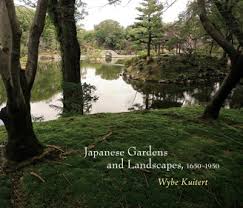 Wybe Kuitert has written two deeply researched books on the history of Japanese gardens. The first, "Themes in the History of Japanese Garden Art" (1st edition 1988, revised 2002 – this later edition is at the Miller Library), is the history from roughly 900 to 1650 CE, concluding when "the practice and theory of garden art became established in a way that does not differ much from our own days."
Wybe Kuitert has written two deeply researched books on the history of Japanese gardens. The first, "Themes in the History of Japanese Garden Art" (1st edition 1988, revised 2002 – this later edition is at the Miller Library), is the history from roughly 900 to 1650 CE, concluding when "the practice and theory of garden art became established in a way that does not differ much from our own days."
Kuitert's new book, "Japanese Gardens and Landscapes, 1650-1950," brings that history up to near present day. Despite his conclusion in the earlier book, I found this history surprisingly dynamic. During the Edo period (1603-1868), gardens of the "daimyo," or regional rulers, became quite fanciful. "These were Disney-type re-creations that functioned primarily as leisure environments."
This was also a time when variegated plants and flowers with unusual and flamboyant forms became popular. As printing techniques became more widely and cheaply available, there was an explosion of published gardening books, codifying some of the earlier customs but with a loss of their symbolism. Kuitert laments this, describing these books as only a "crowd-pleasing version of garden traditions and ideas."
After Japan opened to the West in the mid-1800s, there was much upheaval in all ways of life, including gardening. Western-style gardens appeared and Japanese garden designers who studied in the West were in high demand.
For local readers, this book's profile of Jūki Iida (1889/90-1977), the major designer of the Seattle Japanese Garden, will be of great interest. Kuitert reviews Iida's early training and his developing understanding that there exist two worlds of Japanese gardening: the formal, built garden and the naturalistic garden. By his emphasizing the latter approach, Kuitert credits Iida as "a key figure in democratizing the long tradition of garden-making in Japan" and for making individual gardens more accessible to everyone.
Excerpted from the Fall 2018 Arboretum Bulletin.
Link to this review (permalink)
Ornamental cherries in Vancouver by Douglas Justice, 2011
Reviewed by: Brian Thompson on 2018-10-01
In addition to his history books, Wybe Kuitert also wrote "Japanese Flowering Cherries" (1999). Douglas Justice (University of British Columbia) refers to this earlier book in his "Ornamental Cherries in Vancouver". Published by the Vancouver Cherry Blossom Festival, this excellent guide celebrates a rich collection of urban flowering cherries, some 40,000 trees as of the 125th anniversary of the city in 2011.
Ornamental cherries are a major component of the Washington Park Arboretum, especially along Azalea Way. This book's photographs include close-ups of flowers and an example of the tree in a landscape. Leaves are described as they emerge, in the full leaf of summer, and as they color in the fall. Sadly, this book is hard to obtain (we are still hoping to add the 2014 edition to the Miller Library) and is not available to borrow and take with you strolling in the Arboretum next spring.
However, there is much to learn from a visit to the library. For example, the Yoshino cherry (Prunus x yedoensis 'Somei-yoshino') is of uncertain origin, but is famous for the Hanami (cherry viewing) festivals in Japan. This is also the cherry of the Tidal Basin in Washington, D. C. and at "The Quad" on the University of Washington campus. Another widely planted selection is the Kanzan or Kwanzan cherry (Prunus Sato-zakura Group 'Kanzan'), perhaps because the "apparent good health of this cultivar often borders on the miraculous."
Excerpted from the Fall 2018 Arboretum Bulletin.
Link to this review (permalink)
Holden Journals by Peggy R. Haug, 2017
Reviewed by: Brian Thompson on 2018-10-01
 Holden Village is a Lutheran community center deep in the Cascade Mountains, accessible only by a boat ride on Lake Chelan followed by a bus ride on a mountain road. At 3,000 feet, it is very cold and snowy in the winter, and cut off from Wi-Fi and cell phone reception.
Holden Village is a Lutheran community center deep in the Cascade Mountains, accessible only by a boat ride on Lake Chelan followed by a bus ride on a mountain road. At 3,000 feet, it is very cold and snowy in the winter, and cut off from Wi-Fi and cell phone reception.
For some this may sound like paradise. It was for Peggy Haug and her partner (now spouse) Juanita, who spent two years there from 2005-2007. "Holden Journals: A Close Look at Nature in the North Cascades" is her record of the flowers and the birds she found in the village and on nearby hikes. Her drawings are augmented with copious notes of interpretation, bits of poetry, and her impressions of living in an isolated village.
This book is also an excellent field guide to the wildflowers, trees, and shrubs of this region and an impressive birding list – 68 species in the first year. Some of the most beautiful drawings are of the colorful leaves and berries of fall, intricately overlapping. It can take several delightful minutes just to read all the notes that she weaves in amongst the plant images.
While the native plants are the main features, Holden Village has surviving plant relics from the nearby former mining village, including daffodils and bearded iris. The latter were captured in an earlier book, "Holden Village Historic Iris", reviewed in the Fall 2008 issue of "The Bulletin".
Excerpted from the Fall 2018 Arboretum Bulletin.
Link to this review (permalink)
A tapestry garden : the art of weaving plants and place by Marietta O'Byrne and Ernie O'Byrne, 2018
Reviewed by: Brian Thompson on 2018-10-01
 Marietta and Ernie O'Byrne are very clear about their gardening goals. They are not interested in low-maintenance gardening "with orderly shrubs, surrounded by chipped mulch, and plants that don't touch," but neither do they care for plant thugs that dominate their neighbors. To achieve these ends, much maintenance is required and they relish this work. "A Tapestry Garden: The Art of Weaving Plants and Place" captures these ideals as they have been expressed in their two acres of gardens on a farm in Eugene.
Marietta and Ernie O'Byrne are very clear about their gardening goals. They are not interested in low-maintenance gardening "with orderly shrubs, surrounded by chipped mulch, and plants that don't touch," but neither do they care for plant thugs that dominate their neighbors. To achieve these ends, much maintenance is required and they relish this work. "A Tapestry Garden: The Art of Weaving Plants and Place" captures these ideals as they have been expressed in their two acres of gardens on a farm in Eugene.
The O'Byrnes are famous for their hellebores, so I wasn't surprised to read about their woodland gardens with profiles of shade loving favorites, including trilliums, arisaemas, and podophyllum. But I didn't know they had large swaths of sun, too. These includes a riotous summer perennial border (a "full-flowered buxomness of leaning, mingling, sprawling growth") and a chaparral garden, that recreates the look of the southwest, albeit with plants that can survive a Pacific Northwest wet winter and spring.
In reading this latter chapter, I was reminded of the books by Beth Chatto, especially "The Gravel Garden" (2000), one of my favorite all-time gardening books. The O'Byrnes are not afraid to experiment. The writing (primarily in Marietta's voice) recounts all the successes and failures in a matter-of-fact way and quietly expounds their right place, right plant philosophy throughout their several garden settings and microclimates.
Both Marietta and Ernie grew up loving nature. Both had college degrees in biology and worked together in their own landscape management company for much of their careers, but when it came to their own garden, they made plenty of horticultural mistakes, especially in the early years. While this at first seems like a book for the gardening elite, I encourage beginners to give it a read. You will be amused by the authors' misfortunes and encouraged to shrug off your own failures and try again.
As they spent more and more time in their own garden, the authors eventually curtailed some of the maintenance business to start their own nursery. This latter continues today as a wholesale business exclusively selling hellebores. A chapter highlights the beauties they have developed, especially the Winter Jewels series, with stunning photographs. This book also includes a very helpful chapter on their maintenance practices, and maps of the garden inside both covers, in case you get lost during the written tour.
The O'Byrnes even sleep in their garden, enjoying the night fragrances of their summer, sunny perennials and the hummingbirds and other pollinators that are on wing at first light. Their plant palette is very broad, including many natives but also challenging-to-grow plants from around the world. Many of these are grown from seed – often there is no other way to obtain these plants. They have decided, "harmonious chaos is possible in a garden, with denizens from multitudes of countries of origin. Would that we humans could be as comradely as is the diverse plant world here represented."
Excerpted from the Fall 2018 Arboretum Bulletin.
Link to this review (permalink)
The science of gardening by Linda Chalker-Scott, 2018
Reviewed by: Brian Thompson on 2018-10-01
Linda Chalker-Scott has written several books found in the Miller Library – all intended to help the home gardener make more savvy choices and dispel many gardening myths that do not stand up to the rigor of scientific review. Now she brings the same messages to a new format. "The Science of Gardening" is a set of four DVDs that contains 24 lessons, each 30 minutes in length.
These cover the whole range of gardening culture and techniques – almost everything except an A-Z encyclopedia of recommended plants. The emphasis is on woody plants and includes considerable detail on growth processes and the ecology of your garden.
A book accompanies the set. It follows the same lessons plans and even includes some questions or projects for you as the student. I didn't watch all of the lessons on the DVD, but in comparing a few to the book, they are similar. However, I think the visual presentation is richer as Chalker-Scott is a skilled teacher and presenter, and she capably incorporates graphics and video examples to augment her well-researched viewpoints.
Excerpted from the Fall 2018 Arboretum Bulletin.
Link to this review (permalink)
Flora of the Pacific Northwest, 2nd edition by C. Leo Hitchcock, 2018
Reviewed by: Brian Thompson on 2019-01-02
![[Flora of the Pacific Northwest] cover](https://depts.washington.edu/hortlib/graphix/floraofthePacificNorthwestfull.jpg)
For Pacific Northwest botanists of all levels, the one-volume book informally known as "Hitchcock" has been standard equipment since its publication in 1973. This work, Flora of the Pacific Northwest: An Illustrated Manual by C. Leo Hitchcock and Arthur Cronquist, was intended as a field version of the five-volume flora Vascular Plants of the Pacific Northwest, written by the same authors with two additional botanists and two illustrators from 1955-1969.
"No scholarly endeavors are immune to the advancing frontiers of knowledge." This quote is from the introduction of the new, second edition of the one-volume Flora, expanded by a team of four editors with two new illustrators. Changes in taxonomy, especially from molecular studies, plus newly described taxa and the establishment of non-native species (which this flora includes) have created a long overdue need for an update.
Like the first edition, this book attempts to be comprehensive in its presentation of species, subspecies, and varieties throughout Washington, most of Oregon and Idaho, the western part of Montana, and southern British Columbia. The first edition introduced the new (at the time) idea of embedding the species descriptions and illustrations within the taxonomic keys. This proved to be a good decision. It has remained a best-seller for University of Washington Press for the last four decades.
At 882 pages (the first edition had 730), it is perhaps a bit hefty for field work, but this is a must for your work desk. The Miller Library has a lending copy of the new edition, and keeps non-circulating copies of both editions and the earlier volumes of Vascular Plants. Be sure to take a look at this new standard for our regional botany!
Published in the January 2019 Leaflet for Scholars, Volume 6, Issue 1.
Link to this review (permalink)
Flora of Middle-Earth by Walter S. Judd, 2017
Reviewed by: Brian Thompson on 2019-01-02
![[Flora of Middle Earth] cover](https://depts.washington.edu/hortlib/graphix/floraofmiddle-earth.jpg)
Why would the Miller Library add a book about the flora of a legendary place? Until I was given a personal copy of Flora of Middle-Earth, it was not an obvious addition to our collection. Written by botanist Walter S. Judd and richly illustrated by artist Graham A. Judd, this American father and son have created a beautiful book, featuring botanical woodblock illustrations – but it is very much more.
The authors write in their introduction, "It is obvious from even a cursory reading of The Lord of the Rings that the book was written by a person who was botanically knowledgeable—but more than that—a writer who really loved plants!" J. R. R. Tolkien also made this last point very clear in his non-fiction writings. He developed many languages and customs for his created peoples of Middle-Earth – why wouldn't he develop this world's plant lore, too?
Most of the plants in Tolkien's legendarium can be found in his native Great Britain, but even the best botanists will not find majestic mallorn trees or the delicate elanor and niphredil flowers that bloom beneath them, as in the land of Lothlórien. However, in some ways you just might. Based on Tolkien's writings about his fiction, Walter Judd has deduced that the niphredil is based on the common snowdrop (Galanthus nivalis), while elanor is akin to pimpernels, in the genus Anagallis.
Herein lies the value of this book to the average botanist or gardener. Tolkien's lore is closely tied to his British heritage; he essentially created the ancient mythology that his country mostly lacked. The authors carefully, and in great detail, combine both natural and legendary history, to enrich the plant-loving reader's appreciation of both.
This is a book to savor when you're inside by the fire, waiting for winter to be over. So put on your old "Frodo Lives!" t-shirt and begin reading!
Published in the January 2019 Leaflet, Volume 6 Issue 1.
Link to this review (permalink)
The Organic Profit: Rodale and the Making of Marketplace Environmentalism by Andrew Case, 2018
Reviewed by: Brian Thompson on 2019-02-07
![[The Organic Profit] cover](https://depts.washington.edu/hortlib/graphix/organicprofit.jpg)
The Rodale name has long been associated with organic gardening, and books from Rodale Press make up a significant part of the Miller Library's section on this subject. The company's magazine Organic Gardening, under that name and similar titles, was a mainstay of garden periodicals from the mid-20th century until it ceased publication in 2017.
What is the bigger story behind this name? The Organic Profit, written by Andrew Case and published by University of Washington Press, delves into this history. In part, this is a biography of J. I. Rodale (1898-1971) and his son, Robert Rodale (1930-1990). It also is an analysis of the mid- to later 20th century movement, in many ways sparked by this family effort, for self-improvement through healthy life choices, including gardening practices and diet. Reading this history, I particularly enjoyed a study of the etymology of the word "organic."
As the play on words in the title would suggest, the family's story is not completely altruistic. There was a market for their products and they were eager to meet and promote customers' demands. However, this grew out of zeal for sharing their personal beliefs. "In his [J. I. Rodale's] estimation, soils, plants, animals, and people all had a proper diet. Those proper diets were disrupted in the age of chemical fertilizers and pesticides, and the health of people, plants, animals, and soils was breaking down as a result."
The author also analyzes the role the Rodales played in the broader environmental movement of the 1960s and 1970s. For all who are researching or working in fields that were affected – or even created – by the changes in societal attitudes towards our collective stewardship of the environment at that time, this is an important history to know.
Published in the February 2019 Leaflet for Scholars, volume 6, issue 2
Link to this review (permalink)
The Brother Gardeners by Andrea Wulf, 2009
Reviewed by: Priscilla Grundy on 2019-03-01
![[The Brother Gardeners] cover](https://depts.washington.edu/hortlib/graphix/brothergardeners.jpg)
The Brother Gardeners tells the story of how the English garden came into glorious maturity in the 18th century. But its focus is on the men (alas, almost no women) who brought that garden into being, constructing it to include seeds and plants from the American colonies, and eventually from Australia, South America, Asia, and Africa.
Wars are treated by the brothers as annoying obstacles to be overcome. Political divisions are ignored in order to keep governments friendly to plant transport.
Wulf does a superb job of bringing to life the personalities of the gardeners: Linnaeus, John Bartram, Joseph Banks and numerous others. They all work indefatigably, write each other reams of letters, bicker, fail and try again throughout this book, as they serve the goddess of botany.
Linnaeus, without whose organizing system the huge explosion of new species imported by England would not have been manageable, was not always treated well by his English and Swedish beneficiaries. John Bartram, the American farmer, sought out new species all over the colonies and sent them to England. As a result, American plants became essential to English gardens. Joseph Banks, who focused both his energies and his fortune on collecting plants, spread his passion for botanizing until it became an English mania, and promoted successfully the development of an English policy of plant distribution to and from its colonies.
By the end of the 18th century, Continental gardeners were clamoring to create English gardens rather than the other way around, as had been past practice, and New World plants grew abundantly throughout the Empire.
Wulf describes all this in winningly readable, impressively researched prose. Added benefits are the 18-page glossary of plants and an index which includes both Latin and common plant names. The whole book is a delight.
Published in the March 2019 Leaflet Volume 6, Issue 3.
Link to this review (permalink)
Pacific Northwest Insects by Merrill A. Peterson Peterson, 2018
Reviewed by: Brian Thompson on 2019-04-01
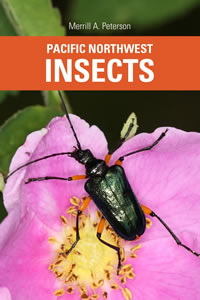 Fascinated by all the small life forms you find in your garden? Perhaps not, but it is still valuable for gardeners to know about them. "Pacific Northwest Insects" by Merrill Peterson will help. This excellent new field guide provides incredible color photos of over 1,200 species native to our region. The scope is the phylum Arthropoda, so this includes all the true insects (bees, beetles, butterflies, flies, etc.) plus centipedes, sow bugs, spider mites, and even spiders and ticks (yikes!).
Fascinated by all the small life forms you find in your garden? Perhaps not, but it is still valuable for gardeners to know about them. "Pacific Northwest Insects" by Merrill Peterson will help. This excellent new field guide provides incredible color photos of over 1,200 species native to our region. The scope is the phylum Arthropoda, so this includes all the true insects (bees, beetles, butterflies, flies, etc.) plus centipedes, sow bugs, spider mites, and even spiders and ticks (yikes!).
This wider scope means this book provides better coverage of the many "bugs" you'll find in your garden. Peterson recognizes the importance of plants to the insect world and visa-versa. "Given the specialized associations between insects and plants, it is no wonder that many entomologists are skilled field botanists." This book is the most comprehensive in the Miller Library collection for this region and our reference copy will help you with any identifying invertebrate visitors to your garden.
If you can get past the creepy factor, there's also a lot of fascinating facts to discover. Did you know that moths are a significant food source for grizzly bears in the Rocky Mountains fattening up for their winter hibernation? Or that beetles are the most diverse and numerous order of multicellular animals in the world, making up 20% of all species? Many visitors think the Pacific Northwest has limited insect life. That's not true – this book will help you identify over 3,000 species – but we lack many "huge or gaudily colored insects."
Excerpted from the Spring 2019 Arboretum Bulletin.
Link to this review (permalink)
Buzz : the nature and necessity of bees by Thor Hanson, 2018
Reviewed by: Brian Thompson on 2019-04-01
 I was very impressed with the story-telling skills of Thor Hanson that I discovered when reading his "The Triumph of Seeds" (see review in the Fall 2015 issue of the "Bulletin"). He makes scientific research easy to understand and an adventure that's fun!
I was very impressed with the story-telling skills of Thor Hanson that I discovered when reading his "The Triumph of Seeds" (see review in the Fall 2015 issue of the "Bulletin"). He makes scientific research easy to understand and an adventure that's fun!
"Buzz: The Nature and Necessity of Bees" is Hanson's newest (2018) book. As before, he combines just the right touch of personal, local experience – he lives on an unidentified island in the Pacific Northwest – with wide-ranging research. For this book, he traveled to Sri Lanka to investigate a bee-like wasp, and to southern Africa, one of the ecosystems where honey bees are native.
"Bees are the vegetarian descendants of a sphecid wasp ancestor from the mid-Cretaceous. That much is known." As these wasps are not vegetarian, why and how did bees make this dramatic lifestyle change? This is still a mostly unanswered question, but Hanson seeks out some of most recent research and insightful researchers to explore the possibilities.
This led him to participate in "The Bee Course", a nine-day, intensive study set in the Arizona desert in August. Why there and then? Arizona has the highest concentration of bee species (1,300) in North America and unlike tourists, they don't mind the heat and are particularly busy during the flush of flowers by many cacti and other wildflowers at that time of year.
During the course, Hanson became smitten with an alkali bee (Nomia sp.), a genus that has an opalescent exoskeleton, "flashing a rainbow of colors that shifted and swirled in the light." While this species was a rare treasure from his visit to Arizona, he discovered later that near Touchet, Washington, alfalfa farmers have learned to create an environment to nurture native species of alkali bees in exchange for pollinating their crops. This is not a small-scale operation. There are an estimated 18-25 million nesting female alkali bees scattered over 300 acres.
There are other local connections, too. The author profiles Brian Griffin of Bellingham, well-known amongst gardeners and fruit-growers for his commercializing and promotion of keeping orchard mason bees. Hanson also made his own discovery, finding a cliff on a neighboring island to his own that is home to 400,000 digger bees – the largest know population of such bees – amongst a complex community of several other types of bees, wasps, flies, and beetles.
Excerpted from the Spring 2019 Arboretum Bulletin.
Link to this review (permalink)
Olympic National Park : a natural history by Tim McNulty, 2018
Reviewed by: Brian Thompson on 2019-04-01
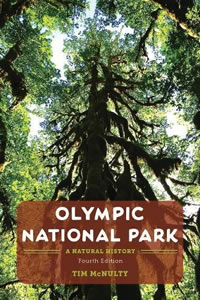 "Olympic National Park: A Natural History" was first published in 1996. Author Tim McNulty and University of Washington Press have now come out with the fourth edition (2018). It's no wonder this book has been so popular. McNulty is an excellent essayist and the subject is a mostly unspoiled, large-scale ecosystem, from seashore to mountaintops, the latter easily seen on a clear day from Seattle.
"Olympic National Park: A Natural History" was first published in 1996. Author Tim McNulty and University of Washington Press have now come out with the fourth edition (2018). It's no wonder this book has been so popular. McNulty is an excellent essayist and the subject is a mostly unspoiled, large-scale ecosystem, from seashore to mountaintops, the latter easily seen on a clear day from Seattle.
This is not an identification book or field guide. There are photographs, but they mostly set the mood of the book by being clustered up front. Instead, this a reading book, intended to be savored cover-to-cover, to gain an understanding of the flora and the fauna in broad settings: the mountains, the forests, and the coast. The author concludes with the human history of the region, especially pre-European, and the much more recent struggle to establish and maintain the integrity of the national park and its ecosystems.
This newest edition is the same as the previous (2009) in large part, but includes the story of the removal of dams on the Elwha River. It also updates efforts to restore the animal life as found prior to the influence by European and eastern North American settlers, with the reintroduction of fishers and the removal of non-native mountain goats.
The Olympic Peninsula is sometimes described as a refugia, a place where plant and animal species survived while disappearing from nearby locations. This is in part because of the wide range of topographical niches, caused by extreme changes both in elevation and rainfall over short distances. Species could adapt by moving to nearby, suitable habitats.
Earlier history is part of this story, too. While much of the peninsula avoided glaciation, "the ice age and the climatic upheavals that preceded them have reshuffled the deck of plant and animal communities wildly in the Olympic Mountains…alpine and sub-alpine species mixing willy-nilly with lowland plants and varieties." This gives hope that these mountains and lowlands will continue to provide refuge for plants during future climate change.
Excerpted fom the Spring 2019 Arboretum Bulletin.
Link to this review (permalink)
Flora of the Pacific Northwest : an illustrated manual by C. Leo Hitchcock and Arthur C. Cronquist , 2018
Reviewed by: Brian Thompson on 2019-04-01
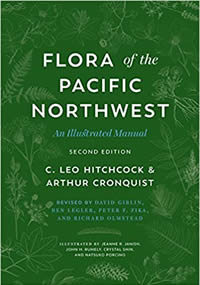 For Pacific Northwest botanists of all levels, the one-volume book informally known as "Hitchcock" has been standard equipment since its publication in 1973. This work, "Flora of the Pacific Northwest: An Illustrated Manual" by C. Leo Hitchcock and Arthur Cronquist, was intended as a field version of the five-volume flora "Vascular Plants of the Pacific Northwest," written by the same authors with two additional botanists and two illustrators from 1955-1969.
For Pacific Northwest botanists of all levels, the one-volume book informally known as "Hitchcock" has been standard equipment since its publication in 1973. This work, "Flora of the Pacific Northwest: An Illustrated Manual" by C. Leo Hitchcock and Arthur Cronquist, was intended as a field version of the five-volume flora "Vascular Plants of the Pacific Northwest," written by the same authors with two additional botanists and two illustrators from 1955-1969.
"No scholarly endeavors are immune to the advancing frontiers of knowledge." This quote is from the introduction of the new, second edition of the one-volume "Flora," expanded by a team of four editors with three new illustrators. Changes in taxonomy, especially from molecular studies, plus newly described taxa and the establishment of non-native species (which this flora includes) have created a long overdue need for an update.
In the 45 years between publications, there has been a nearly 25% increase in the number of taxa included, the biggest single reason being "the establishment, or detection, of additional exotic taxa within our area." While this work does not introduce any new names or classifications, just keeping up with widely accepted taxonomic changes has resulted in over 40% of the listings in the first edition having a new genus and/or species name, or being placed in a different family.
Hitchcock was a long-time professor of botany at the University of Washington. He was also a gardener, and many references remain in the 2nd edition regarding the ornamental qualities and garden adaptability of the subjects.
These include the observation that the incense-cedar (Calocedrus decurrens) is a fine ornamental tree, and that "trilliums are rather easily grown, and T. ovatum in particular is an excellent garden pl [plant], but it is a shame to dig them in the wild, esp [especially] since they grow readily from seed." This urging of conservation (as well as the use of abbreviations) is a repeated theme: "The lilies are a constant temptation to the avaricious gardener, but our spp. [species] rarely thrive in cult [cultivation] and should not be removed from the wild."
Like the first edition, this book attempts to be comprehensive in its presentation of species, subspecies, and varieties throughout Washington, much of Oregon and Idaho, the western part of Montana, and southern British Columbia. The first edition introduced the new (at the time) idea of embedding the species descriptions and illustrations within the taxonomic keys. This proved to be a good decision. It has remained a best-seller for the University of Washington Press for the last four decades.
At 882 pages (the first edition had 730), it is perhaps a bit hefty for field work, but this is a must for your home garden library. The aforementioned use of abbreviations keeps it from becoming even bigger, and this is a bit of a challenge for reading at first. But after a while, this shorthand becomes familiar. The Miller Library has a lending copy of the new edition, and keeps non-circulating copies of both editions and the earlier volumes of "Vascular Plants." Be sure to take a look at this new standard for our regional botany!
Excerpted from the Spring 2019 Arboretum Bulletin.
Link to this review (permalink)
Garden Wise : Non-Invasive Plants for Your Garden by Alison Halpern et al., 2019
Reviewed by: Brian Thompson on 2019-05-01
How do you convince gardeners, landscape designers, or nurseries to avoid planting or selling invasive plants? An effective tool is to provide alternatives – plants that provide a similar aesthetic but do not wreak havoc on our native plants and ecosystems.
"Garden Wise: Non-Invasive Plants for Your Garden, Western Washington Guide" is just such a tool. Published since 2006, the newest edition (2019) presents a selection of herbaceous, groundcover, aquatic, and even woody plants that are invasive in western Washington. Described typically with two photos, a close-up and a landscape shot of an aggressive stand, each entry will help even the casual plant observer identify the culprits. One example is Yellow Archangel ( Lamiastrum galeobdolon), a "trailing plant [that] easily establishes wild populations, in many cases as the result of improper disposal of garden cuttings or hanging baskets."
Best of all, at least three alternatives are described for each invasive plant, also with photos that demonstrate their similar "look" and garden appeal. Many of these are natives. As an alternative to Yellow Archangel, the gardener is encouraged to consider Wild Ginger ( Asarum caudatum), a native groundcover that also grows well in part to full shade.
The Washington State Noxious Weed Control Board heads a long list of organizations (including the UW Botanic Gardens) that have produced this document. Coming soon is a similar booklet for eastern Washington. Both will be available in the Miller Library, or in .PDF format at the Board's website (www.nwcb.wa.gov).
Excerpted from the May 2019 Leaflet for Scholars Volume 6, Issue 5.
Link to this review (permalink)
Say "Yes!" to Kids with Disabilities by Elizabeth Bullard, 2019
Reviewed by: Dorothy Crandell on 2019-07-05
![[Say Yes! to Kids with Disabilities] cover](https://depts.washington.edu/hortlib/graphix/sayyes!tokidswithdisabilities.jpg)
We have shared values and aspirations for all children. What are some of the ways for parents, teachers and community members to plan and carry out a welcoming, engaging, inclusive environment for children with disabilities? Say "Yes!" to Kids with Disabilities: Stories and Strategies for Including ALL Kids provides a guide.
Read this guide to find out more about the why and the how of creating a positive sense of belonging, building friendships, community, and empathy for others. That's inclusion. Education equity is a child's human right. Every learner matters equally. Following the promise of the Americans with Disabilities Act (ADA) in 1990, this guide was prepared by a collaboration of King County Best Starts for Kids Initiative, Public Health Seattle & King County, and Seattle Department of Parks and Recreation, along with a strong, dedicated group of parents, volunteers, and children with special needs. The Seattle Children's PlayGarden was achieved through this collaboration so that child and family can truly enjoy going to the park. Fragrance garden activities heighten interactions with the senses, which nourish everyone. The PlayGarden and the guide offer ideas for creative experiences that are not only accessible, but are inclusive.The authors bring a range of professional expertise to the guide. Elizabeth Bullard has an M.A. in Speech-Language Pathology from Indiana University. Hannah Gallagher completed a Teaching Residency program in Education for Environment and Community (EEC) from IslandWood and in 2016 received her Master in Education and a Nonprofit Management certificate from the University of Washington. Adana Protonentis studied Political Science and Organizational Leadership at Seattle University and has a background in civil litigation. She has a child with a disability and brings first–hand knowledge and parent advocacy to the program.
Sections of the guide say "Yes!" at parks, playgrounds, soccer, dance, zoos, museums, festivals, ball games, sporting events, to inclusion every day. Inclusion Every Day offers adaptions and considerations that align with core principles of Universal Design for Learning. UDL is an educational framework that shows the way to develop flexible learning environments that can accommodate individual learning differences. This guide addresses flexible means, methods, and materials giving all children equal opportunity to learn and to express themselves creatively. Adaptation and accommodation combine to meet the needs of each child. Say 'Yes!' to Kids with Disabilities helps to assure that everyone is served with these strategies. The focus is on the experience that leads to greater and more meaningful participation in community life.
Link to this review (permalink)
Elizabeth and Her German Garden by Elizabeth Von Arnim, 1985
Reviewed by: Priscilla Grundy on 2019-07-05
![[Elizabeth and Her German Garden] cover](https://depts.washington.edu/hortlib/graphix/ElizabethandherGermangarden.jpg)
Here is light summer reading, in which the main attraction is Elizabeth's delight in her garden. Billed as a novel, the text reads as a year of journal entries by Elizabeth, and the situation follows von Arnim's life situation as wife of a German baron. She was born Mary Annette Beauchamp (later changing her name to Elizabeth) in Australia and raised in England. She describes convincing her husband to spend more time in their country estate, which had been neglected for 25 years. There was no garden left, and she had no experience as a gardener but was eager to have one. The book describes her efforts and failures and renewed efforts, particularly with roses but with many other plants as well, flowers, bushes, and trees. Patience and failure, she says, are the lot of the gardener. The garden becomes her place of refuge and delight, as she spends most of her days outdoors.
The reader will need to return to the world of Downton Abbey, except that the point of view is restricted to the upstairs, not the downstairs. There is much talk of problems with cooks, maids, and, of course, gardeners. Von Arnim writes with a light touch and includes many set pieces such as sleighing to church wrapped in furs, and Christmas with the children, especially the staff children.
Most frustrating for her is that she can't do the gardening herself. A baroness must not garden. She must hire gardeners and tell them what to do, not an easy task. Once she sneaks out when no one is looking and digs a little. Her work, then, consists of ordering seeds and supervising. But she loves being in the garden as it develops, and resists going to town, much to the amazement of German women visitors, who think city life is far superior (as in Jane Austen novels). Her husband, known to us only as "the Man of Wrath," does not seem wrathful, just scornful of women, whom he regards as children. Elizabeth does not contest with him, she just acts independently. He does not approve of large expenses for gardens, so she buys seeds with her "pin money" and frets that she may have to cut back ordering dresses for herself.
The reader won't learn how to plant a garden from this book but will have fun seeing Elizabeth's grow and sharing her pleasure.
Link to this review (permalink)
My Hair is a Garden by Cozbi Cabrera, 2018
Reviewed by: Rebecca Alexander on 2019-07-19
![[My Hair is a Garden] cover](https://depts.washington.edu/hortlib/graphix/myhairisagarden.jpg)
Can we tend to our sense of self the way we tend to a garden? Can a garden teach us self-acceptance and resilience? Cozbi Cabrera's picture book, My Hair is a Garden, demonstrates the way a little girl who is teased for her appearance takes heart in the kind guidance of an older neighbor who is a gardener. A garden contains beauty in many forms, and a tree is not better than a ground cover: "They're both beautiful […] even though they're so different." The neighbor teaches the girl practical lessons in caring for her hair, but more importantly and subtly, she sows in her the seeds of self-confidence.
Link to this review (permalink)
Pacific Northwest Medicinal Plants: Identify, Harvest, and Use 120 Wild Herbs for Health and Wellness by Scott Kloos, 2017
Reviewed by: Dorothy Crandell on 2019-08-01
![[Pacific Northwest Medicinal Plants] cover](https://depts.washington.edu/hortlib/graphix/PacificNorthwestmedicinalplants400.jpg)
Can plants heal our bodies? Searching for answers to this basic question, Scott Kloos provides a revealing excursion in "Pacific Northwest Medicinal Plants: Identify, Harvest, and Use 120 Wild Herbs for Health and Wellness", published by Timber Press in 2017. This comprehensive field guide and reference work covers Alaska, British Columbia, Oregon, Washington, and Northern California.
Kloos shares what he has learned from more than two decades of wildcrafting and working with plant medicine. He runs his own school as well as a folk medicine business. In helping people understand traditional uses of medicinal plants, he acknowledges some level of uncertainty and risk involved. Self-treatment is strongly not recommended; consulting a qualified practitioner is advised.
In the book, Kloos first describes basic botanical concepts, tools for harvesting, formulas for making medicine, ethical and sustainable wildcrafting practices, herbal safety, and a breakdown of the harvesting season. Photographs taken by Kloos accompany the plants he profiles. He provides detailed descriptions of each plant: their growth habits, parts of the plant, identifying characteristics, where one is likely to find the plant, the best time of year to harvest, and how to harvest the plant. Medicinal uses of the plant and methods of preparing each part of the plant as medicine are described. Cautionary notes throughout the book alert readers regarding such matters as toxicity, dosage precautions, and uses with other medications or during pregnancy. It is imperative to consider potentially harmful effects of an herb.
For thousands of years, plants have been the chief source of medicine around the world. Healers have prescribed many cures from the flora around them. Nevertheless, there is a lot we don't know. It is important to let your doctor and other health practitioners know which herbal remedies you are considering taking. Meanwhile, reading this book can help you cultivate a more healthy respect for the wild, bonding with the living world in all it offers us.
Excerpted from the August 2019 Leaflet Volume 6, Issue 8.
Link to this review (permalink)
Outdoor learning environments : spaces for exploration, discovery and risk-taking in the early years by Helen Little et al., 2017
Reviewed by: Dorothy Crandell on 2019-10-01
![[Outdoor Learning Environments] cover](https://depts.washington.edu/hortlib/graphix/outdoorlearningenvironments.jpg)
Why do childhood play and learning in the outdoors matter? The short answer is because then we are less likely to destroy it. Good habits start early. With knowledge and habits established in a young generation, the outdoor paradise of the Pacific Northwest will be here for us in the future.
Nature inspires curiosity, learning, and renewal. In a time of widespread tech addictions, expanding cities such as Seattle, and changing behavior and cultural values, connecting with the outdoors contributes in unique and important ways to our health, well-being, and survival in the long run.
Outdoor Learning Environments: Spaces for Exploration, Discovery and Risk Taking In the Early Years guides educators, policy makers and community builders to developing positive and engaging outdoor learning environments for children. Editors Helen Little, Sue Elliott and Shirley Wyver, as well as other authors, researchers and practitioners, present a range of ideas drawn from contemporary education theories, research and practice. Australia is the location of the publication, but it could be anywhere in the world.
The book highlights how educators interweave learning and the environment, beyond management-style supervision. Positive approaches to risk-taking are considered, with risk-taking defined as events, behaviors and consequences that are associated with some degree of uncertainty about the outcomes. Designing and planning for outdoor learning are included in a way that incorporates children's voices and cultural perspectives. Education for sustaining a healthy environment is explored. The editors, at the same time, address the issue of ensuring that outdoor spaces and equipment align with relevant regulations and safety requirements.
Outdoor Learning Environments opens minds of children and caring adults to the wonders and realities of our environment and to working collaboratively toward sustainable futures with wisdom and heart.
Excerpted from the October 2019 Leaflet Volume 6, Issue 10.
Link to this review (permalink)
Gardening with native plants of the Pacific Northwest by Arthur R. Kruckeberg and Linda Chalker-Scott , 2019
Reviewed by: Brian Thompson on 2019-07-01
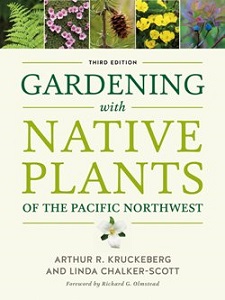 Art Kruckeberg (1920-2016) has a legendary reputation for his research and teaching in botany, and his expansion of that work into the natural history and geology of selected ecosystems. But for gardeners, he is best remembered for his classic "Gardening with Native Plants of the Pacific Northwest," first published in 1982, followed by a second edition in 1996.
Art Kruckeberg (1920-2016) has a legendary reputation for his research and teaching in botany, and his expansion of that work into the natural history and geology of selected ecosystems. But for gardeners, he is best remembered for his classic "Gardening with Native Plants of the Pacific Northwest," first published in 1982, followed by a second edition in 1996.
Linda Chalker-Scott is rapidly developing her own renown for books that encourage learning the science behind growing plants. Now she has taken on the major task of guiding the publication of a third edition of "Gardening with Native Plants of the Pacific Northwest."
This is not just an editorial update. It is a collaboration from different perspectives and eras. Kruckeberg was a professor of botany for nearly four decades at the University of Washington until his retirement in 1989. In his first edition, he acknowledges the help of several individuals that figure prominently in the mid to later 20th century Arboretum, including Brian Mulligan, Roy Davidson, Joe Witt, C. Leo Hitchcock, Sylvia Duryee, and his wife, horticulturist Mareen Kruckeberg, the latter credited with conceiving the concept of this book.
Chalker-Scott is an associate professor of horticulture and extension specialist at Washington State University. Her contributions to the new edition further enhance the reader's understanding of our native plants in their natural setting, and how to make them thrive in the not-very-natural setting of a typical home garden.
For those familiar with the older editions, the first thing you'll notice in the new edition is the inclusion of many color photographs, almost one for every text entry. Each photograph has a selection of habitat icons "to help gardeners both visualize the best natural settings for native plants and identify environmental preferences." For example, a plant may naturally grow in the full sun of a meadow or prairie, or it may need the superb drainage of a rock garden. Plants may be best adapted for wetlands or drylands, or perhaps a woodland or even a seashore. Another symbol marks plants especially successful in restoration projects. The new edition also updates taxonomy, reflecting the recent publication of the 2nd edition of the "Flora of the Pacific Northwest" (see my review in the Spring 2019 issue of "The Bulletin").
For those new to this book, the breadth of the plant selection may be surprising – we have many garden-worthy natives. The emphasis is on woody plants. Almost all native trees are reviewed in some depth, including those not recommended for a garden setting. In the chapter on deciduous shrubs, ten "choice" species are considered first as the best choices. Much of the writing in these plant descriptions is the voice of Kruckeberg, although I noticed that favored plants are now "our" favorites – the two authors agree on most of the selections.
Chalker-Scott has added a new chapter that brings her signature work on horticultural science to the establishment and maintenance of a garden rich in native plants. She alleviates concerns about using "nativars" – propagated selections chosen for an unusual and desirable trait, such as double flowers or variegation. She also assures the new gardener that it is okay to mix well-behaved exotics into your garden of mostly natives.
One major difference between the second and third editions is the removal of any instructions on how to collect native plants from the wild. Chalker-Scott cautions, "This practice must stop if we are to retain many of our rare, threatened, and endangered species. It's a better ethical and ecological choice to purchase native plants from reputable nurseries that have propagated and cultivated their plants without endangering native populations."
Excerpted from the Summer 2019 Arboretum Bulletin
Link to this review (permalink)
Native plants in the coastal garden by April Pettinger and Brenda Costanzo, 2002
Reviewed by: Brian Thompson on 2019-07-01
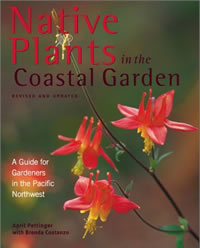 "Native Plants in the Coastal Garden" (1996, revised 2002) by April Pettinger and Brenda Costanzo brings a British Columbia focus to native plant gardening. Essays describe the rise of a late 20th century naturalistic aesthetic in European and American garden design and the supreme suitability of native plants for this look. Many different design aspects are considered, such as container gardening with native plants, and the large role that grasses play in any landscape.
"Native Plants in the Coastal Garden" (1996, revised 2002) by April Pettinger and Brenda Costanzo brings a British Columbia focus to native plant gardening. Essays describe the rise of a late 20th century naturalistic aesthetic in European and American garden design and the supreme suitability of native plants for this look. Many different design aspects are considered, such as container gardening with native plants, and the large role that grasses play in any landscape.
Only in the latter half of the book are species described in depth, presented in groupings by appropriate habitats. Trees, shrubs, and herbaceous plants have equal treatment with a section for each on propagation and cultivation. Photos are limited and most of the information on nurseries and public gardens is out of date.
Excerpted from the Summer 2019 Arboretum Bulletin.
Link to this review (permalink)
Wildflowers of Oregon by Damian Fagan, 2019
Reviewed by: Brian Thompson on 2019-07-01
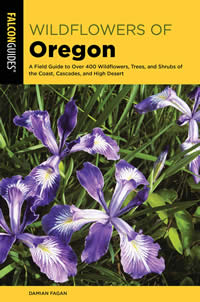 Damian Fagan is a University of Washington graduate in botany who now lives in Oregon. His "Wildflowers of Oregon" introduces 400 of the most common wildflowers from across that state, arranged by colors. The majority of these are herbaceous plants, but trees and shrubs with prominent flowers are included. Most of these range northward into Washington and even British Columbia, making this a useful reference throughout the Pacific Northwest.
Damian Fagan is a University of Washington graduate in botany who now lives in Oregon. His "Wildflowers of Oregon" introduces 400 of the most common wildflowers from across that state, arranged by colors. The majority of these are herbaceous plants, but trees and shrubs with prominent flowers are included. Most of these range northward into Washington and even British Columbia, making this a useful reference throughout the Pacific Northwest.
Comments with each flower typically include the source of the botanical name. For example, I learned that Tellima (as in Tellima grandiflora, or Fringecups) "is an anagram of Mitella, another genus in the Saxifrage Family." Other notes discuss ethnobotanical uses, or hints on distinguishing between similar species.
I would recommend this book for the more casual observer. A glossary is provided, but the descriptions mostly use non-technical terms. The selected species are the most commonly seen and the single photograph along with the descriptive text will suffice in most cases for identification – there are no keys. The author co-dedicates the book to the memory of Art Kruckeberg.
Excerpted from the Summer 2019 Arboretum Bulletin.
Link to this review (permalink)
Plants of Northern California by Eva Begley, 2018
Reviewed by: Brian Thompson on 2019-07-01
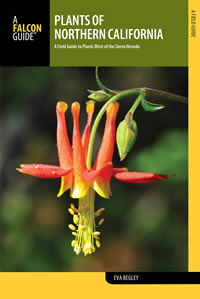 "Plants of Northern California" by Eva Begley includes non-flowering plants such as conifers and ferns. The scope is essentially north of a line from San Francisco to Sacramento, west of the Sierra Nevada range, and south of the Oregon border.
"Plants of Northern California" by Eva Begley includes non-flowering plants such as conifers and ferns. The scope is essentially north of a line from San Francisco to Sacramento, west of the Sierra Nevada range, and south of the Oregon border.
This is not arranged by flower color. The author explains: "In short, dear reader, you may find it hard to identify all the plants you encounter in northern California, and you certainly won't find every one in this book. By organizing the book according to families, though, rather than flower color, I hope to help you at least to place many plants not included here in their correct family or genus."
Without a field test, I can't comment on this approach for identification, but I did find it effective for reading through the book, allowing me to concentrate on all the species in a single genus. For example, being able to read about all the monkey flowers (Mimulus species), in their wide array of colors, in one place gave me a greater appreciation for the genus that includes annuals, perennials, or even shrubs. The writing is very engaging, although I did balk at Rhododendron macrophyllum, the state flower of Washington, being called a "California Rhododendron." Harrumph!
Excerpted from the Summer 2019 Arboretum Bulletin.
Link to this review (permalink)
Best wildflower hikes Western Washington by Peter Stekel, 2016
Reviewed by: Brian Thompson on 2019-07-01
 "Best Wildflower Hikes Western Washington by Peter Stekel is a good choice for the Seattle area native plant fancier. It provides a list of favorite hikes, many in or near our three national parks. Others are for easy, lowland hiking, including trails on the San Juan Islands. Each will take you past areas where wildflowers are prominent in season, or to especially good stands of native trees. A thorough introduction provides guidance on essential things to bring, including equipment such as hiking poles. Other sections help you choose the best trails for children and/or dogs, and even give advice on trail etiquette.
"Best Wildflower Hikes Western Washington by Peter Stekel is a good choice for the Seattle area native plant fancier. It provides a list of favorite hikes, many in or near our three national parks. Others are for easy, lowland hiking, including trails on the San Juan Islands. Each will take you past areas where wildflowers are prominent in season, or to especially good stands of native trees. A thorough introduction provides guidance on essential things to bring, including equipment such as hiking poles. Other sections help you choose the best trails for children and/or dogs, and even give advice on trail etiquette.
The tone here is more casual than in plant guidebooks. In a description of the hike to Panorama Point in Mount Rainier National Park, the author encourages that "a further 0.2 mile of huffing and puffing, and you'll be rewarded with dizzying views down in the valley of the Nisqually Glacier." Elsewhere, he is quite political: "Are you tired of all these fees? Then, do something about it!"
There is enthusiasm in Stekel's writing and he is especially keen on the Columbia River Gorge. "If your timing is right, your eyes will be overwhelmed by acres and acres of yellows, blues, reds, and greens—that, and awe-inspiring views of the mighty 'River of the West' making its way to the sea."
Excerpted from the Summer 2019 Arboretum Bulletin.
Link to this review (permalink)
Best wildflower hikes, Washington by Arthur R. Kruckeberg with Karen Sykes & Craig Romano , 2004
Reviewed by: Brian Thompson on 2019-07-01
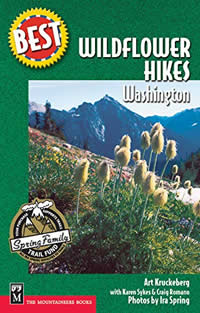 I was surprised to learn that Art Kruckeberg co-authored "Best Wildflower Hikes Washington", one of his last book publications (2004). His contribution is primarily found in "Art's Notes," extra tidbits on the floral treasures of the fifty hikes described.
I was surprised to learn that Art Kruckeberg co-authored "Best Wildflower Hikes Washington", one of his last book publications (2004). His contribution is primarily found in "Art's Notes," extra tidbits on the floral treasures of the fifty hikes described.
His wry comments are a highlight, including this from a description of the Chiwaukum Creek trail east of Stevens Pass: "The stunning wildflower encountered early on the trail is the showy lewisia, Lewisia tweedyi, a.k.a. 'Tweedy's lewisia'—a rather redundant common name…we thank stars that it was not named the state flower of Washington, for collectors might have brought it to extinction."
Excerpted from the Summer 2019 Arboretum Bulletin.
Link to this review (permalink)
The bulb hunter by Chris Wiesinger and William C. Welch, 2013
Reviewed by: Brian Thompson on 2019-10-01
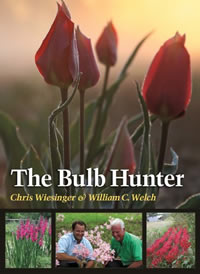 I received at an early age a birthday present of a dozen gladiolus corms. The results – plants taller than I was, with brilliant colors – were enthralling and made me a life-long bulb (more accurately: geophyte) enthusiast. For author Chris Wiesinger, it started with a single red tulip bulb. He planted "his little rock" in his Central Valley of California home and forgot it. The next spring "something magical had occurred; my living rock had turned into the most striking red tulip."
I received at an early age a birthday present of a dozen gladiolus corms. The results – plants taller than I was, with brilliant colors – were enthralling and made me a life-long bulb (more accurately: geophyte) enthusiast. For author Chris Wiesinger, it started with a single red tulip bulb. He planted "his little rock" in his Central Valley of California home and forgot it. The next spring "something magical had occurred; my living rock had turned into the most striking red tulip."
Sadly, this was a one-and-done experience. The next year, only leaves appeared. A year later, he dug down to find the remains of a rotted bulb. But it lit a spark, and for Wiesinger, this experience turned into a combination business and consuming passion. He wrote his story in "The Bulb Hunter," co-written with William Welch.
Wiesinger was only a temporary Californian. He returned to his southern roots in Louisiana and now Texas, searching for bulbs who have long out-survived the demise of the house they surrounded. This includes an elusive, perennial red tulip (Tulipa praecox), but it is found only where there is gritty black clay, so hard that it bends shovels. This quality protects the bulbs from their natural enemies, gophers and voles, and the good drainage allows drying out in the summer, much like the tulip's central Asian homelands.
The book is divided into two halves, with the second being author Welch's story. His is more typical garden memoir, recounting the bulbs and companion plants that thrive in each season for Texas and the Gulf South. While it is a stretch to use this as guidance for Pacific Northwest gardening, there are some interesting possibilities here, and I'm looking forward to trying them.
I was pleased that gladiolus species are prominent in both halves of the book. Gladiolus byzantinus (syn. G. communis var. byzantinus) is found in old cottage style gardens and Wiesinger considers it one of the most valuable bulbs he sells. Unfortunately, it is also a favorite of gophers and voles. The challenges of thwarting these "glad lovers" will amuse every gardener.
Excerpted from the Fall 2019 Arboretum Bulletin.
Link to this review (permalink)
The orchid hunter by Leif Bersweden, 2017
Reviewed by: Brian Thompson on 2019-10-01
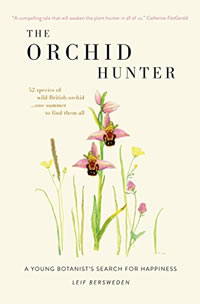 Taking a gap year between college and graduate school is often a time for young students to explore distant parts of the world, perhaps to donate their time to a devoted cause, or to learn a different culture. Very few spend the time botanizing. This is what makes Leif Bersweden's story so interesting. At age seven, he found his first orchid: "Mum, this flower looks just like a bee." From this simple beginning, a passion grew, and he decided to spend his gap year tracking down and photographing all 52 native species of Orchidaceae in Great Britain and Ireland. He relates his story in "The Orchid Hunter: A Young Botanist's Search for Happiness."
Taking a gap year between college and graduate school is often a time for young students to explore distant parts of the world, perhaps to donate their time to a devoted cause, or to learn a different culture. Very few spend the time botanizing. This is what makes Leif Bersweden's story so interesting. At age seven, he found his first orchid: "Mum, this flower looks just like a bee." From this simple beginning, a passion grew, and he decided to spend his gap year tracking down and photographing all 52 native species of Orchidaceae in Great Britain and Ireland. He relates his story in "The Orchid Hunter: A Young Botanist's Search for Happiness."
This was no small task. In general, the orchids of the British Isles are not showy except up close and easily hide amongst other vegetation. Some are extremely rare. Most are located well off beaten pathways, difficult to reach with Bersweden's car that was prone to breaking down. Actually two cars. The first did not last the year. Meanwhile, our young botanist was growing up and undergoing many of the usual coming-of-age emotional upheavals.
Other than the botanical theme, why am I recommending this book? Because Bersweden is an excellent storyteller. Combining this with a plant theme is a bonus. In additional to his personal challenges and triumphs, he is adept at telling the history of British and Irish botany and related studies of wildflowers. Best of all, you the reader get caught up in the chase! (Spoiler alert). Will he succeed in finding all 52 native orchids despite a late spring, a hot summer, the challenges of driving 10,000 miles on often minimal roads, and some iffy accommodations? Happily, he does.
And happily for the reader, he never loses his sense of humor. He notes that the Fly Orchid (Ophrys insectifera), despite the name, is pollinated by a digger wasp. "It looks very different from the Fly Orchid flower. So different, in fact, that you really start to question the wasp's intelligence. How can it possibly be duped into thinking the orchid flower…is its star-crossed lover?" After explaining how the smell and feel of the Fly Orchid is the attraction, he concludes: "To the digger wasp, the Fly Orchid is a sex toy, not perfectly life-like but able to arouse the senses and cloy the mind."
Excerpted from the Fall 2019 Arboretum Bulletin.
Link to this review (permalink)
A plant-hunter in Afghanistan by Christopher Grey-Wilson, 2019
Reviewed by: Brian Thompson on 2019-10-01
 Christopher Grey-Wilson is a major author in the Miller Library collection with twenty-four books he either wrote or edited. Many focus on a specific plant such as cyclamen, pasque-flowers, saxifrages, or poppies of the genus Meconopsis. Others are excellent guides to alpine and rock garden plants. As you read these books, you learn that he has considerable experience as a plant explorer. In "A Plant-hunter in Afghanistan," he provides a detailed and fascinating account of his nine months of plant exploring through southern Iran and Afghanistan in 1971.
Christopher Grey-Wilson is a major author in the Miller Library collection with twenty-four books he either wrote or edited. Many focus on a specific plant such as cyclamen, pasque-flowers, saxifrages, or poppies of the genus Meconopsis. Others are excellent guides to alpine and rock garden plants. As you read these books, you learn that he has considerable experience as a plant explorer. In "A Plant-hunter in Afghanistan," he provides a detailed and fascinating account of his nine months of plant exploring through southern Iran and Afghanistan in 1971.
Why publish this now, almost fifty years after the events? The author claims other professional demands prevented him having the time, but he also reflects on the tragic changes to these countries, suggesting the need to document "the peaceful and welcoming country that I and my colleagues encountered in 1971." In my reading, I certainly developed a greater awareness of the destruction caused by the upheavals that began just two years later.
Grey-Wilson's writing is always quite accessible, but this book especially reads like a matter-of-fact journal. Some of the cultural clashes put the author and his colleagues in an unfavorable light, but they are left as written at the time in this self-published book. His photographs were all taken on film during the trip and although digitally enhanced, still evoke an earlier time.
In the Iranian city of Mashhad, Grey-Wilson was eager to photograph the golden dome of the tomb of Iman Reza and the turquoise colored dome of the nearby Great Mosque of Goharshad. He knew that as a foreigner, he was not allowed within the sacred area enclosing these buildings, but the boundary was unclear. "I unfastened my camera and was just about to take the photo of a lifetime when a hefty clout on my shoulder almost sent the camera spinning to the ground, fortunately undamaged." A group of local students recognized his confusion and led him to a permitted, if somewhat farther away, rooftop to take his photo.
Of course, the main purpose of the trip was to find plants and Grey-Wilson and his companions were successful at that, finding 18 new species. Many plants are documented with photographs taken by the author, but this book is mainly a travelogue, and the photographs also effectively capture the often spectacular terrain, the human structures, the people, and the animals of this fascinating area. I recommend it to anyone interested in learning more about this region before the recent wars and terror; an interest in plants is not required. That said, this is a limited edition book, and does not lend, but I urge spending time with it in one of the Miller Library's comfortable chairs.
Excerpted from the Fall 2019 Arboretum Bulletin.Link to this review (permalink)
In the footsteps of Joseph Dalton Hooker by Seamus O'Brien, 2018
Reviewed by: Brian Thompson on 2019-10-01
Seamus O'Brien is another modern day plant explorer. Between 2012-2015, he led four tours of small groups to explore the rich flora of Sikkim, the tiny state of India wedged between Nepal and Bhutan, and butting up against the Himalayas. This landscape creates vast extremes in topography and climate, and an especially rich variety of plants in an area only slightly larger than King County.
Joseph Dalton Hooker (1817-1911) was one of the prominent plant explorers of the 19th century with voyages to Antarctica, the Middle East, Morocco, and western North America. He is arguably best remembered for his three years in and around Sikkim from 1849-1852. At that time, it was an independent kingdom and the crossroads of several distinct cultures.
O'Brien wrote "In The Footsteps of Joseph Dalton Hooker" about his trips to Sikkim, skillfully weaving his travel stories around a biography of Hooker's trip. "Unlike Hooker, our mission was not to collect, but to study and compare places he visited and to record how they had fared and appeared over 160 years later. In some ways Sikkim has changed little over the course of time."
The main goal of each man was finding plants, and especially rhododendrons. Hooker discovered many, and confirmed and accurately described several other species for science. O'Brien's group sought many of the same plants in the same locations where Hooker found them. Each was also interested in the people and the animals of Sikkim.
The result is a rich dialogue between two eras. Many of the physical and flora features of Hooker's day are still there. An example is "Hooker's Rock," a gigantic boulder in the Lachen valley, probably deposited by retreating glaciers. Hooker sketched it in great detail and included a circle of seated villagers and a couple of enormous yaks in the foreground. O'Brien includes photos of the same rock, and even captured a large, black yak posed in front! Hooker also adopted a Tibetan mastiff named Kinchin to be his companion and fierce protector. Sadly, Kinchin perished during a river crossing, but O'Brien was able to find similar – if somewhat more placid – dogs of the same lineage.
Seeds of many of the Rhododendrons that Hooker sent home were planted at an estate south of Dublin. Conditions here closely match the climate, soil, and rainfall of Sikkim and the plants are still flourishing. This estate became the National Botanic Garden, Kilmacurragh of Ireland in 1996 (an annex to the gardens at Glasnevin). O'Brien took a position managing these gardens in 2006. The awe he felt for these "Hooker rhododendrons" every spring gave him the incentive to see them in their native land.
Excerpted from the Fall 2019 Arboretum Bulletin.
Link to this review (permalink)
Emily Dickinson's Gardening Life by Marta McDowell, 2019
Reviewed by: Priscilla Grundy on 2019-12-04
![[Emily Dickinson's Gardening Life] cover](https://depts.washington.edu/hortlib/graphix/EmilyDickinson'sgardeninglife.jpg)
Whether or not you are a fan of Emily Dickinson's poetry, you will find much to enjoy in this book. McDowell gives context to a number of the garden-themed poems. But she also gives a wonderful portrait of a nineteenth century woman's relationship with her garden.
Every aspect of Emily Dickinson's Gardening Life deserves praise. From sturdy paper quality to admirably painstaking research, with much in between, the book is a delight.
In this revision of her 2005 book Emily Dickinson's Gardens: A Celebration of a Poet and Gardener McDowell has organized the main body of the text around the seasons. Thus the opening section, "Early Spring," includes background on the town of Amherst and the Dickinson family, plus description of early spring in Dickinson's garden, with color plates and a page describing some spring bulbs. The well-written text is spare but sufficient on the poet's life while lavish on her garden and her connections to it.
McDowell has mined multiple sources to get her telling details, such as noting in a thank-you letter to a friend who had sent Dickinson bulbs that she had "long been a Lunatic for bulbs." Throughout, poems are included to expand a point and give context.
The color plates are by three contemporaries of Dickinson. One, Ora White Hitchcock, was a friend of the family, and another, Clarissa Munger Badger, published a folio of prints that Dickinson owned. McDowell includes, among many other photos, one showing the cover of the 1881 Bliss seed catalog, and the text quotes a Dickinson letter from January of that year that describes her sister Vinnie as "in Bliss catalog, prospecting for summer."
After the final season section, "Winter: Requiem for a Gardener," including Dickinson's death, a last section, "A Poet's Garden," contains a marvelous 26-page list of plants: those in the garden, mentioned by Dickinson, or known to be local from other sources, plus notes describing the plant and/or noting how Dickinson used it in print or in the garden.
McDowell writes with clarity and elegance. I came away with a much broader sense of Dickinson's life, seeing her as much more than a hermit who wrote great poems. Rather she was someone who lived a surprisingly varied life, enriched through her love for and labor with gardens. Don't miss this book.
Published in the December 2019 Leaflet, Volume 6 Issue 12.
Link to this review (permalink)
Common Mosses of Western Oregon and Washington by McCune Bruce, 2018
Reviewed by: Brian Thompson on 2019-12-04

Common Mosses of Western Oregon and Washington provides the beginning bryologist a key to 200 species of mosses found west of the Cascades, including a few of the most common species found on both sides of the mountains. Keys for any plant group can be challenging, but the introductory section gently teaches the steps necessary for accurate identification, including the use of a microscope as an essential tool. The many close-up photographs are also a boon.
Authors Bruce McCune and Martin Hutten recognize this is just a sampling of the more common mosses of our region, expressing much respect for the 1971 comprehensive moss flora by Elva Lawton that included 598 species. "We hope that one of you using this key will eventually produce a new moss flora for the Pacific Northwest. This is one of the mossiest places in the world, and beautiful because of it."
Published in the December 2019 Leaflet for Scholars, Volume 6 Issue 12.
Link to this review (permalink)
Field Guide to the Grasses of Oregon and Washington by Cindy Talbott Roché, 2019
Reviewed by: Brian Thompson on 2019-12-04
![[Field Guide to the Grasses of Oregon and Washington] cover](https://depts.washington.edu/hortlib/graphix/fieldguidetothegrassesofOregonandWashington.jpg)
Field Guide to the Grasses of Oregon and Washington is the work of five authors over a period of 15 years, but it will likely remain a standard for a much longer period. Covering the whole of both states, this guide presents 343 of our species (out of some 10,000 worldwide), including invasive species, naturalized ornamentals, and even some agricultural crops that show up as "waifs" along roadsides. All are in the plant family Poaceae. Excluded are sedges, rushes, or any of the numerous plants that have "grass" in their common name – such as beargrass or eelgrass – found in other families. Also omitted are bamboos; while some have established locally, none are known to sexually reproduce in our climate.
The keys are a daunting 75 pages long, but the authors provide helpful descriptions by genus throughout, along with some diagrams of closely-allied species. The encyclopedic bulk of the book includes detailed descriptions, range maps, and – the best feature – especially intricate photographs showing many close-ups parts for each species.
While written for an expert, the introduction addresses the needs of the beginner, too, with helpful hints on getting started and not being discouraged. Clearly, the authors love their subjects. "We hope you come to enjoy grasses as much as we do. Besides their ecological and economic importance, grasses themselves are fascinating."
Published in the December 2019 Leaflet for Scholars, Volume 6 Issue 12.
Link to this review (permalink)
RetroSuburbia : the downshifter's guide to a resilient future by David Holmgren, 2018
Reviewed by: Tracy Mehlin on 2019-12-18
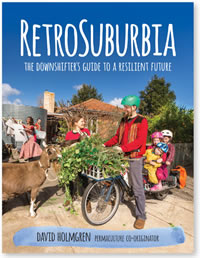 David Holmgren co-created the philosophy of Permaculture while living in Australia in the 1970s. More than just a gardening method, "permaculture could be better described as a design system for resilient living and land use based on universal ethics and ecological design principles." Holmgren writes RetroSuburbia : the downshifter's guide to a resilient future from the point of view that the future will become increasingly difficult because of "energy descent" (scarcity) and general global economic depression. However, his tone is optimistic and pragmatic— he has led a self-reliant life and so can you. Retrosuburbia is a thick manual with a philosophical foundation for those wishing to be environmentally conscientious, resilient and self-reliant. Holmgren distills the rationale of his guide as: "… downshifting away from consumption supported by paid work and debt to a culture of voluntary simplicity and permaculture productivity."
David Holmgren co-created the philosophy of Permaculture while living in Australia in the 1970s. More than just a gardening method, "permaculture could be better described as a design system for resilient living and land use based on universal ethics and ecological design principles." Holmgren writes RetroSuburbia : the downshifter's guide to a resilient future from the point of view that the future will become increasingly difficult because of "energy descent" (scarcity) and general global economic depression. However, his tone is optimistic and pragmatic— he has led a self-reliant life and so can you. Retrosuburbia is a thick manual with a philosophical foundation for those wishing to be environmentally conscientious, resilient and self-reliant. Holmgren distills the rationale of his guide as: "… downshifting away from consumption supported by paid work and debt to a culture of voluntary simplicity and permaculture productivity."
One chapter in the Build section is "Warm in Winter, Cool in Summer," which explains house retrofitting methods to reduce reliance on gas and electric heaters and air conditioners. Common sense measures to reduce drafts and improve insulation are mentioned. Holmgren also details more creative techniques such as building attached greenhouses on the sunward side for passive solar winter gains. In the summer, the greenhouse would grow vines like beans or tomatoes to block the sun from over-heating the main house. Growing deciduous trees or vines on the west side of the house also moderates summertime indoor temperatures. And like fathers everywhere, Holmgren reminds us to put a sweater on if we're cold in the winter.
The chapter "Building and Maintaining Soil Fertility" is in the Biological Field section. The introduction to soil management for food production is general and discusses how suburban soil fertility is different than conventional agriculture and how modern practices like city composting programs make it relatively easier for home farmers to improve backyard soils. Holmgren highly recommends professional soil testing and gives an example from his own garden of how soil minerals can get out of balance with direct negative impacts on trees and crops. The rest of the chapter discusses various fertility generating techniques in general terms and when they might be appropriate to use. No details or instructions are given, but the heavily foot-noted text gives numerous suggestions for further reading.
The Behavior Field section covers topics such as "Transport and Travel," "Creating Your Own Livelihood," and "Financial Planning and Security." Each chapter encourages a re-framing of how to spend time and money. One suggestion in the financial planning chapter is to invest in small, local business that will directly contribute to community resilience, like a wind farm or urban farm. There is also discussion of which trade-able goods might be worth stockpiling and the relative pros and cons of having cash on hand. Holmgren questions the wisdom of borrowing to pay for a university education that leaves graduates deep in debt, but without skills of self-reliance.
The book will be instructive for people concerned about the climate crisis, those wanting to be self-sufficient and even those on a path to FIRE (Financial Independence, Retire Early). There are no suggestions to head for the hills and retreat from society, but instead Holmgren instructs readers how to retrofit urban and suburban developments to support growing food and meeting life's necessities while transitioning away from conventional modes of employment and consumption.
Published in the January 2020 Leaflet, Volume 7, Issue 1
Link to this review (permalink)
Flora of the Mediterranean with California, Chile, Australia and South Africa by Christopher Gardner, 2019
Reviewed by: Brian Thompson on 2019-12-24
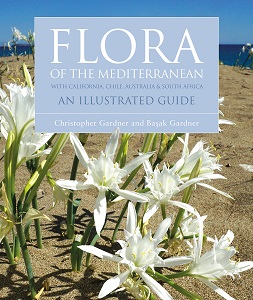 The lands that border the Mediterranean Sea have – for the most part – a similar climate: hot, dry summers and mild, wet winters. Climatologists have identified four other regions in the world with a similar pattern, including most of California and parts of Australia, Chile, and South Africa.
The lands that border the Mediterranean Sea have – for the most part – a similar climate: hot, dry summers and mild, wet winters. Climatologists have identified four other regions in the world with a similar pattern, including most of California and parts of Australia, Chile, and South Africa.
The floras of these regions encompass intense speciation, so that on approximately 2% of the world's land mass one finds over 12% of the world's plant species, many of them endemic. Exploring these floras is a new book, Flora of the Mediterranean by Christopher Gardner and Basak Guner Gardner.
This is a rich photo guide; one could just enjoy the many, stunning close-ups in this large format book (12x10"). However, that would mean missing the extensive detail in the text, such as a description of the Mediterranean climate in Australia that begins: "On occasion the botanist is subjected to such an intense bombardment of new species they have trouble assimilating everything in front of them."
The chapter on California will feel closer to home, as the Pacific Northwest has a modified, or cool Mediterranean climate, colder and wetter in the winter, with less heat in the summer. This allows us to grow successfully many of the plants from these regions in our gardens.
All images in this book are in situ and a bonus is a short but pithy description of techniques for photographing plants in the wild. While it's not a lending book, I encourage taking some time with this book, or the authors' earlier Flora of the Silk Road (2014), in the Miller Library.
Published in the January 2020 Leaflet for Scholars, Volume 7, Issue 1
Link to this review (permalink)
Community-scale composting systems: a comprehensive practical guide for closing the food system loop and solving our waste crisis by James McSweeney, 2019
Reviewed by: Tracy Mehlin on 2020-01-28
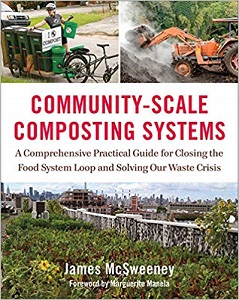 Author James McSweeney passionately believes that food scraps are resources — not waste — and has spent a career consulting for farmers, businesses and community based non-profits on how to turn organic material into high quality compost. His experience and knowledge has been collected into a text book that details not only the various techniques for making compost at scale, but also all the economic, logistic and business considerations required for success. The book is very well organized with charts, worksheets for planning, diagrams and excellent color photos. McSweeney's writing is scientific, but also engaging with just enough anecdotal examples and case studies to keep readers interested in what could be a very dry topic. Footnotes document extensive references, while sidebars give focused information such as "Common regulations for food scrap composters."
Author James McSweeney passionately believes that food scraps are resources — not waste — and has spent a career consulting for farmers, businesses and community based non-profits on how to turn organic material into high quality compost. His experience and knowledge has been collected into a text book that details not only the various techniques for making compost at scale, but also all the economic, logistic and business considerations required for success. The book is very well organized with charts, worksheets for planning, diagrams and excellent color photos. McSweeney's writing is scientific, but also engaging with just enough anecdotal examples and case studies to keep readers interested in what could be a very dry topic. Footnotes document extensive references, while sidebars give focused information such as "Common regulations for food scrap composters."
In the introduction McSweeney distills the essence of successful composting to the four Cs: cover, contain, complete and carbon. The following chapters explore several business and system models (such as drop-off, school, commercial, community garden) with economic analysis for each system. The biology and chemistry behind the compost process is detailed in another chapter. Proven composting methods, such as windrows and aerated static pile, are explained the following chapters. Finally the text concludes with chapters on site management and marketing the final product.
This book would be useful for anyone on the composting continuum from serious home scale and multi-family, to neighborhood, school and work place, to on-farm, community gardens and demonstration sites to large scale municipal and industrial enterprises.
Excerpted from the February 2020 Leaflet for Scholars Volume 7, Issue 2.
Link to this review (permalink)
Fern Fever: The Story of Pteridomania by Sarah Whittingham, 2012
Reviewed by: Brian Thompson on 2020-02-01
While preparing for a recent class on ferns for the Northwest Horticultural Society, I discovered a delightful book that has been in our collection for several years. Fern Fever: The Story of Pteridomania (2012) by Sarah Whittingham, is an extremely detailed, well-researched and well-documented history of fern collecting and growing. It especially focuses on the widespread and fervent interest these plants generated in Britain during the last half of the 19th century. This book is also a lot of fun!
Prior to the 1830s, ferns were minor players in the herbals and floras of Britain. The invention of the Wardian case was one reason for the change. These structures, much like a large terrarium, kept an even moist atmosphere for humidity-loving plants and provided a barrier to the polluted air of sooty London and other major cities. They quickly became a fashionable accessory for every middle class household.
Another discovery was a plenitude of ferns in the native flora, and that many species were prone to sporting fascinating varieties, ripe for collecting and propagating. Resorts sprang up in areas with rich fern floras, and collecting prize examples was a popular vacation pastime. "Visitors to ferny districts not only picked and bought ferns, but also purchased fern albums and local knick-knacks and curios featuring the plant as a motif...to demonstrate one's refined taste, in both choice of holiday destination and souvenirs and presents."
The only downside to this book is its scarcity – the Miller Library copy is for library use only. However, Whittingham also wrote The Victorian Fern Craze (2009), a condensed but equally engaging version of her later work, which is available to borrow.
Excerpted from the February 2020 Leaflet, Volume 7, Issue 2.
Link to this review (permalink)
Landmarks by Robert Macfarlane, 2015
Reviewed by: Priscilla Grundy on 2020-03-04
![[Landmarks] cover](https://depts.washington.edu/hortlib/graphix/landmarks.jpg)
In Landmarks Robert Macfarlane develops his conviction that fully knowing a landscape depends on knowing the many carefully specific words people have used to describe it. To this end he builds this book around types of land: mountains, woods, waterways, and more. Each chapter consists of a section on his encounter with an author who has written with verbal precision about one type, followed by a glossary of terms (usually not used in the first part of the chapter) gathered from multiple regions, dialects and languages of Britain and Ireland.
Chapter 10, titled "The Black Locust and the Silver Pine," focuses on John Muir, a Scot who came to America. Macfarlane quotes from Muir's works and notes his accomplishments, such as convincing Teddy Roosevelt to set aside Yosemite as a national park after the two men had camped there. "'Few are altogether deaf to the preaching of pine trees,'" Muir had written, and Roosevelt listened.
Macfarlane writes with much felicity. Here he is on the bristlecone pine: "Muir loved the bristlecone pine for its extravagantly torqued and gnarled form, and for its extreme resilience to the adversities of gale, avalanche and flame that the mountains threw at it. He was a bristlecone pine himself in that respect, and though his words lay dormant for decades, they would eventually germinate and grow with astonishing consequence."
The glossary for this chapter, titled "Woodlands," has subcategories of "Branches, Leaves, Roots and Trunks," "Fallen Wood and Cut Wood," "Woods and Woodlands." Entries give the word, a brief definition, and the source. For example, "celynnog – abounding in holly (place name element) – Welsh" or "chissom – first shoots of a newly cut coppice – Cotswolds." Many terms have delicious sounds, though some mysterious for an American to pronounce. This glossary runs to ten pages, and like all the others in the book gives a dizzying array of specific terms, many already lost in popular usage or rapidly disappearing. We lose the way to connect closely to the land, Macfarlane believes, when we lose these words.
The pleasures of this book lie in Macfarlane's poetic nature writing, in making or renewing acquaintance with other inspiring nature writers, and savoring all those words.Published in Leaflet for Scholars, Vol. 7 Issue 3, March 2020.
Link to this review (permalink)
Lady with green fingers; the life of Jane Loudon by Bea Howe, 1961
Reviewed by: Brian Thompson on 2019-01-01
Bea Howe captures much of the story of writer Jane Webb Louden in "Lady with Green Fingers," especially the practical nature of her advice for both garden culture and design, and her "fresh and entirely unsentimental approach to flowers and plants."
Excerpted from the Winter 2019 Arboretum Bulletin.
Link to this review (permalink)
The Ladies' Flower-Garden by Jane Webb Loudon, 1849
Reviewed by: Brian Thompson on 2019-01-01
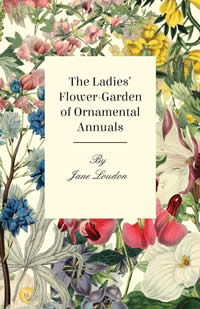 Jane Webb Loudon's most significant work was "The Ladies' Flower-Garden," a multi-volume set with each volume focused on a particular type of plants. The Miller Library has the first volume in this series devoted to annuals. While this book is in the Library's Rare Book Room and only available to view by appointment, many of the illustrations appear in "Garden Flowers," a book in the general collection by Robert Gathorne-Hardy. These were noteworthy for the time by including many different species on the same plate, set in loose arrangements that show contrasting features while maintaining scientific accuracy. The illustrations were also a big selling point for "The Ladies' Flower Garden" because, at the time, they were expensive to produce--and Loudon was able to show a greater number of species in a single book.
Jane Webb Loudon's most significant work was "The Ladies' Flower-Garden," a multi-volume set with each volume focused on a particular type of plants. The Miller Library has the first volume in this series devoted to annuals. While this book is in the Library's Rare Book Room and only available to view by appointment, many of the illustrations appear in "Garden Flowers," a book in the general collection by Robert Gathorne-Hardy. These were noteworthy for the time by including many different species on the same plate, set in loose arrangements that show contrasting features while maintaining scientific accuracy. The illustrations were also a big selling point for "The Ladies' Flower Garden" because, at the time, they were expensive to produce--and Loudon was able to show a greater number of species in a single book.
Excerpted from the Winter 2019 Arboretum Bulletin.
Link to this review (permalink)
The woman gardener by Frances Perry, 1958
Reviewed by: Brian Thompson on 2019-01-01
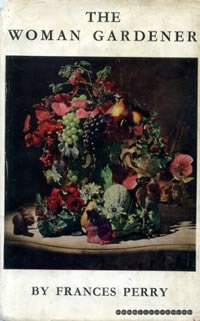 Frances Perry (1907-1993) perceived a similar lack of horticultural information for women more than a century after Jane Webb Loudon. As a horticultural lecturer, horticultural advisor (to her county council), and gardening correspondent in England, she noted an ongoing demographic change: more and more women were attending her presentations or writing her letters. Her colleagues, both men and women, had also observed this change.
Frances Perry (1907-1993) perceived a similar lack of horticultural information for women more than a century after Jane Webb Loudon. As a horticultural lecturer, horticultural advisor (to her county council), and gardening correspondent in England, she noted an ongoing demographic change: more and more women were attending her presentations or writing her letters. Her colleagues, both men and women, had also observed this change.
To address this need, she published "The Woman Gardener" (1955). In addition to general gardening advice, Perry chose topics she thought would have special interest for women. For example, an early chapter is titled "Salads and Quick Return Vegetables" and recognizes that "most housewives will agree that the first requirement of any salad ingredient is that it should be fresh." Later chapters present miniature gardens in various forms, houseplants, and tips on flower arranging and keeping cut flowers fresh – subjects not typically addressed in other general gardening books of the time. She broke down other barriers of the male hierarchy of British horticulture by becoming the first woman council member of the Royal Horticultural Society in 1968 and, a decade later, vice president of that organization.
Excerpted from the Arboretum Bulletin
Link to this review (permalink)
Beautiful leaved plants by Frances Perry, 1980
Reviewed by: Brian Thompson on 2019-01-01
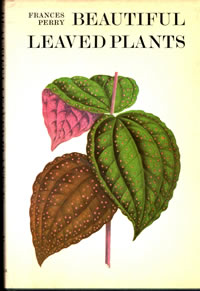 Brent Elliott, retired librarian and historian of the Royal Horticultural Society, declared that Frances Perry's writing showed "evidence of reading both broader and deeper than that of most garden writers of the time."
Brent Elliott, retired librarian and historian of the Royal Horticultural Society, declared that Frances Perry's writing showed "evidence of reading both broader and deeper than that of most garden writers of the time."
An example of this historical awareness is her book "Beautiful Leaved Plants." Perry describes 64 house and conservatory plants, popular in the mid-20th century, but chose to illustrate her selections with images by Benjamin Fawcett (1808-1893). Fawcett was a botanical illustrator who used wood engravings, an unusual technique for the time that is particularly effective in capturing the brilliance and subtlety of foliage.
Excerpted from the Winter 2019 Arboretum Bulletin
Link to this review (permalink)
An Irish florilegium by Wendy Walsh, 1983
Reviewed by: Brian Thompson on 2019-01-01
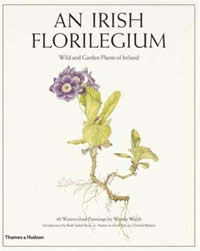 Women botanical artists have made many contributions to horticulture and botany. One of these was Wendy Walsh (1915-2014). English by birth, she also lived in Japan and the United States before settling in Ireland in 1958 at the age of 43. She lived and worked there the rest of her long life, providing illustrations for 33 books, many on Irish gardening and native plants.
Women botanical artists have made many contributions to horticulture and botany. One of these was Wendy Walsh (1915-2014). English by birth, she also lived in Japan and the United States before settling in Ireland in 1958 at the age of 43. She lived and worked there the rest of her long life, providing illustrations for 33 books, many on Irish gardening and native plants.
Her masterpieces were "An Irish Florilegium," published in 1983, followed by "An Irish Florilegium II" in 1987. Each contains beautifully printed copies of 48 watercolor paintings that she drew from nature. Roughly, a third of these plants are native to Ireland, while an Irish botanist or plant collector introduced another third. The rest celebrate the cultivars developed by the many fine nurseries and plant hybridizers of that nation.
E. Charles Nelson, a taxonomist with the National Botanic Gardens Glasnevin in Dublin, wrote the extensive plant notes to both volumes and the introduction to the second. Although he was 36 years younger, he and Walsh became fast friends after meeting at the beginning of this project. Their collaboration led to several more books, including three in the Miller Library.
Excerpted from the Winter 2019 Arboretum Bulletin
Link to this review (permalink)
Flower paintings of Ellis Rowan by Helen Hewson, 1982
Reviewed by: Brian Thompson on 2019-01-01
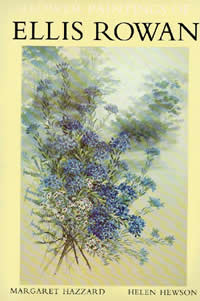 Ellis Rowan (1848-1922) was an Australian painter, specializing in wildflowers in all parts of that country at a time when the native flora was not well-known by European settlers. She was not trained as a botanist, which made her work of limited use in that field. However, the exuberance and abundance (at least 3,000 survive) of her paintings made her very popular. She typically combined flowers with leaves and stems into bouquets, and worked quickly, being able to paint in watercolors and gouache without initial pencil underlay.
Ellis Rowan (1848-1922) was an Australian painter, specializing in wildflowers in all parts of that country at a time when the native flora was not well-known by European settlers. She was not trained as a botanist, which made her work of limited use in that field. However, the exuberance and abundance (at least 3,000 survive) of her paintings made her very popular. She typically combined flowers with leaves and stems into bouquets, and worked quickly, being able to paint in watercolors and gouache without initial pencil underlay.
In "Flower Paintings of Ellis Rowan," Helen Hewson wrote that her images "evoke the particular quality of the beauty of the Australian bush, a beauty which is vivid, yet also elusive and vulnerable." Hewson notes the limitations of Rowan's work for botanists, but recognizes that "her work is so accurate that the specialist can identify a large proportion of the subjects with considerable reliability."
Excerpted from the Winter 2019 Arboretum Bulletin
Link to this review (permalink)
A guide to the wild flowers by Alice Lounsberry, 1899
Reviewed by: Brian Thompson on 2019-01-01
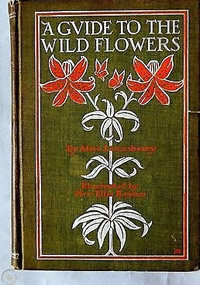 It was on a visit to the United States that Alice Lounsberry (1873-1949) of Boston, some 25 years younger, introduced herself to Australian painter Ellis Rowan. Lounsberry convinced Rowan to travel with her for two years, providing illustrations for three books she wrote on native plants: "A Guide to the Wild Flowers" (1899), "A Guide to Trees" (1900), and "Southern Wild Flowers and Trees" (1901).
It was on a visit to the United States that Alice Lounsberry (1873-1949) of Boston, some 25 years younger, introduced herself to Australian painter Ellis Rowan. Lounsberry convinced Rowan to travel with her for two years, providing illustrations for three books she wrote on native plants: "A Guide to the Wild Flowers" (1899), "A Guide to Trees" (1900), and "Southern Wild Flowers and Trees" (1901).
At the turn of the 20th century, it was an adventure, especially for two women, to be exploring the rural parts of the southeast. In "Southern Wild Flower and Trees," Lounsberry writes "Mrs. Rowan and I travelled in many parts of the south, exercising always our best blandishments to get the people of the section to talk with us. Through the mountainous region we drove from cabin to cabin, and nowhere could we have met with greater kindness and hospitality." The illustrations include plates in color, many black and white diagrams, and some delightful vignettes, typically showing native plants in the context of a larger landscape.
They were a good team. Lounsberry provided detailed botanic structure along with engaging observations of her subjects and their natural history, while Rowan's artwork found a new audience. Together, their books were very popular.
Excerpted from the Winter 2019 Arboretum Bulletin
Link to this review (permalink)
The Outdoor Classroom in Practice, Ages 3-7 : A Month-by-Month Guide to Forest School Provision by Karen Constable, 2019
Reviewed by: Dorothy Crandell on 2020-04-01
![[The Outdoor Classroom in Practice, Ages 3-7] cover](https://depts.washington.edu/hortlib/graphix/outdoorclassroominpractice.jpg)
How are we going to save the world? Focusing on forests is a step in the right direction. In education, the forest school has been defined in the UK Forest School Research Summary as "an inspirational process that offers children, young people and adults regular opportunities to achieve and develop confidence through hands-on learning in a woodland environment."
UK expert Karen Constable provides teachers with a wealth of ideas and experiences for outdoor learning by cycling through the year month by month. The Outdoor Classroom in Practice, Ages 3 – 7; A Month-By-Month Guide to Forest School Provision demonstrates how a forest school-style learning experience can be introduced and used in an everyday early childhood educational environment.
Although developed in the UK, the activities are meant to be adjusted to blend with existing curricular plans to fit the needs of children anywhere in the world. Entries cover managing the site, preparing resources, working with parents, and making evaluations. Risk assessment is an ongoing concern. Activities described in this book include muddy fun, looking for landmarks, creating camouflage, building fire safety, making a tabletop garden, staying dry on rainy days, and much more.
Fiddleheads Forest School in the Washington Park Arboretum is one of Seattle's innovative outdoor preschools. Forest school programs help to build self-esteem, confidence, independence, and happy young people. Creating a love of the outdoors in real time in all weather in all seasons is best started early to last a lifetime.
Given our environmental concerns today, there is urgency to the purpose of this book. It will help to prepare children with a voice to act for preservation of our common environment. It's our shared future, especially theirs.
Published in The Leaflet, Vol. 7 Issue 4, April 2020
Link to this review (permalink)
Oh, La La! : Homegrown Stories, Helpful Tips, and Garden Wisdom by Ciscoe Morris, 2020
Reviewed by: Brian Thompson on 2020-04-23
![[Oh, La La!] cover](https://depts.washington.edu/hortlib/graphix/Ohlala!.jpg)
"I am a storyteller."
Ciscoe Morris is an expert gardener, eager to share his knowledge with those at all levels of gardening ability. But this self-assessment from the introduction of his new book is also very accurate. He grew up in a large family of storytellers and that skill came first. Later, gardening became the framework for his tales.
"Oh, La La!" is a fine collection of short essays, each no more than a few pages. You can open the book anywhere and immediately be engaged, no matter the topic. Later, you'll realize how much you learned.
There are three main settings: his home garden, the Seattle University campus where he worked for many years, and the many locations from his travels. While the plants take center stage, the interactions of the gardener with other people and with animals – especially beloved dogs – are the memorable highlights.
I have several favorite stories. One of the longer chapters lays out the many – usually unsuccessful – ways to control moles, concluding, "if nothing else works, you can learn to live with moles." Another lesson confirms my personal experience with the Colorado blue spruce (Picea pungens var. glauca). It belongs in Colorado, safe from the spruce aphids that devastate this species in our mild, maritime climate.
Ciscoe promises this is not his last book. "I already have an idea for the next one. Oh, la la: I can't wait to get started!" I can hardly wait to read it.
Link to this review (permalink)
Olmsted in Seattle : Creating a Park System for a Modern City by Jennifer Ott, 2019
Reviewed by: Priscilla Grundy on 2020-05-06
![[Olmsted in Seattle] cover](https://depts.washington.edu/hortlib/graphix/OlmstedinSeattlereview.jpg)
Most people in Seattle know that the name Olmsted is connected to the city's landscapes. This elegant book presents both the context and the details of that connection. The text is clear and engaging, and the photographs and maps are handsome as well as instructive. For the many landscape designs, the reader may want to keep a magnifying glass at hand to help with details.
Two popular movements help explain how Seattle movers and shakers came to hire and support the plans of the far-off and famous Olmsted Brothers, a Brookline, MA firm. Most significant was the City Beautiful Movement, which spread the idea that any city worth anything needed to be beautiful. The other was the Playground Movement, which encouraged cities to develop many playgrounds, so that even poor children could grow up healthy and "moral."
Olmsted in Seattle carries the reader chronologically through the planning and execution of plans for many of the city's parks and boulevards. John C. Olmsted, who visited Seattle and created plans in 1903 and 1908, was the nephew (and stepson) of Frederick Law Olmsted, Sr., of New York's Central Park fame. Ott shows the progress, the politics involved, and the compromises necessary to carry out the plans. One compromise: In 1909 John Olmsted noted that walkways should have been included parallel to several drives, including Lake Washington, Montlake, and Washington Park. In our current need for more such paths for bikes and pedestrians, we can surely wish those had been built.
"Borrowed landscapes" were a major part of Olmsted's planning. He designed each park to take advantage of its natural contours, but especially to use views of mountains, water, and other vistas to make the park seem larger than it was. The gorgeous mountain and water views from Fort Lawton, for instance, informed Olmsted's plea to acquire it as a park, a wish only fulfilled years later with the inclusion of Discovery Park.
Near the end of the book Ott shows how the concepts that Olmsted promoted, such as curved paths, have been adapted in the decades afterward, so that the Olmsted influence continues.
The whole history depicted in Olmsted in Seattle is worth reading. On the other hand, readers in a hurry can just use the excellent index to trace the history of their favorite parks. Or they can just page through, admiring the photos, informational side bars, and awesome maps.
Published in The Leaflet, Volume 7, Issue 5, May 2020.
Link to this review (permalink)
Wilding: The Return of Nature to a British Farm by Isabella Tree, 2018
Reviewed by: Tracy Mehlin on 2020-05-16
![[Wilding] cover](https://depts.washington.edu/hortlib/graphix/wilding.jpg)
Isabella Tree and her partner, environmentalist Charlie Burrell, own the 3,500-acre property known as Knepp Castle Estate. Her book Wilding: The Return of Nature to a British Farm recounts the Knepp Wildland Project that took place over 18 years starting in 2000 after a failed effort to make the farm profitable with modern, intensive techniques. Their idea, inspired by a similar project in the Netherlands, was to undo many centuries of land management by introducing hardy large herbivores and then stepping back to see what would happen. The author defined it as: "Rewilding -- giving nature the space and opportunity to express itself – is largely a leap of faith." Take a look at a a 15-minute video of Tree introducing the concept.
This book was enjoyable to read because Tree describes various wildlife, birds, insects, mammals, and livestock from an amateur's enthusiastic perspective rather than with a dispassionate scientific voice. Tree keeps the pace of the narrative moving, yet provides enough details of animals, ecology, history and even governmental regulations that the reader understands why they choose to rewild despite considerable obstacles.
Her narrative of the slow evolution of rewilding their large property takes place over three decades. The story of the farm pasture and woods, neighbors, various national agencies and the wider economy is interspersed with detailed accounts of rare birds, land-use history, heritage breeds of livestock, and the inner workings of ecological interdependence. Tree's special fondness for the turtle dove is appropriate: nearly extinct in Britain, it is thriving at Knepp.
The role of plants is integral to animal habitat. Tree learns that animals, specifically large herbivores and predators, directly contribute to remaking plant communities which then evolve to support even more species of wildlife. Their philosophy could be boiled down to: increase biodiversity, stay hands-off, build resiliency -- repeat!
Neighbors and their notions of a tidy, well-cared-for, pastoral landscape proved to be the most vociferous opponents of allowing their land to revert to a wild state. Tree attempts to understand their unease by looking into the social and psychological impact of living in a controlled, tidy, managed environment. Neighbors saw the Knepp project as abuse and gross negligent abandonment. The author remarks how the oldest neighbors remember the hedgerows and all the birdsong now absent in the agriculturally productive countryside. She also repeatedly points out how their land is marginal and even with modern equipment, chemicals and "improved" breeds they could never make a profit. She wonders why farmers, and governments through subsidies, spend so much on producing food when so much of it wasted, thrown away, uneaten by consumers or worse, never even making it to market because of the low prices received for commodity crops.
Readers interested in regenerative agriculture, ecological restoration and climate change mitigation will find Wilding an inspiring source of hope.
Published in the Leaflet, June 2020, Volume 7, Issue 6.
Link to this review (permalink)
Entangled Life : How Fungi Make Our Worlds, Change Our Minds & Shape Our Futures by Merlin Sheldrake, 2020
Reviewed by: Rebecca Alexander on 2020-06-06
![[Entangled Life] cover](https://depts.washington.edu/hortlib/graphix/entangledlife.jpg)
Only a few pages into Merlin Sheldrake's Entangled Life, my mind expanded like a puffball, fit to burst from the wildly proliferating spores of ideas. This is so much more than a book about mushrooms, the showy fruiting bodies that tend to dominate our attention to the fungal world. Merlin Sheldrake, son of biologist Rupert Sheldrake, holds a Ph.D. in tropical ecology for research on mycorrhizal relationships. The book should appeal to scientist and layperson alike, as the author excels at communicating complex concepts in lucid and literary prose, while retaining a sense of humor, wonder, and above all, hope. What role does hope play? Reading the book at this time of pandemic and social inequity, the notions of mutualism, symbiosis, and involution (involution—distinct from evolution's focus on competition--attends to patterns and strategies of cooperation) ramify beyond the realm of mycelial networks, their implications readily extendable to human interaction.
Sheldrake wholeheartedly embraces imagination and creativity in the realm of scientific research. He does not shy away from describing fungal 'communication,' and the ability of organisms that do not possess brains to make 'decisions.' Conventional science may frown upon anthropomorphism as soft thinking, but if we eschew it entirely, we might close our minds and dismiss observable phenomena. Biologist Robin Wall Kimmerer points out that the Potawatomi language "is rich in verbs that attribute aliveness to the more-than-human-world," while English offers no alternative way to talk about other living organisms without reducing them to an inanimate 'it.' Kimmerer says, "Biological realities are never black and white. Why should the stories and metaphors we use to make sense of the world—our investigative tools—be so?"
The book calls attention to the groundbreaking research of scientists, many of them women (Suzanne Simard's work on carbon transfer between plants; Katie Field on mycorrhizal solutions to agricultural problems; Lynne Boddy on mycelial networks; Lynn Margulis's endosymbiotic theory once dismissed as "evolutionary speculation"). Sheldrake describes his meetings with Pacific Northwest innovator and fungal theorist Paul Stamets (who has recently been working on fungal antiviral compounds), and mycoenthusiasts and entrepreneurs like Peter McCoy (founder of Radical Mycology, a group that promotes citizen scientist education on things fungal, such as mycoremediation and mycofiltration). Farther afield, in New York, the versatility of fungi is being harnessed to make biodegradable packing and building materials and furnishings as alternatives to plastic. Imagine ordering a grow-your-own-lampshade kit, or sitting on a fungal stool!
Each chapter presents surprising observations that may dismantle and rearrange the reader's preconceptions. We humans tend to think of ourselves as discrete, separate individuals, but each of us is actually an ecosystem "composed of—and decomposed by—an ecology of microbes" that make it possible for us to function (to digest our food and reap nutrients from it, for example). We are not unique in this. Symbiosis is widespread.
An example that reveals the decision-making abilities of organisms without brains is an experiment done in Japan. Scientists set slime mold in petri dishes that replicated the layout of Greater Tokyo, with obstacles represented by bright light. The path the slime mold took was a close match for Tokyo's rail system. Mycelial networks, too, can function in a brain-like way, responding to electrical, chemical, or other sensory impulses to communicate about surrounding conditions, directing growth accordingly.
Why should truffles (the subterranean fruiting bodies of certain kinds of mycorrhizal fungi) attract humans and other animals with their smell? Because they are underground, they cannot disperse spores without a partner. Their odor coaxes us to dig for and consume them, thereby dispersing their spores above ground. This is an example of mutualism which is beneficial to both partners.
Until reading this book, I did not know that the term ecology, coined by artist and biologist Ernst Haeckel in 1866, was influenced by observations about lichen. Ecology is the interrelationship of organisms in their environment, and points to nature as an interconnected whole, "a system of active forces." In 1869, Swiss botanist Simon Schwendener presented a "dual hypothesis of lichens," showing that lichen is composed of two different entities, a fungus (to offer physical protection and nutrients) and an alga (to harvest light and carbon dioxide). By 1877, German botanist Albert Frank coined the word symbiosis to describe this fungal-algal partnership.
The idea that one organism originates from two different lineages defies the tidy categorization that taxonomy prefers. Trevor Howard, curator of University of British Columbia's lichen collection, refers to the "lichening rod effect," whereby lichens strike and splinter apart familiar concepts into new forms. It gives us a new way of thinking about life. Sheldrake points to biologist Lynn Margulis and her visionary theories on the coming together of different organisms, the "intimacy of strangers." Margulis says: "Lichens are remarkable examples of innovation emerging from partnership. The association is far more than the sum of its parts." It turns out that lichens may be made up of more than two partners. Lichenologist Toby Spribille discovered by chance that lichen DNA contained several fungal and bacterial partners, so a lichen might be seen both as an individual, and/or as a microbiome. We need perspectives that transcend rigid categories in other spheres of existence, too. Cultural theorist David Griffiths was inspired by lichen symbiosis to write a paper entitled "Queer Theory for Lichens."
This book is the work of an adult who has retained the his childhood curiosity about the world, who built piles of leaves and embedded himself in them to see if he could experience their decomposition. He continues to be a fungal experimenter, brewing and fermenting, and exploring the many possibilities of partnering with fungi to mend the planet. I highly recommend immersing yourself in this book. Merlin Sheldrake's enthusiasm is contagious.
Link to this review (permalink)
Big Lonely Doug by Harley Rustad, 2018
Reviewed by: Tracy Mehlin on 2020-07-01
![[Big Lonely Doug] cover](https://depts.washington.edu/hortlib/graphix/BigLonelyDougreview.jpg)
Harley Rustad's Big Lonely Doug is the story of one superlative tree spared from the saw by a forester who recognized its value. Later this tree was named Big Lonely Doug by members of the Ancient Forest Alliance, who hoped to use the 1,000-year-old Douglas fir to inspire a new initiative to preserve Vancouver Island's remaining old growth forests.
Rustad covers the history of British colonial exploration, including the Scottish botanist named David Douglas. He also compares the development of timber extraction as the foundation of British Columbia's economy and with the more recent growth of environmental activism trying to save isolated patches of virgin forest.
The author intends to give a complete picture of a complex situation without sentimentality. The reader understands from the start that Rustad sympathizes with the activists and treasures the ancient forests and giant trees. However, his treatment of the loggers is respectful. He represents the loggers' sensibility as intimately knowledgeable about forests, and he accepts that trees are a resource to be harvested. Cutting down the forests provides jobs and supports communities. The corporate owners don't get off so easily when Rustad reveals how local sawmills closed down while raw logs got exported and processed in Asia.
Reading about the virgin forests with giant, ancient Western red cedars, Douglas firs and Sitka spruce (Thuja plicata, Pseudotsuga menziesii and Picea sitchensis) made me nostalgic for the times in college when I hiked among equally giant and awe-inspiring redwoods on the Northern California coast. I've never understood why all the rare fragments of remaining old growth were not cherished by everyone and preserved in national parks. We know how to log sustainably without leaving a clear-cut wasteland behind, so why are clearcuts permitted?
Celebrity trees like Big Lonely Doug, saved by a logger, capture the public's imagination. Activists learned over the decades how to harness that celebrity to generate support for increasingly protective logging regulations. And now ecotourism's beneficial economic impact acts as a counterargument against the reasoning that logging equals jobs so logging must continue unchecked. Harley Rustad documents the story of one remarkable specimen while leaving readers feeling hopeful that ancient forests may finally gain some official appreciation and protection.
Published in the Leaflet for Scholars, July 2020, Vol. 7, Issue &.
Link to this review (permalink)
In Search of Meadowlarks: Birds, Farms, and Food in Harmony with the Land by John Marzluff, 2020
Reviewed by: Tracy Mehlin on 2020-07-17
![[In Search of Meadowlarks] cover](https://depts.washington.edu/hortlib/graphix/meadowlarks.jpg)
Professor Marzluff sets the scene for his exploration by camping in a cornfield in Illinois to survey birds. After an early morning walk he reports: "It takes me an hour and a half before I hear my first meadowlark—an eastern—belting forth a high-pitched, if simple tingaling from an abandoned grassy field." After 3 hours he counts only 6 meadowlarks, the lowest count ever on that stretch of road. In North America, in fact, "the estimated population [of meadowlarks] has decreased by 71 percent since 1966." Yikes! The reasons for the decline are complex, from habitat loss to decrease of prey insects due to pesticides. In Search of Meadowlarks: Birds, Farms, and Food in Harmony with the Land covers case studies and field trips to farms, vineyards and ranches from Montana to Costa Rica and Washington to California in order to discover which agricultural practices sustain birds.
What more can farmers do to help the environment than just avoiding pesticides? I've never thought about how farms could provide habitat to wildlife and support birds. I assumed wildlife conservation was something that happened in wilderness areas or abandoned fields. Marzluff points out that creatures also inhabit farms and ranches, albeit in declining numbers. Pasture and fallow fields can resemble natural grasslands while hedges resemble forest edges. Regenerative agriculture is a new buzzword to describe practices on farms and ranches that might build soil health, sequester carbon, prevent storm water pollution or support wildlife. The regenerative practices must also produce food and be economically sustainable. That last part is tricky, but the example farms that Marzluff visits have managed to make it work.
One simple example employed by California vineyard Tres Sabores involved installing bird boxes to house nesting owls. Research shows an owl family consumes more than a thousand rodents over a summer. This saves vineyard managers considerable time and money controlling grape-damaging voles, rats and gophers. Another example that surprised me was how tightly-controlled cattle grazing in Montana improved river ecosystems. Cows eat invasive grasses and compact the ground to allow vernal pools to last longer into early summer, providing habitat to amphibians.
Marzluff explores how some farmers spare land on the margins to support wildlife while others embrace sharing the land, by delaying pasture mowing, for example, to allow birds to fledge their young. The book concludes with a hopeful chapter on actions consumers and policy makers should take to assist the farmers who provide for birds.
In an ideal world, farms and ranches practicing sharing and sparing methods would form networked corridors to wild lands to boost biodiversity and reduce the risk of localized extinction. Readers wanting to dig deeper into the scholarly background of themes revealed in this book should also read Nature's Matrix: Linking Agriculture, Conservation and Food Sovereignty by Ivette Perfecto, John Vandermeer and Angus Wright (2009). In Search of Meadowlarks is enjoyable reading for anyone interested in wildlife conservation or regenerative agriculture.
Published in the Leaflet for Scholars, August 2020, Vol. 7, Issue 8.
Link to this review (permalink)
Greenwood: A Novel by Michael Christie, 2019
Reviewed by: Tracy Mehlin on 2020-08-14
![[Greenwood: A Novel] cover](https://depts.washington.edu/hortlib/graphix/Greenwoodforreview.jpg)
In the year 2038 Jake Greenwood works as a tour guide at the Cathedral eco-resort on Greenwood Island near Vancouver, British Columbia. It's one of the last stands of living trees to survive after the Withering killed off most forests around the world, leaving a dusty, grim environment. Jake's choices in life are limited: mired in suffocating student debt, she's a dendrologist in a world without trees. So a job at the Cathedral suits her even if it is operated for profit by the soulless HoltCorp. When a former flame suggests she might be a direct descendant of the timber baron Harris Greenwood or even possibly the heir to J.R. Holt, founder of HoltCorp, an incredulous Jake wonders what difference it could make.
Four generations of Greenwoods, all troubled in some way, emotionally, financially, or faced with difficult choices, are united by the theme of trees. In 20th century Canada that means forests, timber, sugar maple tapping, radical tree advocacy, fine woodworking, and dendrology. Author Michael Christie slowly unveils the Greenwood family history one generation at a time, going backward for most of the novel to 1908 and then forward again to 2038.
The plot is complicated with mysteries of birth and circumstance revealed bit by bit as we delve deeper into each character's relationships with brothers, parents and lovers. The complex story is never confusing, although one wonders what motivated some characters to make relationship-ending decisions. Overall, it was a diverting and thought-provoking summer read.
Published in the Leaflet, September 2020, volume 7, issue 9.
Link to this review (permalink)
Corn: A Global History by Michael Owen Jones, 2017
Reviewed by: Jessica Moskowitz on 2020-09-17
![[Corn: A Global History] cover](https://depts.washington.edu/hortlib/graphix/Cornaglobalhistory.jpg)
Do you ever wonder where the ingredients in your tamale came from? Each volume in Reaktion Books' Edible series explores the global history and culture of a type of food. These little books pack in several chapters on various cultural histories around the crop they explore. It is essentially a food memoir and at the end of the each book, recipes are provided.
In Corn: A Global History, readers learn it is hard to determine how corn originated, due to its need for humans to cultivate it. Corn cannot grow wild. We also learn that maize is classified based on the grain's appearance and starch content. The book contains a large section on Indigenous foods based on corn.
In Tomato: A Global History, by Clarissa Hyman, we learn that the word derived from the Nahuatl 'tomatl,' a generic term for a globose fruit or berry with seeds and watery flesh sometimes enclosed in a membrane. This ambitious memoir explores the tomato's migration throughout the New World to the Old World, including Italy. One of my favorite pizzas, the Margherita, was created in 1889 in Naples to honor the Italian queen of the same name. The book investigates tomato cultivation today, including how scientific advances are changing the fruit, while conservation of heirloom varieties continues.
Avocado: A Global History, by Jeff Miller, explores the history and current social media craze of the fruit and describes how it has been grown on every continent except Antarctica. What I found the most intriguing is how avocados are in the laurel family, the oldest group of flowering plants, with the term laurels denoting excellence. Like corn, beans, and tomatoes, the avocado's history can be traced back to the ecological conditions of the Neogene period, which created the Mesoamerican land-bridge that joined the continents of North and South America, creating a habitat for these foods to evolve into what we know today.
Beans: A Global History, by Natalie Rachel Morris, explores the staple food's humble beginnings over 9,000 years ago. The diverse genus includes many different varieties and the food can be used in many forms: dried, frozen, or canned. The substantial nutritional benefit of the food led to the people of Tuscany being known as "bean-eaters." I especially enjoyed the chapter on the lore and literature of beans.
Together, the books are a feast of knowledge. They are best enjoyed before a meal.
Published in the Leaflet for Scholars, October 2020, Vol. 7, Issue 10.
Link to this review (permalink)
The Scentual Garden: Exploring the World of Botanical Fragrance by Ken Druse, 2019
Reviewed by: Tracy Mehlin on 2020-10-22
![[The Scentual Garden] cover](https://depts.washington.edu/hortlib/graphix/thescentualgarden.jpg)
"Green, resinous, camphorous, nutmeg, a scant suggestion of lemon rind." Ken Druse has a very keen nose. In The Scentual Garden, he undertakes an adventure, as he puts it, to classify botanical fragrance. Druse wants to give gardeners and designers an expanded lexicon for scent that equals the rich vocabulary we already have for color, texture and form. It won't surprise anyone familiar with his other books that The Scentual Garden is 'coffee table' quality, with heavy paper, lots of color photographs of plants in the landscape and of composed portraits of plants on a solid color background. It's pleasurable to simply flip through the pages for Ellen Hoverkamp's photography alone. However, once you start reading the text of this reference book you will ask yourself, do I get "nutmeg and a scant suggestion of lemon rind" from my rosemary shrub?
Druse devised 12 "botanical fragrance categories." Most are obvious and self-explanatory, such as fruity, medicinal, spice and forest. Others are more esoteric and mysterious, like heavy or indolic, which is described as "mothballs, hot garbage, overripe fruit, excrement..." Eww! Apparently some pleasant-smelling flowers, like gardenia, can have a secondary background scent of indole. I say "apparently" because when I smelled my own gardenia in flower just now I didn't get anything indolic. But smell is deeply personal, as Druse fully explains in the opening chapters. I grew two varieties of heliotrope this past summer. One smelled like delicious vanilla/cherry pie as expected while the other smelled like the horrible synthetic fragrance used to clean public restrooms. My husband thought of urinal cake. I'll not grow that cultivar again!
Each category includes an explanation with sample plants, followed by encyclopedia entries for more plants in the category. Plant entries describe the scent, use in the garden, cultivation tips, sometimes a bit of history, and sometimes recommended cultivars. Druse writes with honesty and insight, from personal experience of decades of knowing plants. After reading The Scentual Garden, I'm more likely to sniff my plants and ponder in which category they belong and whether there is a hint of indole in my star jasmine.
Published in the November 2020 Leaflet, Volume 7, Issue 11.
Link to this review (permalink)
Wild Child: Coming Home to Nature by Patrick Barkham, 2020
Reviewed by: Laura Blumhagen on 2020-10-22
![[Wild Child] cover](https://depts.washington.edu/hortlib/graphix/wildchild300.jpg)
Patrick Barkham's Wild Child: Coming Home to Nature chronicles his year as a parent volunteer at the his children's forest school, interwoven with memories of his own childhood and musings on the role of nature in our lives, especially while we are young. Childhood has changed since Barkham's youth in 1980s Norfolk (UK), when he and neighboring kids roamed every day, inventing outdoor diversions. Most parents today feel a responsibility to provide constant supervision, or at least keep kids in out of the weather. Something has been lost, Barkham believes, and enrolling his three children at Dandelion outdoor nursery helps to restore it, grounding them in the natural world around them. As he says, "Formative experiences resonate throughout our lives."
For me, one of the highlights of this book was the opportunity to learn new words and new usages. Some, like "reception year" (which refers to the first year of primary school), "clodgy," "gubber," and "slub" (all words for mud), and "sallow" (another word for the pussywillow tree), are new words for known concepts. Others are novel concepts for me. Soft fascination, which describes the power of forests and other natural environments to keep our senses gently engaged without wearing out our attention spans or tiring us, was a revelation to me. Coined by environmental psychologists Rachel and Stephen Kaplan in 1989, soft fascination is a hallmark of restorative environments, distinct from a state of "directed attention" such as listening to a lecture or watching TV. Environments rich in soft fascination help to recharge us, making them ideal for learning. Some educators in the UK have taken advantage of this fact by offering some outdoor lessons to upper primary school students who struggle in the classroom. The author is impressed with what he learns visiting two of these outdoor experience programs. In one forest school program for English language learners, many of them refugees, students who participated had improved test scores and attendance as well as harder-to-quantify improvements in confidence and attentiveness.
As an appendix, Barkham provides plenty of fresh ideas for outdoor engagement, including hapa-zome (a Japanese method of transferring leaf colors and patterns to fabric with a hammer) and seaweed cyanotypes. He reminds parents and teachers that it's not knowledge but love of nature we need to impart. Young people will gather their own knowledge, once they have a chance to get outdoor experiences.
Published in the November 2020 Leaflet for Scholars, Volume 7, Issue 11.
Link to this review (permalink)
Just the Tonic: A Natural History of Tonic Water by Kim Walker, 2019
Reviewed by: Rebecca Alexander on 2020-11-18
![[Just the Tonic] cover](https://depts.washington.edu/hortlib/graphix/justhetonic.jpg)
The Miller Library has other books on cinchona (the plant source of quinine), gin (from juniper), and various plant-based spirits, but Just the Tonic focuses on the evolution of this effervescent beverage, a journey from cinchona-derived medicinal preparations to treat fever, purportedly healthful restoratives for a host of ailments (the kombucha and CBD of earlier eras!), to a recreational beverage we still consume with or without spirits. Along the way, the authors touch on the history of malaria and its treatment, the effects of conquest and imperialism, how humans have harvested and stored ice since Mesopotamia's tamarisk-lined icehouses of nearly 4,000 years ago, and so many other fascinating morsels of information. The book is profusely illustrated and captivatingly written by Kim Walker (a medical herbalist and historian of plant medicines) and Mark Nesbitt (curator of the Economic Botany Collection at Kew).
The Cinchona tree is native to the high-altitude cloud forests of the Andes, from Colombia south to Peru and Chile. It is a medium-sized evergreen tree with cinnamon-colored bark and loose flower clusters said to have a fragrance similar to lilac. It is the bark which was sought for its anti-malarial properties. However, malaria was not a documented ailment in South America until the Spanish conquest, which added population density to damp lowlands where mosquitoes thrive. 1633 marks the first known reference to use of the bark of the 'fever tree'(arbol de calenturas) in the writing of a Peru-based Spanish priest, who noted that the bark could be dried, pulverized, and dissolved in a drink that would treat the fevers malaria causes. Eventually, the medicinal use of cinchona bark reached Europe. We tend to think of malaria as a tropical ailment, but marshy regions of western Europe harbor a less severe strain of the illness.
Cinchona bark is intensely bitter, so it was made palatable with port wine, herbs, treacle or syrup, citrus peel, and occasionally opium, in an assortment of proprietary formulations. (Advertisements for these are among the colorful illustrations in the book.) Where there is a market for a plant-based remedy, there is a motive for plant exploration, and this led to overharvesting and worker exploitation in South America. Plantations were also created in Java. But the amount of quinine present in the many species of Cinchona varies, and botanists had a challenge in telling species apart based on their dried bark. In the early 19th century, French chemists isolated two of the alkaloids found in the bark—cinchonine and quinine. This facilitated dosage measurement, an important thing, because too little is ineffective and too much is dangerous (even today there are instances of avid homebrewers developing cinchonism from an overdose of quinine).
Because of quinine's toxicity and decreasing efficacy (the parasites were becoming resistant to it), there was a shift in the 20th century toward synthetic antimalaria drugs such as chloroquine (a name that may have a recent familiar ring to it!). Still, tonic water—like the Schweppes Bitter Lemon I remember drinking on hot days in Israel—remains associated with the eradication of malaria (though the amount of quinine in such drinks is minimal). For me, it conjured the history of Jewish immigrants draining swamps in the valleys and coastal plains of British Mandate Palestine. (By 1968, Israel was deemed malaria-free.)
The tonic water we know today was inspired by the popularity of visiting natural mineral springs, beginning in the times of the Roman Empire. Scientists in the 18th century strove to come up with a way to simulate this effervescence associated with healthful benefits by contrast with turbid swamp water), and gradually refined their devices for creating "bubbling scintillation" (see the illustration of an apparatus for "impregnating water with fixed air") in a laboratory setting. Eventually, soda water became ubiquitous in soda fountains and grocery stores. These days, one can even make sparkling soda at the touch of a button, at home. Kew has created its own Royal Botanic Tonic and organic gin, and the book's final chapter includes recipes for cocktails and mocktails. Bottoms up!
Link to this review (permalink)
Spirit of Place: The Making of a New England Garden by Bill Noble, 2020
Reviewed by: Brian Thompson on 2020-11-18
![[Spirit of Place] cover](https://depts.washington.edu/hortlib/graphix/spiritofplacethemakingofaNewEnglandgarden300.jpg)
Why did the Miller Library add a new book about a private garden in Vermont? Partly because the author and garden creator, Bill Noble, has several connections to the Pacific Northwest. However, I primarily recommend this book as an engaging memoir.
Spirit of Place: The Making of a New England Garden is Noble's almost 30-year story of the property he and his partner, James Tatum, own in the Connecticut River Valley. This was not a new garden; the previous owners had formed its design for 60 years.
The challenge that the author faced was retaining the garden's historical character while shaping his own vision. "Much of what gardening is about is the feeling of being connected to a place, fostering a sense of belonging, and becoming familiar with the natural rhythms and cycles of a particular piece of the earth."
Many famous gardens and their designers in North America and Europe influenced the author, including the artists of the nearby Cornish Art Colony. However, his long-time role as director of preservation for the Garden Conservancy had the biggest impact. This included his work with the Chase Garden in Orting, Washington.
He credits Ione Chase with helping him to understand the value of designing a garden to incorporate its view: Mount Rainier in her case, the foothills of the White Mountains of New Hampshire in his garden. She also taught him the value of using familiar or common plants "to created refined garden beauty."
Plants in Noble's garden include a blue willow (Salix irrorata) he discovered in the Witt Winter Garden at the Washington Park Arboretum, and Berberis × ottawensis 'Royal Cloak' found at the Bellevue Botanical Garden. Three plants of the latter came home in his carry-on luggage and are now "part of the garden's backbone." Heronswood and Forestfarm (Williams, Oregon) Nurseries were important sources for other plants.
Vermont has long and cold (USDA zone 4b) winters with snow often lasting well into April. While Seattle is much milder, this is the perfect book to read for inspiration while staying out of the grey and gloom of our winter!
Published in The Leaflet, December 2020, Vol. 7, Issue 12.
Link to this review (permalink)
Blooming Flowers: A Seasonal History of Plants and People by Kasia Boddy , 2020
Reviewed by: Tracy Mehlin on 2020-11-25
![[book title] cover](https://depts.washington.edu/hortlib/graphix/bloomingflowers284.jpg)
How did the chrysanthemum move through history, associated in its native China as an elixir of youth to symbolizing Japanese imperial power, and then transform into an invitation to join a protest march against the Vietnam war in 1967? Read the delightful Blooming Flowers: A Seasonal History of Plants and People to find out.
Blooming Flowers is a work that documents how horticulture permeates society with both symbolism and literal enthusiasm for colorful displays. Author Kasia Boddy, professor of American literature at the University of Cambridge, takes a deep dive on the historic, cultural, literary, culinary, medicinal, and scientific background on common garden flowers, such as geraniums, and marigolds. She also includes a few less commonly grown flowers like saffron, almond, and lotus. Boddy relates why flowers are so significant to human culture:
"One reason we love flowers is because they help us talk to each other about the big and small questions of life: about love, death, class, fashion, the weather, art, disease, an allegiance to a nation, religion or political cause, the challenges of space and the passage of time."
Divided into four seasons, each with four representative flowers, Boddy's book entertains us with literary quotations and color images of flowers in famous paintings and illustrations. She unearths the earliest mentions of each flower and traces how the symbolism of some flowers changed over the centuries in Asian and European cultures. The sheer breadth of her knowledge is engaging, and the pace is steady. Just as she starts to get into details on one example in art history she moves smoothly on to the next example in art or politics. The chapter on the winter blooming almond starts with words from D. H. Lawrence while he lived in Tuscany: "pink houses, pink almond, pink peach and purply apricot, pink asphodels". Also included is van Gogh's painting of a blooming almond twig in a glass inside his modest room in Arles, France. The chapter concludes with observations of how much water California's million acres of almond orchards require and notes that despite how toxic bitter almonds are to human health, internet quacks peddle the poison as a cancer cure.
I've grown twelve of the sixteen flowers explored in Boddy's book and I now appreciate the hidden meanings and cultural connections lurking in my garden. I found Blooming Flowers pleasurable reading that provides many interesting tidbits of lore.
Published in The Leaflet for Scholars, December 2020, Volume 7, Issue 12
Link to this review (permalink)
Nature Obscura by Kelly Brenner, 2020
Reviewed by: Priscilla Grundy on 2021-01-21
![[Nature Obscura] cover](https://depts.washington.edu/hortlib/graphix/natureobscura300.jpg)
In this second year of seemingly never-ending plague, Nature Obscura by Kelly Brenner speaks directly to our condition. What better time to learn the pleasures of urban nature? Even now with some formidable restrictions, we can walk in our neighborhoods and look closely. The book focuses on Seattle, but most of the species described can be found in any city.
Each chapter builds a biography of a different life form, some more obvious, like Anna's hummingbird, and others harder to see, or to see as wondrous, like the algae and insects in Brenner's backyard pond. She even makes slime mold appealing. For that example and several others, the budding urban naturalist will need a hand lens, or in some cases a microscope, to discovery the intricacy and beauty of the subject.
In the chapter on dragonflies, Brenner begins by describing an adult emerging slowly from the larva. The description takes you right in: "Then the yellow eyes, still a muted brownish through the skin, begin to move like marbles sliding under a piece of tissue paper. . . . Next the adult slides out of the skin as if being squeezed from a tube of toothpaste." The chapter includes the author's visits to wetlands in Eugene OR, discussion of the distressing loss of wetlands in the Puget Sound area, which dragonflies require, and more adventures with these insects at the constructed wetlands at Magnuson Park in Seattle.
Brenner urges readers to pay close attention to what they see around them, to "get their eyes in" to focus on nature. Dr. Seuss's first picture book, And to Think That I Saw It on Mulberry Street, begins with a boy instructed to watch carefully for surprising things every day on his walk home from school. Seuss's boy imagines fantastic rather than real discoveries. Kelly Brenner wants you to see the amazing in what is there in front of your eyes.
The book's cover and a few well done but unlabeled black and white illustrations help the reader visualize Brenner's subjects. Many more would be helpful. Instead, blossoming urban naturalists will need to pursue the excellent bibliography to find images and more information. Each of the sixteen life forms described in the book has its own list of reference works – a gold mine indeed.
Published in The Leaflet, February 2021, Volume 8, Issue 2.
Link to this review (permalink)
The Sakura Obsession by Naoko Abe, 2019
Reviewed by: Brian Thompson on 2021-01-26
![[The Sakura Obsession] cover](https://depts.washington.edu/hortlib/graphix/sakuraobsession300.jpg)
In Japan, "the sakura, or cherry-blossom, culture of the twentieth and twenty-first centuries revolved around the flower's short life and swift, predictable death. The cherry blossom was ephemeral, like life itself."
Naoko Abe wrote about this tradition in her native Japanese in a book published in 2016. It was very well received and there was immediate interest in an English translation. She decided instead to do further research, especially on the British roots of her story. In 2019 she published the largely newly-written Sakura Obsession, the source of the quotation above, in English. For this more global audience, she included the history of many societal practices likely unknown outside of Japan.
She also describes the wild species and the many cultivars and selections of Prunus made over the centuries in Japan. By the late 1800s, these had largely been pushed aside from gardens by Prunus x yedoensis 'Somei-yoshino' that as a clone, provided the uniformity desired for Japanese ceremonies. This is the cherry tree of the University of Washington Quad and the dominant variety planted at the Washington, D.C. Tidal Basin.
In a parallel storyline, Abe writes the biography of Collingwood 'Cherry' Ingram (1880-1981), who rescued many out-of-favor cherry selections by bringing them from Japan to his English garden, later reintroducing them to their home country. It is also the study of the close relationship between two island nations and colonizing powers, Japan and Britain, and how horticulture was a common language.
There is a somber side to this history. As is possible in any culture, the symbolism of the flowers changed, especially for Japanese children, including Abe's father, in the 1930s. "Rather than focusing on cherry blossom as a symbol of life, the songs, plays and school textbooks now focused more on death." During World War II, branches of cherry blossoms were used to wave farewell to kamikaze pilots as they took off in their planes, going to their deaths.
On the whole, however, this is a book of hope and international goodwill. I didn't expect to get hooked by this story but I did, and recommend it for the engaging narrative of intellectual exchange and horticultural history.
Published in the Leaflet for Scholars, February 2021, Volume 8, Issue 2.
Link to this review (permalink)
Braiding Sweetgrass: Indigenous Wisdom, Scientific Knowledge and the Teachings of Plants by Robin Wall Kimmerer, 2013
Reviewed by: Priscilla Grundy on 2021-02-18
![[Braiding Sweetgrass] cover](https://depts.washington.edu/hortlib/graphix/braidingsweetgrass300.jpg)
Braiding Sweetgrass makes for good reading about all of the topics listed in the subtitle. Robin Wall Kimmerer writes engagingly, drawing the reader in. The book is full of information about Native American connections to plants. Because the author is a biologist, the scientific relationship to her Indigenous background is always made clear. Kimmerer is a member of the Potawatomi nation and a professor of environmental and forest biology at the State University of New York College of Environmental Science and Forestry.
She weaves the title elements together with her life as the mother of two daughters in a series of loosely connected essays. Her main themes are gratitude and responsibility, qualities valued highly among Native American peoples, values she argues are necessary if we are to save our planet from climate change and especially from our own greed. No one will find saving plants important enough to make sacrifices, she insists, unless they have a relationship with those plants.
Each chapter combines essay with narration. For instance, in "Maple Sugar Moon" she begins by telling an Anishinaabe creation story about Nanabohzo, the Original Man, diluting the sap of the maple tree, which originally had come directly from the tree as syrup. Now many hours of boiling down are required to make the same syrup. He did so as punishment after people became lazy and had not expressed gratitude or acted responsibly toward nature's gifts.
Then Kimmerer tells how she had her daughters collect many buckets of maple sap and spend hours boiling them down, using Native American methods – a lot of very hard work. She believes part of being a good mother was teaching the girls their heritage through this work. Mixed into her narrative Kimmerer explains scientifically how the tree creates sap and how the process benefits the tree. She is blending the elements of gratitude, to the tree for producing sap, and responsibility, the work of making the syrup for people to enjoy.
Kimmerer doesn't expect her non-Indigenous readers to follow her own practices of asking plants' permission before harvest or giving them a tobacco offering in gratitude. By including these practices, she does illustrate ways of developing human-plant relationships. With her students, described in other chapters, as with her daughters, she shows that by taking them into nature she can help them make those connections. The rest of us will have to find our own paths, perhaps using her examples as models. This book makes a convincing case that those connections are necessary for the future of the plant world and therefore of our own.
Published in The Leaflet, March 2021, Volume 8, Issue 3.
Link to this review (permalink)
The Cactus Family by Edward Anderson, 2001
Reviewed by: Brian Thompson on 2021-09-20
Edward Anderson was for 30 years a biology professor at Whitman College in Walla Walla before finishing his career at the Desert Botanical Garden in Phoenix. The Cactus Family is the culmination of his life's work as, sadly, he died shortly after publication, but more importantly because it will be a long-time standard reference for these popular plants.
While not a gardener's book--a chapter on cultivation is included but is by a different author--this provides a superb view of the remarkable diversity of cacti, well captured by excellent photographs, most by the author and many in situ. Highly recommend, too, are the chapters on ethnobotany and conservation of cacti, which illustrate how important these plants have been and continue to be throughout their range in North and South America.
Excerpted from the Summer 2012 Arboretum Bulletin.
Link to this review (permalink)
The Garden Jungle by Dave Goulson, 2019
Reviewed by: Tracy Mehlin on 2021-05-20
![[The Garden Jungle] cover](https://depts.washington.edu/hortlib/graphix/gardenjungle300.jpg)
I have read many books on organic gardening over the years, but never one with a focus on invertebrates. With The Garden Jungle I credit author Dave Goulson for opening my heart to earwigs. Goulson is a British professor of biology, bumble bee expert, keen gardener and advocate for sustainable agriculture. I try to be tolerant of the herbivore insects such as aphids because they feed many species of birds and beneficial insects such as beetles and hover flies. However, I didn't know earwigs were omnivores and would feast on aphids as well as on dahlia petals. According to Goulson, earwigs don't seek out ears to sleep in, so we shouldn't worry.
Each chapter starts delightfully with a short recipe for treats such as mulberry muffins or homesteading classics like sauerkraut, cider and goat cheese. The book maintains a positive tone as Goulson celebrates all the creatures we encounter in our gardens, while detailing highly destructive practices committed by the horticulture and agriculture industries. He makes the case that the most egregious practice to be avoided at all costs is spraying pesticides. Another destructive habit is including peat moss in potting soil both because it destroys peat bog habitat, and also because of the massive amount of sequestered carbon dioxide released upon harvest. For each decidedly Earth-unfriendly horticultural practice described Goulson instructs readers on alternatives to achieve the same outcomes.
Goulson weaves in insights from his research, background on natural history and stories of wildlife encounters in his Sussex garden to relate why we should cherish moths, worms, and even the parasitic cuckoo bee. All are members of the garden jungle ecosystem. Once gardeners tolerate or maybe even love the creatures in their gardens, Goulson is sure that the planet can be saved.
Published in the Leaflet, volume 8, issue 6, June 2021.
Link to this review (permalink)
New Woman Ecologies by Alicia Carroll, 2019
Reviewed by: Priscilla Grundy on 2021-05-25
![[New Woman Ecologies] cover](https://depts.washington.edu/hortlib/graphix/newwomanecologies.jpg)
The New Woman movement grew out of the Arts and Crafts movement in Britain in the late 19th and early 20th centuries. Its aim was to give women new opportunities, especially to do paid work, outside their role of nurturing mother at the hearth. New Woman Ecologies shows how the New Woman and the growing green efforts meshed with each other.
Each chapter presents a different episode in this meshing, using mainly texts written at the time. Carroll moves from two London women starting their own market garden in rural Kent through to women's participation in the Land Army, a government-run farm work project during World War I.
The final chapter focuses on the revival of herb growing after World War I. Maud Grieve's Modern Herbal of 1931 is one text among those which "transformed public perception of local herbs from 'almost inert' weeds to potent partners in both domestic and commercial gardens" (p.152). Grieve's plant entries include medicinal as well as the usual plant and growing information. She also notes connections between plants and other living things, notably people. Her long entry on English lavender asserts its superiority to French lavender not only due to its medicinal qualities but also because it is local and therefore fresher. She also notes its positive effect on the grower. In England the herbal revival was scotched in 1941 by the Pharmacy and Medicines Act, which grew out of fear that giving medicinal information on plants to the masses was dangerous, particularly to pharmacists. The act described the use of herbs as medicine as fairy-tale thinking. Its largely successful goal was to put herb growers, who were mainly women, out of business. The act was repealed in 1968.
All the efforts described in New Woman Ecologies were frustrated in one way or another, but the reader gains helpful background information on one corner of the history of the feminist and ecological movements.
Published in Leaflet for Scholars, Volume 8, Issue 6, June 2021.
Link to this review (permalink)
Grasses, Sedges, Rushes: An Identification Guide by Lauren Brown, 2020
Reviewed by: Brian Thompson on 2021-05-26
![[Grasses, Sedges, Rushes] cover](https://depts.washington.edu/hortlib/graphix/Grassessedgesrushes300.jpg)
Lauren Brown wrote the classic Grasses: An Identification Guide for the American northeast in 1979. Illustrated with her exquisite and effective line drawings, this book filled a void by providing a field guide to this abundant group of plants typically overlooked in general wild flower guides.
In 2020, the second edition, titled Grasses, Sedges, Rushes: An Identification Guide was released with a secondary author, Ted Elliman. What's new? The title now more accurately reflects the inclusion (also in the first edition) of other grass-like plants. Each entry now has a photograph, but wisely the line drawings have been preserved and together they enhance the chances for positive identification.
Why am I recommending a book that does not cover the Pacific Northwest? Primarily because this is an excellent introduction to grasses anywhere, and well worth reading for an understanding of the North American ecology and human history with these plants. The western edge of this new edition's coverage also includes the lands of the former tall grass prairie and some of these species have ranges extending into our region. This book also includes established invasive grasses that are found throughout the country.
"To identify grasses with technical manuals or internet sources requires a fair amount of botanical knowledge, considerable patience, and sometimes a dose of luck. Even Charles Darwin was elated when he first identified a grass." Brown and Elliman understand the challenges for the beginning grasses enthusiast. Once you have mastered the basics using this gentle guide, I recommend moving on to Field Guide to the Grasses of Oregon and Washington for a more detailed study of the grasses found in our region.
Published in Leaflet for Scholars, Volume 8, Issue 6, June 2021.
Link to this review (permalink)
Under Western Skies: Visionary Gardens from the Rocky Mountains to the Pacific Coast by Jennifer Jewell, 2021
Reviewed by: Brian Thompson on 2021-06-22
![[Under Western Skies] cover](https://depts.washington.edu/hortlib/graphix/underwesternskies300.jpg)
An omnibus of garden profiles is a popular format for many horticultural authors, and yet I find Under Western Skies: Visionary Gardens from the Rocky Mountains to the Pacific Coast especially engaging. Author Jennifer Jewell brings broad and creative perspectives to what makes each place noteworthy.
Although Jewell wrote the text, she gives first title page credit to Caitlin Atkinson, the photographer, an appropriate decision for a book as sumptuous as this one. The gardens of the geographic range, from the Rocky Mountains to the Pacific Coast, have only infrequently been considered before, and the choice of subjects is quite remarkable.
A handful are well-known, such as Heronswood, but even its story is quite different now under the ownership of the Port Gamble S'Klallam Tribe. Most were new to me. In Washington State, this includes private gardens in north Seattle, Castle Rock, and Pullman. Others in the region are found in Hood River, Oregon and Tofino, British Columbia.
While I can envision visiting some of the gardens that have public access, this is not a travel guide. By profiling the place, the people, and the plants, each location is presented with a sense of its space in a bigger world. This is done in part by a brief description of the climate, geology, and human history of the indigenous peoples that once dwelt on the land. The photography, rarely showing close-ups, enhances the feeling of lightly defined borders. These gardens, while often providing sanctuary, are not isolated from their surroundings or their past.
Jewell writes in the preface, "Most gardens are a three-part alchemy between the riches and constraints of the natural and/or cultural history of the place, the individual creativity and personality of the gardener, and the gardening culture in which both the garden and the gardener exist." While I won't use "Under Western Skies" to plan my next garden touring itinerary, it does give me a better sense of my place and purpose as a gardener, especially in this part of the world.
Published in The Leaflet, Volume 8, Issue 7, July 2021.
Link to this review (permalink)
The Food Explorer: the True Adventures of a Globe-Trotting Botanist Who Transformed What America Eats by Daniel Stone, 2018
Reviewed by: Tracy Mehlin on 2021-06-22
![[The Food Explorer] cover](https://depts.washington.edu/hortlib/graphix/foodexplorer300.jpg)
The Food Explorer: The True Adventures of the Globe-Trotting Botanist Who Transformed What America Eats by Daniel Stone focuses on David Fairchild, an American who lived from 1869 to 1954. Mangoes, avocados, dates, nectarines, superior hops, seedless grapes and even kale are a few of the food plants he introduced.
David Fairchild founded the USDA's Office of Seed and Plant Introduction in 1898 on a shoestring budget and an obsession with finding novel or better plants for American farmers. He traveled by steamship to ports around the world seeking interesting food plants. His expedition benefactor, travel companion and lifelong—if prickly—friend Barbour Lathrop encouraged and funded the early years of exploration. Lathrop was generally restless and always wanted to keep moving. That meant young David would only have a day or two in a given tropical locale to convince locals to show him unusual fruit and allow him to take a few cuttings. Occasionally he spirited away a cutting without permission.
We learn how Fairchild was introduced to Alexander Graham Bell through exclusive events held by the National Geographic Society. Bell then invited Fairchild to a private dinner to introduce his daughter, Mabel. The two later married, had children and established a home with property outside of Washington, D.C. where Fairchild could show off some of the beautiful ornamental cherries he had acquired in Japan. According to Stone, it was Fairchild's encouragement that eventually led to the 1912 gift of cherry trees from the mayor of Tokyo to the American people. These are the flowering cherries that famously grow along the Tidal Basin today.
The First World War made exploration difficult and even more dangerous. It also coincided with the growth of isolationist sentiment in American politics. Fairchild's childhood neighbor and later nemesis, Charles Marlatt, was an entomologist also working for the USDA who sounded the alarm over potentially damaging insect pests hitching a ride on exotic imported plants. Marlatt may have exaggerated the threat, but he made a convincing argument that all imported plants must be sent directly to Washington, D.C. for inspection. Congress agreed and passed a law that required inspections, causing new introductions to slow to a trickle. Fairchild was baffled and saddened at this development, but was proud of the foods he introduced, even if not all of them were embraced by American eaters, including his favorite fruit —the mangosteen.
Fairchild Tropical Botanic Garden, the garden that bears his name in Coral Gables, Florida, was a retirement passion project where he was a primary contributor of tropical trees and plants.
Journalist Daniel Stone's accessible writing interweaves stories of relationships, travel, plant introduction, and governmental bureaucracy. Readers who enjoy biographies with elements of botanical exploration and the history of food will find this book interesting.
Published in Leaflet for Scholars, Volume 8, Issue 7, July 2021.
Link to this review (permalink)
Tokachi Millennium Forest : Pioneering a New Way of Gardening with Nature by Dan Pearson, 2020
Reviewed by: Tracy Mehlin on 2021-07-22
![[Tokachi Millennium] cover](https://depts.washington.edu/hortlib/graphix/TokachiMilleniumForest300.jpg)
I have always wanted to travel to Japan to experience the bustling energy of Tokyo and the serenity of ancient Buddhist temples in Kyoto. Now after reading about Tokachi Millennium Forest I know I have to include the northern island of Hokkaido on my itinerary. Why did the owner of a private parcel comprised of second growth forest and former agricultural fields hire a British garden designer? Because the lofty goal of creating a carbon sequestering ecological park that would be sustainable for 1,000 years, while also charming urban Japanese visitors required cross-cultural collaboration. Designer and author Dan Pearson's expertise is creating ecologically sensitive, naturalistic landscapes. He worked with Japanese landscape architect Fumiaki Takano to fulfill the vision of site owner and newspaper magnate Mitsushige Hayashi starting in 2000. In a nutshell, Hayashi's vision is to rekindle the visitors' connection to nature in order to instill an ethic of environmental responsibility and love for the mountains and forests. Head gardener and co-author Midori Shintani – profiled in Jennifer Jewell's The Earth in Her Hands – joined the team in 2008.
The book is elegantly designed with beautiful color photographs. The opening chapters relay how Pearson first traveled to Japan and how he was introduced to the project. It includes a brief history of the island, mountains and forest, and the reason behind Tokachi Millennium Forest. Pearson writes the main body of text while Shintani contributes essays on Japanese culture and how the culture is manifest at Tokachi. Pearson conveys high level design concepts such as sense of place and ecology, purpose and mission. He also includes very specific horticultural details such as how the native, yet aggressive Sasa bamboo is cut back in the forest every spring in order to give other native plants a chance to regenerate.
The following chapters describe each of the park's main regions, such as the Forest or the Earth Garden with its waves of grassy, sculpted landforms that relate to the looming mountains. The Productive Garden contains vegetables, herbs, and fruits for the café as well as roses to delight visitors. Native flowers mix with carefully selected cold hardy perennials from temperate regions of the world in the Meadow Garden. Pearson and Shintani continue to meet for a week every year to discuss and plan maintenance strategies and required edits. The editing process means perennials that are too dominant either get deadheaded so seeds don't spread or potentially removed entirely, while less vigorous or short-lived plants are encouraged to reseed or are propagated and replanted the following spring. For example, Thermopsis lupinoides was edited out while Verbascum 'Christo's Yellow Lightning' was added later. I question how the complex, perennial-filled Meadow Garden will be sustainable for 1,000 years given the work required to keep it looking presentable through the short growing season, but I am eager to see it in person. It must be magnificent to walk through the flower-filled Meadow with the mountains framing the scene. The book concludes with a complete list of plants used in the Meadow Garden with notes on which ones failed to thrive or were removed for being too dominant.
Published in The Leaflet, Volume 8, Issue 8, August 2021.
Link to this review (permalink)
The Kinfolk Garden: How to Live with Nature by John Burns, 2020
Reviewed by: Brian Thompson on 2021-07-27
![[book title] cover](https://depts.washington.edu/hortlib/graphix/theKinfolkgarden300.jpg)
When I first picked up The Kinfolk Garden, I was impressed with the breadth of photographs capturing the many ways people engage with plants in diverse settings of gardens and in homes. Supplementing these photographic essays is text that is brief, but I found effective in capturing the individual and collective passions of those profiled.
Kinfolk.com describes itself as "a leading lifestyle authority." Founded in Portland, Oregon ten years ago, it is now based in Copenhagen and publishes a quarterly magazine, social media posts, art prints, and several books including The Kinfolk Garden.
Aside from a few short sections, this is not a how-to book, nor is it about the plants to be found by trekking into nature. Instead, it gave me insights into the human drive to use plants for nurturing in ways both casual and immersive. This is a passion that spans all cultures, all climates, and all peoples.
An example is Ron Finley, who is described as a community garden activist in poorer communities of Los Angeles. He sees gardening as a way to foster self-sufficiency that "can also positively disrupt the social and political systems that perpetuate self-defeating cycles in low-income communities."
Umberto Pasti, an Italian novelist, has embraced the plants and people of northern Morocco, developing a garden near Tangiers that rescues endangered native flora. He has discovered this also helps rescues the native people who, like the plants, are endangered by industrialization. More on Pasti and his work can be found in the book Eden Revisited.
The subtitle of The Kinfolk Garden is "how to live with nature." I think a more complete description would be "how to bring nature, specifically plants, into everyday life." Sometimes, the separation between human life and plants in nature is not very wide. Eduardo "Roth" Neira designed and built a hotel and museum near Tulum, Mexico and yet avoided chopping down trees in the dense rain forest setting. How to do this? "Build around them."
Published in Leaflet for Scholars, Volume 8, Issue 8, August 2021.
Link to this review (permalink)
Around the World in 80 Plants by Jonathan Drori, 2021
Reviewed by: Tracy Mehlin on 2021-08-24
![[Around the World in 80 Plants] cover](https://depts.washington.edu/hortlib/graphix/aroundtheworldin80plants300.jpg)
I imagined Jonathan Drori's world tour starring 80 plants would be interesting to a plant nerd like myself. Inspired by Jules Verne's Around the World in 80 Days, Drori's second book follows on the well-received Around the World in 80 Trees, but with more flowers and herbaceous subjects. I was not disappointed. The book is fun and informative with a perfect mix of botany, history, and culture.
I was surprised to learn that the common Rhododendron native to Turkey, which is invading natural areas of Western Scotland, produces toxic nectar. The honeybees that evolved with this Rhododendron aren't harmed by the toxin. However, the "mad honey" created from this nectar causes low blood pressure and general feelings of wooziness in humans who eat it. Drori reports that the delicious but dangerous mad honey was used as a bioweapon against pursuing Roman soldiers in 69 BCE by a fleeing Persian army.
The country/plant associations are not always obvious nor necessarily plants native to the country or even the region. Scotland gets Rhododendron because it is so invasive that it is taking over the countryside there. One unusual tree representing the USA is the Cook Island pine, frequently planted in California, especially on college campuses. Part of the fun of this book is anticipating which plants represent which countries. Germany has entries on barley and hops, while Australia has the endemic grass tree (Xanthorrhoea), but also the opium poppy because it is the world's largest legal supplier to the pharmaceutical industry.
Most of the included plants make an economic or cultural contribution to humankind, such as sugar cane, henna, wormwood, or yerba mate. Others, such as sphagnum moss or saguaro cactus, anchor an ecosystem . A few plants are simply botanically remarkable, such as Welwitschia growing in the harsh Angolan desert. It survives by collecting moisture from fog and Charles Darwin described it as the "platypus of the plant world" because it exhibits traits from both cone-bearing and flowering plants.
Drori's writing style is clear and engaging. He teases us with just enough botanic and cultural highlights, and seldom writes more than two pages of text per entry. I would guess that most of these 80 plants could each have their own book filled with history, lore, and botany. French illustrator Lucille Clerc really brings the entries alive with captivating color drawings of plant habit and flowers, but also little sketches of products made from the plants, such as thread on spools and a bottle of linseed oil for the entry on flax. The illustrations for lotus were so expansive that they required a two-page spread without any text.
Published in Leaflet for Scholars Volume 8, Issue 9, September 2021.
Link to this review (permalink)
An Illustrated History of the Herbals by Frank Anderson , 1977
Reviewed by: Brian Thompson on 2021-09-17
![[book title] cover](https://depts.washington.edu/hortlib/graphix/anillustratedhistoryoftheherbals.jpg)
While researching the oldest books in the Miller Library's collection, I discovered a much more recent gem. An Illustrated History of the Herbals by Frank Anderson quickly became a valuable resource in my study of our rare books.
I say recent – but that is relative. Anderson's book dates from 1977, when he was honorary curator of rare books and manuscripts for the New York Botanical Garden. Honorary, because this was his retirement career after many years working for the U.S. Postal Service. According to his obituary in the New York Times (August 20, 1994), he "had his first official link with the garden's library in 1968 when he answered an ad seeking a 'mature' person to serve as book shelver."
Although it was his second career, Anderson proved a talented student of ancient writings on botany. He was also a superb writer. I have read several other such histories; he often clarifies topics that I struggled to understand as presented by other authors. This is an easy book to read from cover to cover and along the way you'll learn the history of plants and their uses from 70 to 1700 C.E.
He had great wit, too. In describing one book in the Miller collection: "The title page of the Theater of Plants, to use its English name, proclaims it as 'An Herball of Large Extent.' It is, for there are 1,755 folio sized pages…if a reader should happen to drop it on his foot he would be well advised to consult the passages on comfrey or other plants good for mending broken bones."
Published in the Leaflet, Volume 6, Number 11, November 2019.
Link to this review (permalink)
Urban Forestry & Urban Greening by Elsevier , 2002
Reviewed by: Brian Thompson on 2021-09-17
![[Urban Forestry & Urban Greening] cover](https://depts.washington.edu/hortlib/graphix/UrbanForestry&UrbanGreeningontheshelf.jpg)
One of the more popular periodical publications in the Miller Library is Urban Forestry & Urban Greening, a peer-reviewed, internationally-focused journal published 10 times per year. The publisher (Elsevier) describes the focus as "urban and peri-urban woody and non-woody vegetation and its use, planning, design, establishment and management."
The editors accept submissions on a wide range of topics under the urban umbrella, including everything from the expected arboriculture and horticulture to urban planning and design, public health, and even environmental psychology. The intended audience includes academics but also policymakers and landscape professionals.
The current and upcoming issues demonstrate this breadth of topics. One report discusses stormwater infrastructure designs, showing that the preferences of professionals and laypeople are often quite different. Another article outlines the challenges of developing "an effective forest therapy program to manage academic stress in conservative societies," using Malaysia as the model. Closer to home, researchers from the University of British Columbia study "urban green equity on the ground" using Portland (Oregon), Phoenix, and New York City as their models to compare.
Many of the articles are available to download from the journal's website (linked from the Miller Library's catalog entry); however, the library maintains a print collection dating from the release of volume 1 in 2002. Visit the library and browse through this impressive journal.
Published in Leaflet for Scholars, Volume 6, Issue 11, November 2019
Link to this review (permalink)
Ponderosa : People, Fire, and the West's Most Iconic Tree by Carl E. Fiedler, 2015
Reviewed by: Brian Thompson on 2021-10-21
![[Ponderosa] cover](https://depts.washington.edu/hortlib/graphix/Ponderosa300.jpg)
For many years, I would travel to eastern Washington for Thanksgiving. On these trips, I was always struck by the seemingly sudden appearance of ponderosa pine trees (Pinus ponderosa) when crossing the Spokane County line, after many miles of agricultural fields or grasslands. These stately trees created a park-like setting as they were well-spaced, with little undergrowth. It seemed idyllic.
Ponderosa: People, Fire, and the West's Most Iconic Tree by Carl E. Fiedler and Stephen F. Arno helped me to understand this ecosystem better. These ponderosa-dominated forests are found in places of "climatic moderation," typically sharing "boundaries with drier grasslands below and moister, mixed conifer forests above."
Several of these forests can be found throughout the western United States. In addition to Spokane, other cities in Oregon, Nevada, northern Arizona, and even as far east as South Dakota have similar settings. Prior to Euro-American settlements, these were desirable places for indigenous peoples and for the animal life that often sustained them.
The recent story of the ponderosa pine is closely linked to the timber industry, starting about the time of the California gold rush in the mid-1800s, and ongoing to the present. The authors chronicle in great detail the evolving practices and debates about managing forest lands, especially fires. Should all fires be extinguished at all costs? Should fire be used as a tool? What are the best practices to prevent catastrophic damage to human settlements? These questions have been long debated, and this book's history is useful in understanding the elements of this debate.
The end of the book includes descriptions of several prominent ponderosa forests listed by state. In Washington, this includes the White Pass Scenic Byway and, surprisingly, the area around Fort Lewis near Tacoma. Ponderosas generally don't compete well with other conifers in the more humid, western side of the Cascades, but this may be a remnant from a warmer and drier time.
This book was published in 2015. The same authors teamed up for a book in 2020 about another iconic tree: Douglas Fir: The Story of the West's Most Remarkable Tree. I recommend both for a better understanding of the history and ecology of the forest lands in the western North America.
Published in Leaflet for Scholars, November 2021, Volume 8, Issue 11.
Link to this review (permalink)
The Multifarious Mr. Banks : from Botany Bay to Kew, the Natural Historian Who Shaped the World by Toby Musgrave, 2020
Reviewed by: Priscilla Grundy on 2021-10-21
![[The Multifarious Mr. Banks] cover](https://depts.washington.edu/hortlib/graphix/multifariousmrbanks300.jpg)
Joseph Banks was indeed multifarious. Webster defines the term as "having or occurring in great varieties." Garden lovers might know that Banks became famous after collecting plants on a round-the-world voyage with Captain Cook on the Endeavour in 1768-71, and that he developed and guided Kew Gardens for decades. Toby Musgrave does justice to these huge accomplishments. What he adds is the astonishing range of other ways that Banks influenced the horticultural world – and often other worlds – in late 18th and early 19th century England and beyond.
The book is organized chronologically through the account of Banks's Endeavour voyage and a smaller one to Iceland, but then proceeds by subject through other areas of Banks's activities.
Banks was very wealthy. He was endlessly curious. He apparently knew everyone of any importance in England and many others on the Continent and in America. He had an outgoing and friendly personality. James Boswell describes him as "an elephant, quite placid and gentle, allowing you to get upon his back or play with his proboscis," (p. 187), as opposed to another world traveler (Scottish explorer James Bruce) who was "a tiger that growled whenever you approached him."
Banks was also a firm believer in progress and in empire (which 21st century readers might be less enthusiastic about). Musgrave shows us Banks's close relationship with King George III, that nemesis of the American Revolution. "Farmer George," as the king was called, loved Kew Gardens and walked in it with Banks regularly. In Banks's decades-long efforts finding new plants and acquiring them for Kew, he remained focused on how plants could be used as crops or resources to aid the empire.
Banks belonged to more that 70 clubs and societies. It's hard to imagine how he did all this and still managed his own multiple properties, regularly updating them with new planting plans. The most prominent society activity for him was his position as president of the Royal Society, a title he held for 41½ years beginning in 1778. In all these activities Banks assisted other scientists in a multiplicity of areas, giving counsel, offering connections, and sometimes providing cash.
When England needed a new site for prisoners, after Georgia was no longer available due to American independence, Banks weighed in on proposing Botany Bay in Australia as an appropriate location. He also pulled strings and even arranged smuggling a prize breed of Merino sheep from Spain, to the benefit of Australia as well as England.
Through his connections and frequent correspondence with members of the Lunar Society of Birmingham (which included Erasmus Darwin, Benjamin Franklin, and Joseph Priestly), with a great many others, and through his own study, "Banks became an acknowledged expert in a wide range of subjects including agriculture, botanic gardens, canals, cartography, coinage, colonization, currency, drainage, earthquakes, economic botany, exploration, farming, leather tanning, Merino sheep, plant pathology, and even the plucking of geese" (p. 281). Multifarious indeed.
This is a real biography, based on copious research. Musgrave avoids fictional conversations and mostly stays away from suggesting what Banks "must have thought." Fortunately, the author is not afraid to express an opinion, such as that Banks behaved very badly in breaking his engagement to Harriet Blosset. Mostly the story Musgrave tells is one of amazing positives, ending with his justified assessment of Banks as a "great and remarkable man"(p. 332).
Published in the Leaflet, November 2021, Volume 8, Issue 11.
Link to this review (permalink)
In the Garden: Essays on Nature and Growing by various authors, 2021
Reviewed by: Rebecca Alexander on 2021-10-22
![[In the Garden] cover](https://depts.washington.edu/hortlib/graphix/inthegarden.jpg)
In the Garden: Essays on Nature and Growing is a slim volume that covers a lot of ground. There are essays by well-known writers like Penelope Fitzgerald and Jamaica Kincaid, but American readers will likely be unfamiliar with most of the other contributors. The book is divided in thematic sections: The Garden Remembered, The Collective Garden, The Language of the Garden, and The Sustainable Garden. Fitzgerald writes of a long life in gardens (a childhood garden in Egypt with eucalyptus, lantana, and banyan; large gardens in Oxfordshire full of educational trial and error, and now a much smaller London garden). Like several of the essayists, she reflects on the importance of having a green space during the pandemic in which to find solace.
Several essays are by writers who are descendants of immigrants. I found Paul Mendez's "The Earth I Inherit" especially poignant. His grandparents came to the industrial West Midlands of England from Jamaica in the 1950s, where they faced racial prejudice on a personal and national scale. They tried to coast beneath the notice of their neighbors by fitting in—planting fragrant plants to conceal 'strange' cooking smells that might incite ire, growing plants found in typical urban front gardens (roses, lavender, daffodils, herbs, and vegetables), avoiding anything that might seem outlandish or ostentatious. Still, they derived great pleasure from having even this small patch of earth to nurture and remind them of the home and heritage they left behind.
The communal experience of gardens is the subject of several writers, from a brief history of London's squares, to the conversion of an abandoned cricket pitch in East London into a thriving community garden where the plants are as diverse as the gardeners, growing what reminds them of their own roots (in Bangladesh, the West Indies, and elsewhere).
Gardens are places where several of the essayists find common ground with their parents. Niellah Arboine and her mother spent many happy days wandering around Kew, but it is their time in the allotment plot that felt like paradise for the author as a child. She abandoned these visits as a teenager, but later reconnected with green spaces and growing things through a gardening group for women of color. During the pandemic, she returned to the allotment with her mother after a long absence; it was the only place they could safely spend time together during lockdown.
Another persistent thread in the essays is the therapeutic and restorative potential of gardens and gardening. Singapore-born Zing Tsjeng's mother suffers from depression, but has always been an enthusiastic gardener, from tending orchids (which she nourishes with steeped banana peels) and lemongrass to the Japanese maple languishing in her daughter's garden which she restores to good health. Although her mother has returned to Singapore, she continues to send gardening advice to her daughter, who is gradually becoming more of a gardener.
Poet Victoria Adukwei Bulley's "What We Know, What We Grow at the End of the World" is philosophical and prompts thoughts of the garden as metaphor: "In a time during which it is necessary to ask what structures must be dismantled in order for all peoples to live freely and well, thoughts about what will need to be abolished come in tandem with those asking what we will need to learn to grow."
Link to this review (permalink)
The Book of Difficult Fruit : Arguments for the Tart, Tender, and Unruly (with recipes) by Kate Lebo, 2021
Reviewed by: Tracy Mehlin on 2021-11-19
![[The Book of Difficult Fruit] cover](https://depts.washington.edu/hortlib/graphix/bookofdifficultfruit300.jpg)
Fruit might be considered difficult because it's hard to grow, arduous to prepare, almost impossible to buy, or else fraught with emotional associations.
Kate Lebo's talent lies in weaving her personal fascination with the various fruits, and a couple of non-fruits such as wheat and sugarcane--with her efforts to use it in some way. Every chapter has at least one recipe. I'm most tempted to try making huckleberry pie, juniper bitters, pickled rhubarb, and whipped vanilla body cream. She explores historical uses, native habitat and growing requirements. However, the entries are not encyclopedic. Instead, each entry is also an opportunity to remember and reflect on her personal relationships, her own and others' health challenges and the foods used to manage those challenges.
While preparing for her grandfather's funeral she discovers an elderberry shrub covered in fruit in her parents' backyard. She also discovers a missing set of aunts. She includes a recipe for elderflower cordial and throughout the book the mystery of the missing aunts reveal a confounding secret in her own family.
In the chapter on dandelions, filed under F for "faceclock," an old common name for the fully developed pappus, we learn a little about folklore and childhood rituals of blowing seeds off the puffy seedheads. We also learn how Lebo would weed her dandelion-choked lawn when depression prevented her from doing anything else. The recipe for faceclock greens, fennel sausage and barley soup is recommended for early spring preparation and sounds delicious.
Nothing makes a librarian happier than to help a patron find answers to questions within the books we've spent years curating. Even better is when that Spokane, Washington based patron writes a book filled with those answers and recalls the hours she spent researching in the Miller Library (in the chapter on juniper berries). Kate Lebo's book of essays is compelling, sometimes humorous, and always insightful.
Published in the December 2021 Leaflet, Volume 8, Issue 12
Link to this review (permalink)
Landskipping: Painters, Ploughmen and Places by Anna Pavord, 2016
Reviewed by: Priscilla Grundy on 2021-11-24
![[Landskipping] cover](https://depts.washington.edu/hortlib/graphix/Landskipping300.jpg)
After moving from a lifetime in New York City to the flatlands of central Illinois, my friend Cecile decided to buy landscapes painted by local artists to teach the family how to look at the land around them that seemed oppressively monotonous. That was my introduction to the idea of seeing landscapes from different perspectives. Landskipping shows the reader two ways of looking at rural Britain that emerged in the late 18th and early 19th centuries. Along the way, the book describes many engaging places.
In the 18th century English travelers began going to the Lake District and other wild places to experience the views. They were guided by writers and painters who encouraged them to look for locations that were sublime or beautiful or just picturesque, each with its own characteristics. A sublime view, for instance, inspired awe or even terror. As tourism grew, specific locations were described to achieve various effects. Crosses were carved in the turf to make clear exactly where to stand get the best result.
Humans could not resist enhancing the views. In the Lakes, the Earl of Surrey had a boat fitted with 12 cannons and fired them so his guests could enjoy the awe-inspiring effect of the echoes. William Gilpin wrote a series of Observations (published between 1782 and 1809) on his travels, including sketches of the scenes he described. In some drawings he modified the actual views so they better fit his criteria for the picturesque, much to the frustration of the tourists who tried to match the view to his sketch. Learning about the rage for scenic travel in this period made me understand better Elizabeth Bennett's disappointment in Pride and Prejudice, when her trip to the Lake District was aborted.
In the second major section of Landskipping, Pavord contrasts tourist viewing for Romantic effect with that of travelers in the same time period, sometimes looking at the same scenes, with an eye to the productivity of the land. The newly created Board of Agriculture commissioned reports on the condition of farming, and the men sent to write them were "pro-landowner, pro-enclosure," looking to "improve" land, "maximise profit and . . . use labor in the most efficient way" (p. 97). Thomas Lloyd, for example, noted that "'little attempt was made to feed [the soil] with manure or practice the rotation of crops'" (p. 98).
William Cobbett, in his Rural Rides, articles originally published from 1821 to 1826 in the Political Register, described the landscape as it related to the people who worked there. He loved woodlands because they provided easy to obtain fuel for the laborers, who often lived in extreme poverty. Woods, he wrote, "'furnish . . . nice sweet fuel for the heating of ovens; . . .material for the making of pretty pigsties . . .; for making little cow sheds; . . . for the sticking of pease and beans in the gardens, and for giving everything a neat and substantial appearance.'" He added that the "'little flower gardens . . . and the beautiful hedges of thorn and privet; these are objects to delight the eyes, to gladden the heart'" (p. 112). The productive landscape was to him also beautiful.
Along with further meaty chapters on "Rooks and Sheep," and on the gradual loss of common land, Pavord includes meditations on her own long connection to and admiration for the Dorset landscape she lives in. She leaves the reader with lots of intriguing information about rural Britain in the 18th and 19th centuries and with new understanding of the benefits of gazing at landscapes from multiple angles.
Published in the December 2021 Leaflet for Scholars, Volume 8, Issue 12.
Link to this review (permalink)
Yungcautnguuq Nunam Gainga Tamarmi = All the Land's Surface is Medicine by Ann Fienup-Riordan, 2020
Reviewed by: Brian Thompson on 2021-11-24
![[Yungcautnguuq Nunam Gainga Tamarmi = All the Land's Surface is Medicine] cover](https://depts.washington.edu/hortlib/graphix/alltheland'ssurfaceismedicine300.jpg)
The Yup'ik people are the most numerous of the Alaska Native groups, living primarily west of Anchorage, in an area roughly ¾ the size of Washington State, and that stretches to the coast of the Bering Sea. According to the U.S. Census Bureau, the Yup'ik language is the second most commonly spoken Native language in the country with approximately 19,000 speakers.
An oral history project initially led by the Calista Elders Council (of the Yup'ik and associated Indigenous groups), which became a part of the non-profit Calista Education and Culture in 2014, recently completed 20 years interviewing elders about their traditional ways of life. From this work comes an engaging book, produced by a consortium of authors and illustrators, about the long-established uses of edible and medicinal plants.
Yungcautnguuq Nunam Gainga Tamarmi = All the Land's Surface is Medicine is essentially a field guide to these native plants, organized by the time of harvest and starting with the plants that define the spring after long, cold winters. Each entry includes extensive notes on the treatment of the plants, often with quotes from the elders. Topics addressed encompass the "gathering and storing plants and plant material during snow-free months, including gathering greens during spring, picking berries each summer, collecting wood, harvesting tubers from the caches of tundra voles, and gathering a variety of grasses, which they used for everything from boot insulation to house construction."
The traditional tales of the plants and the land where they grow are collected in the second half of the book. These entries are in English on the left page, and in Yup'ik on the right. Here, we find a definition of the "caches of tundra voles," which are plant parts harvested and stored by voles and lemmings before the onset of winter, and an important source of food for humans. Collectively, these are called "mouse foods."
Published in the December 2021 Leaflet for Scholars, excerpted from the Fall 2021 issue of the Washington Park Arboretum Bulletin.
Link to this review (permalink)
How To Diagram The Sentence,"The Gardener Mows The Lawn And Trims The Hedges
Source: https://depts.washington.edu/hortlib/resources/wp-resource_search.php
Posted by: privetthaveracter.blogspot.com

0 Response to "How To Diagram The Sentence,"The Gardener Mows The Lawn And Trims The Hedges"
Post a Comment